D Link IR850LB1 Wireless AC1200 Dual Band Gigabit Cloud Router User Manual
D Link Corporation Wireless AC1200 Dual Band Gigabit Cloud Router
D Link >
User Manual
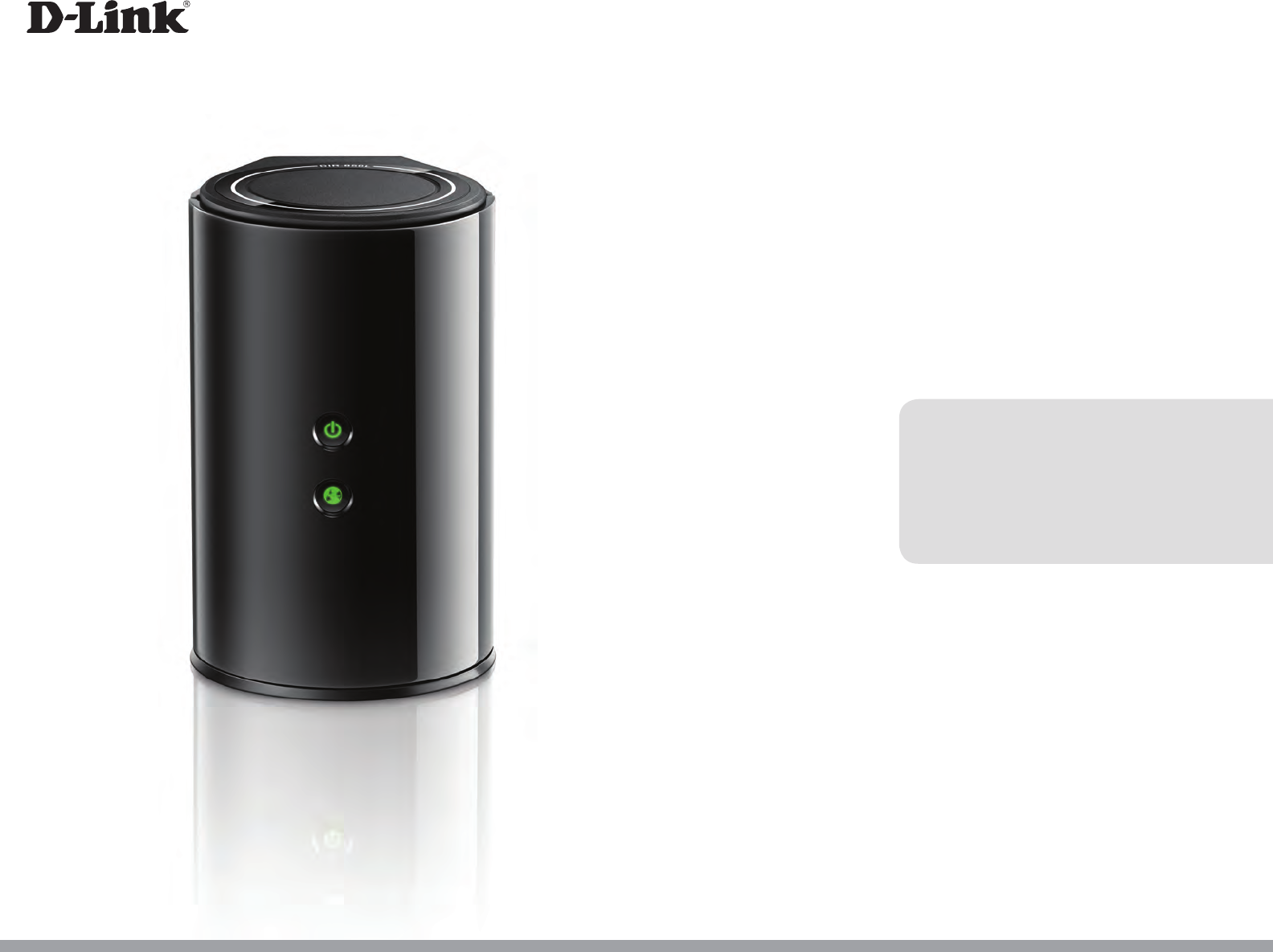
Version 2.00 | 05/07/2014
Wireless AC1200 Dual Band Gigabit Cloud Router
User Manual
DIR-850L
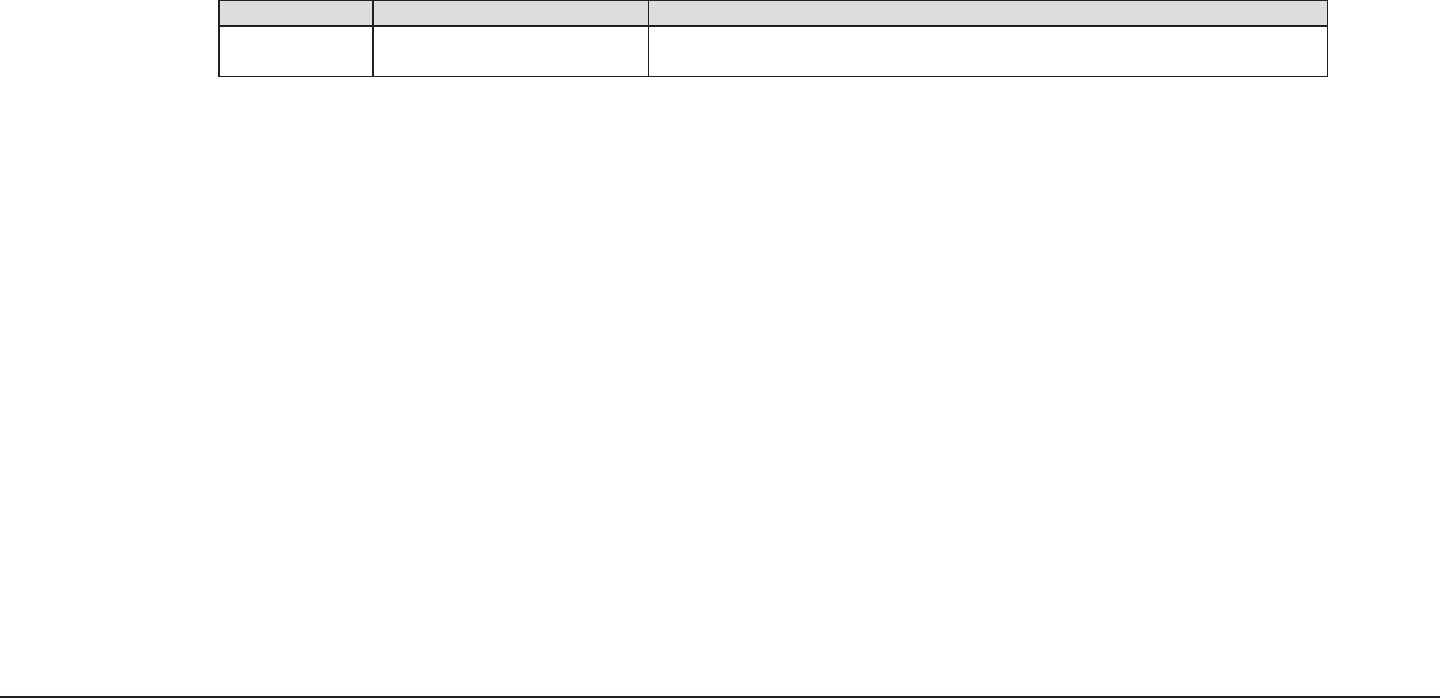
iD-Link DIR-850L User Manual
D-Link reserves the right to revise this publication and to make changes in the content hereof without obligation to notify any
person or organization of such revisions or changes.
Manual Revisions
Trademarks
D-Link and the D-Link logo are trademarks or registered trademarks of D-Link Corporation or its subsidiaries in the United States or other countries.
All other company or product names mentioned herein are trademarks or registered trademarks of their respective companies.
Apple®, Apple logo®, Safari®, iPhone®, iPad®, iPod touch® and Macintosh® are trademarks of Apple Inc., registered in the U.S. and other countries.
App StoreSM is a service mark of Apple Inc.
Chrome™ browser, Google Play™ and Android™ are trademarks of Google Inc.
Internet Explorer®, Windows® and the Windows logo are trademarks of the Microsoft group of companies.
Copyright © 2014 by D-Link Corporation, Inc.
All rights reserved. This publication may not be reproduced, in whole or in part, without prior expressed written permission from D-Link Corporation,
Inc.
Revision Date Description
2.00 17 June, 2014 • Update to Revision B1
Preface

iiD-Link DIR-850L User Manual
Table of Contents
Preface ................................................................................. i
Manual Revisions ........................................................................... i
Trademarks ...................................................................................... i
Product Overview .............................................................. 1
Package Contents ......................................................................... 1
System Requirements ................................................................. 2
Introduction ................................................................................... 3
Features ............................................................................................ 4
Hardware Overview ..................................................................... 5
Connections ........................................................................... 5
LEDs ........................................................................................... 6
Installation ......................................................................... 7
Before you Begin ........................................................................... 7
Wireless Installation Considerations ......................................8
Hardware Installation .................................................................. 9
Getting Started ................................................................11
Setup Wizard ................................................................................12
QRS Mobile App ..........................................................................17
mydlink SharePort ......................................................................22
Main Menu ............................................................................25
Documents ............................................................................26
Pictures ...................................................................................28
Videos .....................................................................................30
Music .......................................................................................32
Folders ....................................................................................35
Favorites .................................................................................38
Using the mydlink SharePort app for Android™ .............. 39
Main Menu ............................................................................42
Documents ............................................................................43
Pictures ...................................................................................45
Videos .....................................................................................47
Music .......................................................................................49
Folders ....................................................................................52
Favorites .................................................................................56
Using SharePort Web Access ..................................................57
Music .......................................................................................59
Pictures ...................................................................................60
Videos .....................................................................................61
Documents ............................................................................62
Conguration ...................................................................63
Home ..............................................................................................64
Internet ................................................................................... 64
DIR-850L ................................................................................. 65
Connected Clients ..............................................................66
USB Device ............................................................................67
Settings ..........................................................................................68
Wizard .....................................................................................68
Internet ................................................................................... 68
Wireless ..................................................................................92
Network .................................................................................. 95
SharePort ...............................................................................97
Table of Contents

iiiD-Link DIR-850L User Manual
Table of Contents
mydlink ................................................................................... 99
Advanced ................................................................................... 100
QoS Engine......................................................................... 100
Firewall ................................................................................ 101
Port Forwarding ............................................................... 104
Website Filter ..................................................................... 106
Static Route ........................................................................ 107
Dynamic DNS .................................................................... 109
Management ............................................................................. 111
Time & Schedule .............................................................. 111
System Log ......................................................................... 113
Admin .................................................................................. 114
Upgrade .............................................................................. 116
Statistics .............................................................................. 117
Connect a Wireless Client to your Router ....................118
WPS Button ................................................................................ 118
Windows® 8 ................................................................................ 119
WPA/WPA2 ......................................................................... 119
Windows® 7 ................................................................................ 121
WPA/WPA2 ......................................................................... 121
Windows Vista® .........................................................................124
WPA/WPA2 ......................................................................... 125
Windows® XP ............................................................................. 127
WPA/WPA2 ......................................................................... 128
Troubleshooting ............................................................130
Wireless Basics ...............................................................134
What is Wireless? ...................................................................... 135
Tips ................................................................................................ 137
Wireless Modes ......................................................................... 138
Networking Basics .........................................................139
Check your IP address ............................................................ 139
Statically Assign an IP address ............................................ 140
Technical Specications ................................................141

1D-Link DIR-850L User Manual
Section 1 - Product Overview
Product Overview
Package Contents
Note: Using a power supply with a dierent voltage rating than the one included with the DIR-850L will cause damage and void the warranty
for this product.
If any of the above items are missing, please contact your reseller.
DIR-850L Wireless AC1200 Dual Band Gigabit Cloud Router
Ethernet Cable
Power Adapter
Wi-Fi Conguration Card
Wi-Fi Conguration Note

2D-Link DIR-850L User Manual
Section 1 - Product Overview
Network Requirements
• An Ethernet-based cable or DSL modem
• IEEE 802.11ac, 802.11a, 802.11n or 802.11g wireless clients
• 10/100/1000 Ethernet
Web-based Conguration
Utility Requirements
Computer with the following:
• Windows®, Macintosh, or Linux-based operating system
• An installed Ethernet adapter
Browser Requirements:
• Internet Explorer 7 or higher
• Firefox 3.5 or higher
• Safari 4 or higher
• Chrome 8 or higher
Windows® Users: Make sure you have the latest version of Java
installed. Visit www.java.com to download the latest version.
mydlink Requirements
• iPhone/iPad/iPod Touch (iOS 3.0 or higher)
• Android device (1.6 or higher)
• Computer with the following browser requirements:
• Internet Explorer 7 or higher
• Firefox 3 or higher
• Safari 5 or higher
• Chrome 5 or higher
iPhone, iPad, and iPod touch are registered trademarks of Apple Inc. Android is a trademark of Google, Inc.
System Requirements

3D-Link DIR-850L User Manual
Section 1 - Product Overview
Introduction
Now you can monitor and manage your home network right from your laptop, iPhone®, iPad®, or Android™ device. This cloud-
enabled router can be congured to send an email anywhere, anytime, to keep you informed when new devices are connecting
to your network or intruders are detected. With the new graphical user interface, monitor in real-time websites that are being
visited with recent browser history displayed on the mydlink™ Lite app – great for parents on the go. The D-Link Cloud service
can also detect and block cyber criminals from breaking into your wireless network and suspicious activities will be displayed
right on your web browser or in the mydlink™ Lite app.
The D-Link DIR-850L is an IEEE 802.11ac compliant device that delivers up to 3 times faster speeds than 802.11n while staying
backward compatible with 802.11a/g/b devices. Connect the DIR-850L to a cable or DSL modem and share high-speed Internet
access to PCs, game consoles, and media players. Create a secure wireless network to share photos, les, music, videos, printers,
and network storage to your mobile devices. Powered by the 802.11ac technology and equipped with two 2.4 GHz and 5 GHz
dual-band internal antennas, this router provides superior wireless coverage for larger homes and oces, or for users running
bandwidth-intensive applications. The DIR-850L also includes a 4-port 10/100/1000 gigabit switch that connects gigabit-wired
devices for enjoying lag-free HD movie streaming, network gaming, and fast le transfers.
D-Link has created SharePort technology to bring more exibility to your network. With SharePort technology, you can connect
a USB printer and share it throughout your network. You can also share a USB storage device, providing network storage for
everyone to share. On top of that, you can share and access media stored on your USB storage remotely over the Internet with
the free mydlink SharePort app for mobile devices!
With some routers, all wired and wireless trac, including VoIP, video streaming, online gaming, and web browsing are mixed
together into a single data stream. By handling data this way, applications like video streaming could pause or delay. With the
D-Link Intelligent QoS technology, wired and wireless trac are analyzed and separated into multiple data streams.
For peace of mind, the DIR-850L supports the latest wireless security features to help prevent unauthorized access, be it from
over a wireless network or the Internet. Support for WPA™ and WPA2™ standards ensure that you will be able to use the best
possible encryption regardless of your client devices. In addition, this router utilizes dual-active rewalls (SPI and NAT) to
prevent potential attacks from across the Internet for the ideal centerpiece of your home or oce wireless network.

4D-Link DIR-850L User Manual
Section 1 - Product Overview
•Ultimate Wireless AC Networking - The DIR-850L provides up to 300 Mbps wireless connection over 2.4 GHz
band, 900 Mbps wireless connection over the 5 GHz band with 802.11ac and 802.11n wireless clients. This
capability allows users to participate in real-time activities online, such as video streaming, online gaming,
and real-time audio. The performance of this 802.11ac wireless router gives you the freedom of wireless
networking at speeds 3x faster than 802.11n.
•Multimedia on the Go - The DIR-850L is designed to be the media hub for all of your mobile needs with the
following features:
•USB Interface - Easily store and share music, videos, photos, and les on your USB drive or charge another
device.
• UPnP Support - The DIR-850L can stream many compatible media formats to other devices wirelessly.
•mydlink SharePort app - Stream your media and upload les locally or remotely through the Internet to your
iPhone®, iPad® or Android™ device.
•Compatible with 802.11a/b/g/n Devices - The DIR-850L is still fully compatible with the IEEE 802.11a,
802.11g and 802.11n, so it can connect with existing 802.11a, 802.11b, 802.11g, and 802.11n PCI, USB, and
CardBus adapters.
•New User-friendly Graphical Interface - Through its intuitive and easy-to-use web-based user interface, the
DIR-850L lets you set up and manage your network with ease. You can even congure your router in minutes
with the QRS Mobile app; free for mobile devices.
* Maximum wireless signal rate derived from IEEE Standard 802.11a, 802.11g, 802.11n and 802.11ac specications. Actual data throughput will vary. Network conditions and
environmental factors, including volume of network trac, building materials and construction, and network overhead, lower actual data throughput rate. Environmental
conditions will adversely aect wireless signal range.
Features
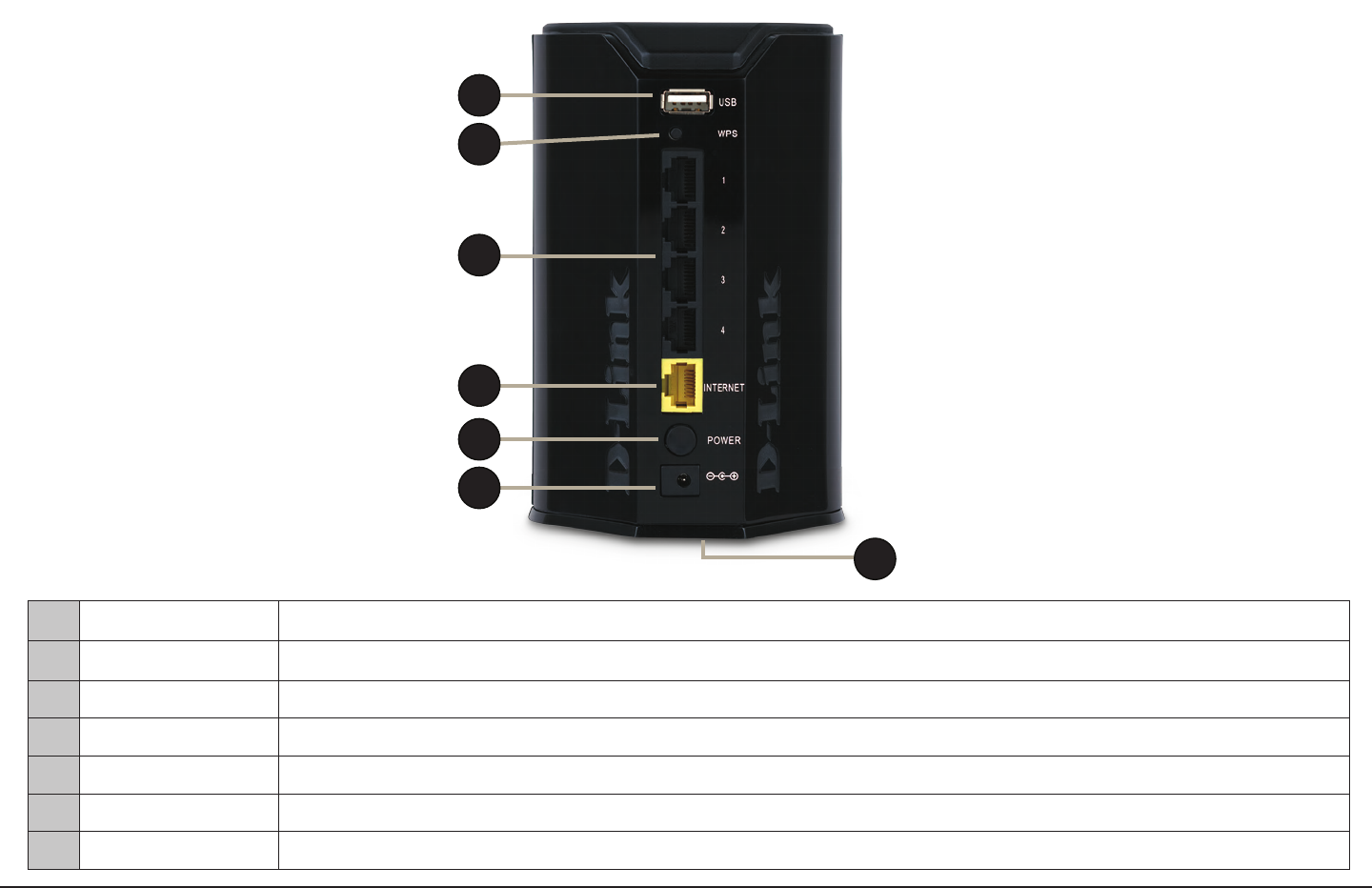
5D-Link DIR-850L User Manual
Section 1 - Product Overview
Hardware Overview
Connections
1USB Port Connect a USB ash drive to share content throughout your network.
2WPS Button Press to start the WPS process. The Internet LED will start to blink.
3LAN Ports (1-4) Connect 10/100/1000 Ethernet devices such as computers, switches, storage (NAS) devices and game consoles.
4Internet Port Using an Ethernet cable, connect your broadband modem to this port.
5Power Button Press the power button to power on and o.
6Power Receptor Receptor for the supplied power adapter.
7Reset Button Use a paperclip to press and hold the button for 10 seconds to reset the router to default settings.
1
3
4
5
6
2
7
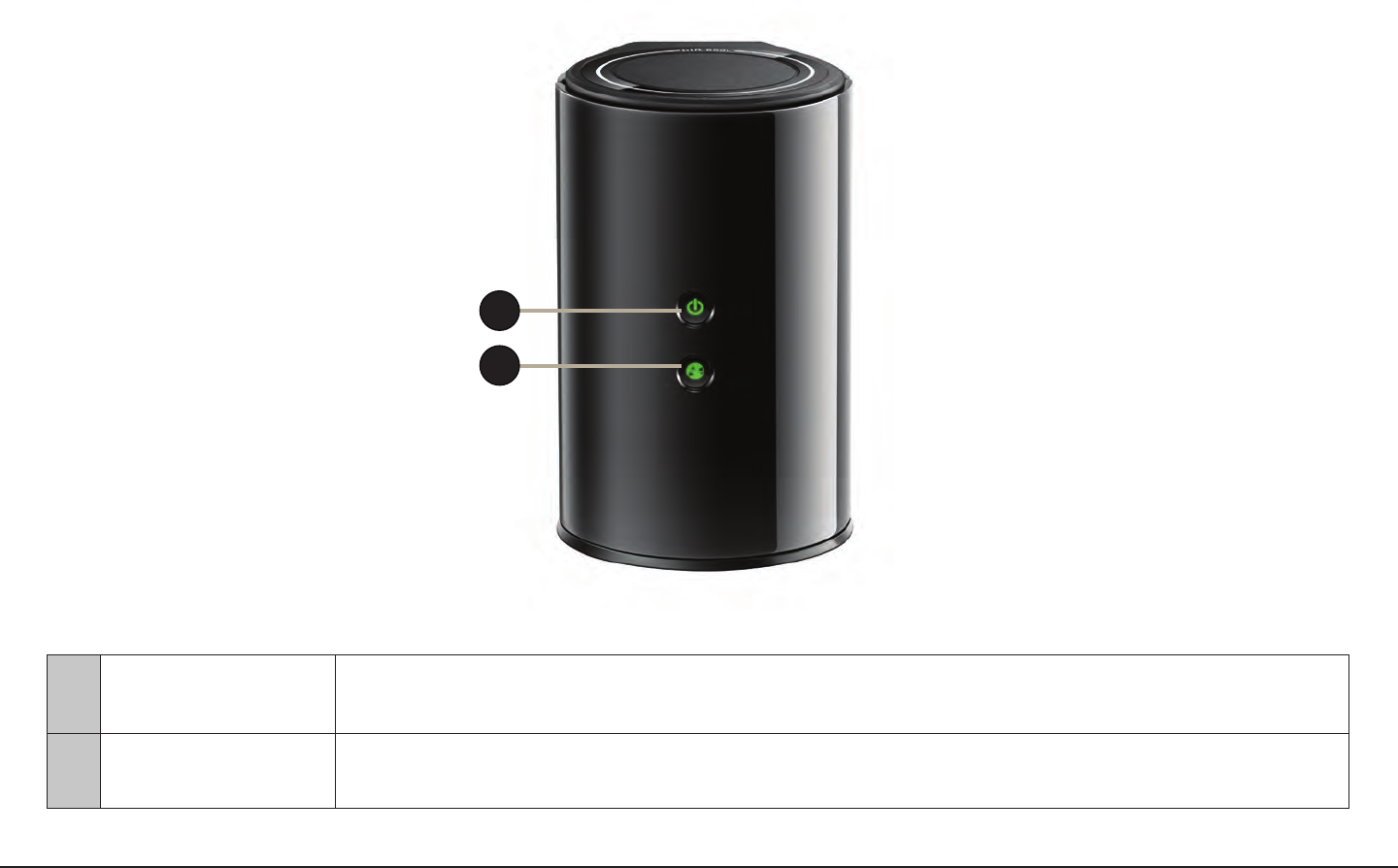
6D-Link DIR-850L User Manual
Section 1 - Product Overview
Hardware Overview
LEDs
1Power LED A solid green light indicates a proper connection to the power supply. The light will blink green during the
WPS process. The light will blink orange during boot up.
2Internet LED A solid light indicates connection on the Internet port. If the LED is orange, the router cannot connect to
the Internet.
1
2

7D-Link DIR-850L User Manual
Section 2 - Installation
Before you Begin
Installation
This section will walk you through the installation process. Placement of the router is very important. Do not place the router
in an enclosed area such as a closet, cabinet, or in the attic or garage.
• Please congure the router with the computer that was last connected directly to your modem.
• You can only use the Ethernet port on your modem. If you were using the USB connection before using the router,
then you must turn o your modem, disconnect the USB cable and connect an Ethernet cable to the Internet port
on the router, and then turn the modem back on. In some cases, you may need to call your ISP to change connection
types (USB to Ethernet).
• If you have DSL and are connecting via PPPoE, make sure you disable or uninstall any PPPoE software such as WinPoET,
BroadJump, or EnterNet 300 from your computer or you will not be able to connect to the Internet.

8D-Link DIR-850L User Manual
Section 2 - Installation
Wireless Installation Considerations
The D-Link wireless router lets you access your network using a wireless connection from virtually anywhere within the
operating range of your wireless network. Keep in mind, however, that the number, thickness and location of walls, ceilings,
or other objects that the wireless signals must pass through, may limit the range. Typical ranges vary depending on the types
of materials and background RF (radio frequency) noise in your home or business. The key to maximizing wireless range is to
follow these basic guidelines:
1. Keep the number of walls and ceilings between the D-Link router and other network devices to a minimum - each wall or
ceiling can reduce your adapter’s range from 3-90 feet (1-30 meters.) Position your devices so that the number of walls or
ceilings is minimized.
2. Be aware of the direct line between network devices. A wall that is 1.5 feet thick (.5 meters), at a 45-degree angle appears
to be almost 3 feet (1 meter) thick. At a 2-degree angle it looks over 42 feet (14 meters) thick! Position devices so that the
signal will travel straight through a wall or ceiling (instead of at an angle) for better reception.
3. Building materials make a dierence. A solid metal door or aluminum studs may have a negative eect on range. Try to
position access points, wireless routers, and computers so that the signal passes through drywall or open doorways. Materials
and objects such as glass, steel, metal, walls with insulation, water (sh tanks), mirrors, le cabinets, brick, and concrete will
degrade your wireless signal.
4. Keep your product away (at least 3-6 feet or 1-2 meters) from electrical devices or appliances that generate RF noise.
5. If you are using 2.4 GHz cordless phones or X-10 (wireless products such as ceiling fans, lights, and home security systems),
your wireless connection may degrade dramatically or drop completely. Make sure your 2.4 GHz phone base is as far away
from your wireless devices as possible. The base transmits a signal even if the phone in not in use.
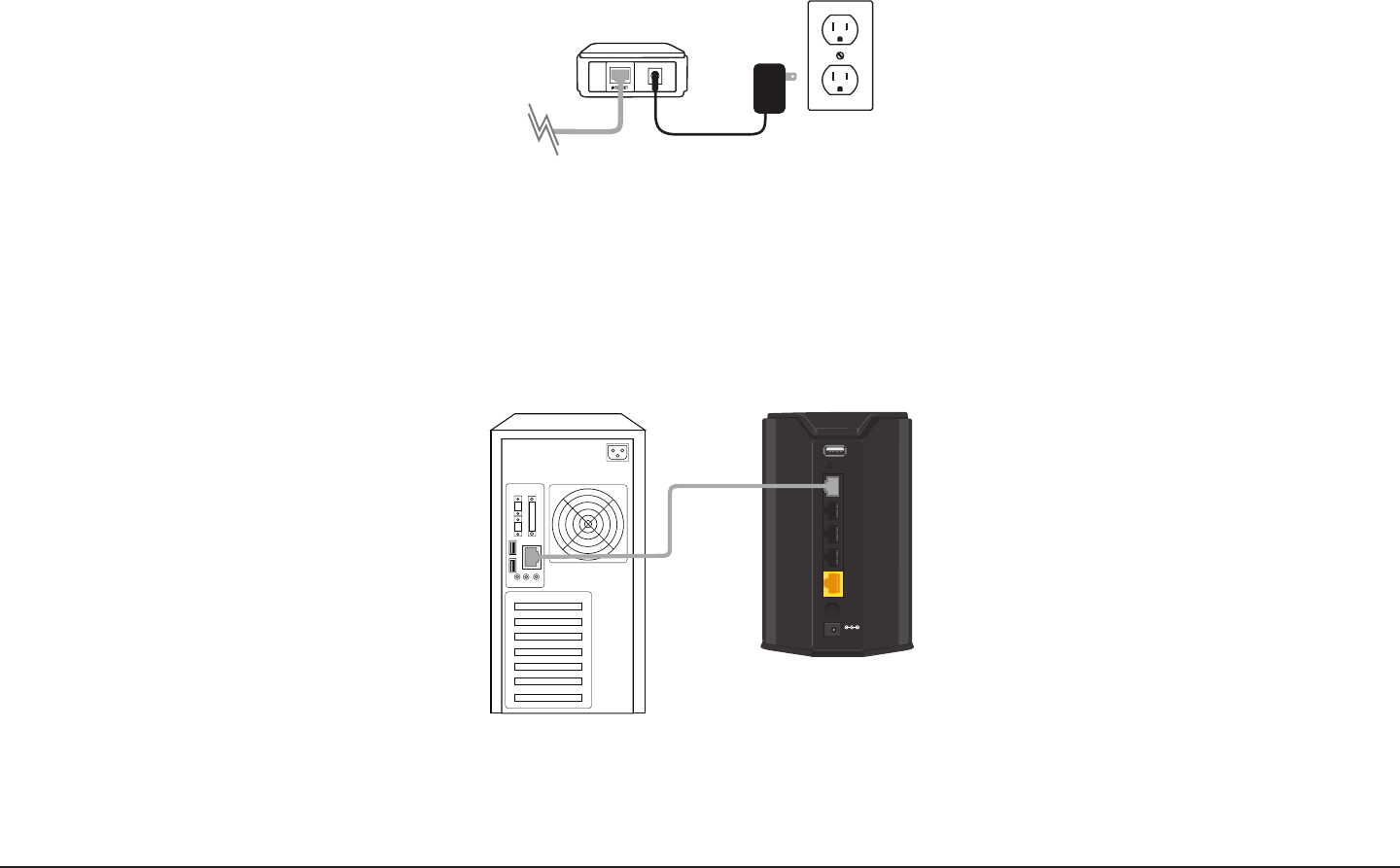
9D-Link DIR-850L User Manual
Section 2 - Installation
1. Turn o and unplug your cable or DSL broadband modem. This is required.
Hardware Installation
2. Position your router close to your modem and a computer. Place the router in an open area of your intended
work area for better wireless coverage.
3. Unplug the Ethernet cable that is connected to your computer from your modem (or existing router if upgrading).
Plug it into the LAN port labeled 1 on the back of your router. The router is now connected to your computer.
Modem
DIR-850L
Computer
USB
WPS
1
2
3
4
INTERNET
POWER
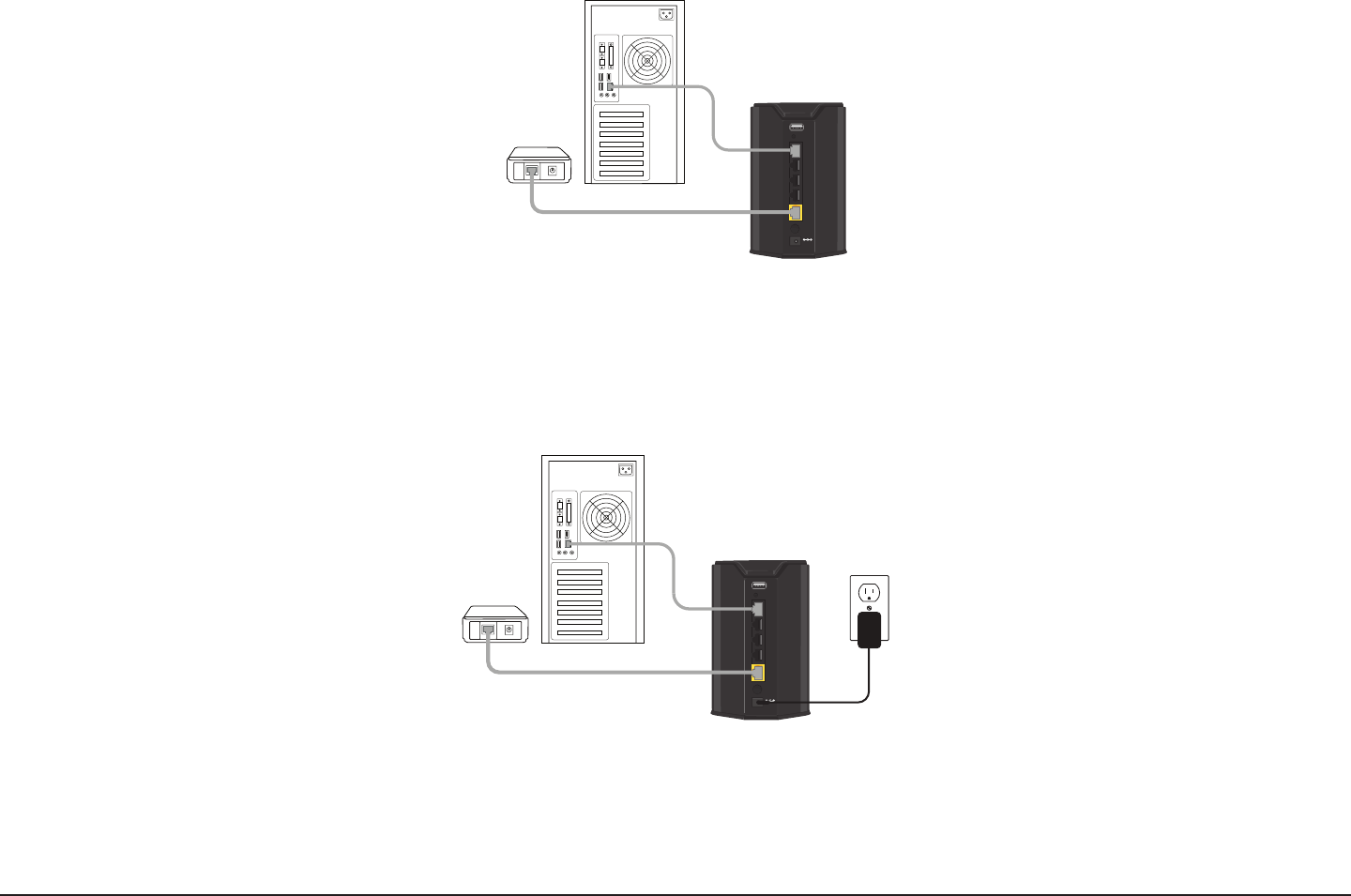
10D-Link DIR-850L User Manual
Section 2 - Installation
4. Plug one end of the included blue Ethernet cable that came with your router into the yellow port labeled
INTERNET on the back of the router. Plug the other end of this cable into the Ethernet port on your modem.
5. Reconnect the power adapter to your cable or DSL broadband modem and wait for two minutes.
6. Connect the supplied power adapter into the power port on the back of the router and then plug it into a power
outlet or surge protector. Press the power button and verify that the power LED is lit. Allow 1 minute for the
router to boot up.
7. If you are connecting to a broadband service that uses a dynamic connection (not PPPoE), you may be online
already. Try opening a web browser and enter a web site. A solid light indicates a connection on the Internet port
and the router can connect to the Internet. If the LED is orange, the connection is good but the router cannot
connect to the Internet.
DIR-850L
DIR-850L
Modem
Computer
Modem
Computer
USB
WPS
1
2
3
4
INTERNET
POWER
INTERNET
USB
WPS
1
2
3
4
INTERNET
POWER
INTERNET

11D-Link DIR-850L User Manual
Section 2 - Installation
There are several dierent ways you can congure your router to connect to the Internet and connect to your clients:
• D-Link Setup Wizard - This wizard will launch when you log into the router for the rst time. Refer to ”Setup Wizard” on
page 12.
• QRS Mobile App - Use your iPhone, iPad, or iPod Touch to congure your router. Refer to “QRS Mobile App” on page
17.
• Manual Setup - Log into the router and manually congure your router (advanced users only). Refer to “Network” on
page 95.
Getting Started
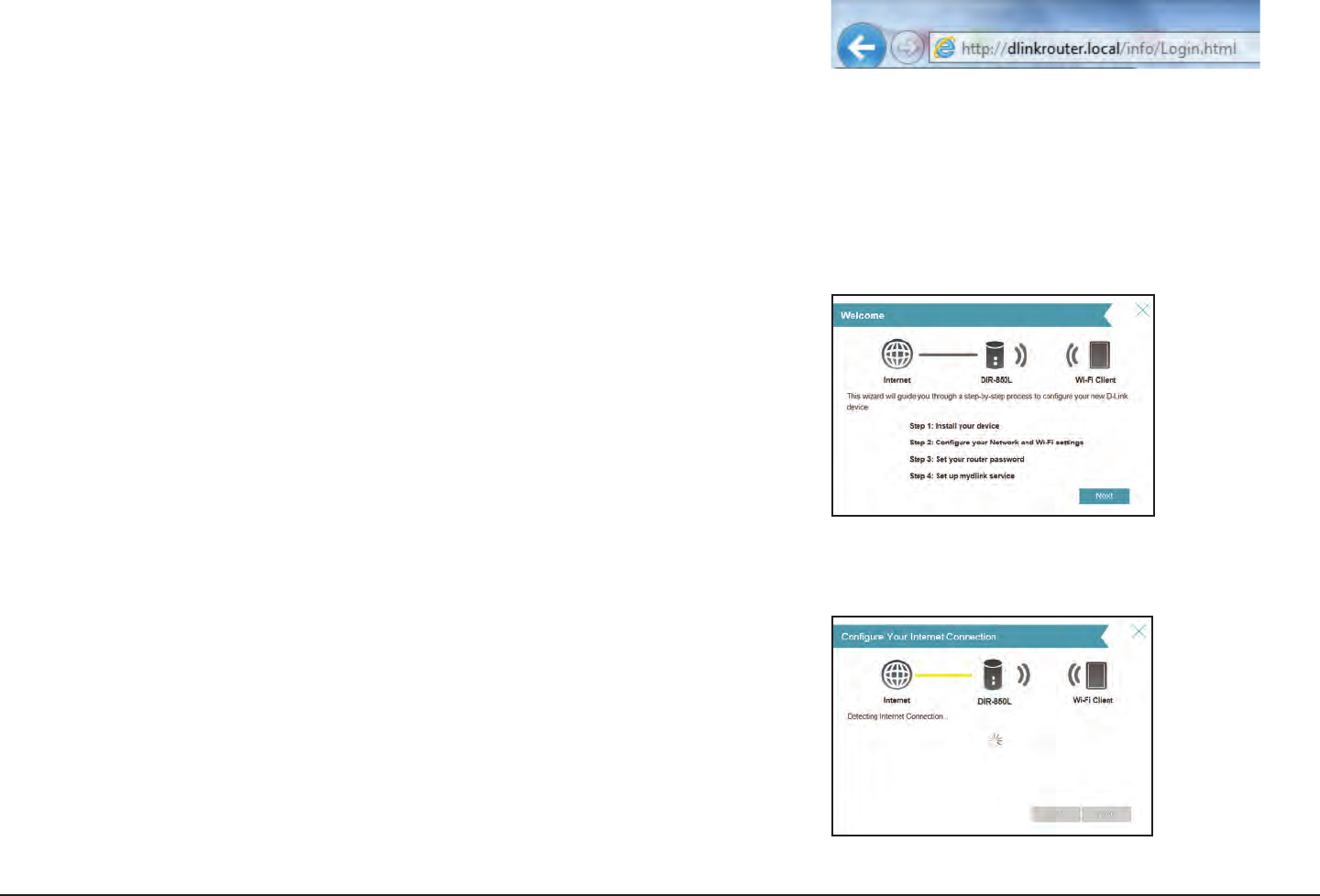
12D-Link DIR-850L User Manual
Section 2 - Installation
The wizard is designed to guide you through a step-by-step process to
congure your new D-Link router and connect to the Internet.
Click Next to continue.
Setup Wizard
If this is your rst time installing the router, open your web browser and
enter http://dlinkrouter.local./ in the address bar. Alternatively, enter
the IP address of the router (default: http://192.168.0.1).
Please wait while your router detects your Internet connection type. If
the router detects your Internet connection, you may need to enter your
ISP information such as username and password.
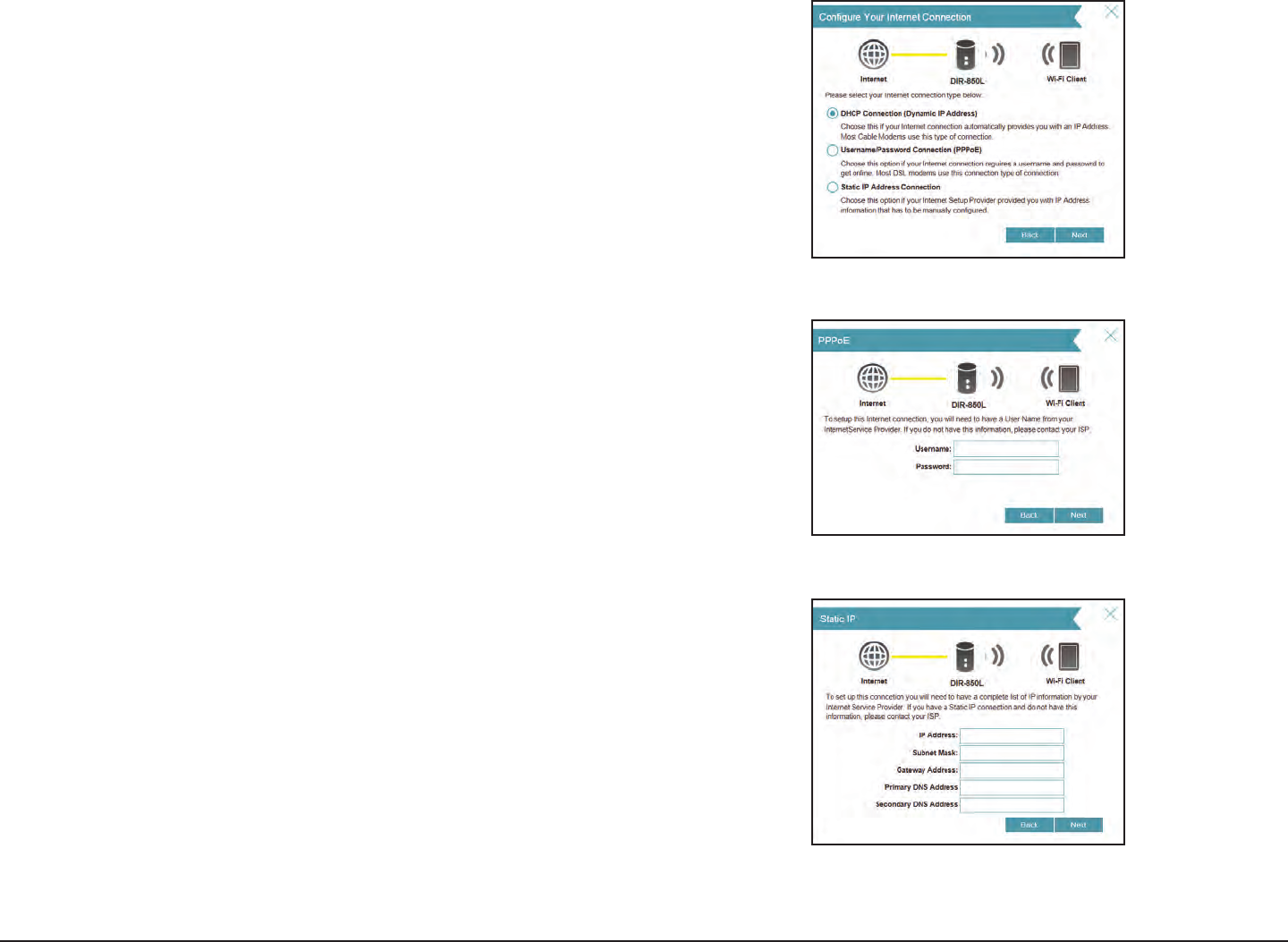
13D-Link DIR-850L User Manual
Section 2 - Installation
If the router does not detect a valid Internet connection, a list of
connection types to choose from will be displayed.
Select your Internet connection type (this information can be obtained
from your Internet service provider) and click Next to continue.
If the router detected or you selected PPPoE, enter your PPPoE username
and password and click Next to continue.
Note: Make sure to remove your PPPoE software from your computer. The
software is no longer needed and will not work through a router.
If the router detected or you selected Static, enter the IP and DNS settings
supplied by your ISP. Click Next to continue.
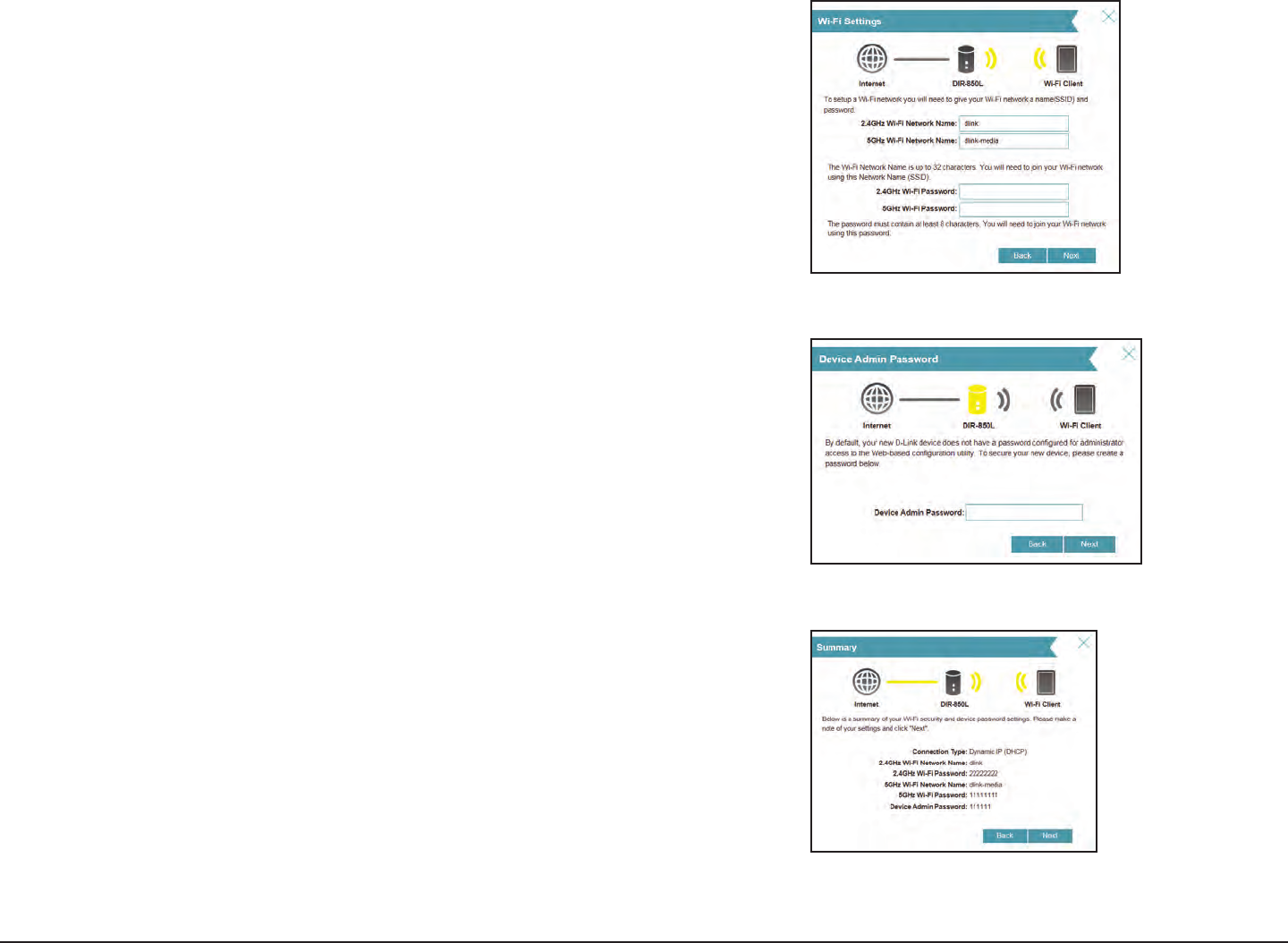
14D-Link DIR-850L User Manual
Section 2 - Installation
For both the 2.4 GHz and 5 GHz segments, create a Wi-Fi network name
(SSID) using up to 32 characters.
Create a Wi-Fi password (between 8-63 characters). Your wireless clients
will need to have this passphrase or key entered to be able to connect
to your wireless network.
Click Next to continue.
In order to secure the router, please enter a new password. You will be
prompted for this password every time you want to use the router’s web
conguration utility. Click Next to continue.
The Summary window will display your settings. Click Next if you are
satised, or click Back to make changes to them.
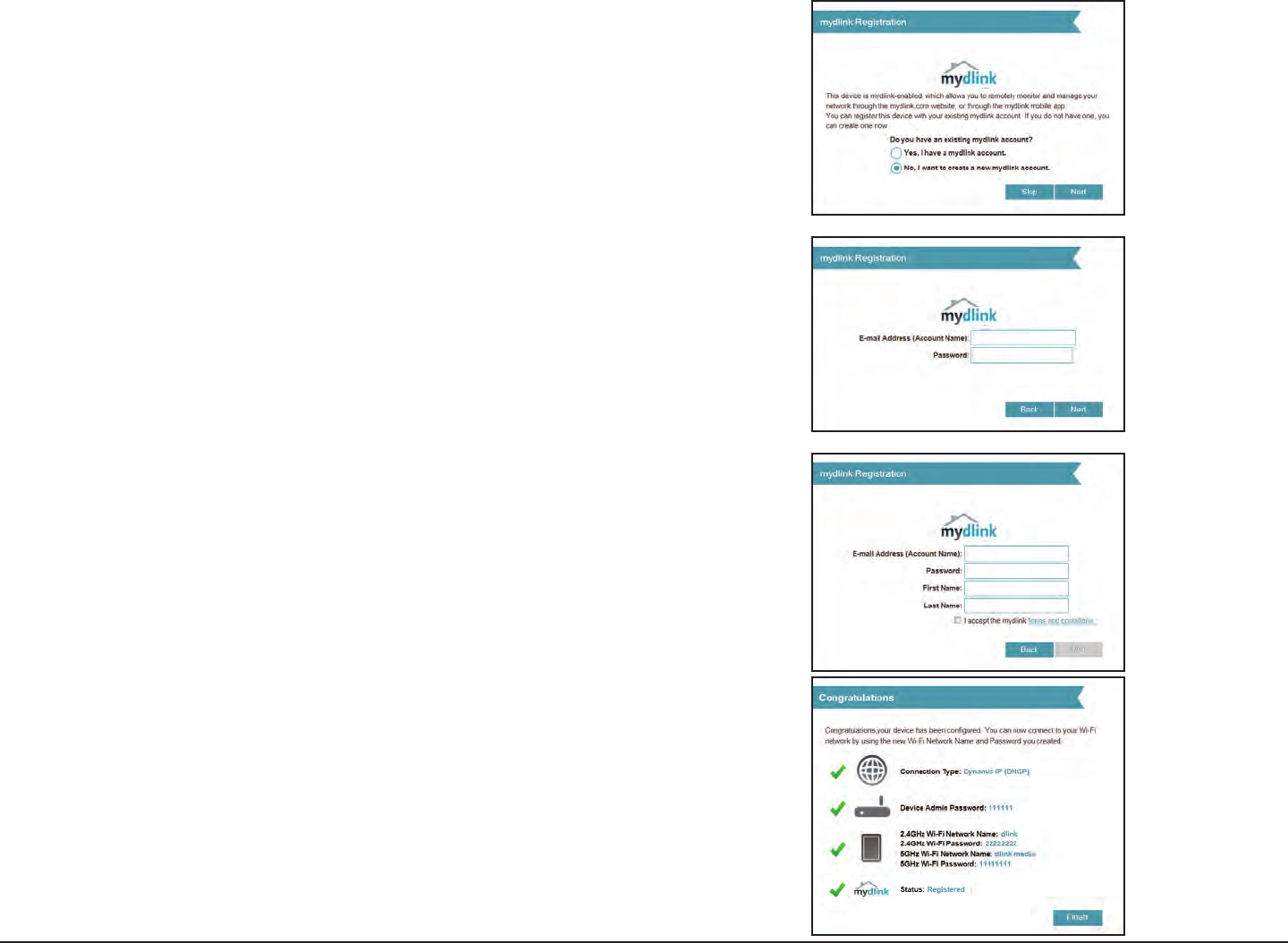
15D-Link DIR-850L User Manual
Section 2 - Installation
To use the mydlink service (mydlink.com or the mydlink Lite app), you
must have an account. Select Ye s if you have a mydlink account already,
or No if you want to create one. Click Next to continue.
If you do not want to register at this time, click Skip.
If you clicked Yes, enter your mydlink account name (email address) and
password. Click Next to register your mydlink account with the router.
If you clicked No, ll out the requested information and click Next to
create your mydlink account.
At the end of the wizard, you will be presented with a nal summary of
your settings. Click Finish to close the wizard.
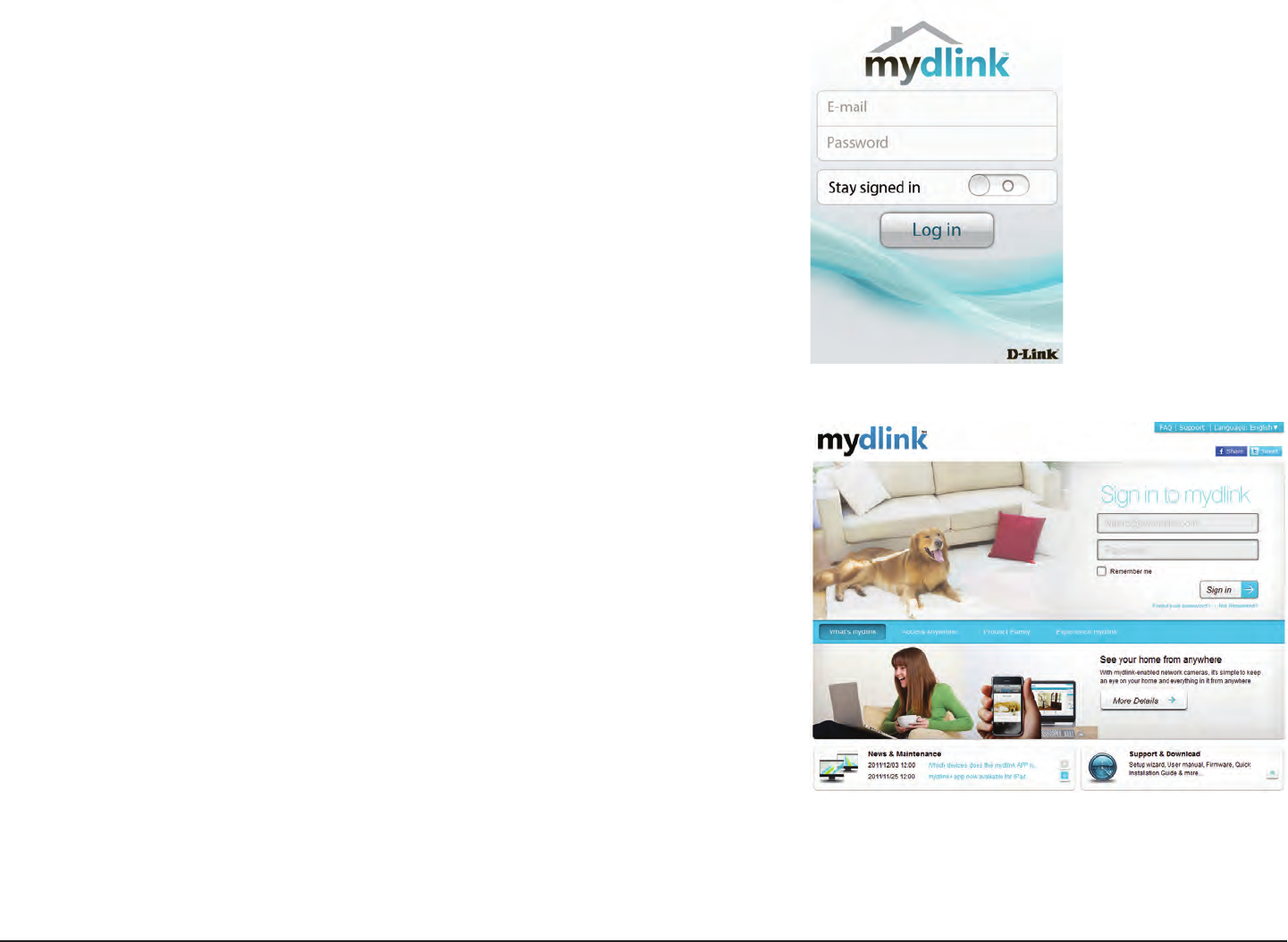
16D-Link DIR-850L User Manual
Section 2 - Installation
The mydlink App will allow you to receive notices, browse network users,
and congure your router from an iPhone/iPad/iPod Touch (iOS 3.0 or
higher), Android device (1.6 or higher).
To download the "mydlink Lite" app, visit the Apple Store, Android Market
or http://mydlink.com/Lite.
PC and Mac users can use the mydlink portal at http://mydlink.com.
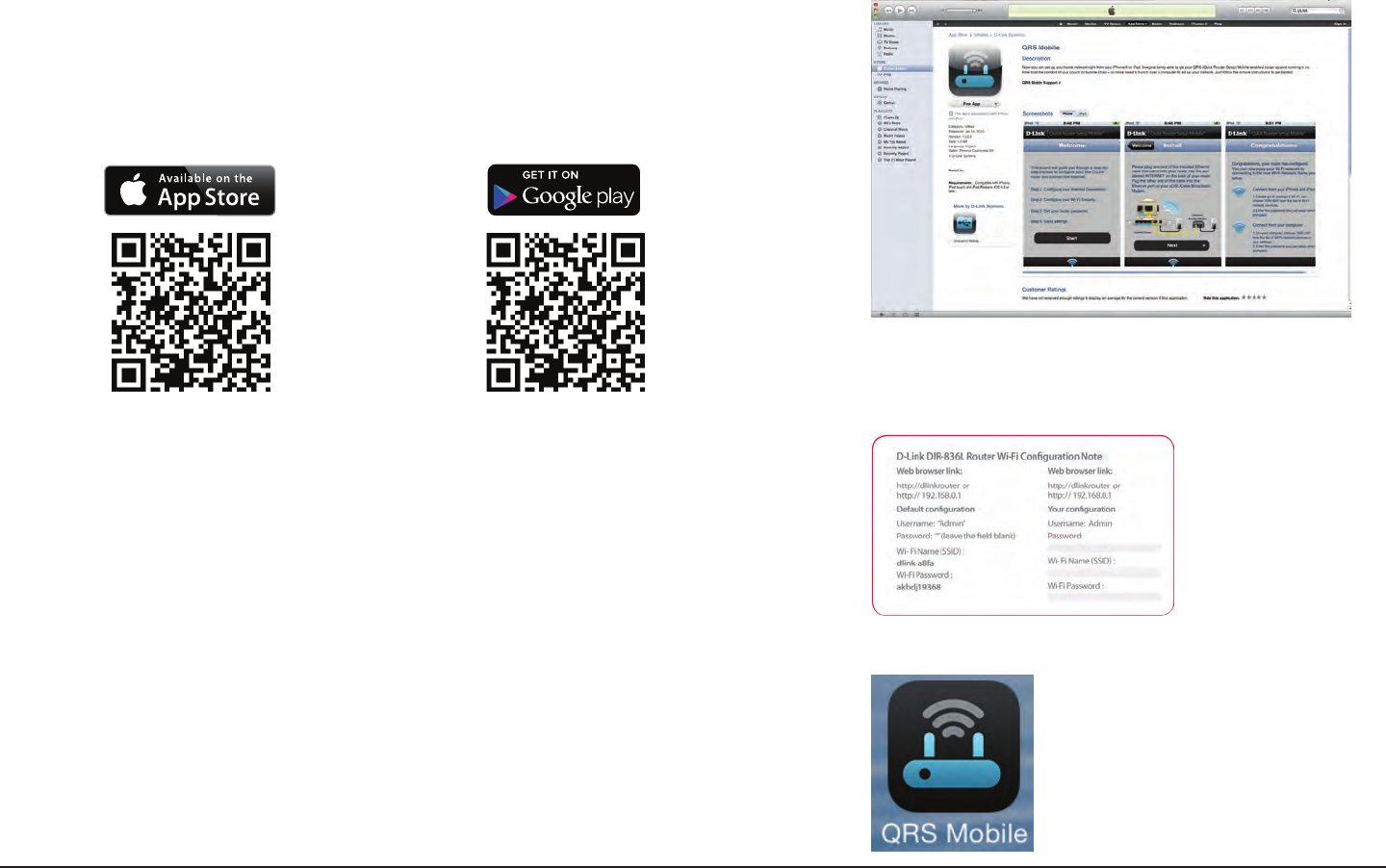
17D-Link DIR-850L User Manual
Section 2 - Installation
QRS Mobile App
QRS Mobile app allows you to install and congure your router from your mobile device.
Step 1
Search for the free QRS Mobile App on the iTunes Store or Google Play.
Step 2
Once your app is installed, you may now congure your router. Connect
to the router wirelessly by going to your wireless utility on your device.
Scan for the Wi-Fi name (SSID) as listed on the supplied info card. Select
and then enter your Wi-Fi password.
Step 3
Once you connect to the router, launch the QRS mobile app from the
Home screen of your device.
For the iTunes Store, you may
also scan this code to download.
For Google Play, you may also
scan this code to download.
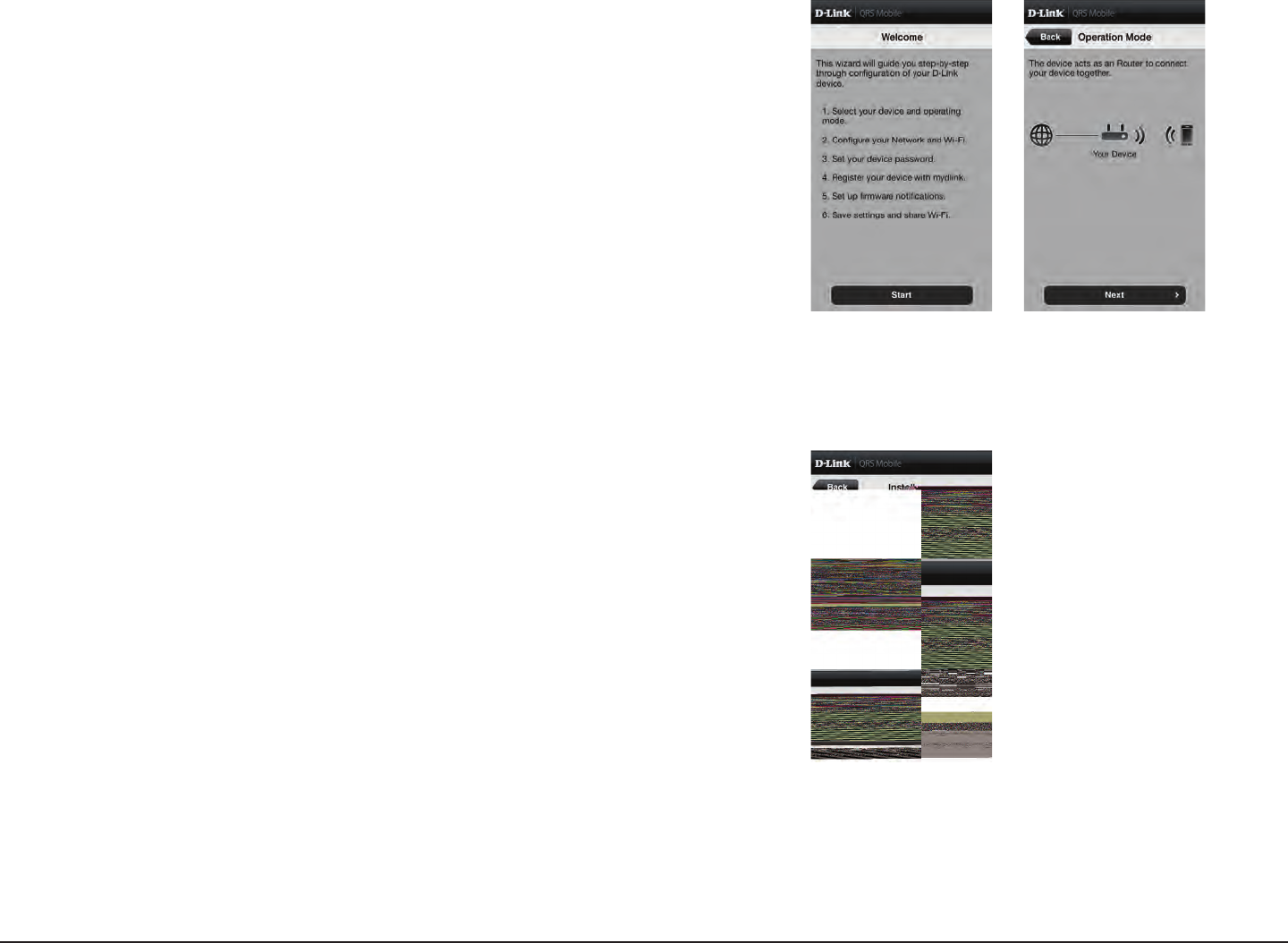
18D-Link DIR-850L User Manual
Section 2 - Installation
Step 4
You will see the welcome screen. Tap Start to proceed, then Next once
the Operation Mode screen appears.
Step 5
At this point, please ensure that you the router is connected to a modem.
Plug one end of the provided Ethernet cable into your DSL or cable
modem, and plug the other end into the port marked INTERNET on the
DIR-850L. Tap Next to automatically detect your Internet connection
and proceed to the next step.
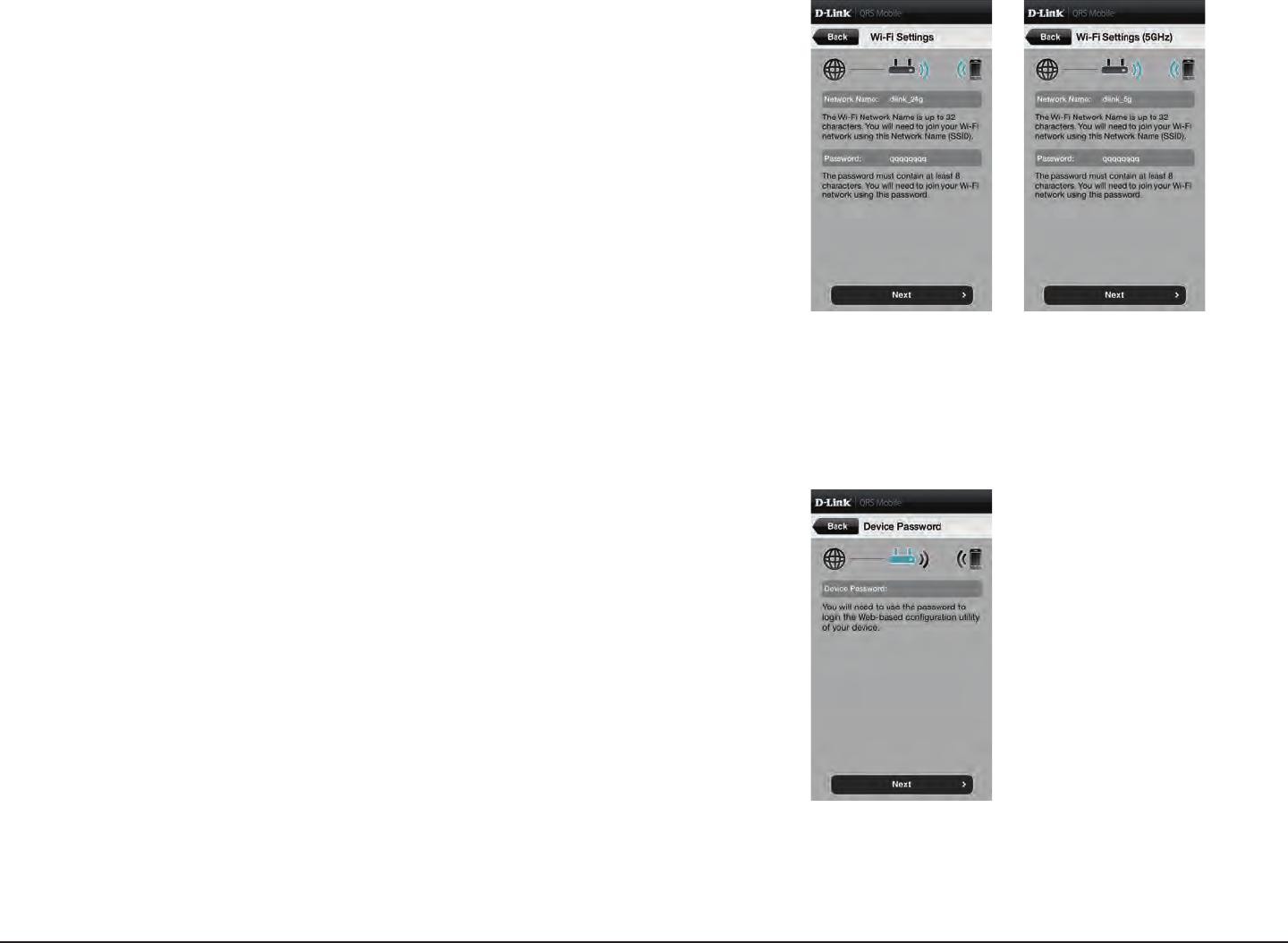
19D-Link DIR-850L User Manual
Section 2 - Installation
Step 6
You will be prompted to set up each wireless frequency band in turn;
the 2.4 GHz band followed by the 5 GHz band.
Firstly, enter a network name (SSID) of your choice, or leave it unchanged
to accept the default SSID. Each wireless band can be assigned its own
SSID.
Secondly, choose a Wi-Fi password of at least 8 characters. Any device
trying to connect to the router wirelessly will need to enter this password
the rst time it connects.
Finally, tap Next to proceed.
Step 7
Enter the administrator password of your choice. Unlike the Wi-Fi
password, this password is only required when you need to congure
the router. See page 114 for details of when this password is used. Tap Next
to proceed.
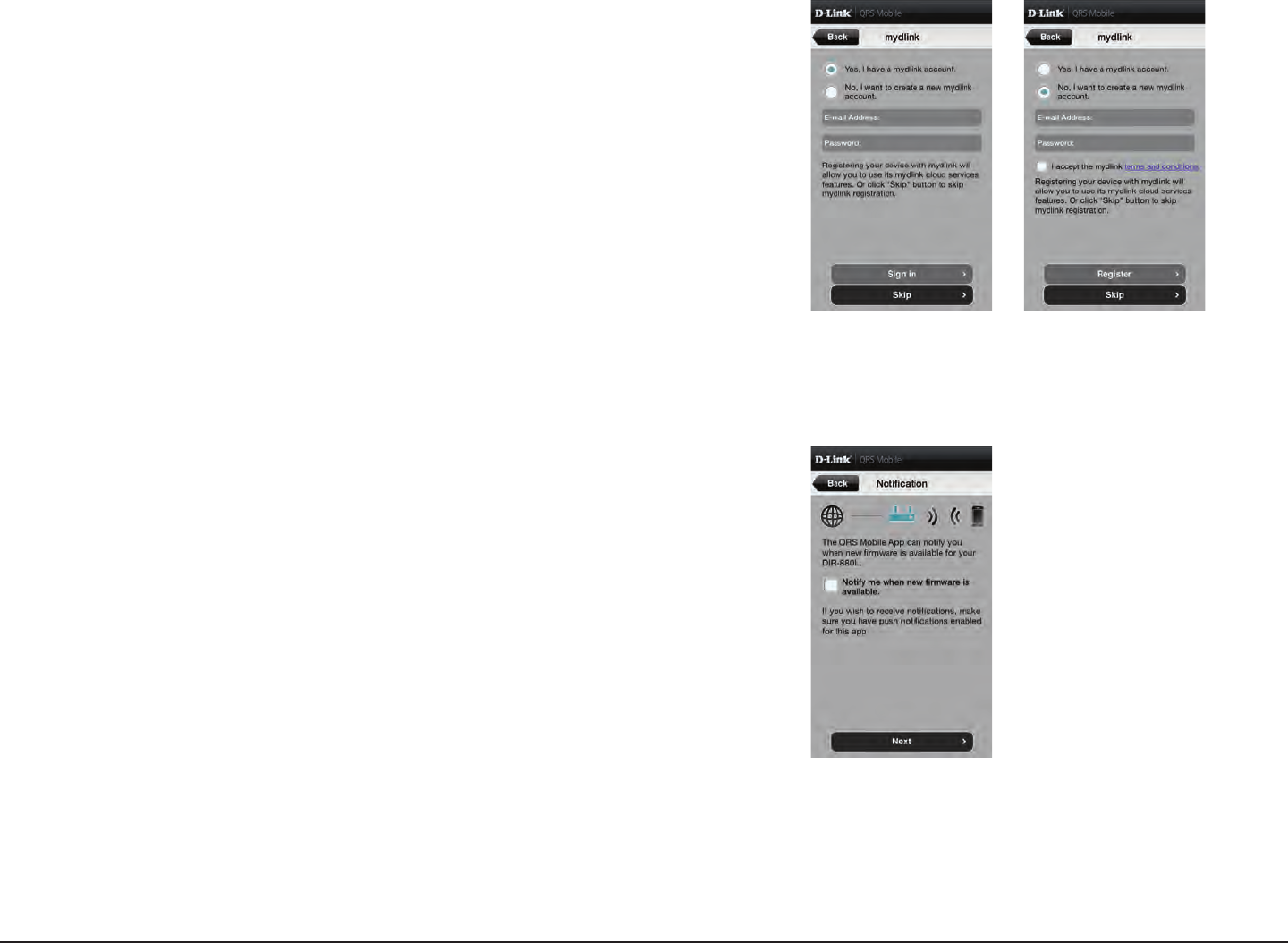
20D-Link DIR-850L User Manual
Section 2 - Installation
Step 8
If you already have a mydlink account, select Yes, I have a mydlink
account and enter your mydlink email address and password. Lastly, tap
Sign In to set up the router to use your mydlink account.
If you do not have a mydlink account, select No, I want to create a new
mydlink account. Enter your email address, choose a mydlink password
and check the I accept the mydlink terms and conditions box. Finally,
tap Register to create your new mydlink account.
If you do not want to congure your router with mydlink at this stage,
tap Skip to proceed.
Step 9
If you wish to receive push notications whenever a new rmware update
is available, check the Notify me when new rmware is available box
and tap Next.
Otherwise, just tap Next to proceed.
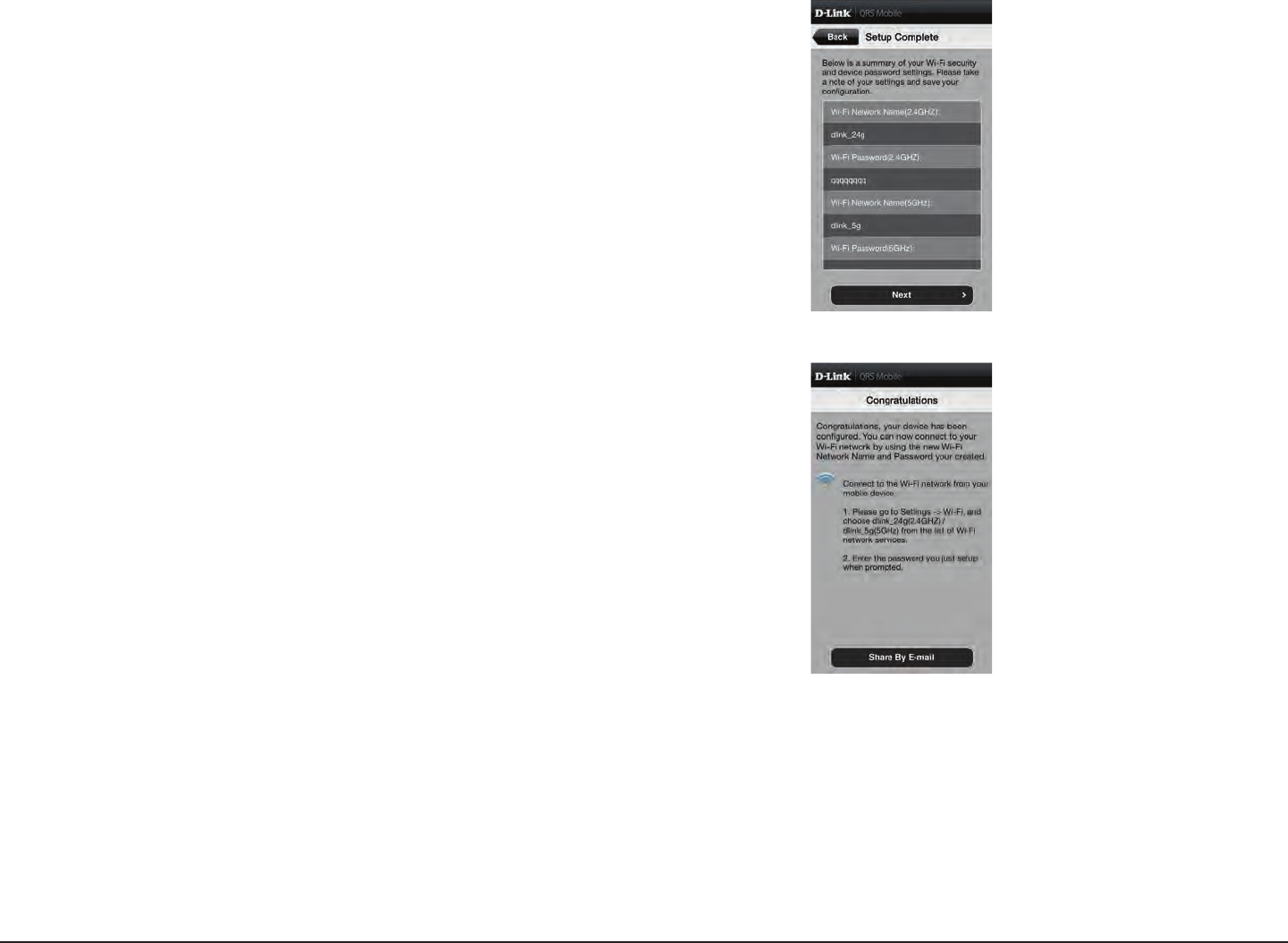
21D-Link DIR-850L User Manual
Section 2 - Installation
Step 10
You will be presented with a summary of your chosen settings. If you wish
to make any changes, tap Back to step back through the previous pages.
Otherwise, tap Next to complete the setup.
Congratulations, your device has been successfully congured! You may
now exit the QRS app.
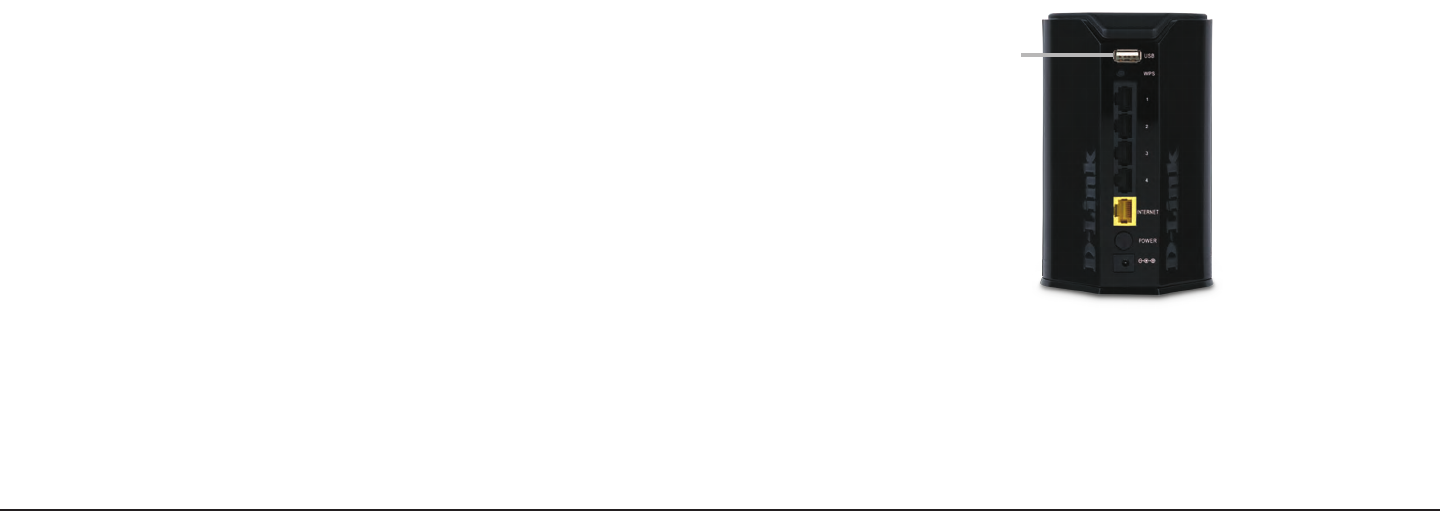
22D-Link DIR-850L User Manual
Section 3 - Usage
The mydlink SharePort app is a streamlined mobile application that allows you to conveniently stream media and share les
stored on a removable storage connected to your router. Once the router is set up, you can start the app and easily connect
from a local network or through the Internet to access your photos, videos, music, and documents. It allows you to create your
own personal cloud storage; you can upload les and photos from your mobile device to the removable storage via the app
from anywhere in the world!
Note: In order to ensure smooth streaming performance, you will need a minimum of 2 Mbit/s upload bandwidth for your router’s Internet connection.
Streaming performance will vary depending on the quality of your Internet connection.
1. If you are connecting remotely through the mydlink SharePort app
from the Internet, you will need a mydlink account. Please refer to
“mydlink SharePort” on page 22 for more details.
2. Make sure the device is powered on. Then plug your USB drive into
the USB port of the device.
Note: If you connect a removable storage with many les or a large capacity, it may
take a while for the router to scan and catalog your les.
mydlink SharePort
Using the mydlink SharePort app for iPad®, iPhone®, and iPod touch®
USB Port
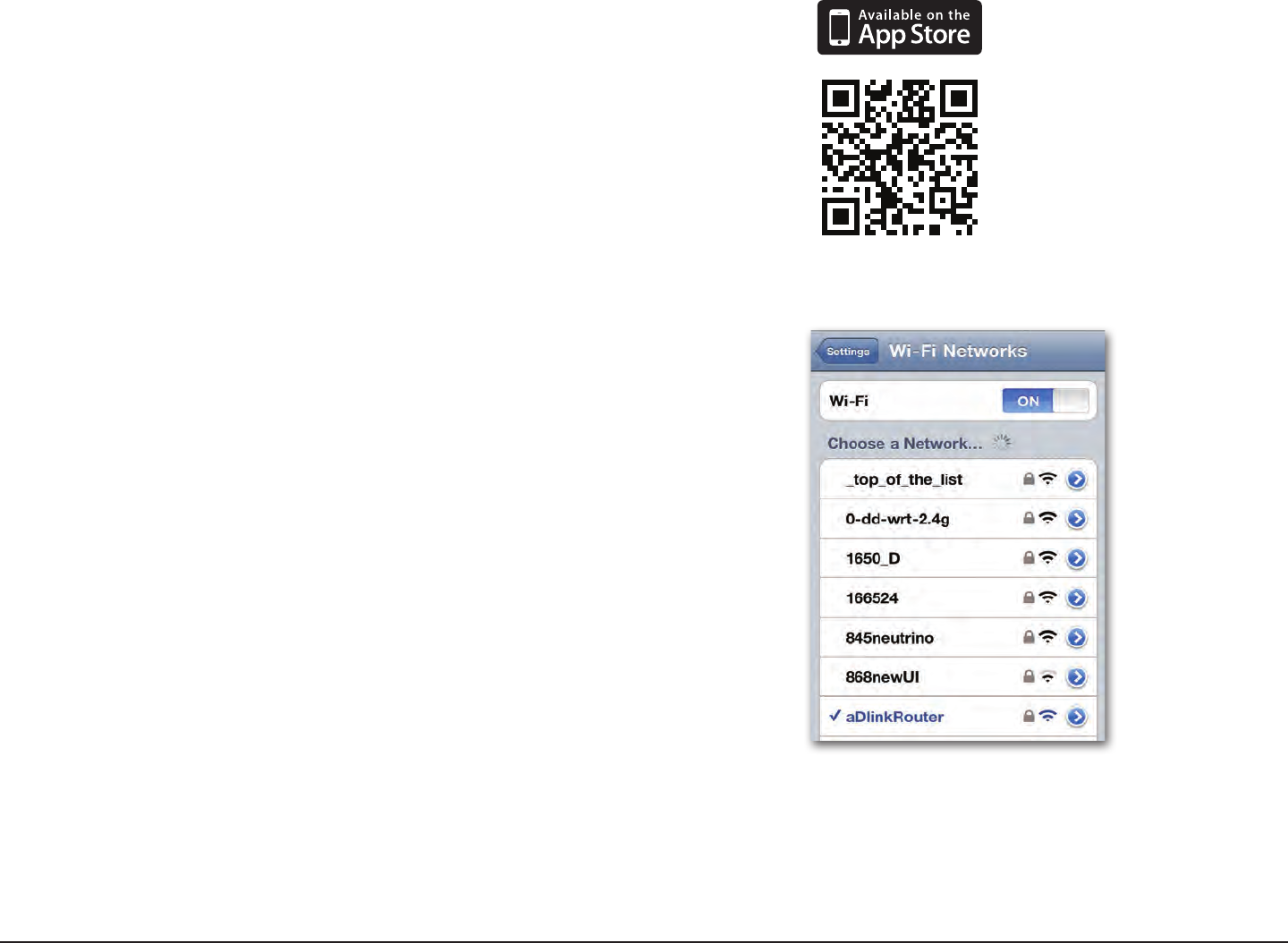
23D-Link DIR-850L User Manual
Section 3 - Usage
4. If you are connecting to the router from a local network:
On your mobile device, go to your Wi-Fi settings and connect
to your router’s wireless network using the default Wi-Fi
settings. Locate the Wi-Fi name (SSID) and password for your
device as printed on the included Wi-Fi Configuration Card.
If you are connecting to the router from a remote network:
Go directly to the next step.
3. Use your iPhone, iPad or iPod Touch to search for and download the
free mydlink SharePort app from the App Store.
If you have a QR code reader, you can scan the code for mydlink
SharePort to the right.
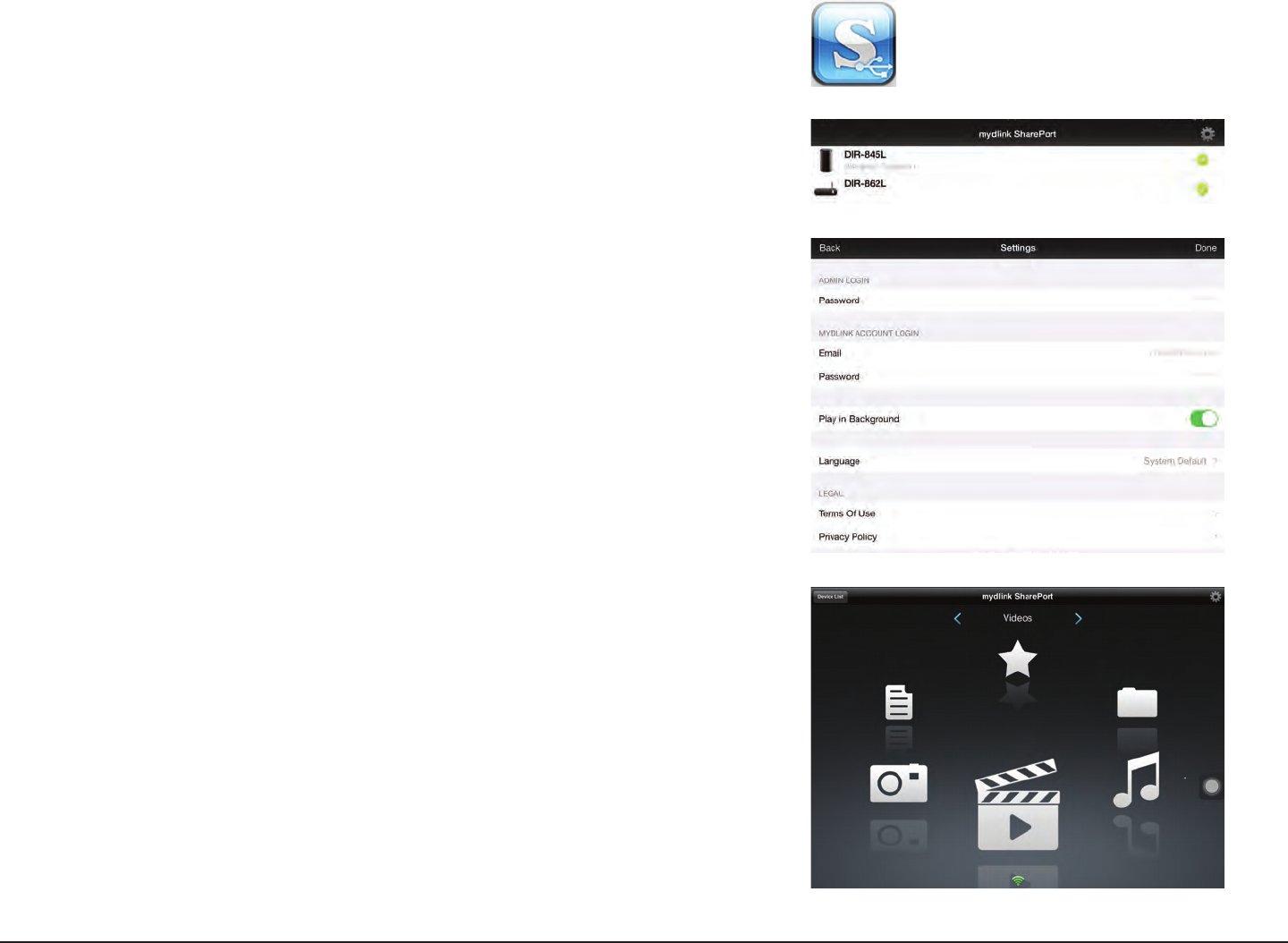
24D-Link DIR-850L User Manual
Section 3 - Usage
5. Tap the mydlink SharePort icon, and the app will load.
6. At the mydlink SharePort device list page, tap the gear icon at the
top right to enter the Settings page.
7. Enter your Admin Login and your mydlink Account Login information
in the elds and click Done. You will be taken back to the device
list where you can select the device for use with mydlink SharePort.
8. You can now use the mydlink SharePort app interface to stream media
and access les stored on your removable drive. The wireless icon at
the bottom will be lit blue to indicate a Local Access connection. It will
be green to indicate you are connected to the router through Remote
Access.
Note: If you see a red wireless icon, your router’s network environment may not
be suitable for a direct network connection and you may experience slow
network speeds.
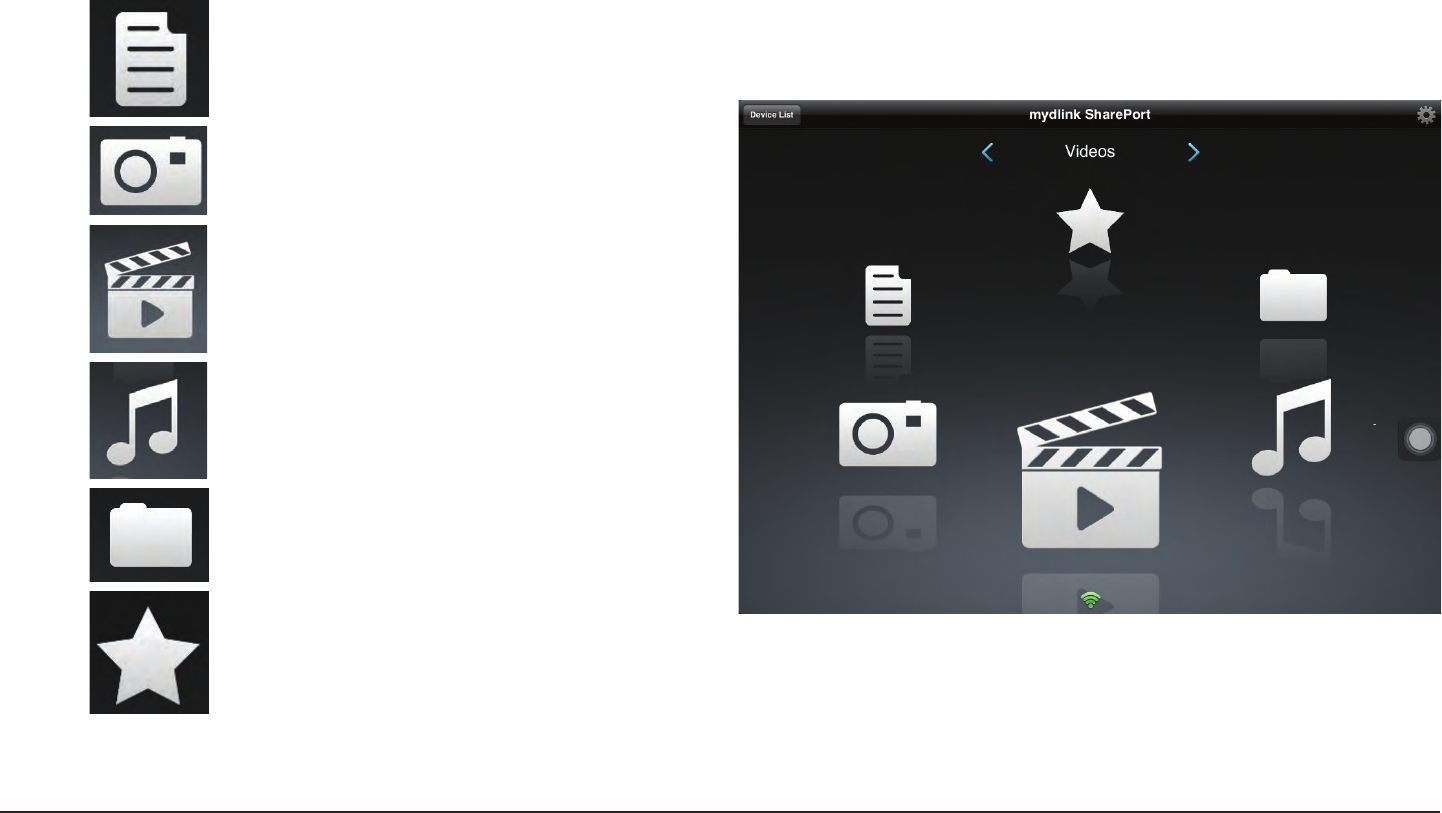
25D-Link DIR-850L User Manual
Section 3 - Usage
Main Menu
Tap on the document icon to view documents.
Tap the camera icon to view photos.
Tap on the movie icon to play videos.
Tap on the music icon to play audio les.
Tap on the folder icon to browse all les in a
folder view.
Tap on the star icon to access your favorite les.
The mydlink SharePort main menu has dierent sections that let you see all the documents, photos, movies, or music stored
on your removable storage. Tap < or >, or swipe left or right to move between the dierent sections. The Wi-Fi icon at the
bottom indicates an active local network connection (blue) or remote connection (green/red). Tap the gear icon if it is not lit.
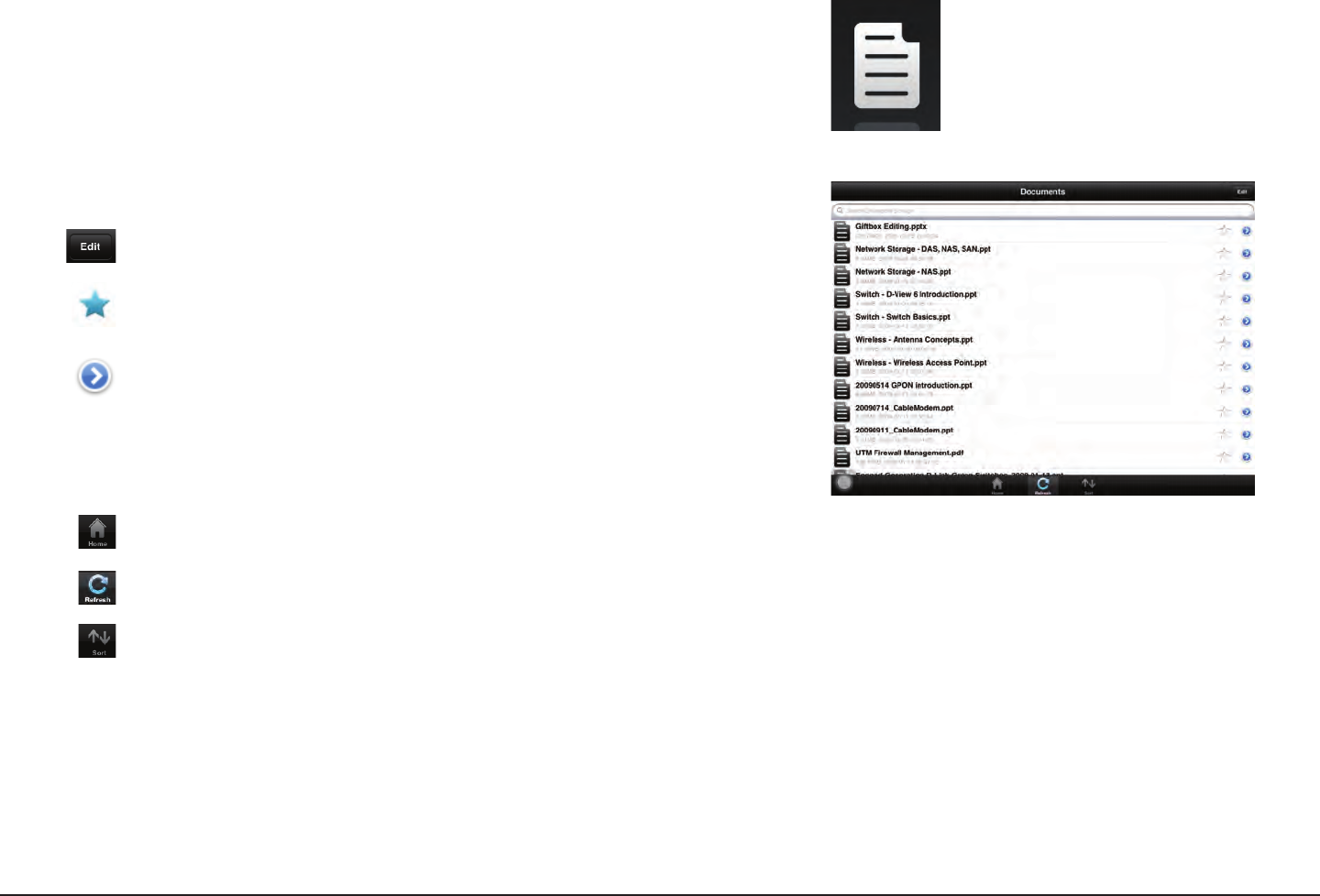
26D-Link DIR-850L User Manual
Section 3 - Usage
Documents
The Documents section allows you to share, print, and view documents
streamed from your DIR-850L to your mobile device. Tap the document
icon on the main menu to browse the documents on your mobile device.
Enter a lename here to search your storage.
Tap to mark les for deletion.
Tap the star icon next to each le to download it to your device and
add it into your Favorites section.
Tapping this icon gives you additional options:
•Open In...: Tap to use a third-party app to open the le.
The bottom menu bar includes these options:
Search Bar:
Tap to go back to the main menu.
Tap to update the list of les.
Tap to reorder the les alphabetically.
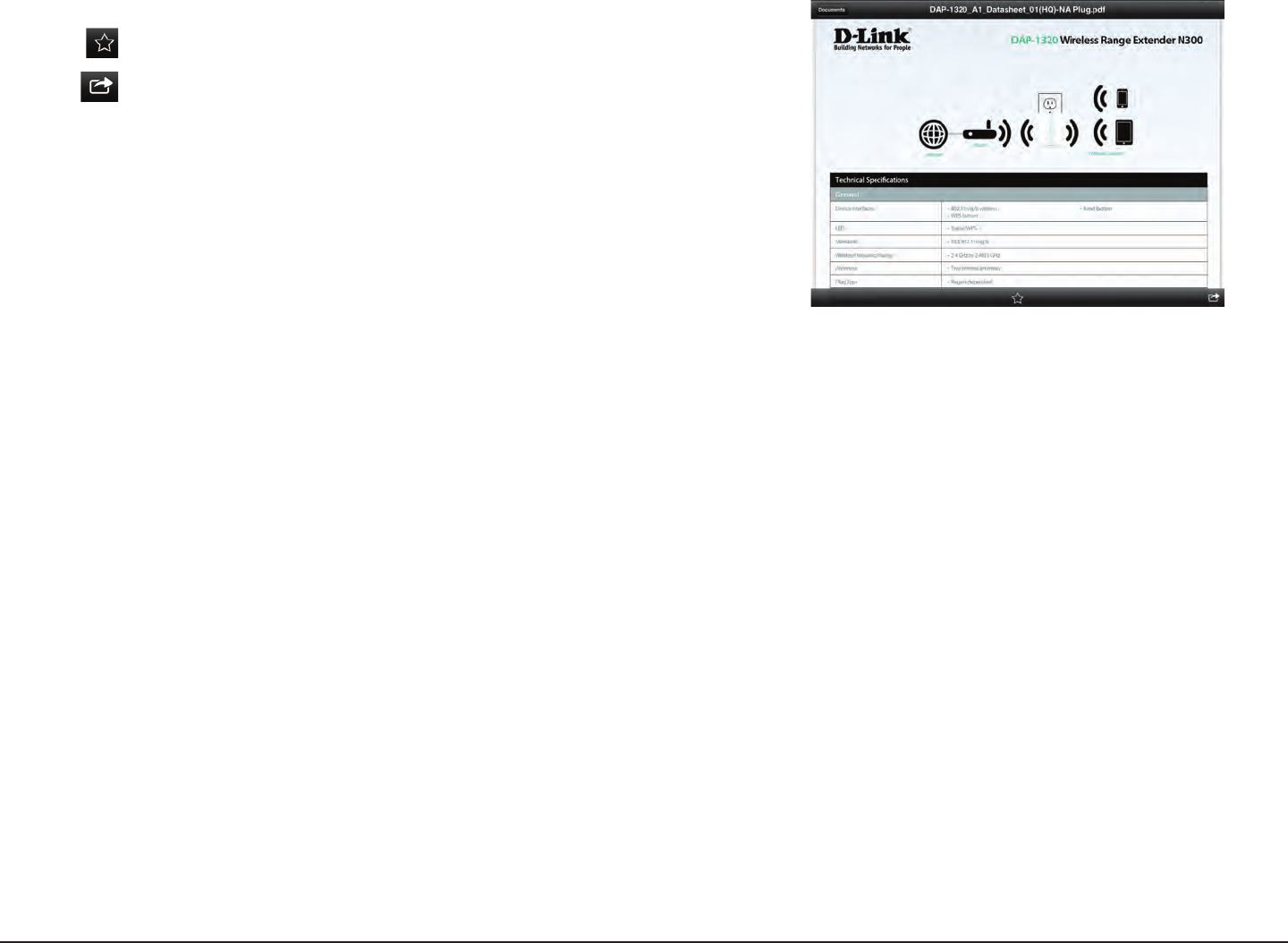
27D-Link DIR-850L User Manual
Section 3 - Usage
Tap on a le to start the document viewer. In the viewer:
Tap to add/remove the le from your Favorites.
Tap to bring up the same options as >.
Note: Some les may require a third-party app to view them.
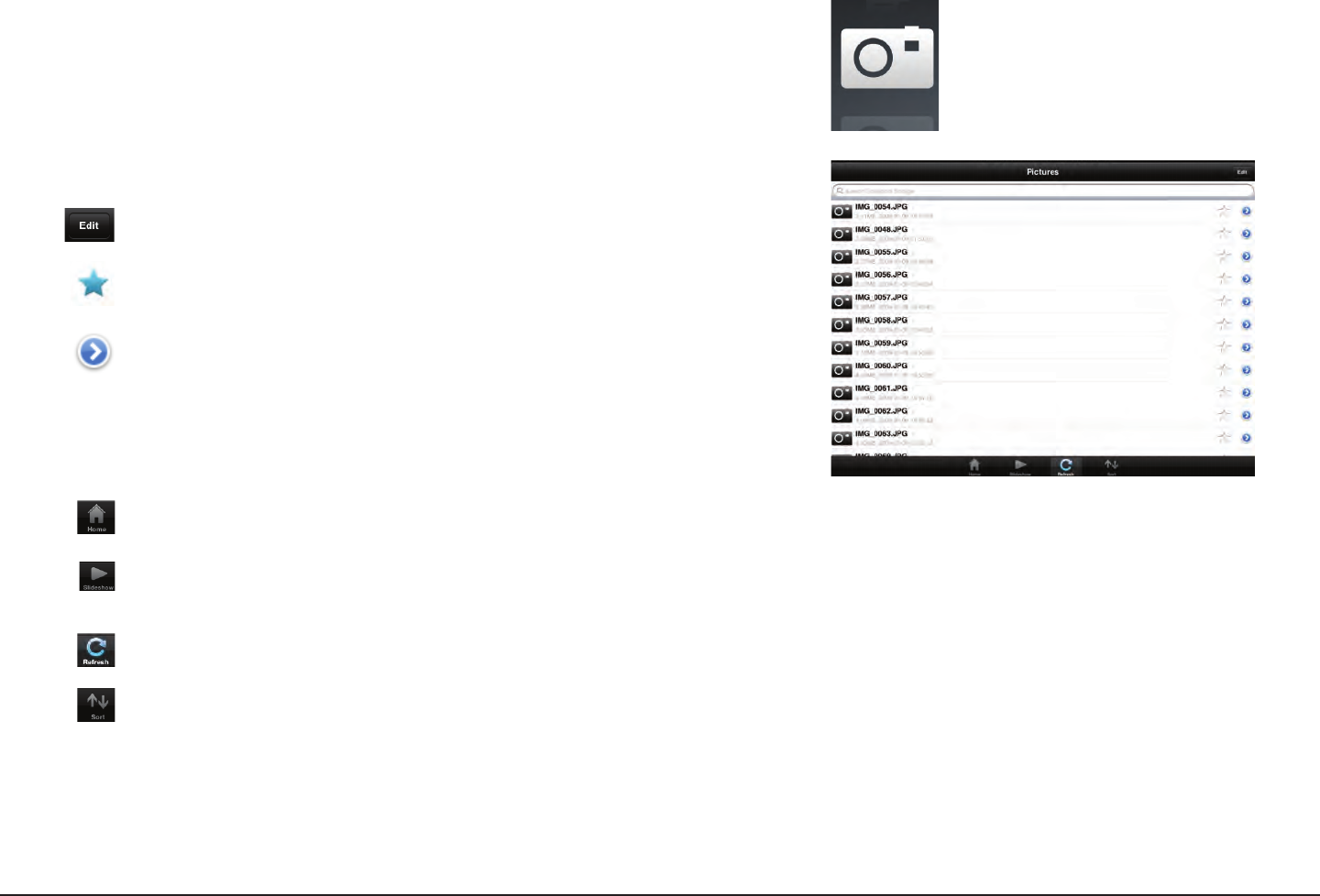
28D-Link DIR-850L User Manual
Section 3 - Usage
Pictures
The Pictures section allows you to stream images from your DIR-850L to
your mobile device. Tap the camera icon on the main menu to browse
your photo collection on your removable storage.
Enter a lename here to search your storage.
Tap to mark les for deletion.
Tap the star icon next to each le to download it to your device and
add it into your Favorites section.
Tapping this icon gives you additional options:
•Open In...: Tap to use a third-party app to open the le.
Search Bar:
Tap to go back to the main menu.
Tap to start a slideshow of your photos. Tap the screen again to bring
up the menu.
Tap to update the list of les.
Tap to reorder the les alphabetically.
The bottom menu bar includes these options:

29D-Link DIR-850L User Manual
Section 3 - Usage
Tap on a le to start the photo viewer. In the viewer:
Tap to add/remove the current image from your Favorites.
Tap to start the slideshow.
Tap to bring up the same options as >.
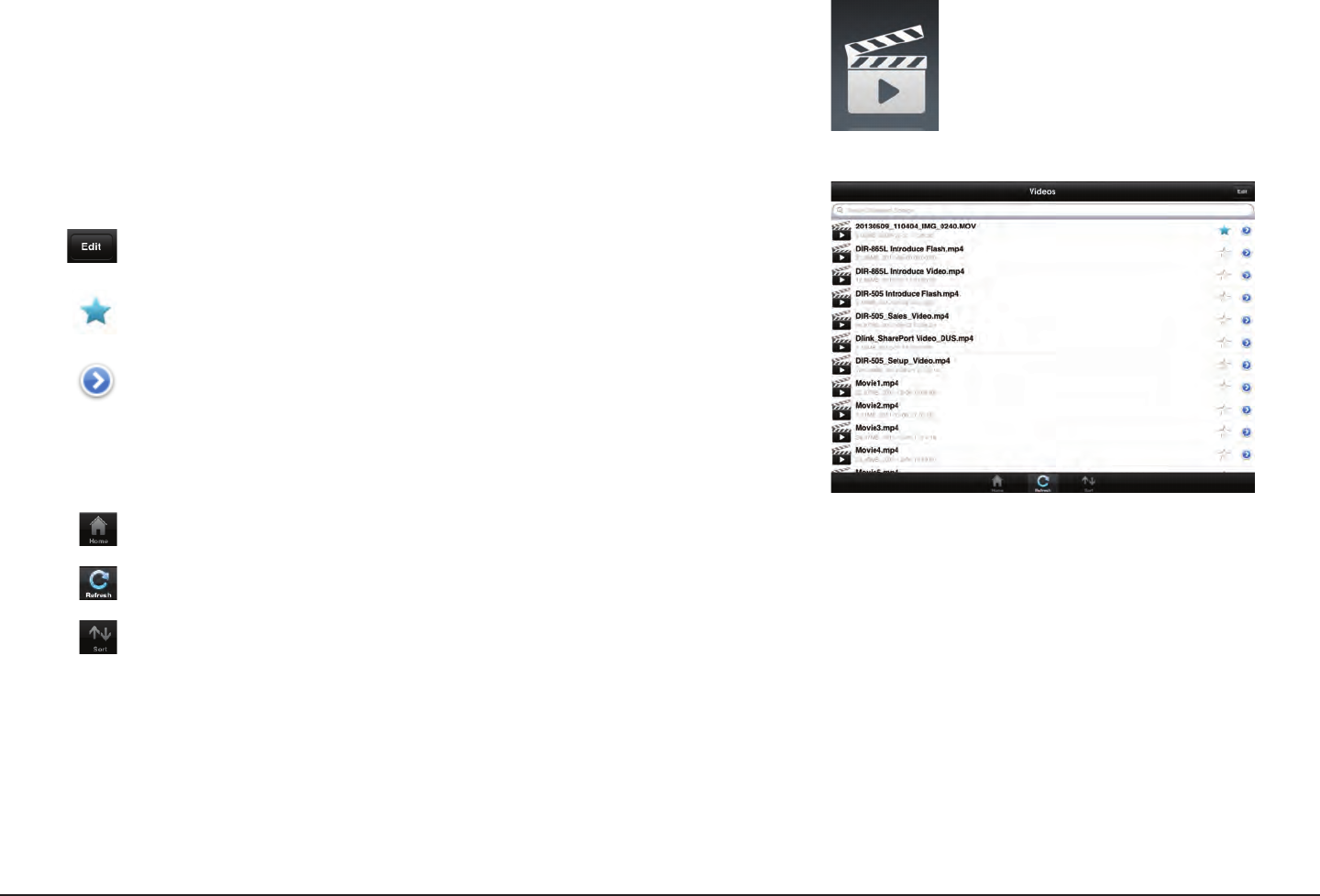
30D-Link DIR-850L User Manual
Section 3 - Usage
Videos
The Videos section allows you to stream video clips and movies from your
DIR-850L to your mobile device. Tap the movie icon on the main menu
to browse your videos on your removable storage.
Enter a lename here to search for a specic le.
Tap to mark les for deletion.
Tap the star icon next to a le to download it to your device and add
it into your Favorites section.
Tapping this icon gives you additional options:
•Open In...: Lets you use a third-party app to open the le.
Search Bar:
The bottom menu bar includes these options:
Tap to go back to the main menu.
Tap to update the list of les.
Tap to reorder the les alphabetically.
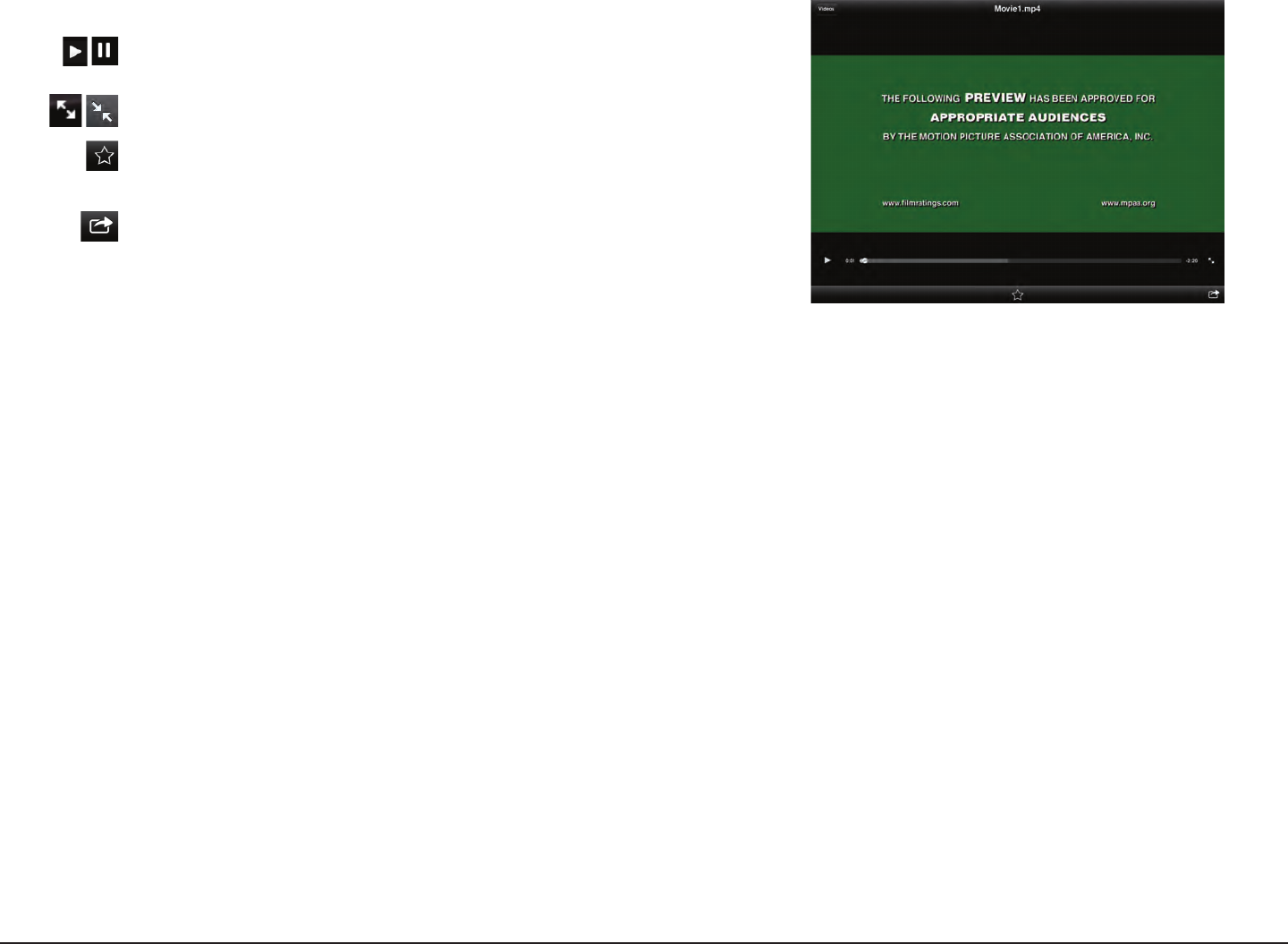
31D-Link DIR-850L User Manual
Section 3 - Usage
Tap on a le to start playing it. In the player:
Tap to play/pause the video. You can scroll to any time
on the time line by holding and sliding your nger.
Tap to enter/exit fullscreen mode.
Tap to add/remove the le from your Favorites.
Tapping this icon gives you additional options:
•Open In...: Lets you use a third-party app to open the le.
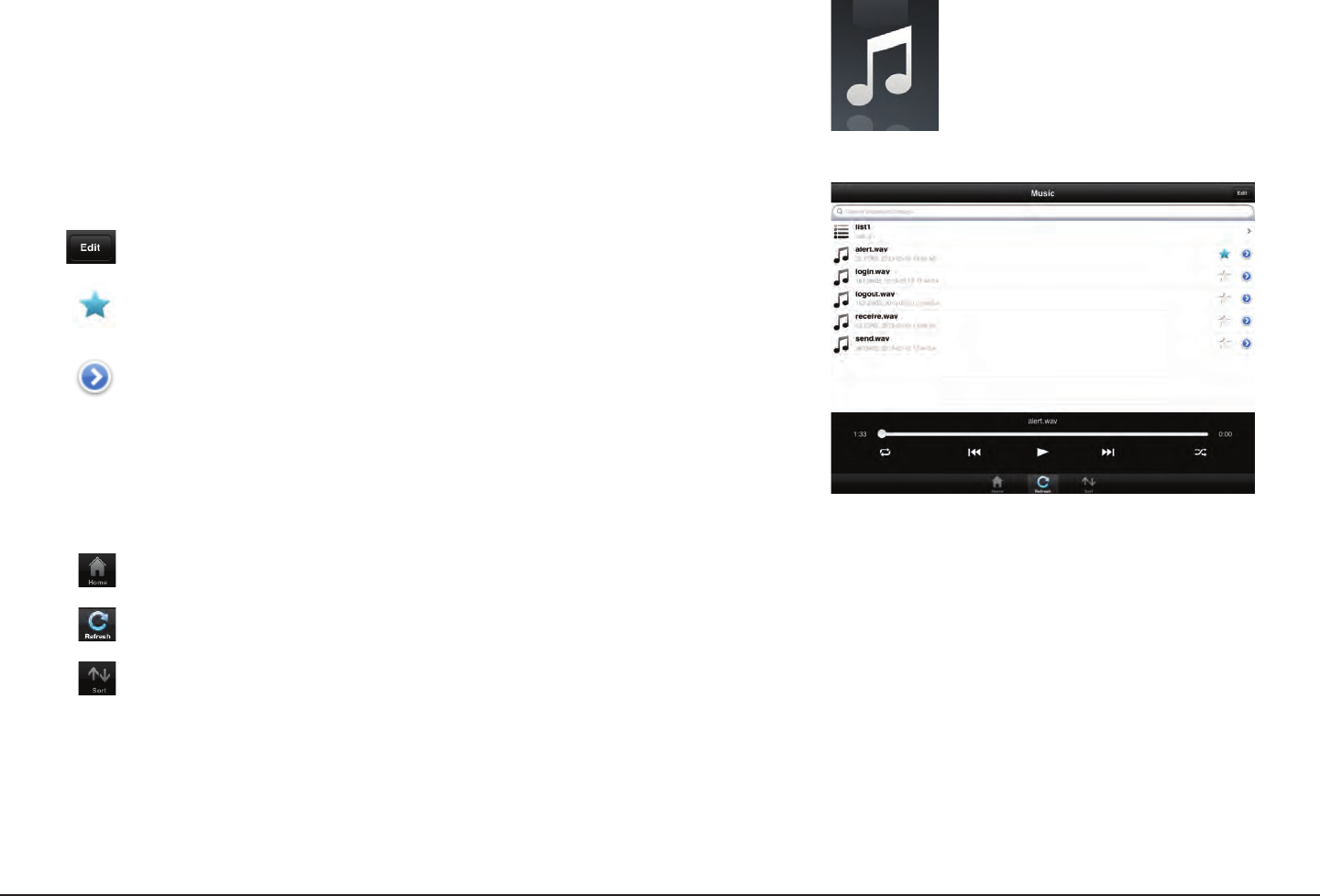
32D-Link DIR-850L User Manual
Section 3 - Usage
Music
The Music section allows you to stream songs from your DIR-850L to
your mobile device. Tap the music icon on the main menu to browse
your music collection on your removable storage.
The bottom menu bar includes these options:
Enter a lename here to search your storage.
Tap to create a playlist and mark les for deletion.
Tap the star icon next to each le to download it to your device and
add it into your Favorites section.
Tapping this icon gives you additional options:
•Open In...: Lets you use a third-party app to open the le.
Search Bar:
Tap to go back to the main menu.
Tap to update the list of les.
Tap to reorder the les alphabetically.
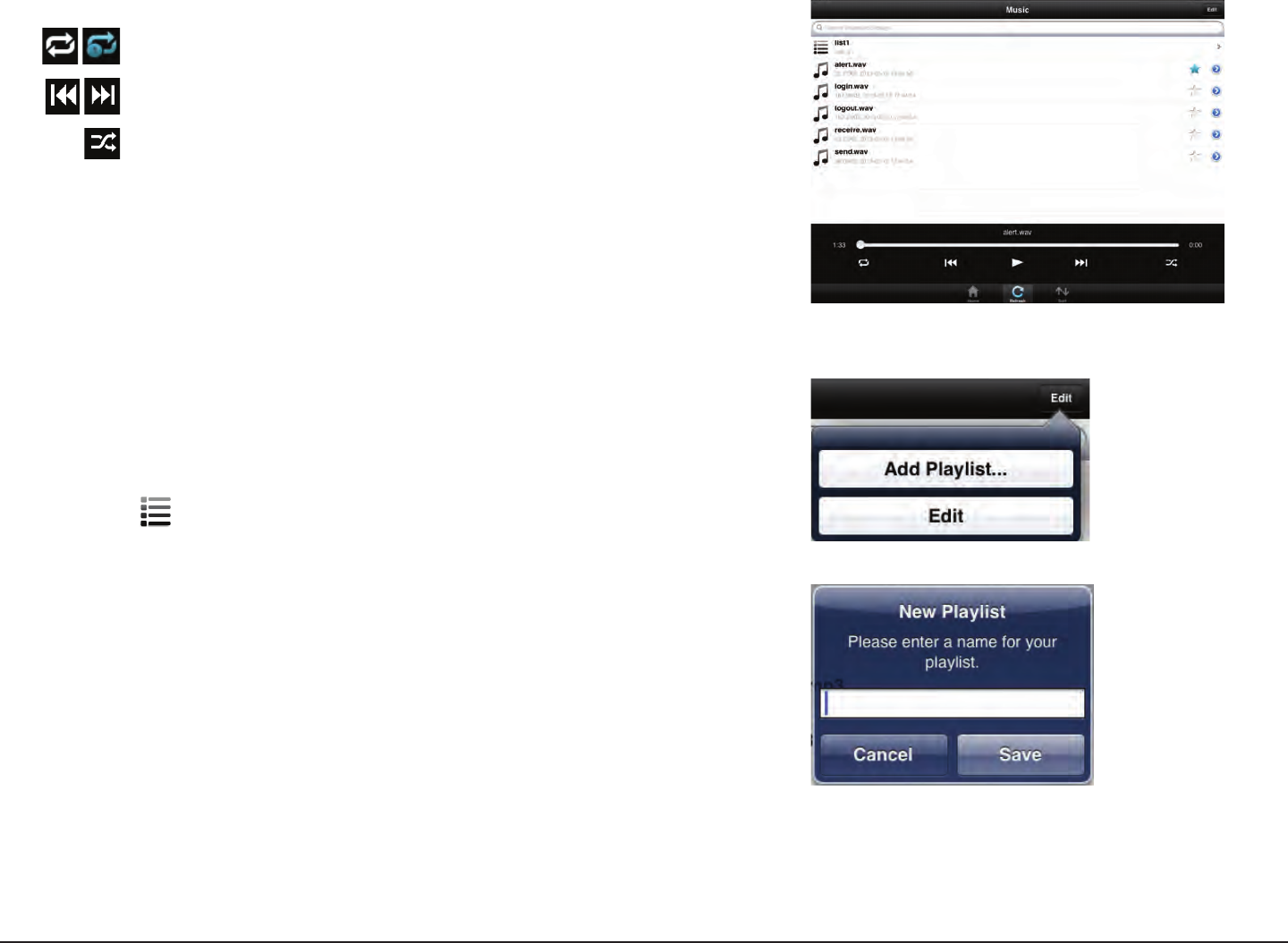
33D-Link DIR-850L User Manual
Section 3 - Usage
Tap on a le to start playing it. In the player:
Tap to repeat all. Tap again to repeat a single song.
Tap to skip to the previous/next song.
Tap to enable/disable shue mode.
To create a playlist:
• Tap Edit > Add Playlist.
• Enter a name for the playlist, then tap Save.
• The name of the playlist will appear in the browser next
to the icon.
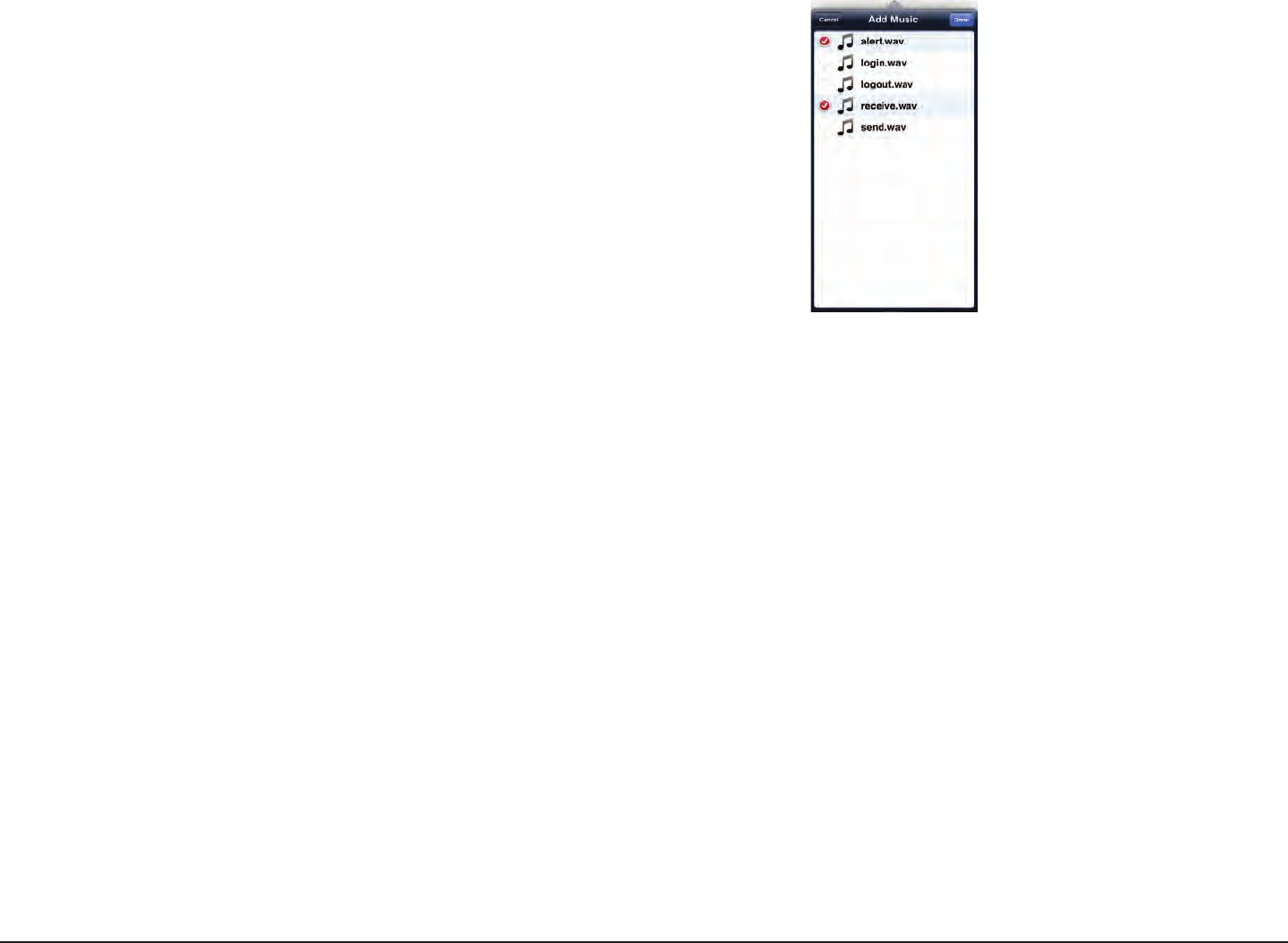
34D-Link DIR-850L User Manual
Section 3 - Usage
To add songs to a playlist:
• Tap the playlist in the browser.
• Tap Add Music... to add songs to the current playlist.
• Tick the songs you wish to add and tap Done.
To delete songs from the playlist:
• Tap Edit in the playlist browser and mark the les to be de-
leted.
• Tap Delete.
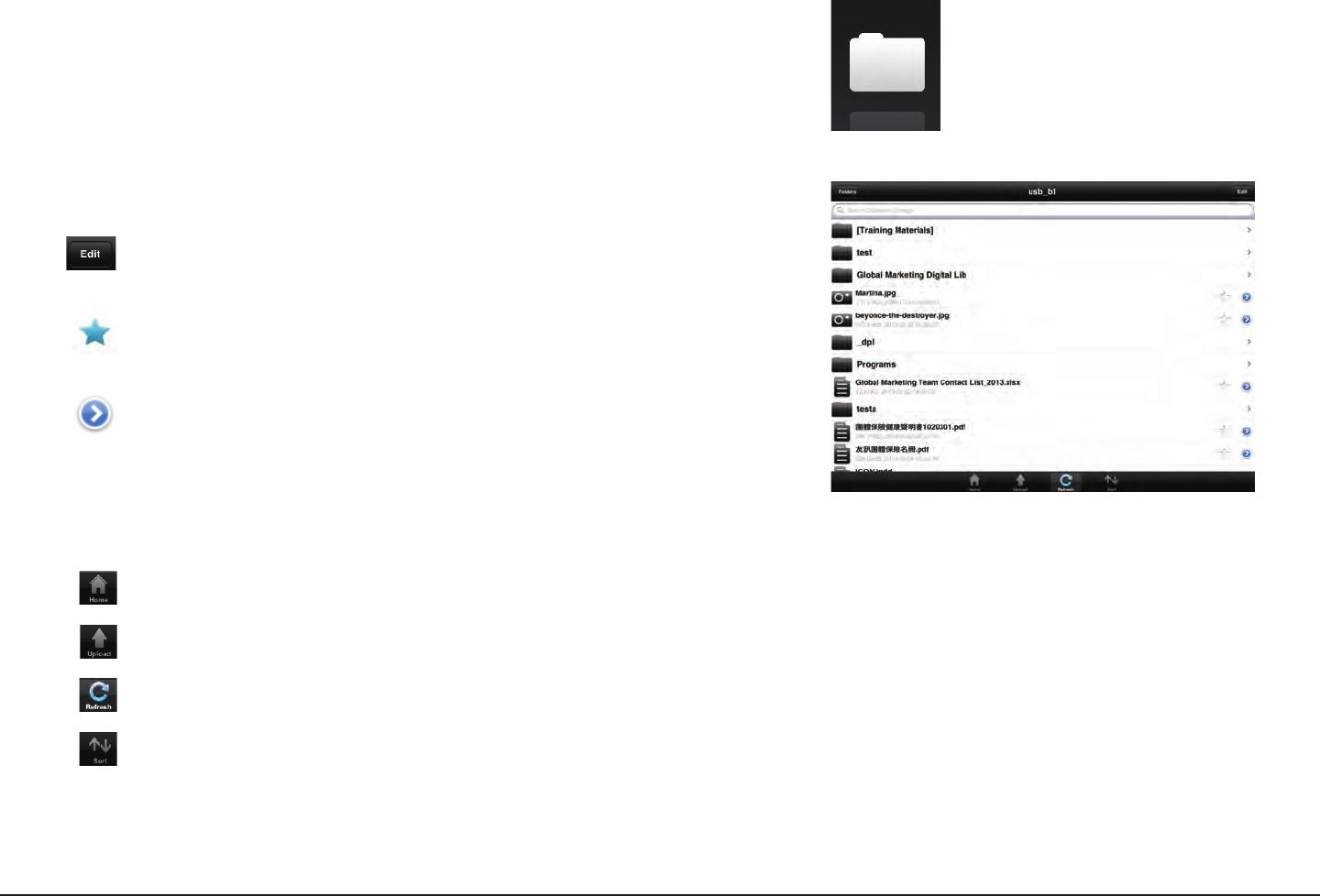
35D-Link DIR-850L User Manual
Section 3 - Usage
Folders
You can browse your removable storage in a folder view in the folders
section. Tapping the lename will open the viewer/player for that le
type as described in the previous pages. You can also upload les from
your mobile device to the removable storage attached to your router.
Enter a lename here to search your storage.
Tap to take you to the editing screen where you can add a folder and
mark les for deletion or copying.
Tap the star icon next to each le to download it to your device and
add it into your Favorites section.
Tapping the > icon gives you additional options depending on the
le type.
Search Bar:
The bottom menu bar includes these options:
Tap to go back to the main menu.
Tap to upload les from your device to your removable storage.
Tap to update the list of les.
Tap to reorder the les alphabetically.
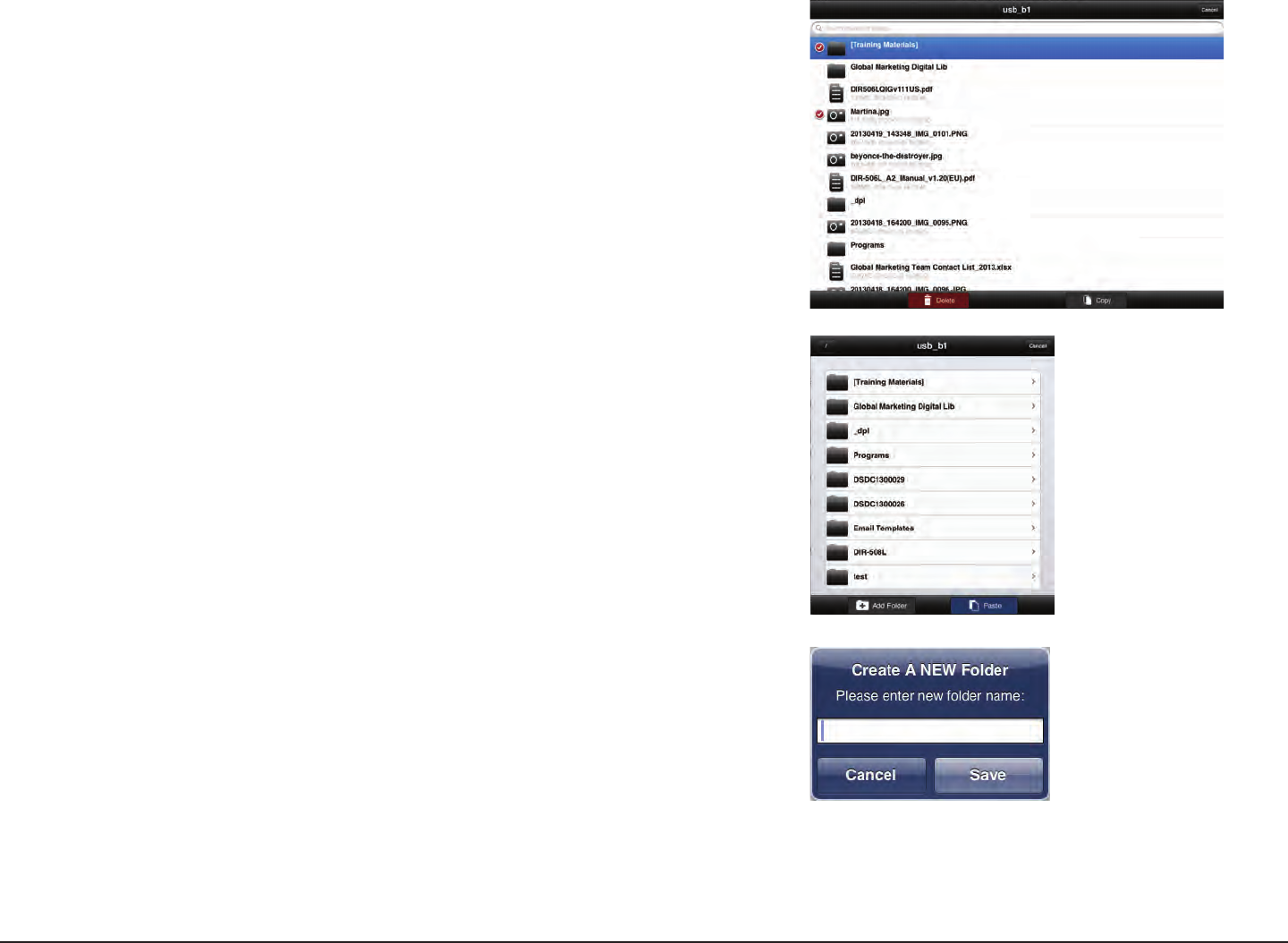
36D-Link DIR-850L User Manual
Section 3 - Usage
To delete les:
• Tap Edit at the top right.
• Tick the circle next to a le to mark it for deletion.
• Tap on Delete at the bottom to delete the le.
To create a new folder:
• Browse to the directory you wish to create a new folder in.
• Tap Edit at the top right.
• Tap Add Folder to add a new folder.
• Enter the name of the new folder, then tap Save.
• Tap OK to conrm folder creation.
To copy les:
• Tap on Copy to bring up a window where you can select the
folder to copy to.
• Browse to the directory you want to copy the marked les to and
tap Paste.
• You can also tap Add Folder to create a new folder.
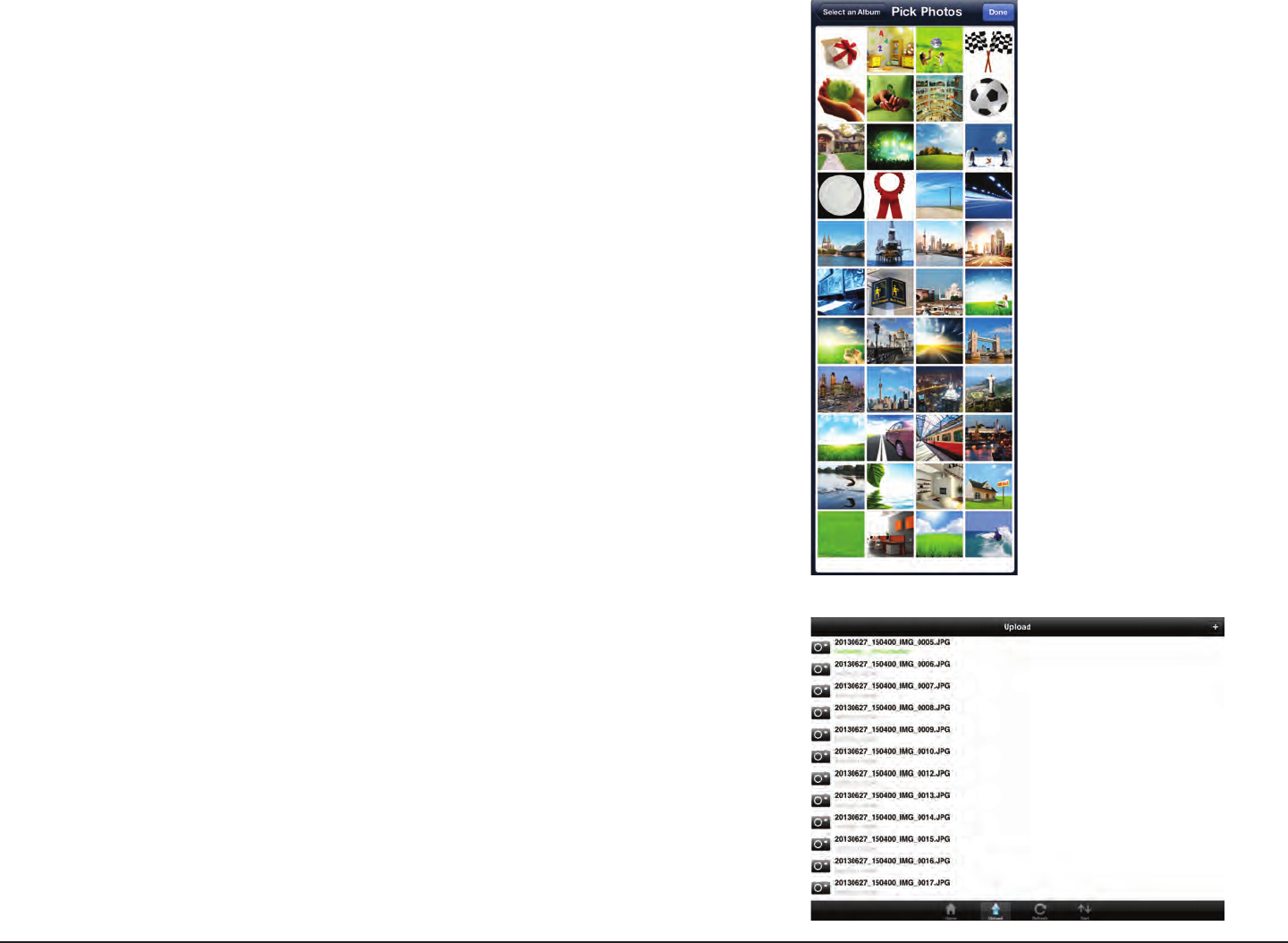
37D-Link DIR-850L User Manual
Section 3 - Usage
To upload images and videos from your mobile device:
• Browse to the folder you wish to upload to.
• Tap Upload at the bottom.
• Select the photos/videos you wish to upload.
• Tap Done.
During the upload process, the size of the le and the upload progress
will be displayed.
To upload more les, tap the + icon at the top right and repeat the steps
listed above.
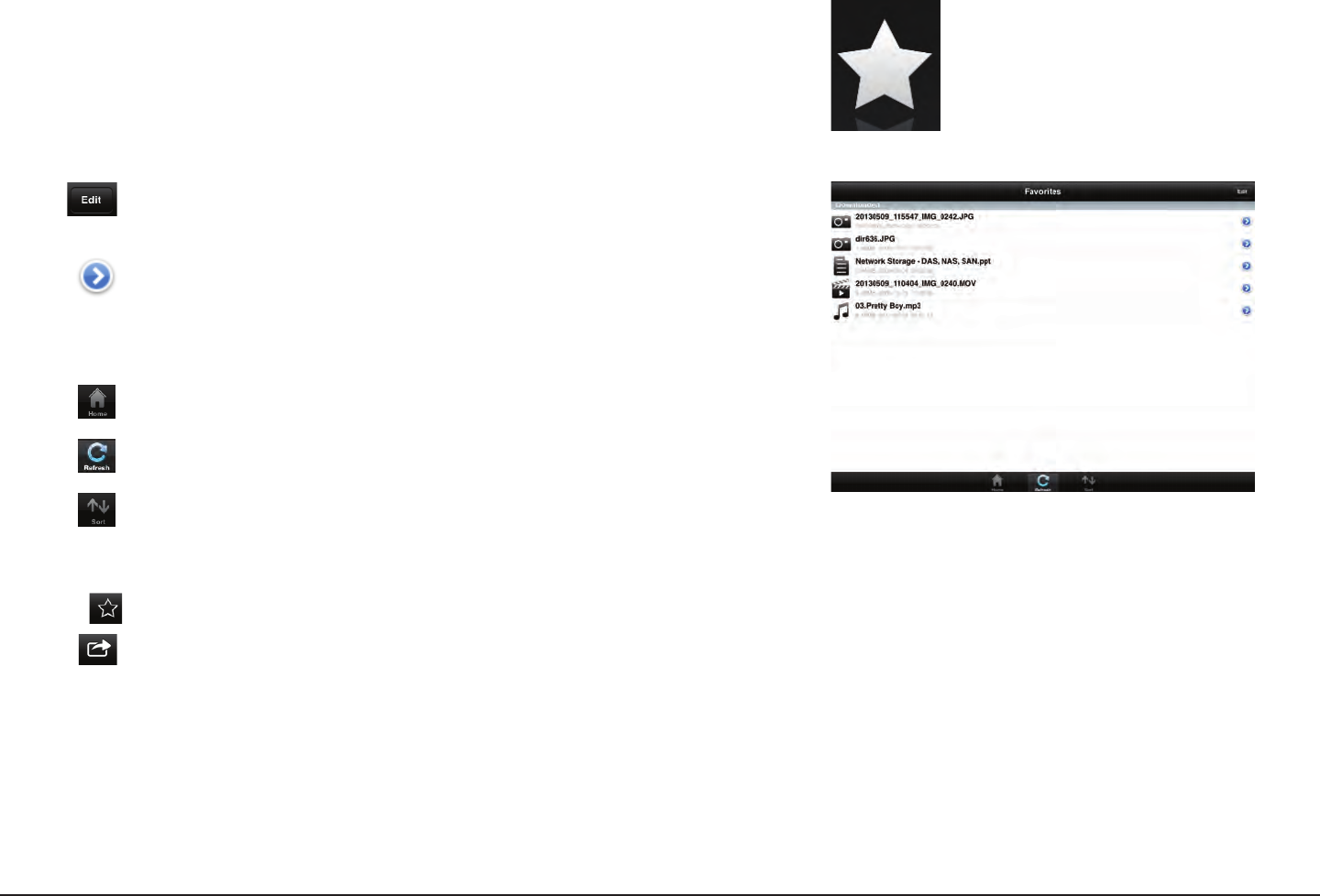
38D-Link DIR-850L User Manual
Section 3 - Usage
Favorites
The Favorites section allows you to quickly access your most often used
les, no matter what le type, in a special section. Files added to the
Favorites section will be copied here for playback in a centralized location.
Tap to mark les for deletion from the local storage in Favorites. The
le will still be accessible in other mydlink SharePort sections.
Tapping this icon gives you additional options depending on the le
type.
The bottom menu bar includes these options:
Tap on a le to start the le viewer. In the viewer:
Tap to add/remove the le from your Favorites.
Tap to bring up additional options.
Note: The le options available will vary depending on the le type.
Tap to go back to the main menu.
Tap to update the list of les.
Tap to reorder the les alphabetically.
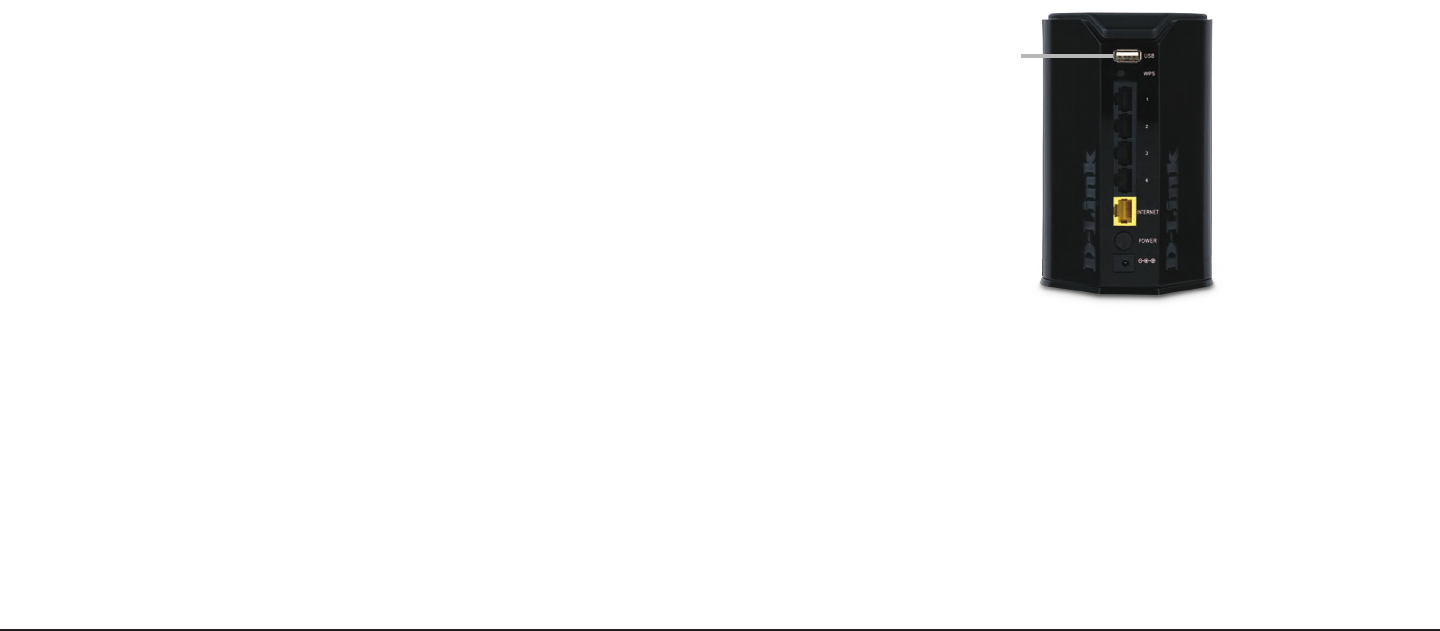
39D-Link DIR-850L User Manual
Section 3 - Usage
Using the mydlink SharePort app for Android™
The mydlink SharePort app is a streamlined mobile application that allows you to conveniently stream media and share les
stored on a removable storage connected to your router. Once the router is set up, you can start the app and easily connect
from a local network or through the Internet to access your photos, videos, music, and documents. It allows you to create your
own personal cloud storage; you can upload les and photos from your mobile device to the removable storage via the app
from anywhere in the world!
Note: In order to ensure smooth streaming performance, you will need a minimum of 2 Mbit/s upload bandwidth for your router’s Internet connection.
Streaming performance will vary depending on the quality of your Internet connection.
1. If you are connecting remotely through the mydlink SharePort app
from the Internet, you will need a mydlink account. Please refer to
page 99 for more details.
2. Make sure the device is powered on. Then plug your USB drive into
the USB port of the device.
Note: If you connect a removable storage with many les or a large capacity, it may
take a while for the router to scan and catalog your les.
USB Port
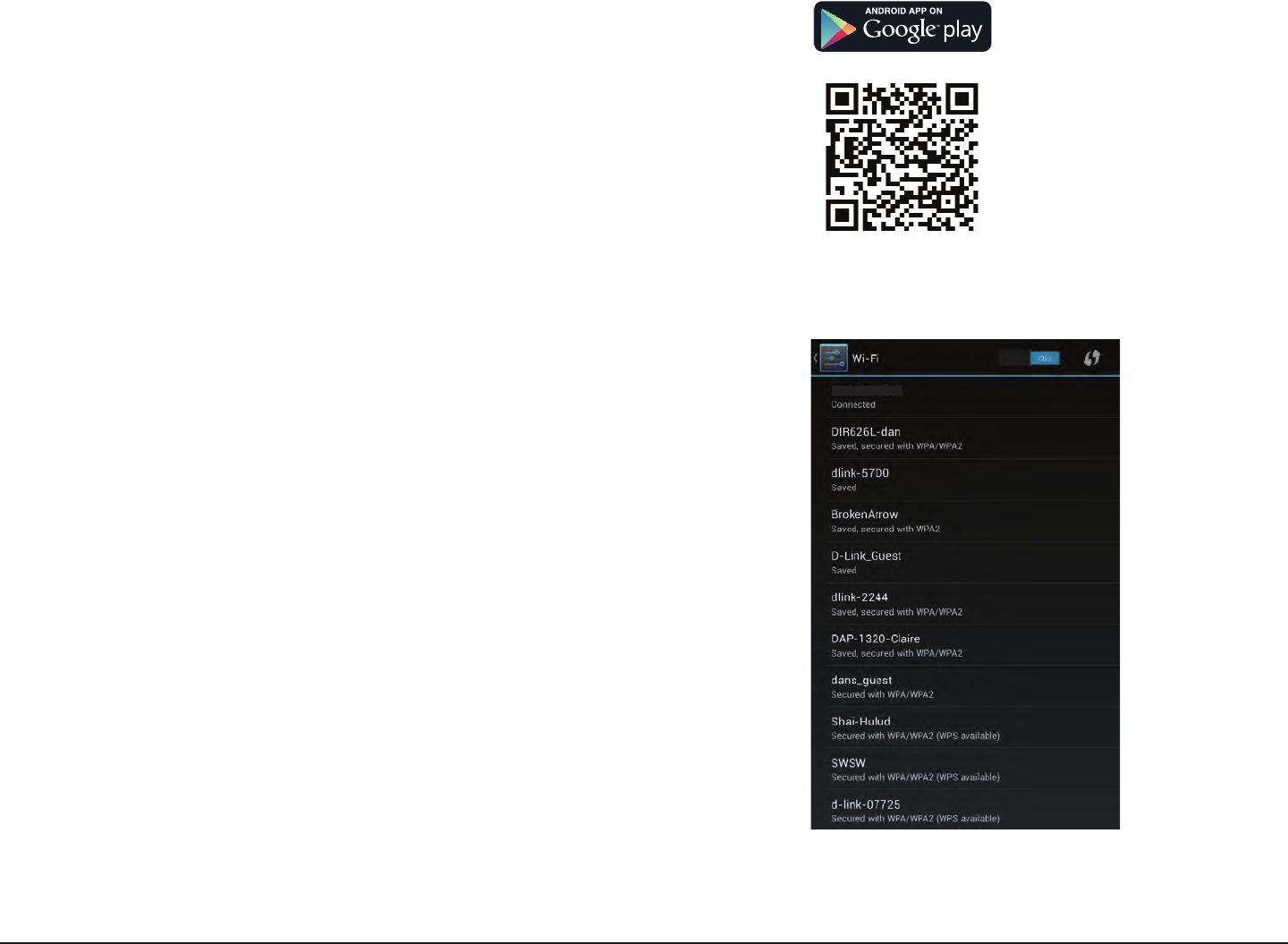
40D-Link DIR-850L User Manual
Section 3 - Usage
4. If you are connecting to the router from a local network:
On your mobile device, go to your Wi-Fi settings and connect to
your router’s wireless network using the default Wi-Fi settings.
Locate the Wi-Fi name (SSID) and password for your device as
printed on the included Wi-Fi Conguration Card.
If you are connecting to the router from a remote network:
Go directly to the next step.
3. Use your Android mobile device to search for and download the free
mydlink SharePort app from Google Play™.
If you have a QR code reader, you can scan the code for mydlink
SharePort to the right.
DIR-850L
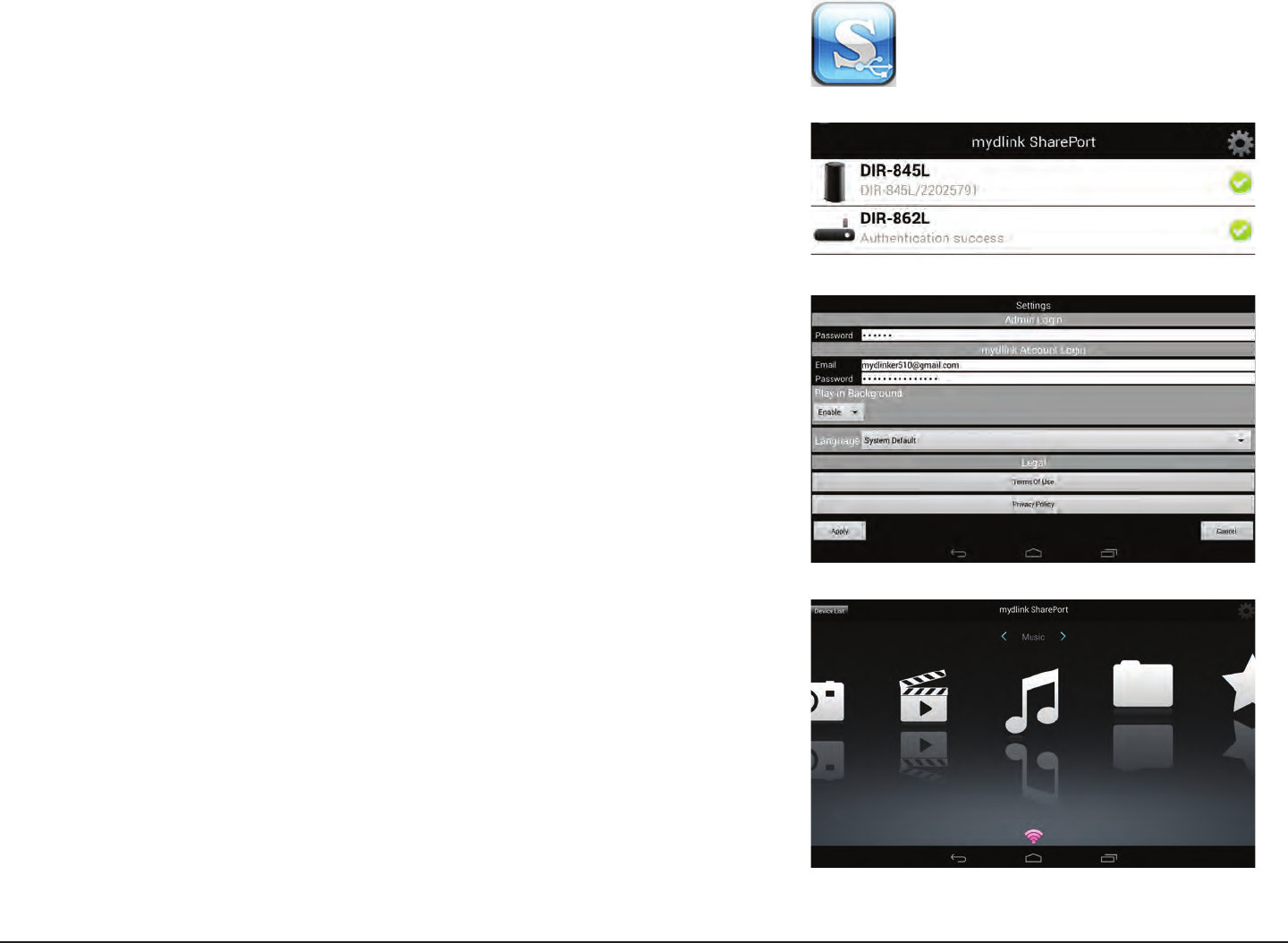
41D-Link DIR-850L User Manual
Section 3 - Usage
Note: If you see a red wireless icon, your router’s network environment may not
be suitable for a direct network connection and you may experience slow
network speeds.
5. Tap the mydlink SharePort icon, and the app will load.
6. At the mydlink SharePort device list page, tap the gear icon at the
top right to enter the Settings page.
7. Enter your Admin Login and your mydlink Account Login information
in the elds and click Apply. You will be taken back to the device
list where you can select the device for use with mydlink SharePort.
8. You can now use the mydlink SharePort app interface to stream media
and access les stored on your removable drive. The wireless icon at
the bottom will be lit blue to indicate a Local Access connection. It will
be green to indicate you are connected to the router through Remote
Access.
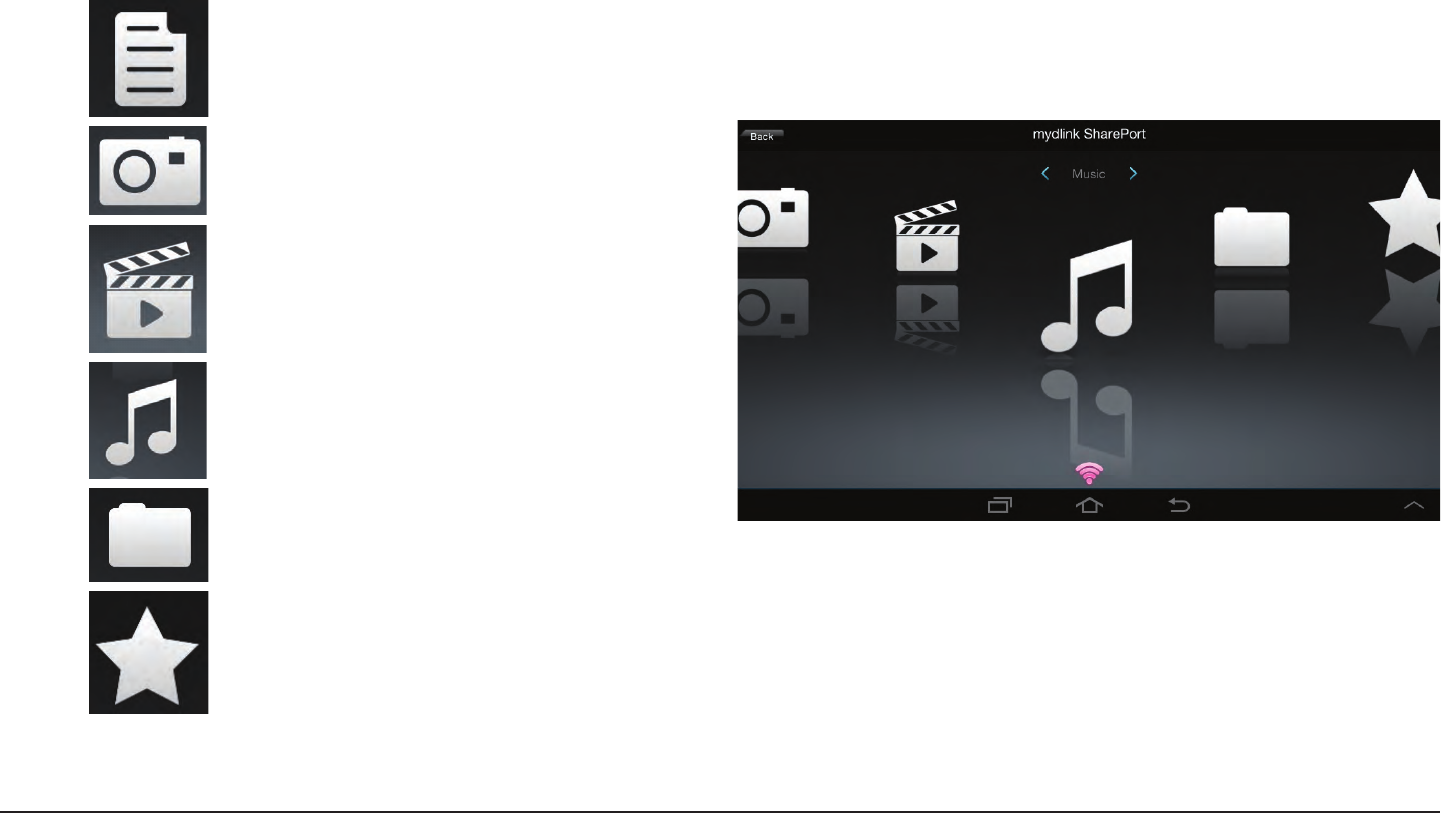
42D-Link DIR-850L User Manual
Section 3 - Usage
Note: Available features may dier depending on the Android OS version
of your device.
Main Menu
Tap on the document icon to view documents.
Tap the camera icon to view pictures.
Tap on the movie icon to play videos.
Tap on the music icon to play audio les.
Tap on the folder icon to browse all les in a
folder view.
Tap on the star icon to access your favorite les.
The mydlink SharePort main menu has dierent sections that let you see all the documents, photos, movies, or music stored
on your removable storage. Tap < or >, or swipe left or right to move between the dierent sections. The Wi-Fi icon at the
bottom indicates an active local network connection (blue) or remote connection (green/red). Tap the gear icon if it is not lit.
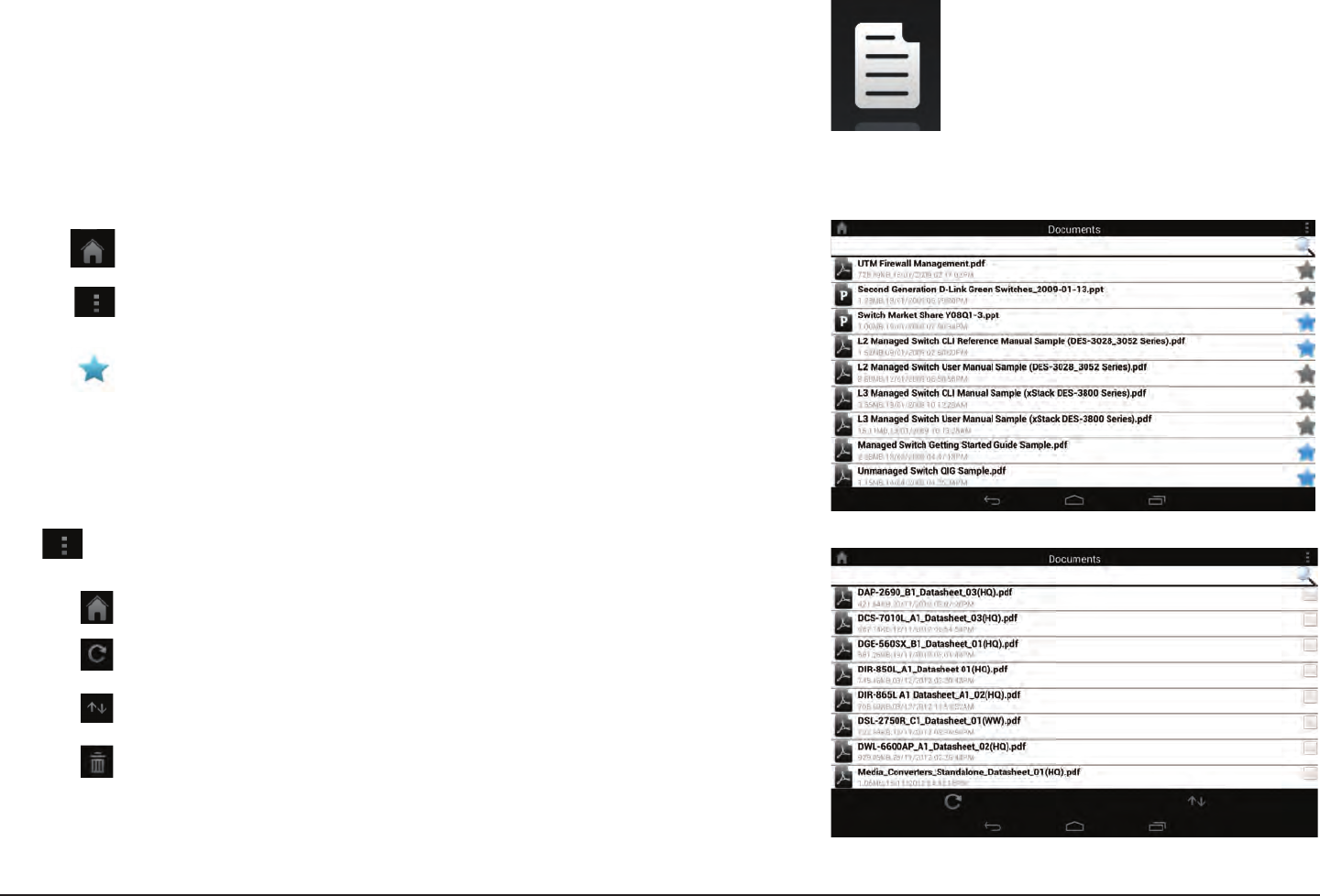
43D-Link DIR-850L User Manual
Section 3 - Usage
Documents
The Documents section allows you to share, print, and view documents
streamed from your DIR-850L to your mobile device. Tap the document
icon on the main menu to browse the les on your mobile device.
Type in the name of a le to search for it.
Tap to return to the main menu.
Tap to refresh, sort, or mark les for deletion.
Tap the star icon next to each le to download it to your device and
add it into your Favorites section.
Search Bar:
Tap for additional options:
Tap to return to the main menu.
Tap to update the list of les.
Tap to sort the les by name, size, type, or date.
Check a le then tap to delete it.
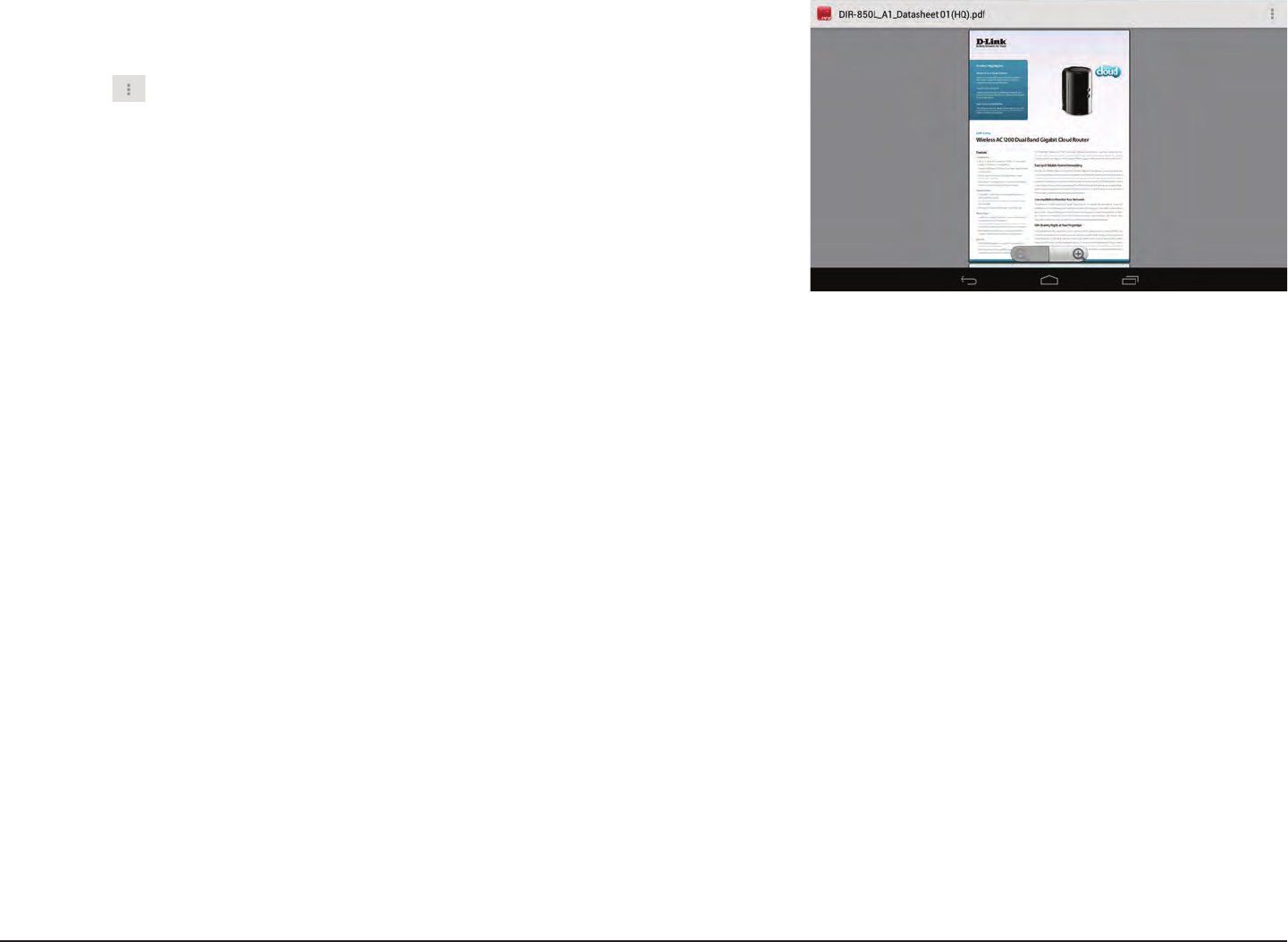
44D-Link DIR-850L User Manual
Section 3 - Usage
Tap on a le to start the document viewer. In the viewer:
• Tap the screen to bring up zoom in/out buttons.
• Drag the screen up or down to scroll between pages.
• Tap to perform File, Find, Zoom, Reading View, Go To Page,
and Bookmarks actions.
Note: Available actions may dier depending on your Android OS.
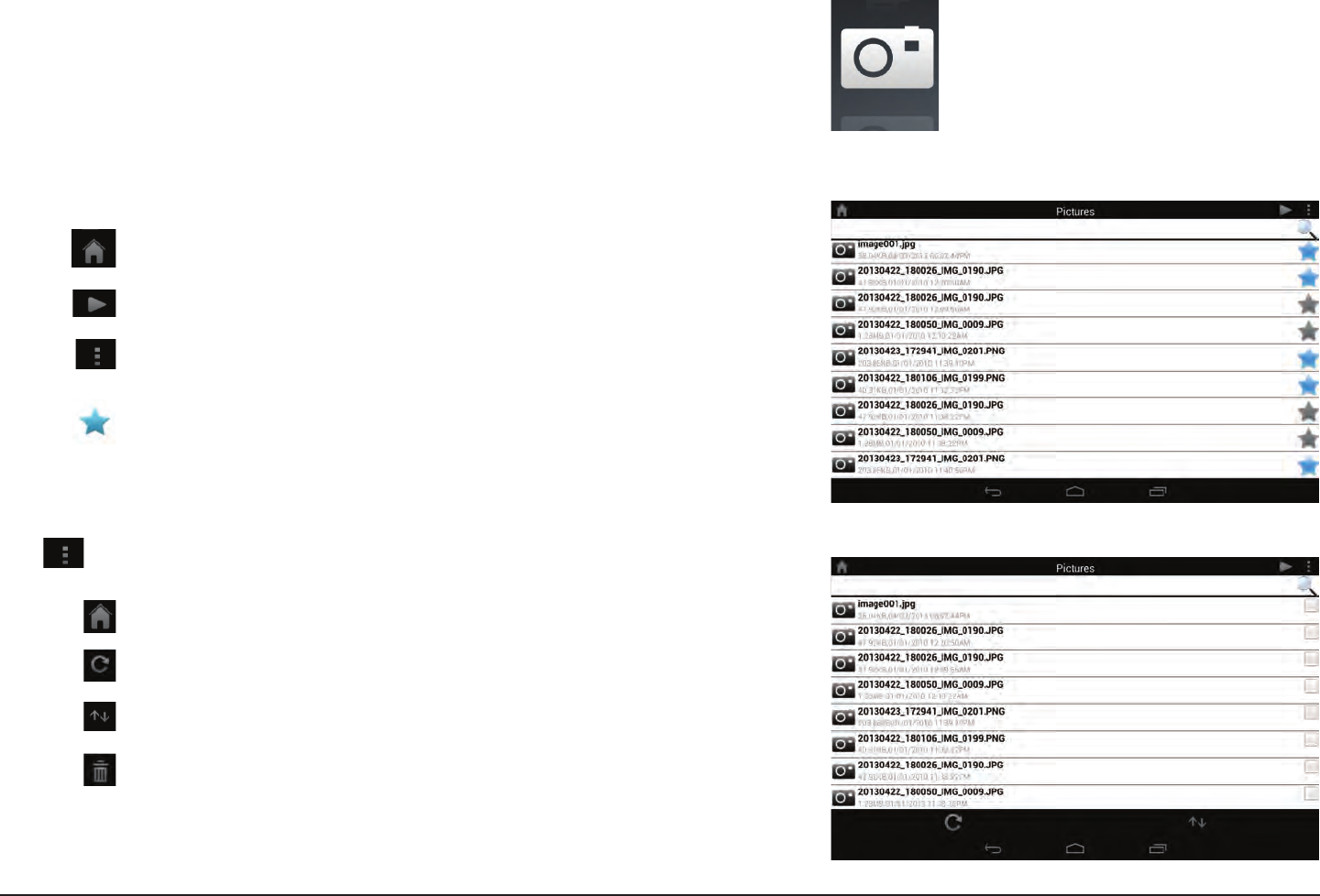
45D-Link DIR-850L User Manual
Section 3 - Usage
Pictures
The Pictures section allows you to view images streamed from your
DIR-850L to your mobile device. Tap the camera icon on the main menu
to browse your photo collection on your removable storage.
Type in the name of a le to search for it.
Tap to return to the main menu.
Tap to start a slideshow.
Tap to refresh, sort, or mark les for deletion.
Tap the star icon next to each le to download it to your device and
add it into your Favorites section.
Search Bar:
Tap to return to the main menu.
Tap to update the list of les.
Tap to sort the les by name, size, type, or date.
Check a le then tap to delete it.
Tap for additional options:

46D-Link DIR-850L User Manual
Section 3 - Usage
Tap on an image le to start the image viewer. In the viewer:
Tap the star icon to download it to your device and add it into your
Favorites section.
Tap to start a slideshow. Tap the image to stop the slideshow.
Tap to delete the current image. Tap OK to conrm.
Tap to bring up additional options using other applications.
Tap to access the image editor.
Note: This function may vary depending on the version of your Android
OS.
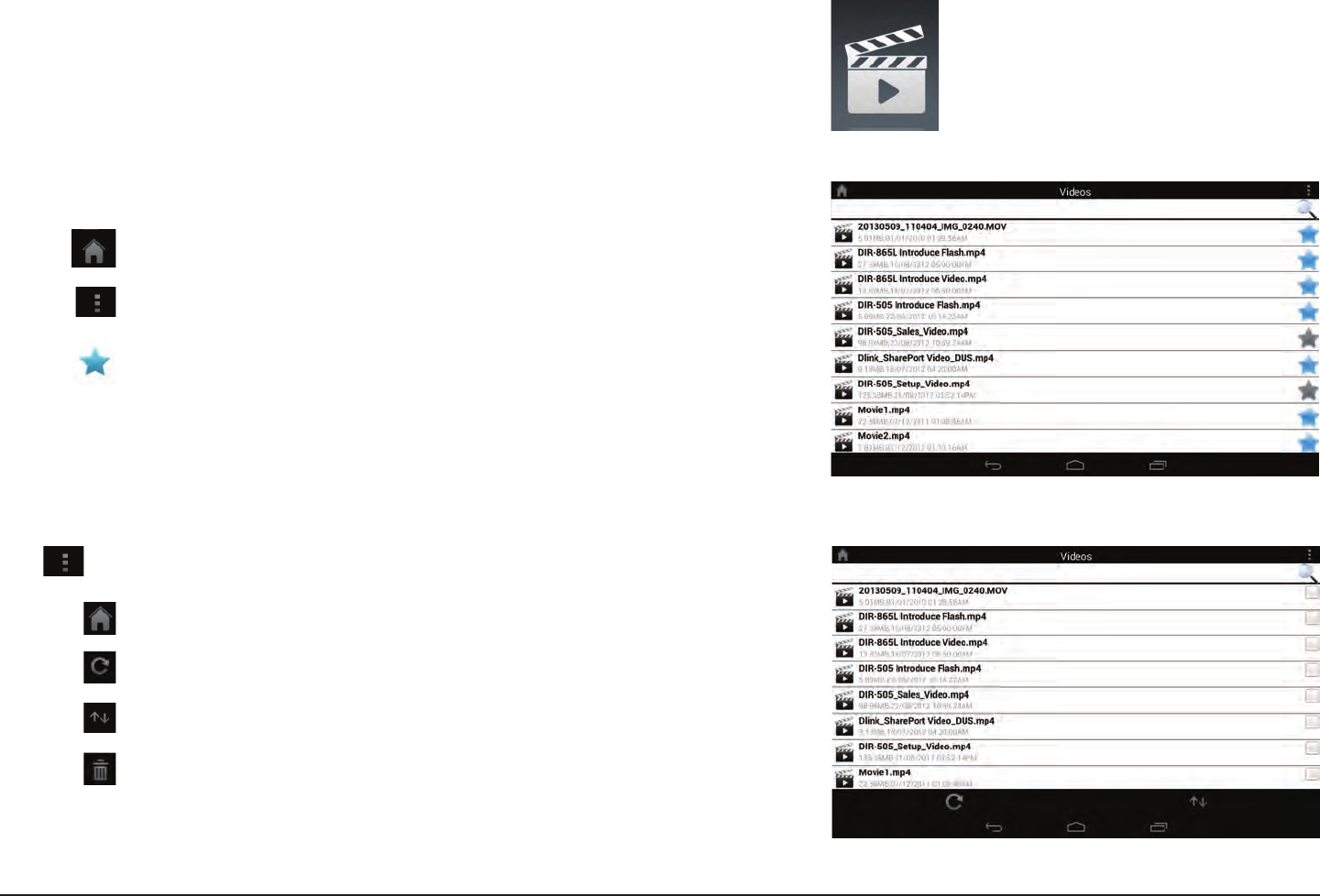
47D-Link DIR-850L User Manual
Section 3 - Usage
Videos
The Videos section allows you to stream video clips and movies from your
DIR-850L to your mobile device. Tap the movie icon on the main menu
to browse your videos on your removable storage.
Type in the name of a le to search for it.
Tap to return to the main menu.
Tap to refresh, sort, or mark les for deletion.
Tap the star icon next to a le to download it to your device and add
it into your Favorites section.
Search Bar:
Tap to return to the main menu.
Tap to update the list of les.
Tap to sort the les by name, size, type, or date.
Check a le then tap this icon to delete it.
Tap for additional options:

48D-Link DIR-850L User Manual
Section 3 - Usage
Tap on a le to start playing it. Tap on the screen to bring up the scroll
bar, pause button, and play button.
Tap to resume playback.
Tap to pause the video.
Note: Available features may vary depending on the Android OS version installed
on your device.
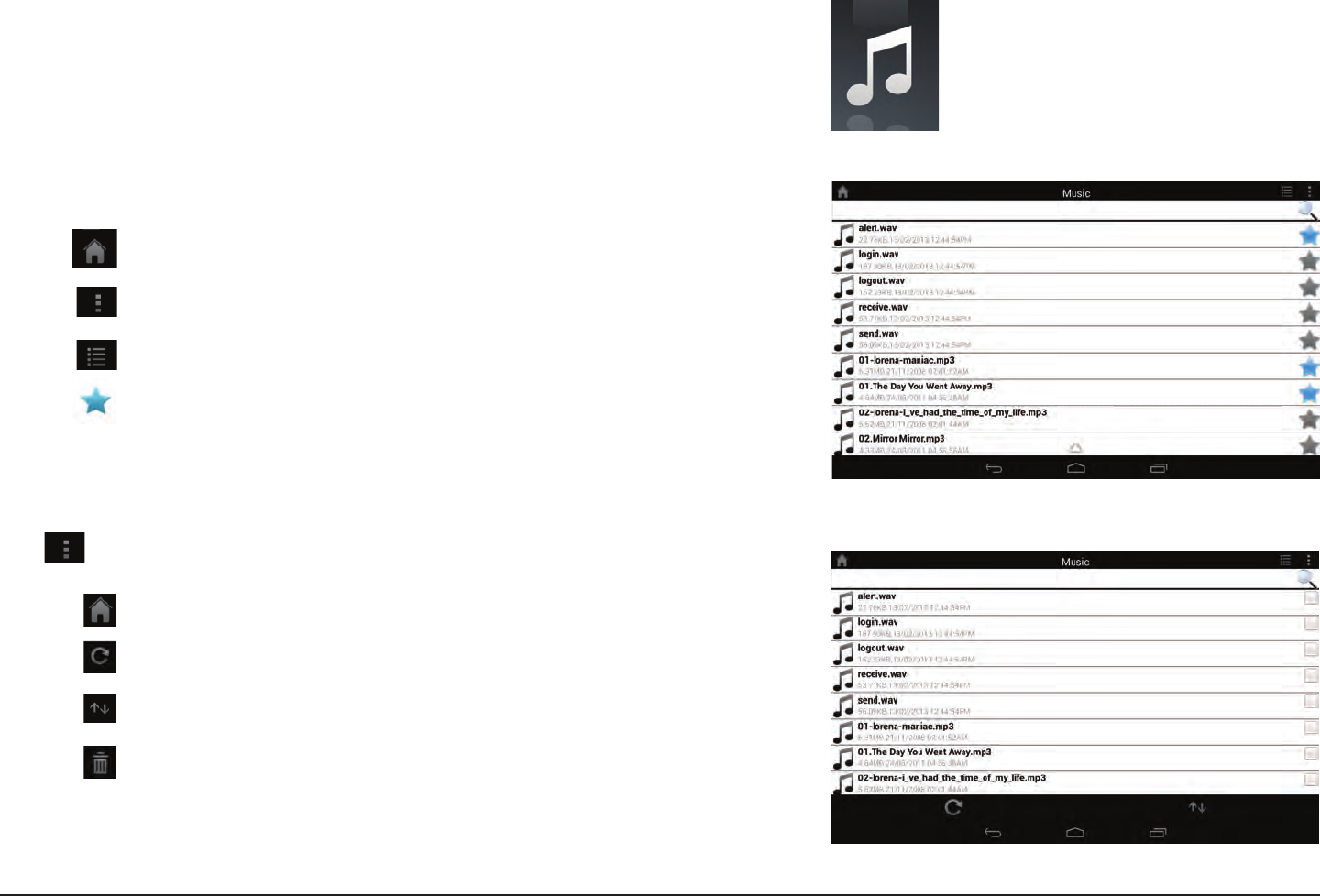
49D-Link DIR-850L User Manual
Section 3 - Usage
Music
The Music section allows you to stream songs from your DIR-850L to
your mobile device. Tap the music icon on the main menu to browse
your music collection on your removable storage.
Tap to return to the main menu.
Tap to update the list of les.
Tap to sort the les by name, size, type, or date.
Check a le then tap this icon to delete it.
Type in the name of a le to search for it.
Tap to return to the main menu.
Tap to refresh, sort, or mark les for deletion.
Tap to browse your playlists.
Tap the star icon next to a le to download it to your device and add
it into your Favorites section.
Search Bar:
Tap for additional options:
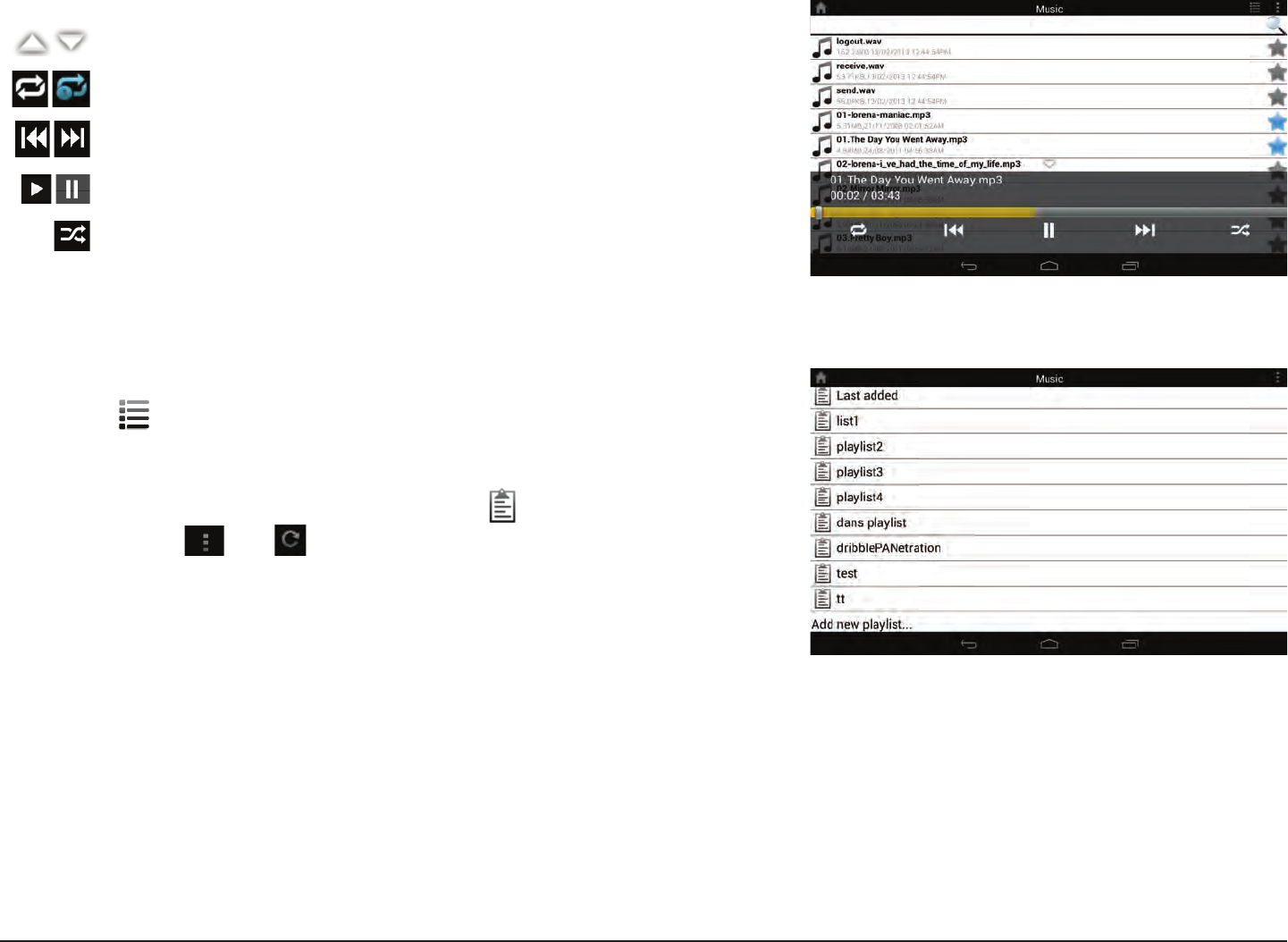
50D-Link DIR-850L User Manual
Section 3 - Usage
Tap on a le to start playing it. In the player:
Tap on the up/down arrow to show/hide the player controls.
Tap to repeat all. Tap again to repeat a single song.
Tap to skip to the previous/next song.
Tap to play or pause the song.
Tap to enable/disable shue mode.
To create a playlist:
• Tap
• Tap Add new playlist...
• Enter a name for the playlist, then tap OK. The name of the
playlist will appear in the browser next to the icon.
• You can tap then to refresh the playlist page.
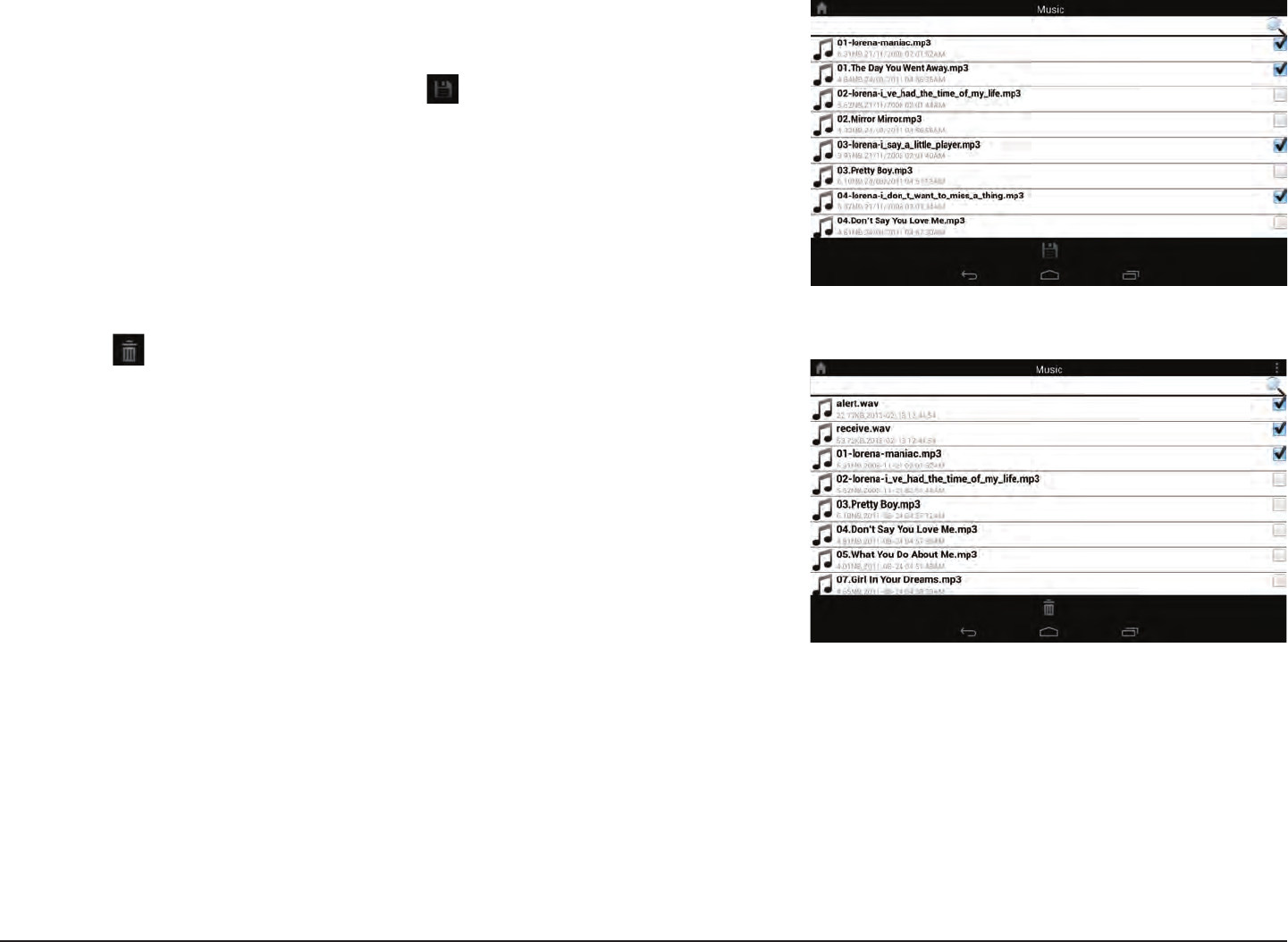
51D-Link DIR-850L User Manual
Section 3 - Usage
To add songs to a playlist:
• Tap a playlist to see its contents.
• Tap Add Music... to add songs to the current playlist.
• Tick the songs you wish to add and tap to save.
To delete songs from the playlist:
• Tap Edit in the playlist browser and mark the les to be de-
leted.
• Tap then tap OK to conrm.
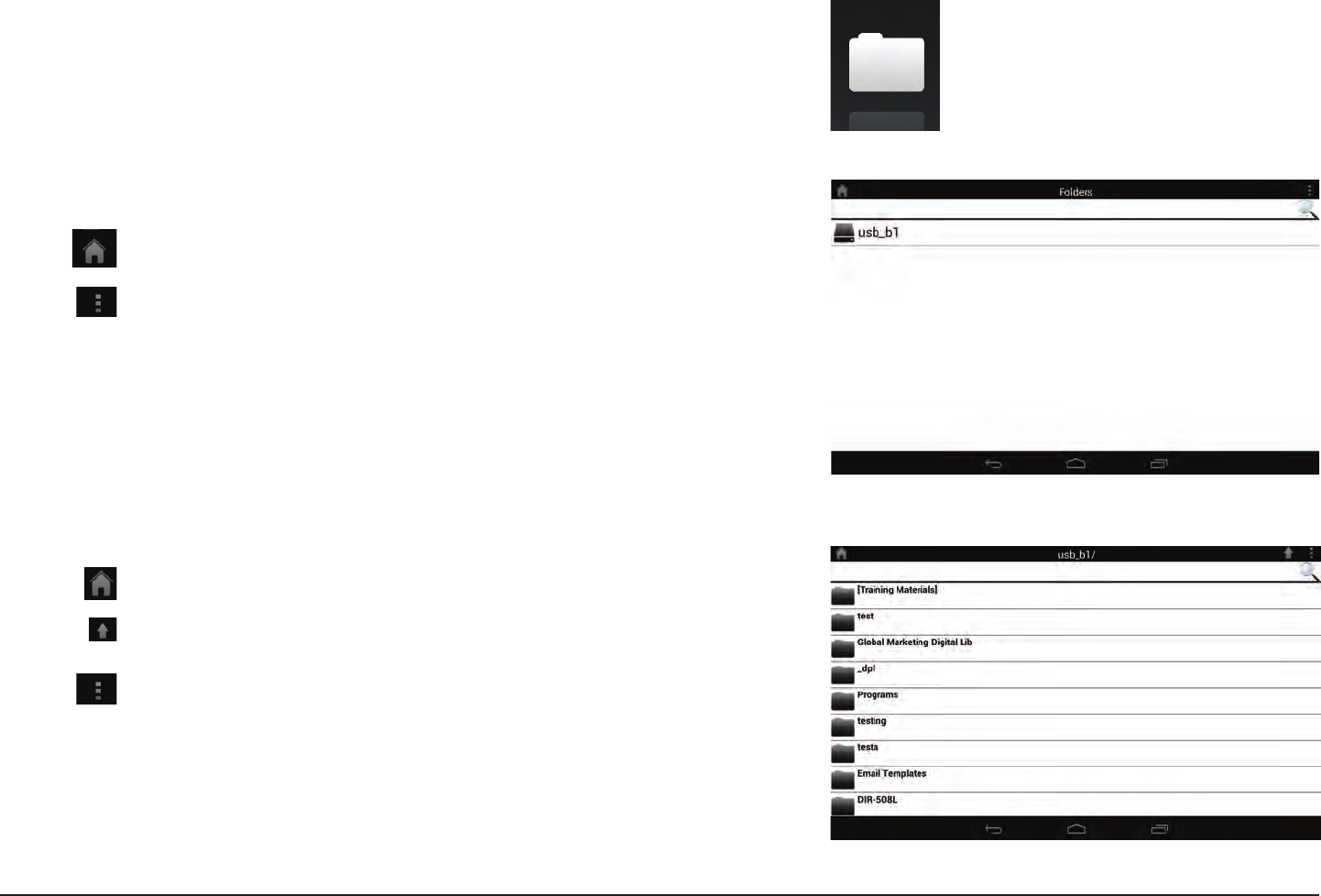
52D-Link DIR-850L User Manual
Section 3 - Usage
Folders
Type in the name of a le to search for it.
Tap to return to the main menu.
Tap to access le options.
Search Bar:
In the le browser:
Tap to return to the main menu.
Tap to upload les.
Tap to refresh, sort, create a new folder, or mark les for deletion and
copying.
You can browse your removable storage in a folder view in the folders
section. Tapping the lename will open the viewer/player for that le
type as described in the previous pages. You can also upload les from
your mobile device to the removable storage attached to your router.
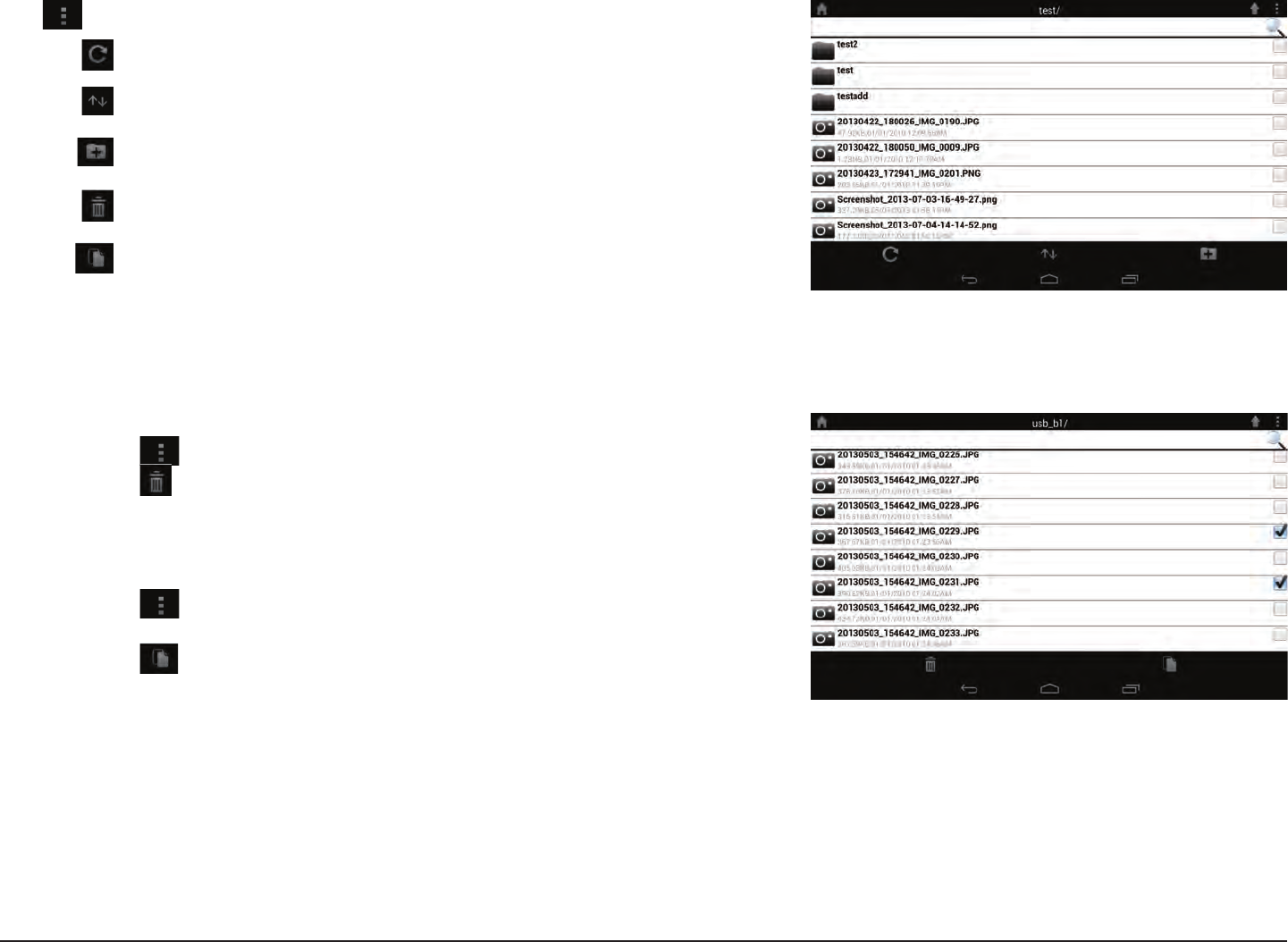
53D-Link DIR-850L User Manual
Section 3 - Usage
To copy les:
• Tap on to select les for copying. Tick the box next to each
le for copying.
• Tap on to browse to the destination.
Tap to select les and perform the following actions:
Tap to update the list of les.
Tap to sort the les by name, size, type, or date.
Tap to create a new folder.
Mark a le then tap this icon to delete it.
Mark a le then tap this icon to copy it.
To delete les:
• Tap on and tick the box next to a le for deletion.
• Tap on to delete your selected les. Tap OK to conrm.
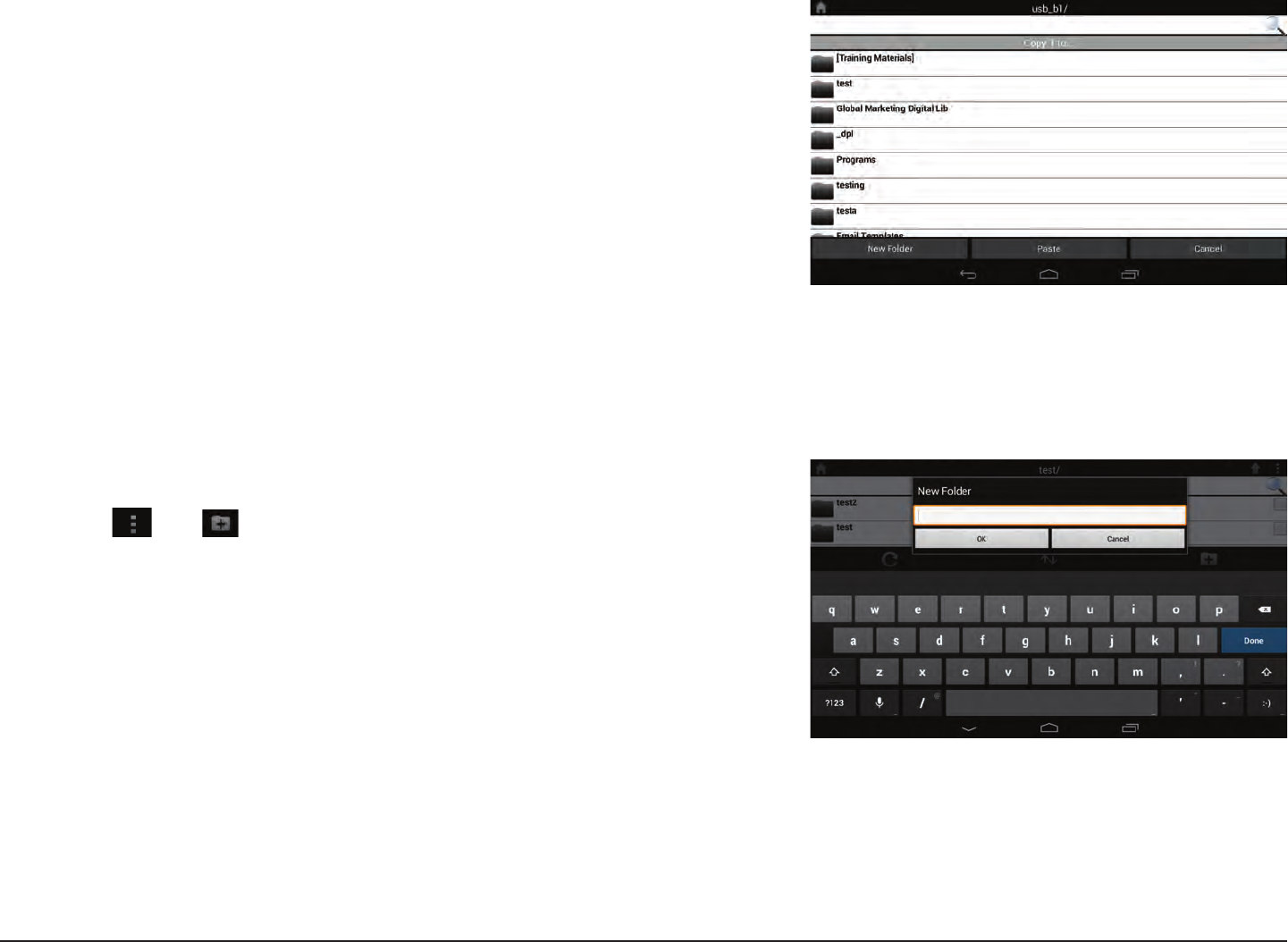
54D-Link DIR-850L User Manual
Section 3 - Usage
To create a new folder:
• Browse to the directory you wish to create a new folder in.
• Tap then .
• Enter the name of the folder in the box, then tap OK.
• Tap Paste or Cancel.
• You can also tap New Folder if you wish to create a folder in
the current directory.
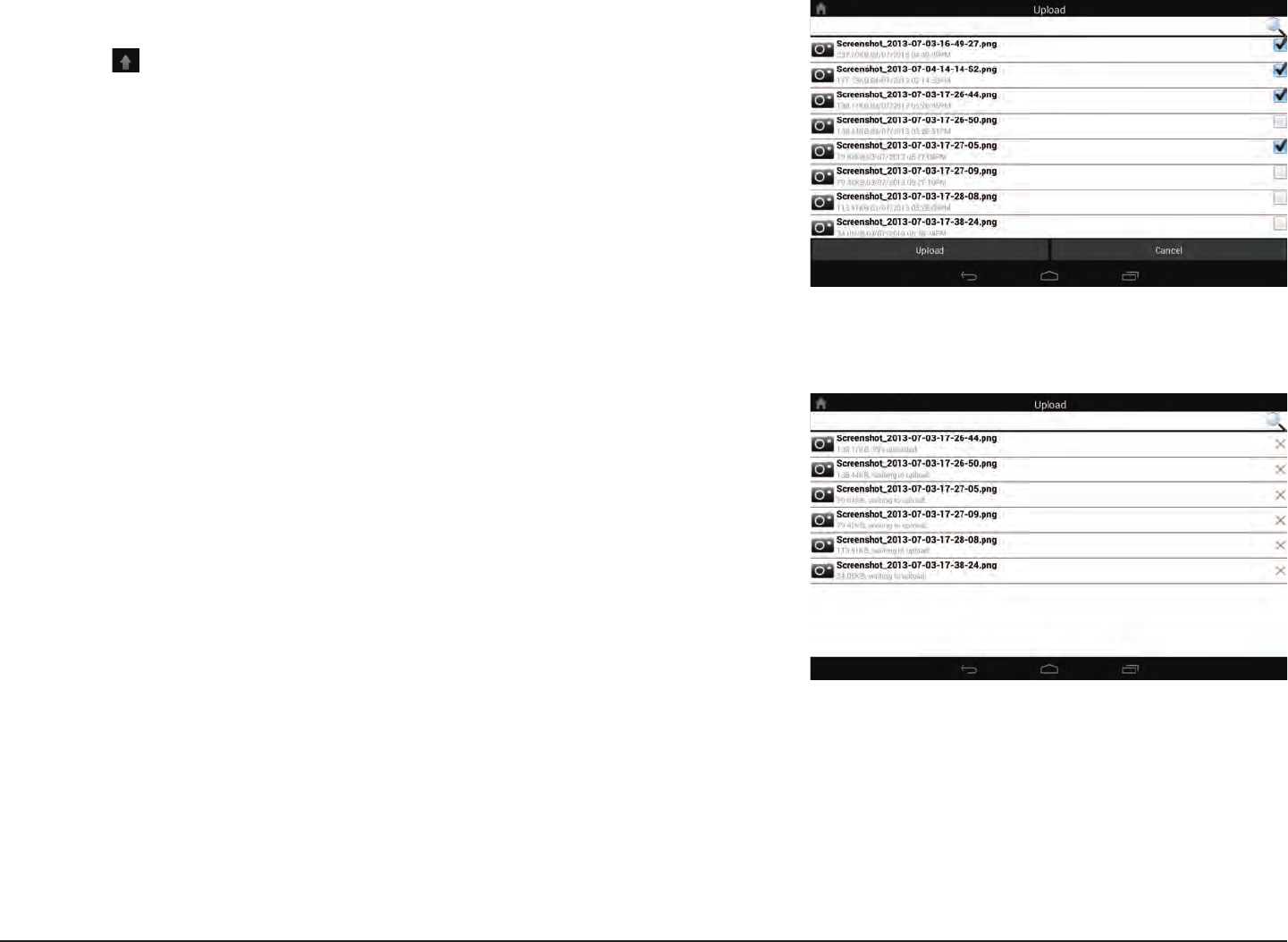
55D-Link DIR-850L User Manual
Section 3 - Usage
To upload images and videos from your mobile device:
• Browse to the folder you wish to upload to.
• Tap and browse to the le or les you wish to upload from the
local device.
• Tick the box next to each of the les you wish to upload.
• Tap Upload.
During the upload process, the size of the le and the upload progress
will be displayed under the le name.
• To remove a le from the upload queue, tap the X next to it.
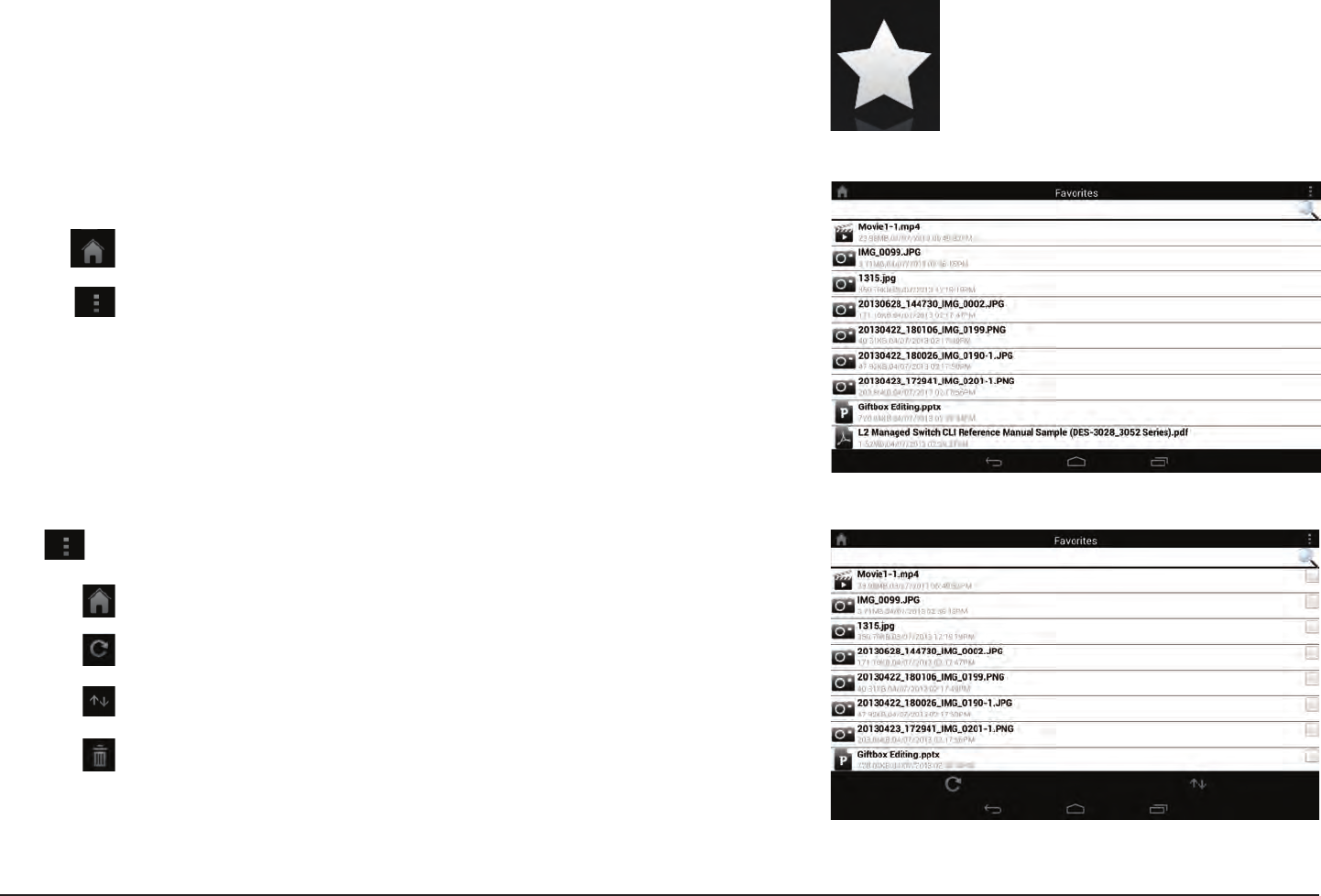
56D-Link DIR-850L User Manual
Section 3 - Usage
Favorites
The Favorites section allows you to quickly access your most often used
les, no matter what le type, in a special section. Files added to the
Favorites section will be copied here for playback in a centralized location.
Type in the name of a le to search for it.
Tap to return to the main menu.
Tap to refresh, sort, or mark les for deletion.
Search Bar:
Tap to return to the main menu.
Tap to update the list of les.
Tap to sort the les by name, size, type, or date.
Check a le then tap to delete it.
Tap for additional options:
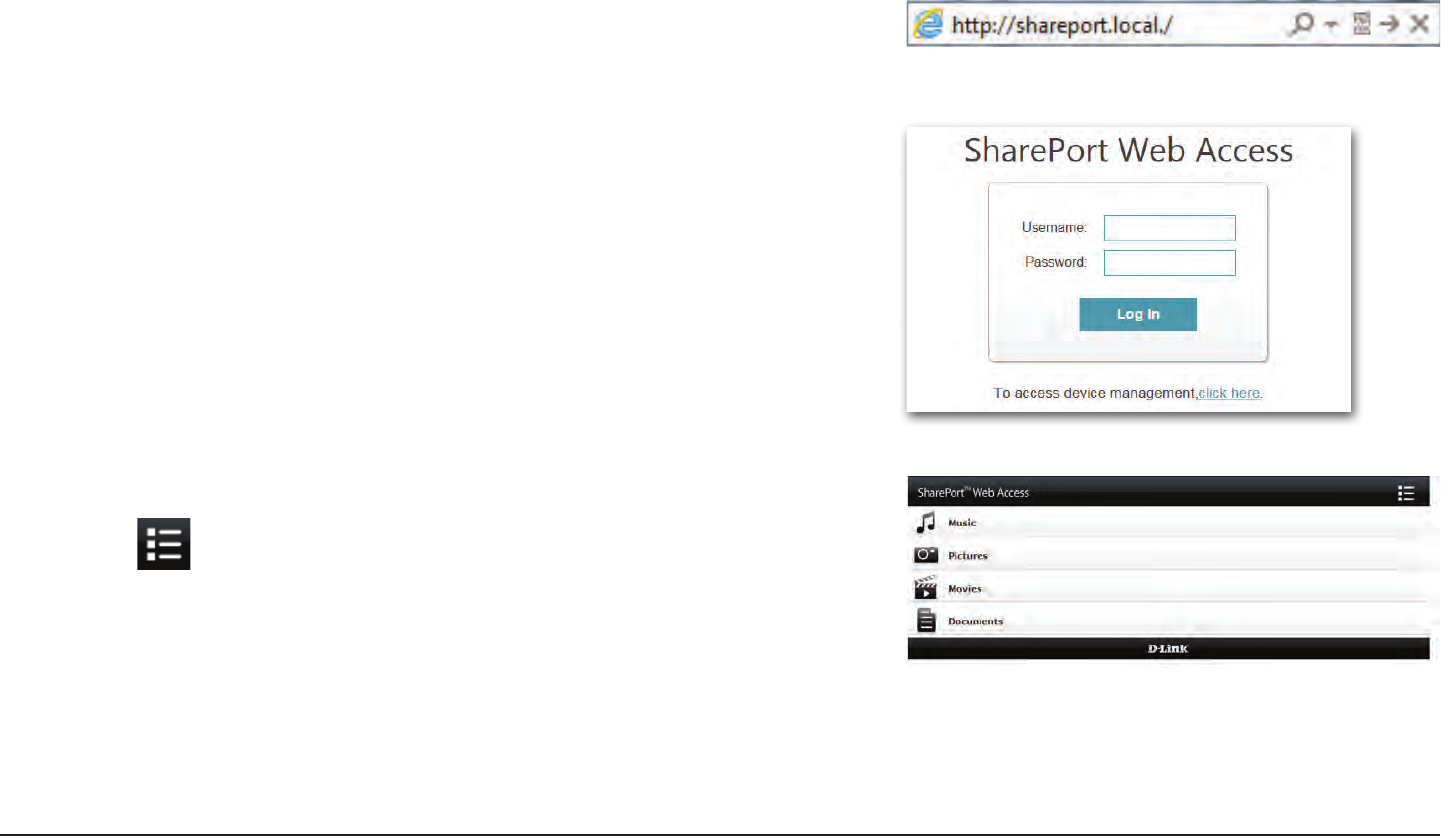
57D-Link DIR-850L User Manual
Section 3 - Usage
SharePort Web Access lets you stream music, photos, and movies from a USB drive attached to your DIR-850L through a Web
browser. You can also download and upload les to and from a computer through the Web browser interface.
At the main menu, you can browse the les stored on your USB drive by
le type.
• Click to browse by folders.
• Log in with your admin password or a SharePort Username and
Password.
• Type http://shareport.local. in your browser’s URL to take you to
the SharePort Web Access log in page.
Using SharePort Web Access
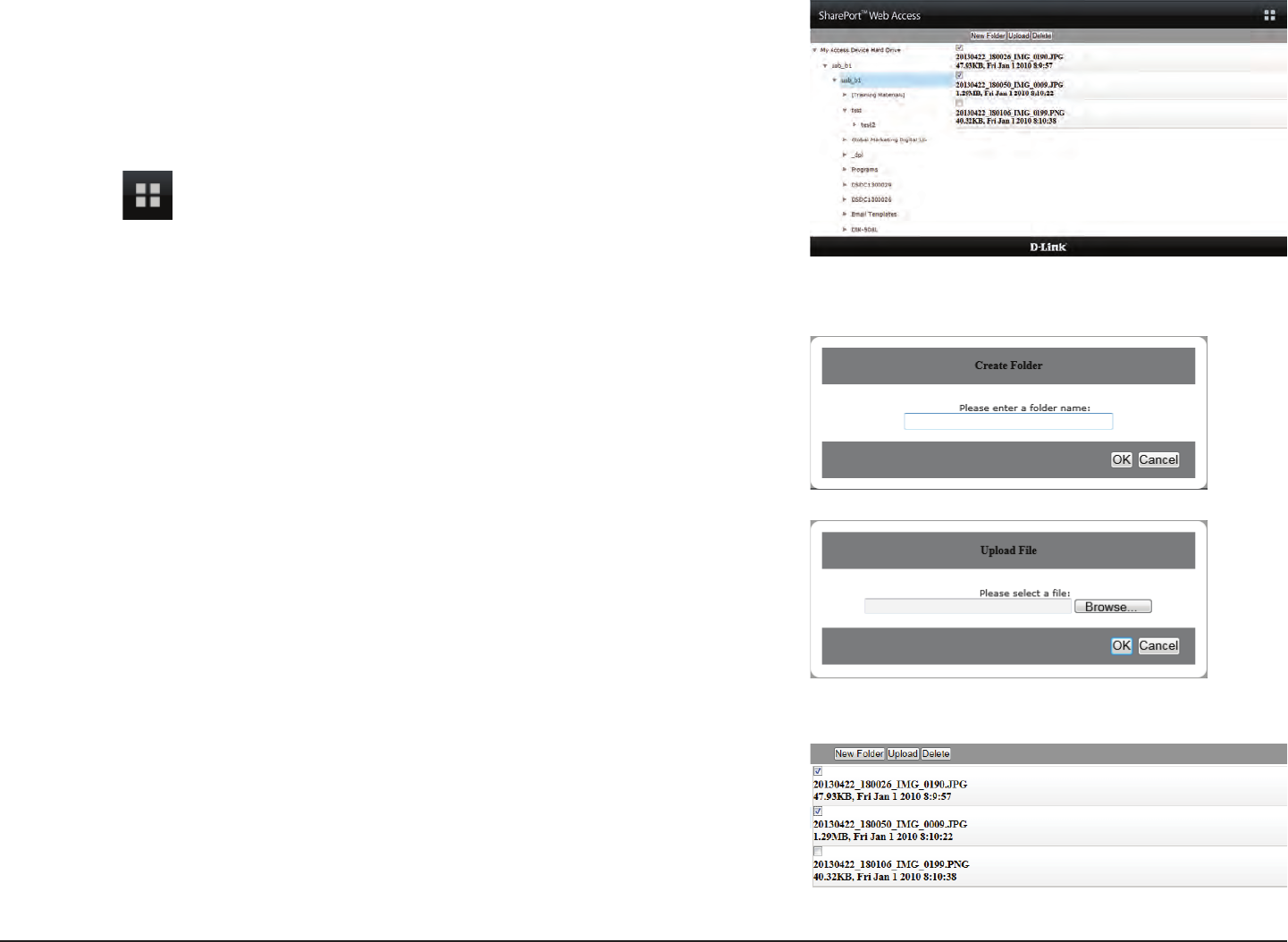
58D-Link DIR-850L User Manual
Section 3 - Usage
The folder browser section will show folder hierarchy at the left and les
at the right. You can quickly browse directories and perform operations
by using the buttons in the folder browser view.
To create a new folder:
• Click New Folder in the current directory.
• Enter a folder name in the Create Folder pop-up.
• Click OK. The new folder will appear in the left column.
To upload a le:
• Click Upload to upload a le to the current folder.
• In the pop-up browse to the le you wish to upload.
• Click OK. The le will appear after the browser refreshes.
To delete a le:
• Tick the checkbox next to the les you wish to delete.
• Click Delete and a dialog box will appear.
• Click OK to conrm.
• Click to return to the main menu.
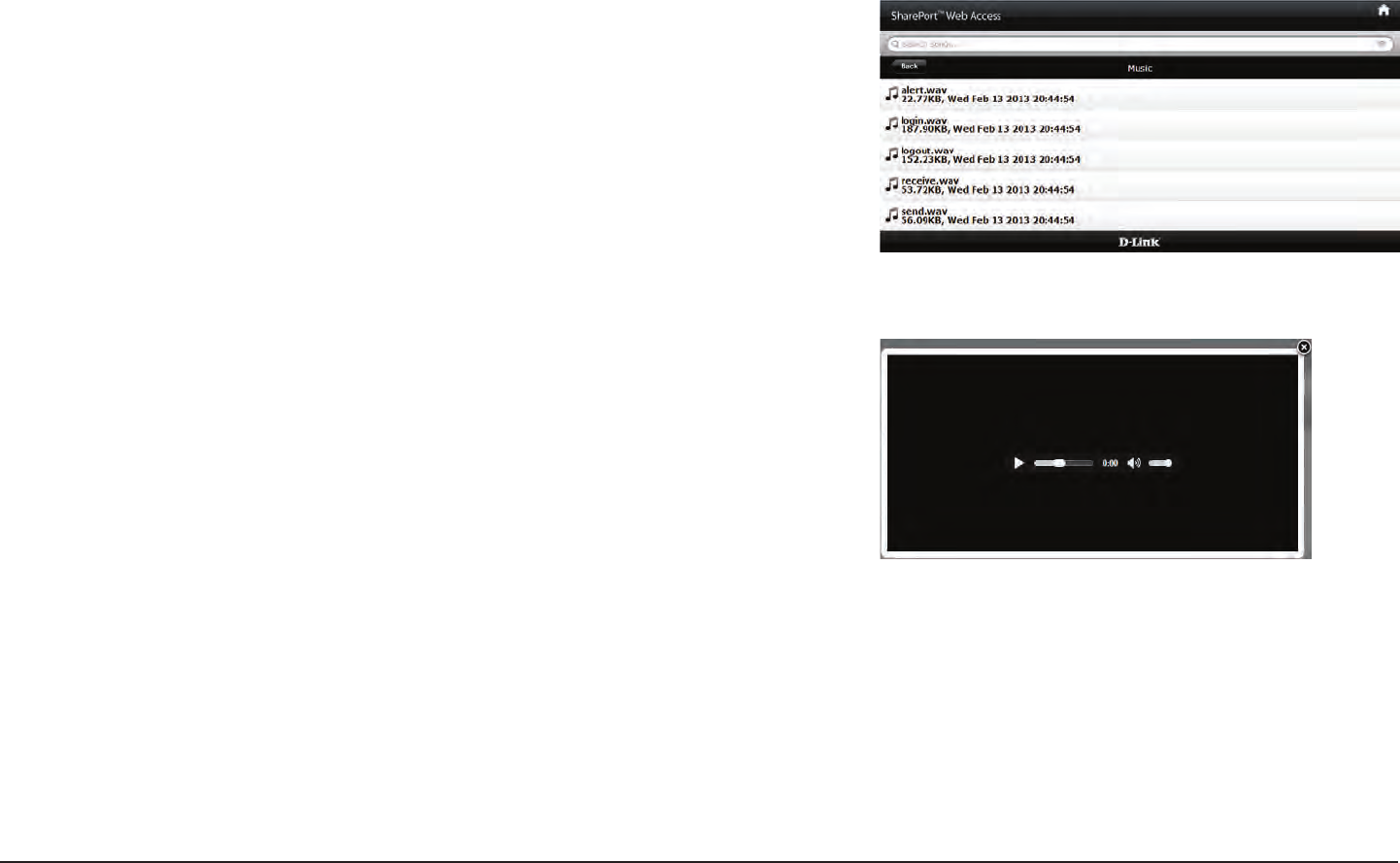
59D-Link DIR-850L User Manual
Section 3 - Usage
Music
You can go to the Music section to browse and play the music les on your storage. Click Back to return to the main menu.
• Click on the audio lename to play it in the browser.
You can pause, seek, mute and adjust the volume in the window.
• Close the window to end playback.
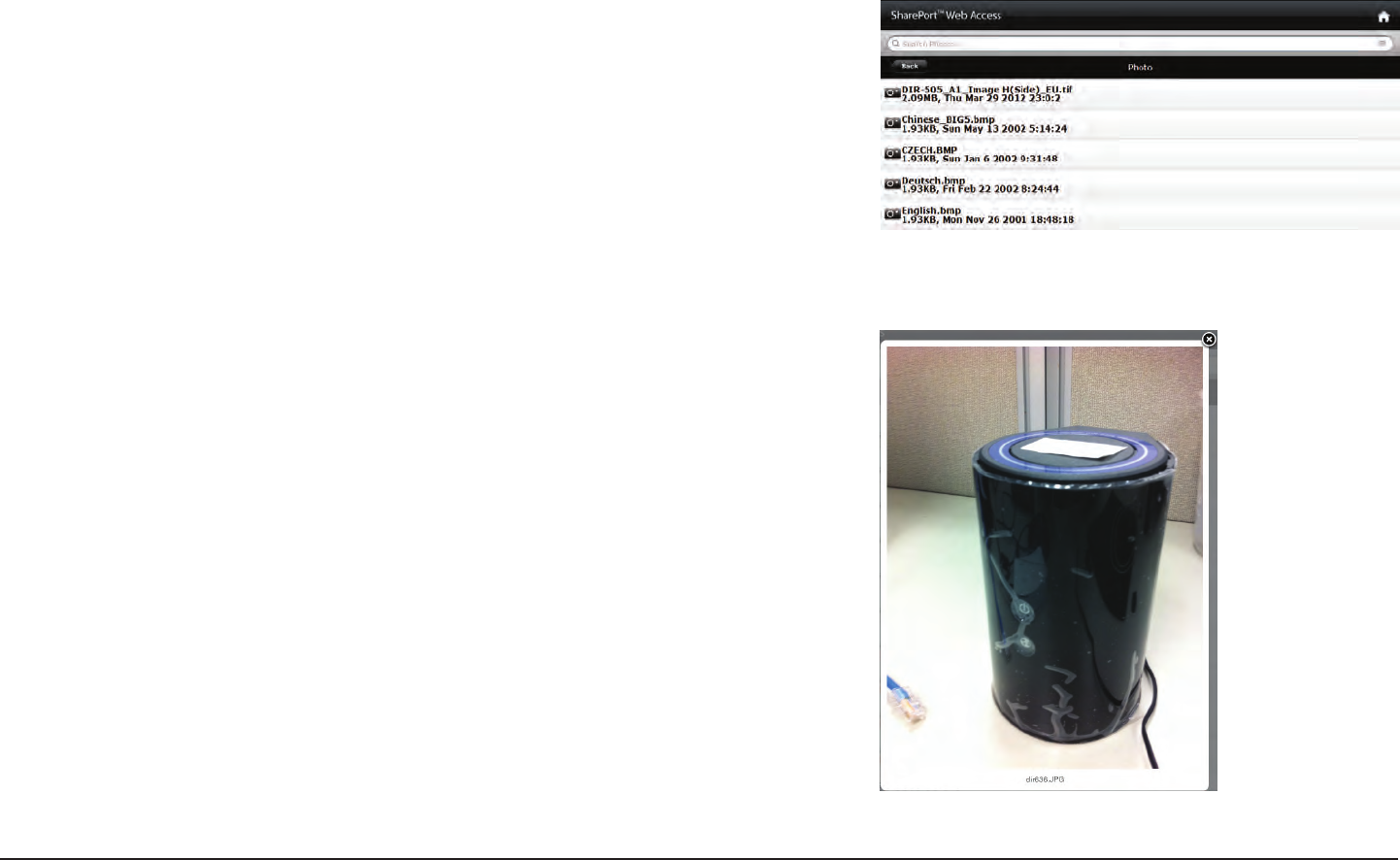
60D-Link DIR-850L User Manual
Section 3 - Usage
• Click on the image name to view it in the browser.
Pictures
You can go to the Pictures section to browse and view the image les on your storage. Click Back to return to the main menu.
• Hover your mouse over the left or right side of the image and
click < or > to view the previous or next image.

61D-Link DIR-850L User Manual
Section 3 - Usage
Videos
You can go to the Videos section to browse and play the video les on your storage. Click Back to return to the main menu.
• Click on the video le to open the le in a window for streaming.
You can pause, seek, mute, adjust the volume, and activate full screen
mode in the window controls.
• Close the window to end playback.
Note: Depending on your browser, the video le may be played back using the
default player associated with that le format.
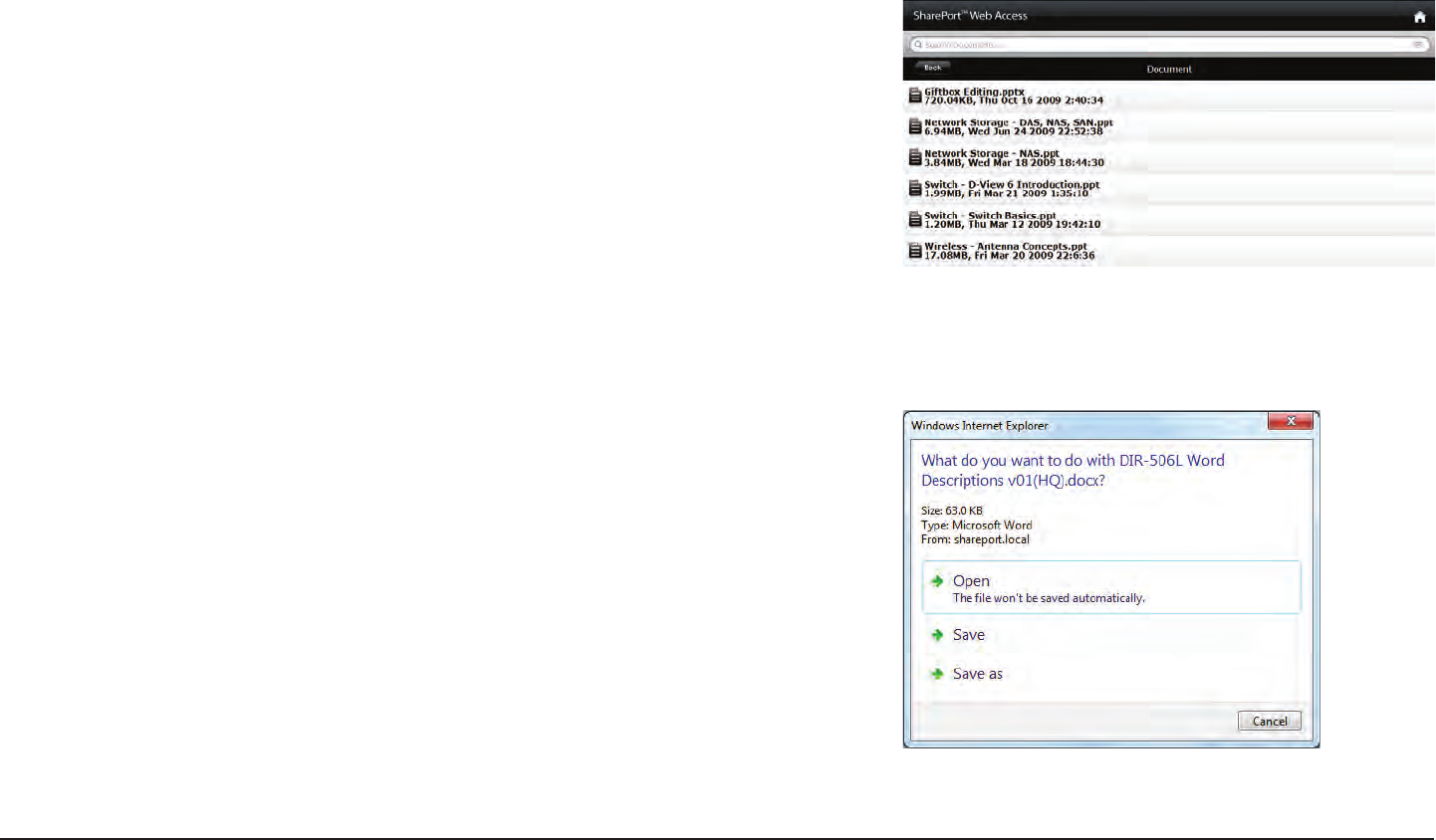
62D-Link DIR-850L User Manual
Section 3 - Usage
• Click on the lename to open the le.
• Depending on the le type, the default program will be
started or a pop-up may ask you to open or save the le.
Documents
You can go to the Documents section to open and save les from your storage to your computer. Click Back to return to the
main menu.
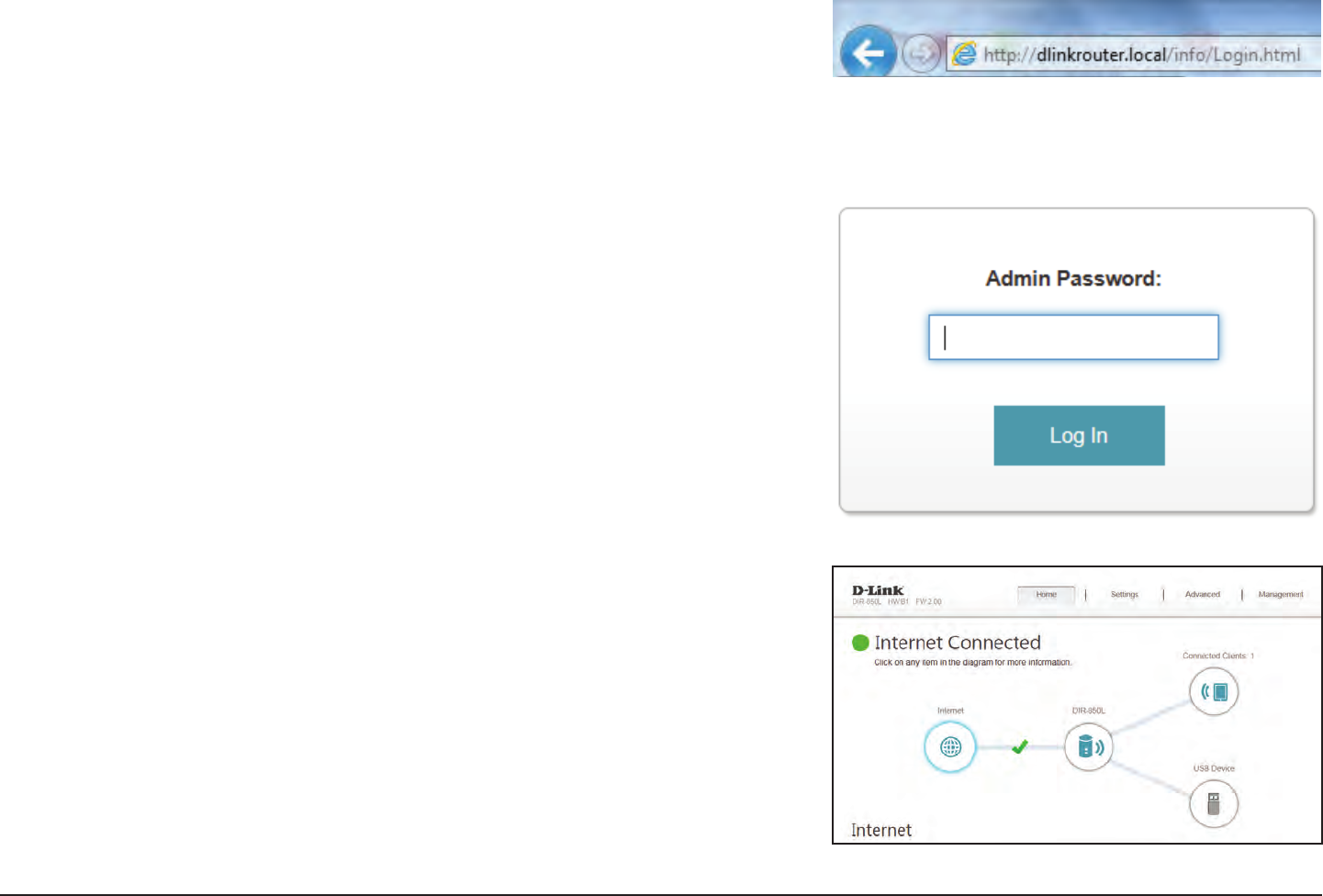
63D-Link DIR-850L User Manual
Section 4 - Conguration
Conguration
Enter your password. If you previously followed the setup wizard (see page 12), please
use the admin password you entered during the wizard. Otherwise, leave the
password blank. Click Log In to proceed.
Note: If you cannot remember your password and cannot log in, press the reset button
(see “Admin” on page 114) to restore the router to its default settings.
To access the conguration utility, open a web-browser such as Internet Explorer
and enter http://dlinkrouter.local./
Windows and Mac users may also connect by typing the IP address of the router (by
default this is http://192.168.0.1) in the address bar.
The router’s home page will open displaying its current connection status.
The bar at the top of the page has quick access to Settings and Management
functions. You may quickly jump back Home at any time.
Note: The system will automatically log out after a period of inactivity.
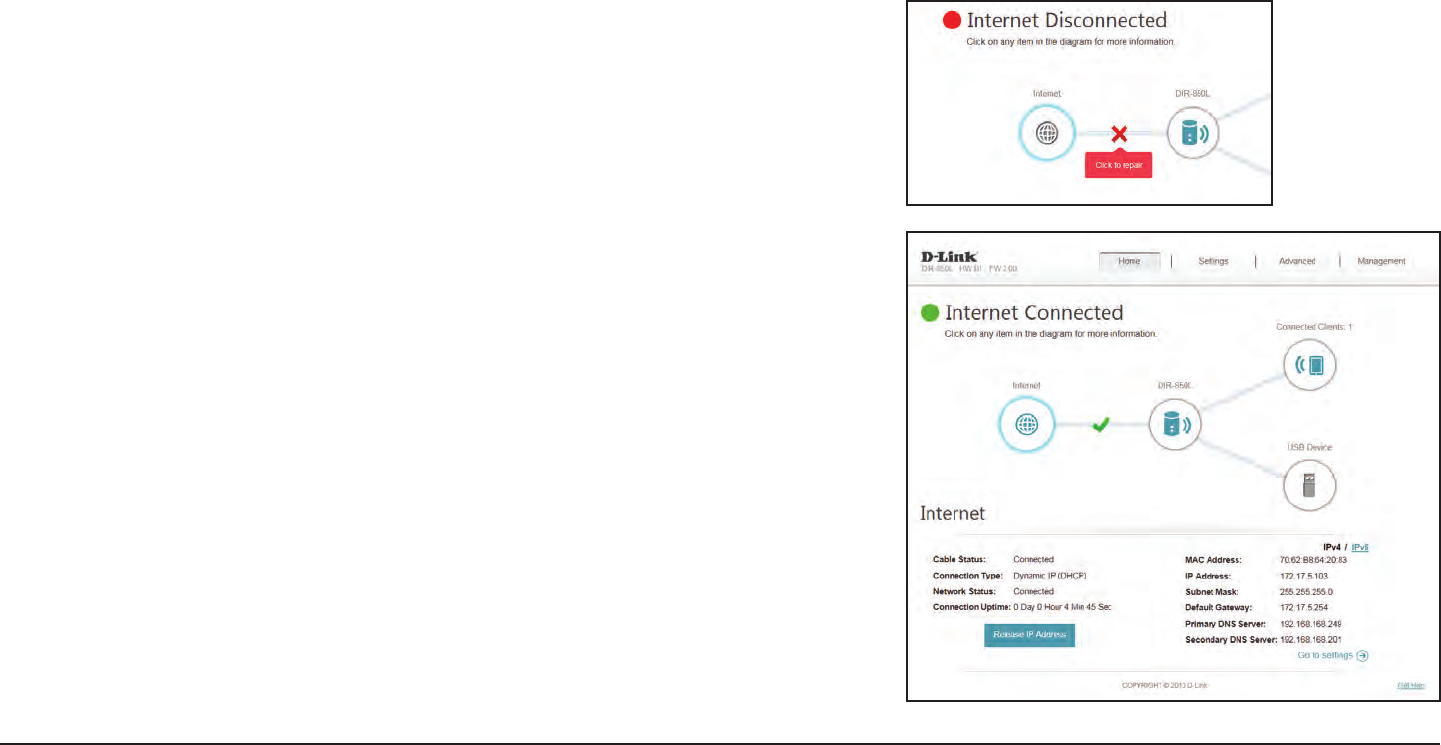
64D-Link DIR-850L User Manual
Section 4 - Conguration
Home
The Home page displays the current status of the router in the form of an interactive diagram. You can click each icon to display
information about each part of the network at the bottom of the screen. The menu bar at the top of the page will allow you
to quickly navigate to other pages.
The Home page displays whether or not the router is currently connected to the
Internet. If it is disconnected, click Click to repair to bring up the setup wizard
(see page 68).
To bring up more details about your Internet connection, click on the Internet
icon. Click IPv4 or IPv6 to see details of the IPv4 connection and IPv6 connection
respectively.
Click Release IP Address to disconnect from the Internet. If you do this and wish to
reconnect, click Renew IP Address.
To recongure the Internet settings, refer to page 68.
Internet
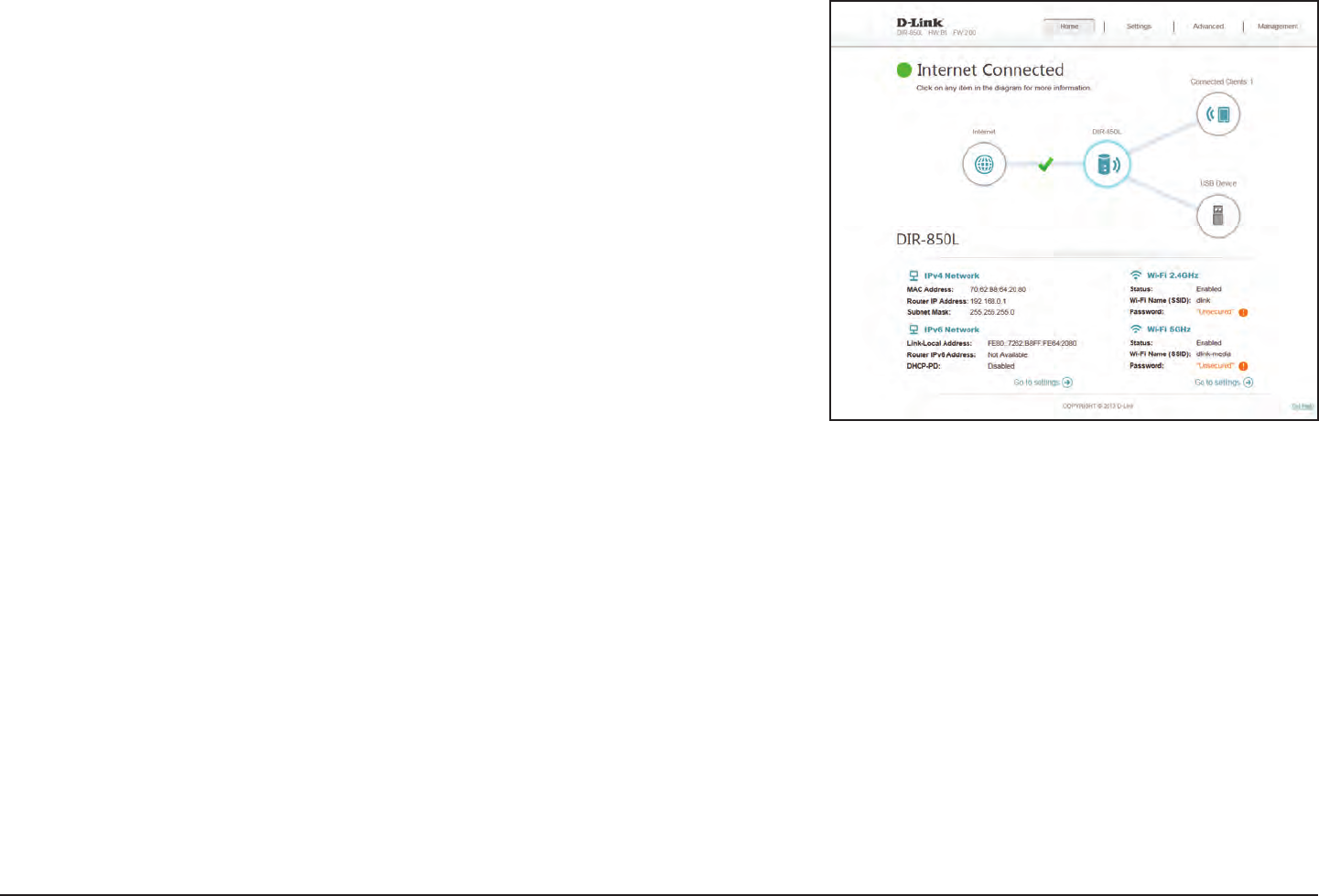
65D-Link DIR-850L User Manual
Section 4 - Conguration
DIR-850L
Click on the DIR-850L icon to view details about the router and its wireless settings.
Here you can see the router’s current wireless settings, as well as its MAC address
and IPv4/IPv6 addresses.
To recongure the network settings, either click Go to settings on the lower left, or
click Settings (at the top of the page) and then Network on the menu that appears.
Refer to page 22.
To recongure the wireless settings, either click Go to settings, on the lower right, or
click Settings (at the top of the page) and then Wireless on the menu that appears.
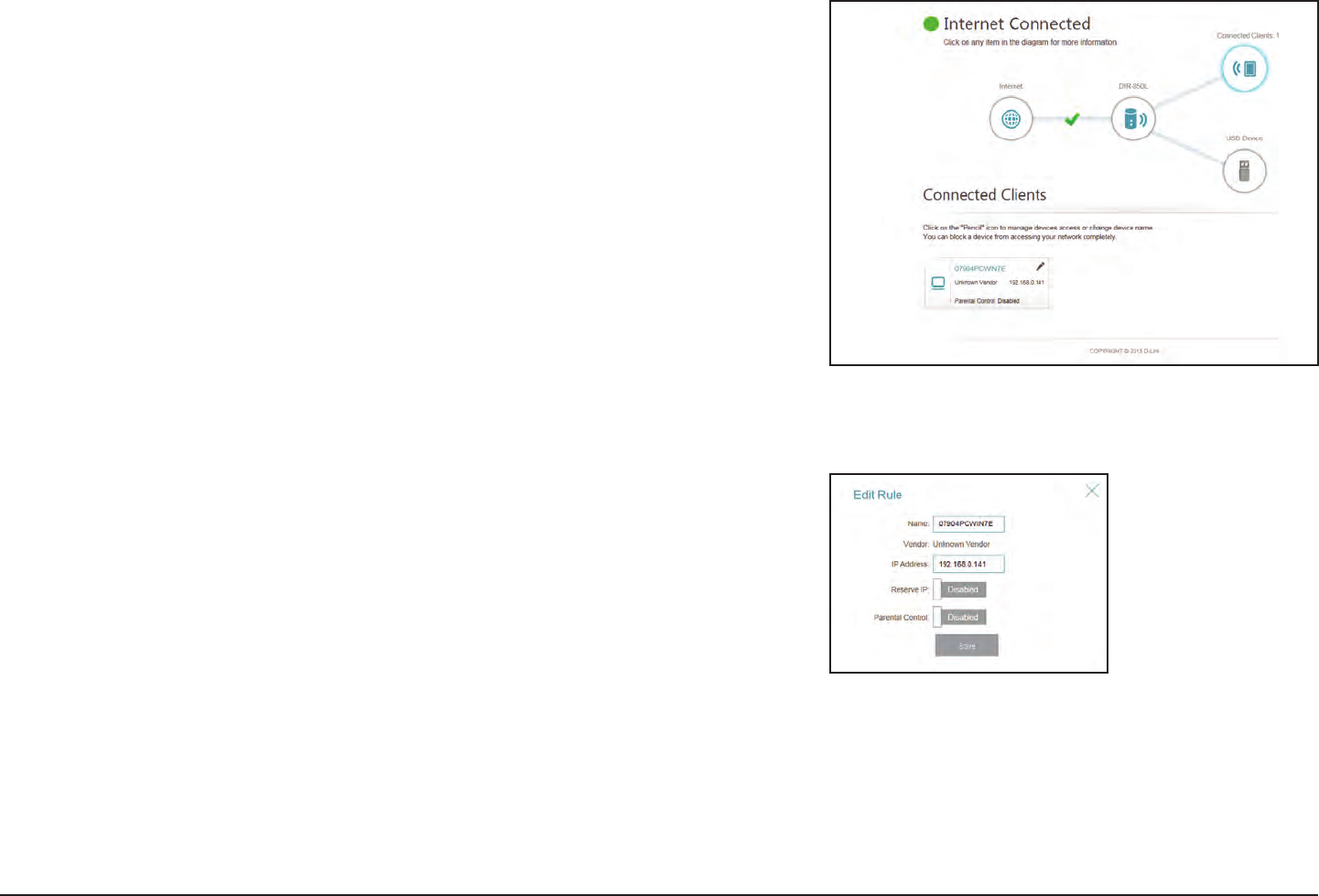
66D-Link DIR-850L User Manual
Section 4 - Conguration
Connected Clients
Click on the Connected Clients icon to view details about the router and its wireless
settings.
On this page you can see all the clients currently connected to the router, and their
IP addresses.
To edit each client’s settings, click the pencil icon on the client you want to edit.
Enter a custom name for this client.
Displays the vendor of the device.
Enter a specic IP address for this client.
Enable to reserve this IP address for this client.
Enable and to disable network access during the chosen schedule
for rewall and website lters.
Click Save when you are done.
Name:
Vendor:
IP Address:
Reserve IP:
Parental
Control:
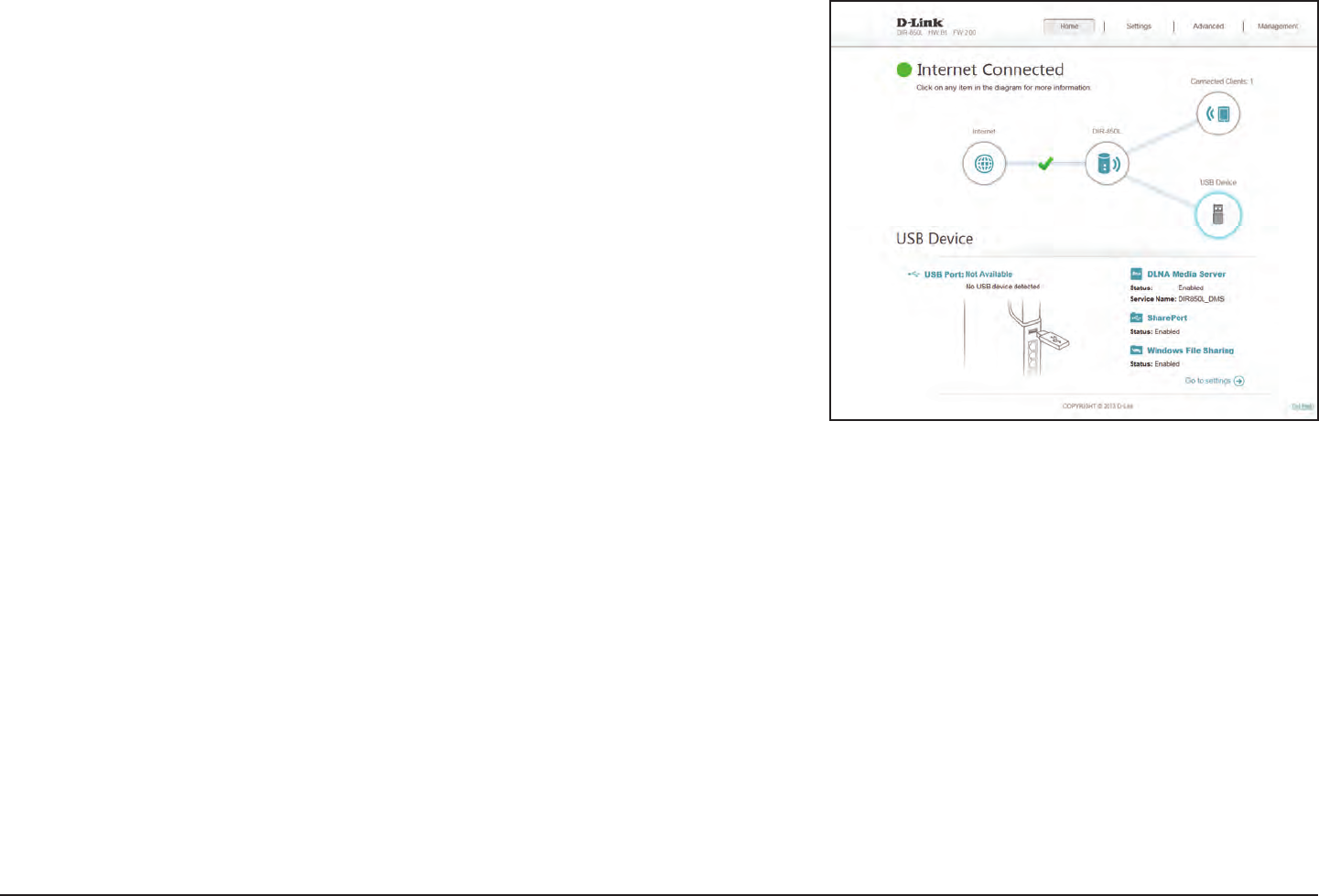
67D-Link DIR-850L User Manual
Section 4 - Conguration
USB Device
Click on the USB Device icon to view details about the currently connected USB
device, DLNA media server, SharePort, and Windows File Sharing.
If you have a USB device connected, you can see its name and how much free space
it has.
To congure your SharePort settings, click Go to settings and refer to “SharePort”
on page 97.

68D-Link DIR-850L User Manual
Section 4 - Conguration
Settings
Wizard
Internet
In the Settings menu on the bar on the top of the page, click Wizard to open the setup wizard. This is the same wizard that appears when you start
the router for the rst time. Refer to page 12 for details.
In the Settings menu on the bar on the top of the page, click Internet to see the
Internet conguration options.
Choose your Internet connection type from the drop-down menu.
You will be presented with the appropriate options for your
connection type. Click Advanced Settings... to expand the list and
see all of the options.
My Internet
Connection Is:
For Static IP refer to page 70.
For Dynamic IP (DHCP) refer to page 69.
For PPPoE refer to page 71.
For PPTP refer to page 72.
For L2TP refer to page 74.
For DS-Lite refer to page 76.
To congure an IPv6 connection, click the IPv6 link. Refer to page 77
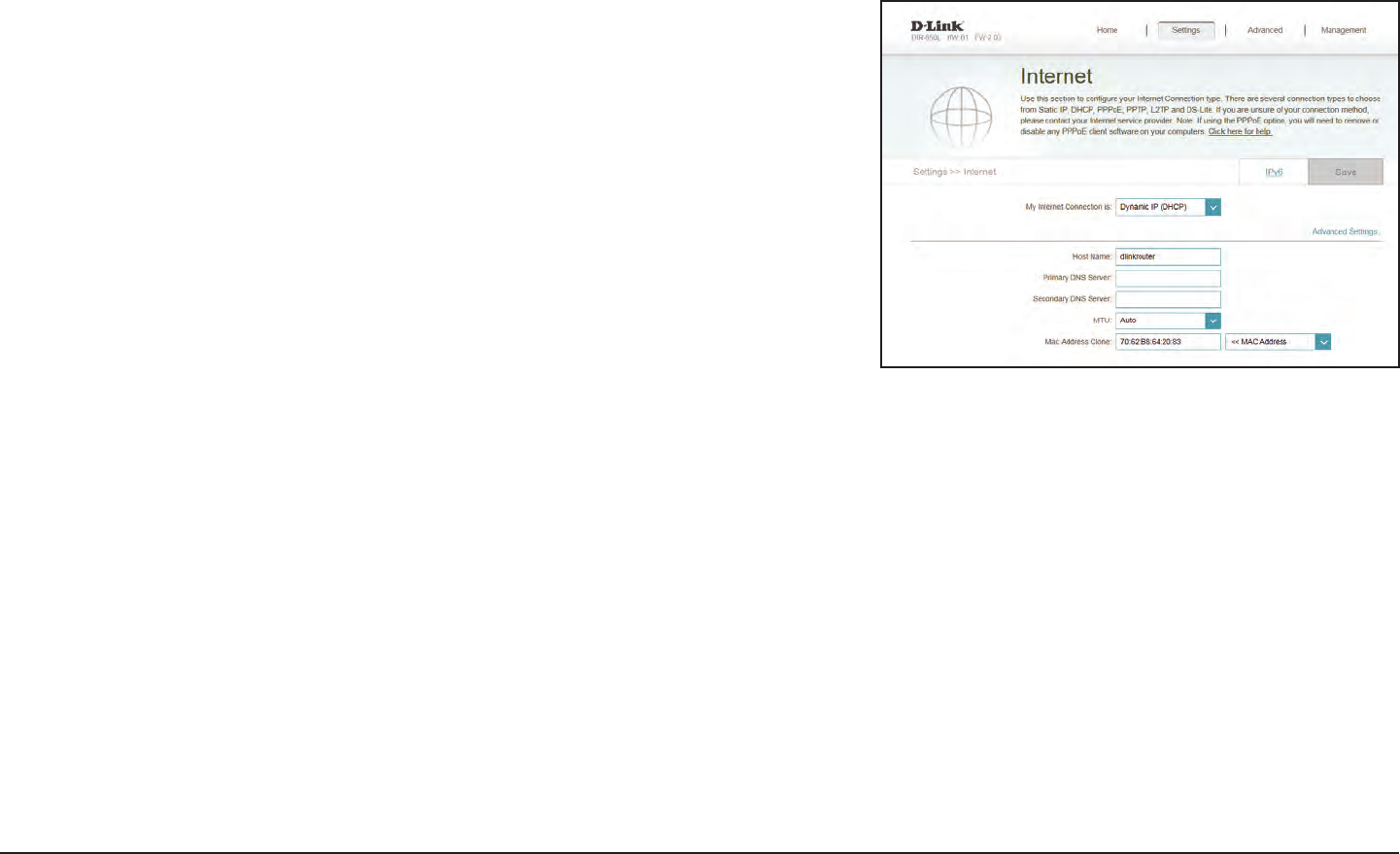
69D-Link DIR-850L User Manual
Section 4 - Conguration
The host name is optional but may be required by some ISPs. Leave
it blank if you are not sure.
Enter the primary DNS server IP address assigned by your ISP. This
address is usually obtained automatically from your ISP.
Enter the secondary DNS server IP address assigned by your ISP. This
address is usually obtained automatically from your ISP.
Maximum Transmission Unit - you may need to change the MTU for
optimal performance with your ISP.
The default MAC address is set to the Internet port’s physical interface
MAC address on the router. You can use the drop-down menu to
replace the Internet port’s MAC address with the MAC address of a
connected client.
Click Save when you are done.
Host Name:
Primary DNS
Server:
Secondary DNS
Server:
MTU:
MAC Address
Clone:
Dynamic IP (DCHP)
Select Dynamic IP (DHCP) to obtain IP address information automatically from your Internet Service Provider (ISP). Select this option if your ISP
does not give you an IP address to use.

70D-Link DIR-850L User Manual
Section 4 - Conguration
Enter the IP address provided by your ISP.
Enter the subnet mask provided by your ISP.
Enter the default gateway address provided by your ISP.
Enter the primary DNS server IP address assigned by your ISP.
Enter the secondary DNS server IP address assigned by your ISP.
Maximum Transmission Unit - you may need to change the MTU for
optimal performance with your ISP.
The default MAC address is set to the Internet port’s physical interface
MAC address on the router. You can use drop-down menu to replace
the Internet port’s MAC address with the MAC address of a connected
client.
Click Save when you are done.
IP Address:
Subnet Mask:
Default
Gateway:
Primary DNS
Server:
Secondary DNS
Server:
MTU:
MAC Address
Clone:
Static IP
Select Static IP if your IP information is provided by your Internet service provider (ISP).
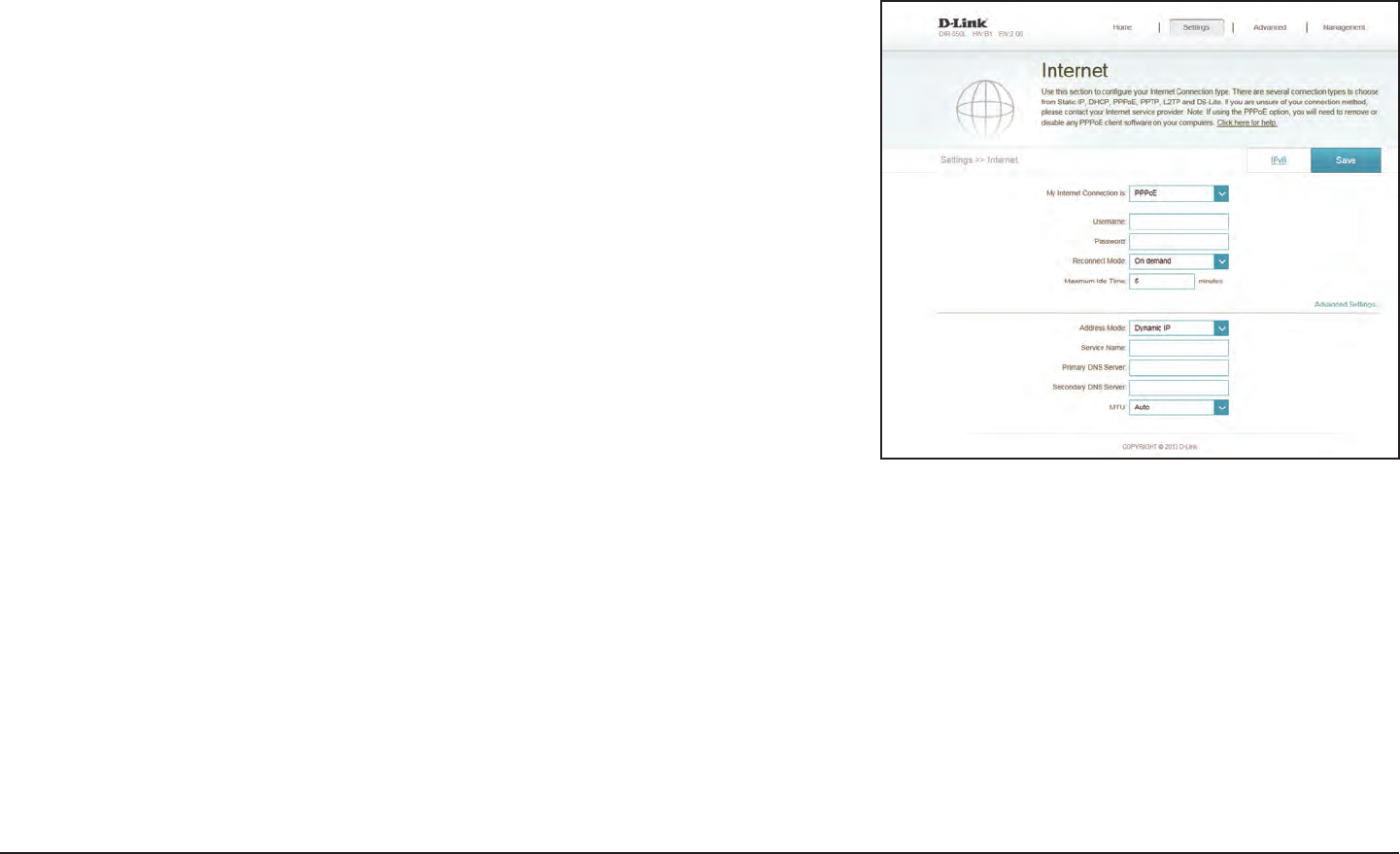
71D-Link DIR-850L User Manual
Section 4 - Conguration
Enter the username provided by your ISP.
Enter the password provided by your ISP.
Select either Always-on, On-Demand, or Manual.
Enter a maximum idle time during which the Internet connection
is maintained during inactivity. To disable this feature, enable Auto-
reconnect.
Select Static IP if your ISP assigned you the IP address, subnet mask,
gateway, and DNS server addresses. In most cases, select Dynamic IP.
Enter the IP address provided by your ISP (Static IP only).
Enter the ISP service name (optional).
Enter the primary DNS server IP address assigned by your ISP.
Enter the secondary DNS server IP address assigned by your ISP.
Maximum Transmission Unit - you may need to change the MTU for
optimal performance with your ISP.
Click Save when you are done.
Username:
Password:
Reconnect
Mode:
Maximum Idle
Time:
Address Mode:
IP Address:
Service Name:
Primary DNS
Server:
Secondary DNS
Server:
MTU:
Select PPPoE if your Internet connection requires you to enter a username and password. This information is provided by your Internet service
provider (ISP).
PPPoE

72D-Link DIR-850L User Manual
Section 4 - Conguration
Enter the PPTP server IP address provided by your ISP.
Enter the username provided by your ISP.
Enter the password provided by your ISP.
Select either Always-on, On-Demand, or Manual.
Enter a maximum idle time during which the Internet connection
is maintained during inactivity. To disable this feature, enable Auto-
reconnect.
Select Static IP if your ISP assigned you the IP address, subnet mask,
gateway, and DNS server addresses. In most cases, select Dynamic IP.
Enter the IP address provided by your ISP (Static IP only).
Enter the subnet mask provided by your ISP (Static IP only).
Enter the gateway IP address provided by your ISP (Static IP only).
Enter the primary DNS server IP address assigned by your ISP.
PPTP Server IP
Address:
Username:
Password:
Reconnect
Mode:
Maximum Idle
Time:
Address Mode:
PPTP IP
Address:
PPTP Subnet
Mask:
PPTP Gateway
IP Address:
Primary DNS
Server:
Choose PPTP (Point-to-Point-Tunneling Protocol ) if your Internet Service Provider (ISP) uses a PPTP connection. Your ISP will provide you with a
username and password.
PPTP
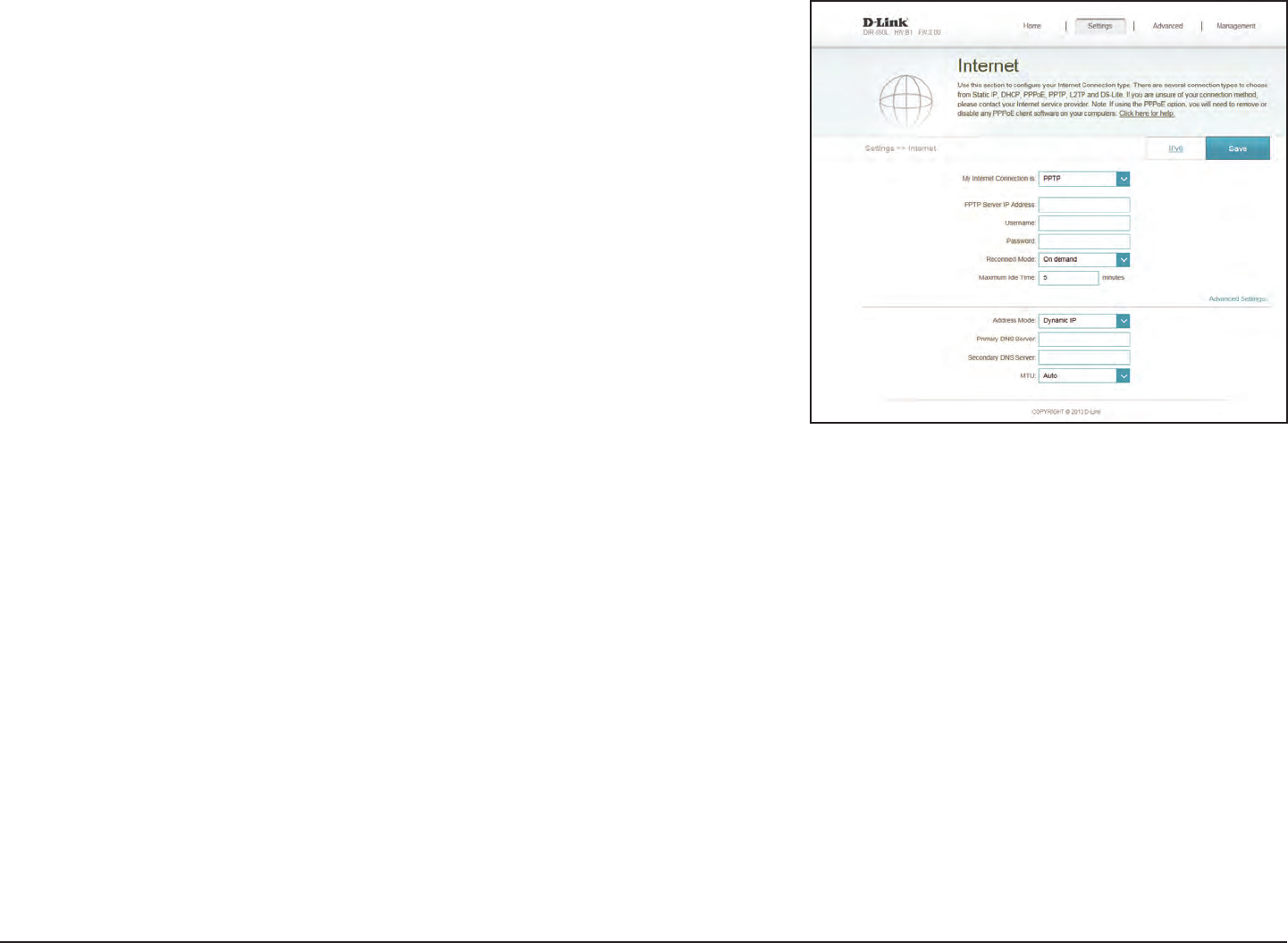
73D-Link DIR-850L User Manual
Section 4 - Conguration
Enter the secondary DNS server IP address assigned by your ISP.
Maximum Transmission Unit - you may need to change the MTU for
optimal performance with your ISP.
Click Save when you are done.
Secondary DNS
Server:
MTU:

74D-Link DIR-850L User Manual
Section 4 - Conguration
L2TP
Enter the L2TP server IP address provided by your ISP.
Enter the username provided by your ISP.
Enter the password provided by your ISP.
Select either Always-on, On-Demand, or Manual.
Enter a maximum idle time during which the Internet connection
is maintained during inactivity. To disable this feature, enable Auto-
reconnect.
Select Static IP if your ISP assigned you the IP address, subnet mask,
gateway, and DNS server addresses. In most cases, select Dynamic IP.
Enter the IP address provided by your ISP (Static IP only).
Enter the subnet mask provided by your ISP (Static IP only).
Enter the gateway IP address provided by your ISP (Static IP only).
Enter the primary DNS server IP address assigned by your ISP.
L2TP Server IP
Address:
Username:
Password:
Reconnect
Mode:
Maximum Idle
Time:
Address Mode:
L2TP IP
Address:
L2TP Subnet
Mask:
L2TP Gateway
IP Address:
Primary DNS
Server:
Choose L2TP (Layer 2 Tunneling Protocol) if your Internet Service Provider (ISP) uses a L2TP connection. Your ISP will provide you with a username
and password.
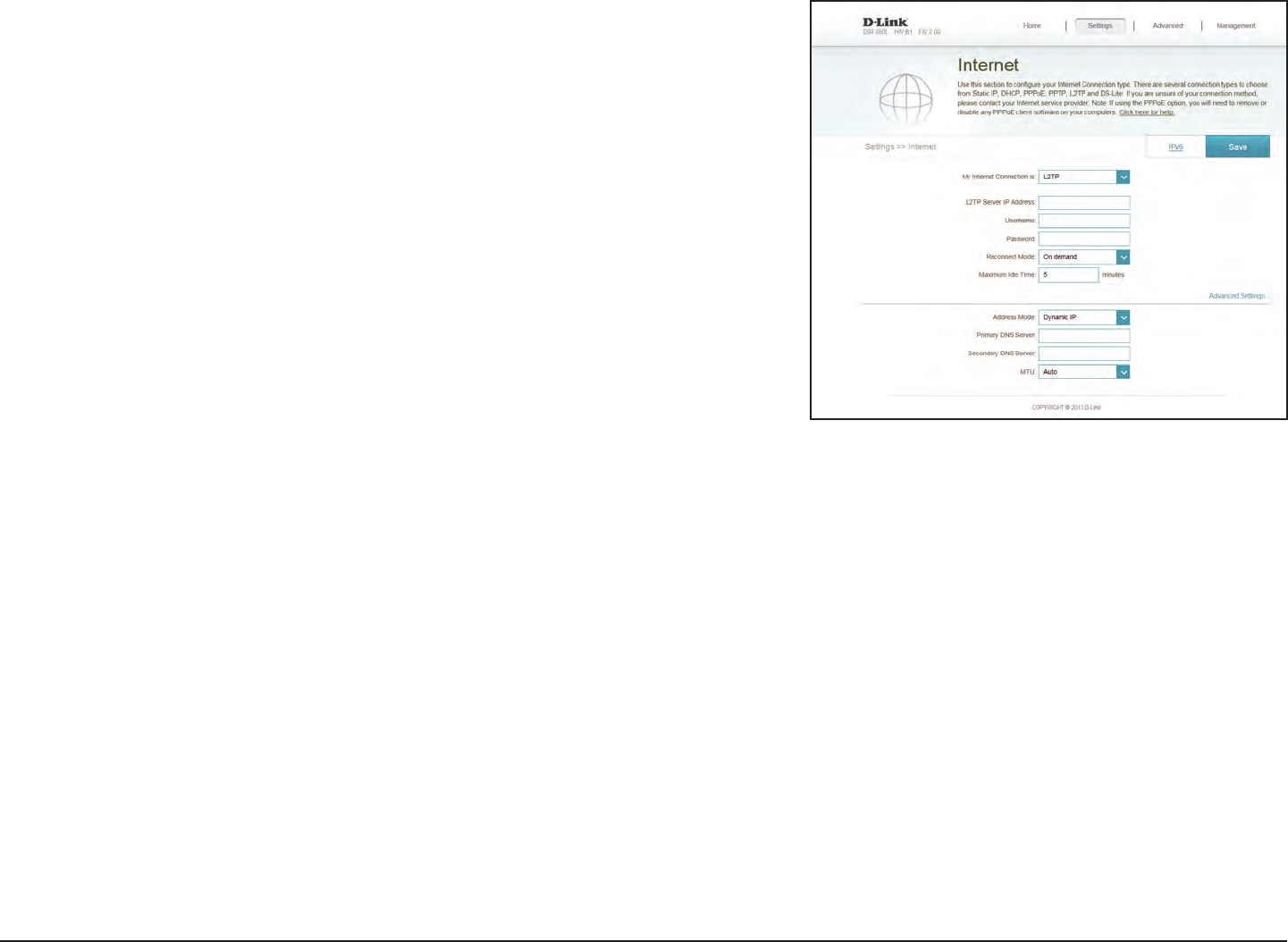
75D-Link DIR-850L User Manual
Section 4 - Conguration
Enter the secondary DNS server IP address assigned by your ISP.
Maximum Transmission Unit - you may need to change the MTU for
optimal performance with your ISP.
Click Save when you are done.
Secondary DNS
Server:
MTU:

76D-Link DIR-850L User Manual
Section 4 - Conguration
DS-Lite
Select DS-Lite DHCPv6 to let the router allocate the AFTR IPv6
address automatically. Select Manual Conguration to enter the
AFTR IPv6 address manually.
If you selected Manual Conguration above, enter the AFTR IPv6
address used here.
Enter the B4 IPv4 address value used here.
Once connected, the WAN IPv6 address will be displayed here.
Once connected, the IPv6 WAN default gateway address will be
displayed here.
Click Save when you are done.
DS-Lite
Conguration:
AFTR IPv6
Address:
B4 IPv6
Address:
WAN IPv6
Address:
IPv6 WAN
Default
Gateway:
DS-Lite is an IPv6 connection type. After selecting DS-Lite, the following parameters will be available for conguration:
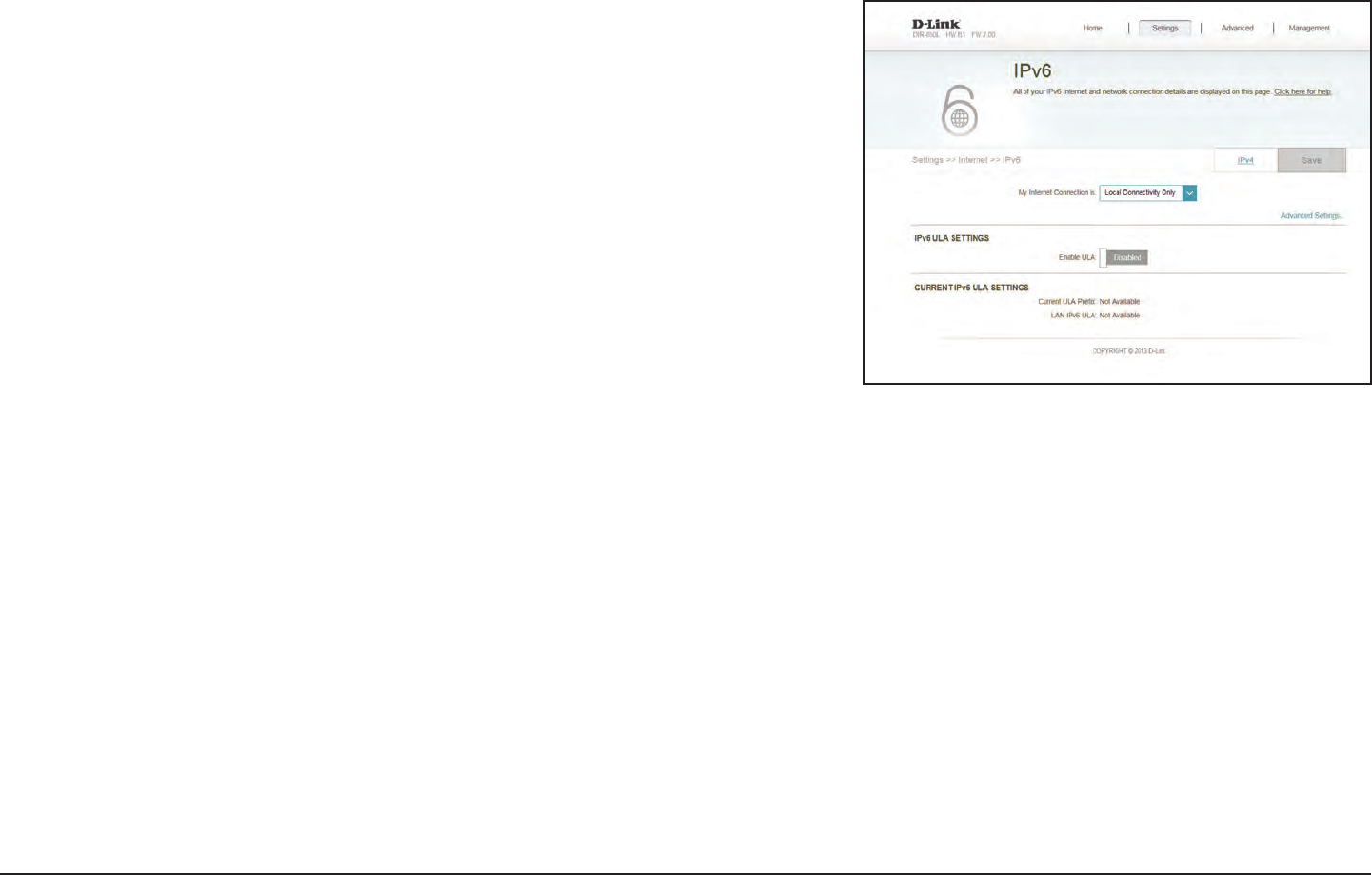
77D-Link DIR-850L User Manual
Section 4 - Conguration
IPv6
To congure an IPv6 connection, click the IPv6 link. To return to the IPv4 settings, click IPv4.
Choose your IPv6 connection type from the drop-down menu. You
will be presented with the appropriate options for your connection
type. Click Advanced Settings... to expand the list and see all of
the options.
My Internet
Connection Is:
For Auto Detection refer to page 78.
For Static IPv6 refer to page 80.
For Auto Conguration (SLAAC/DHCPv6) refer to page 82.
For PPPoE refer to page 84.
For IPv6 in IPv4 Tunnel refer to page 86.
For 6 to 4 refer to page 88.
For 6rd refer to page 89.
For Local Connectivity Only refer to page 91.
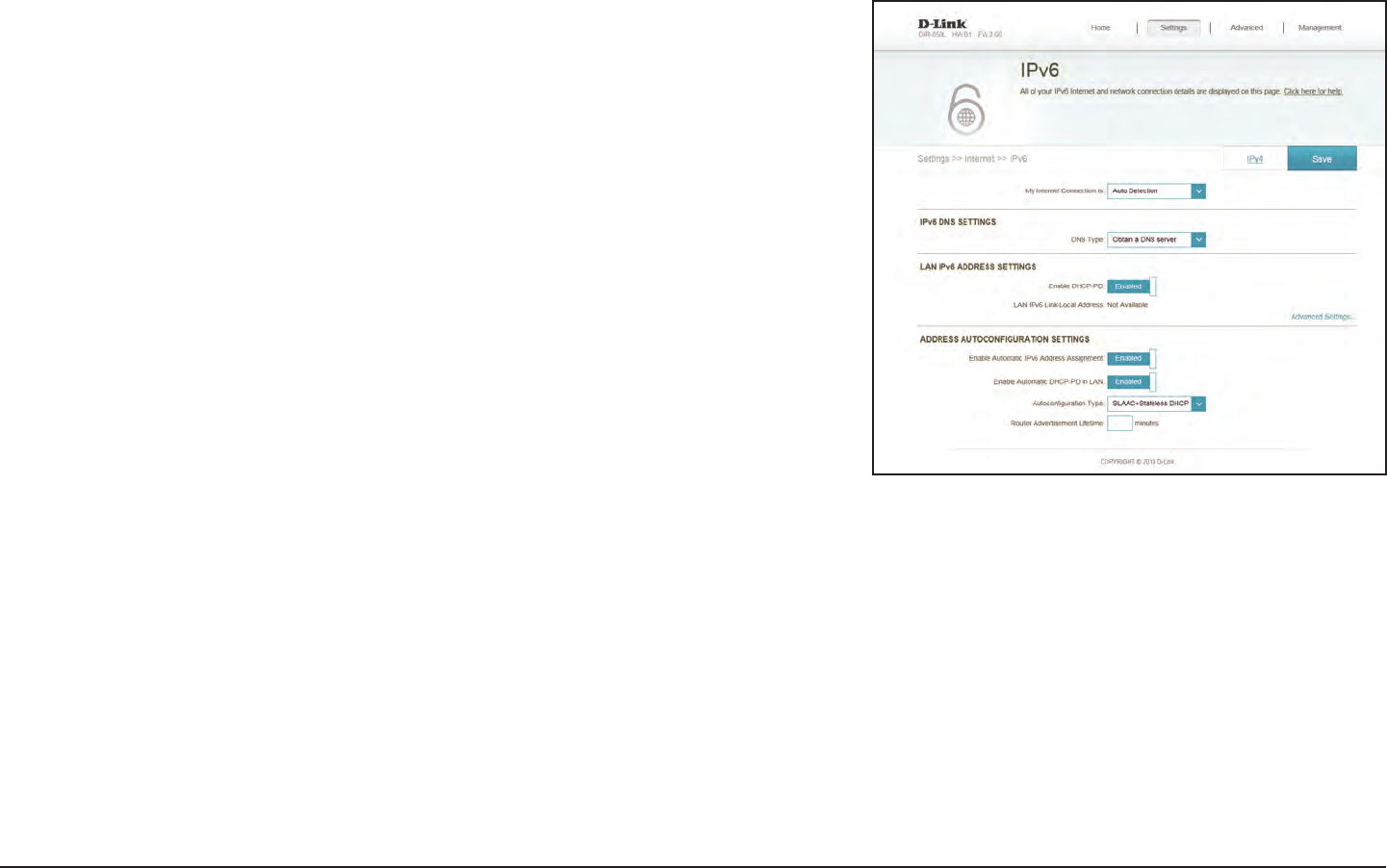
78D-Link DIR-850L User Manual
Section 4 - Conguration
Auto Detection
Select either Obtain DNS server address automatically or Use the
following DNS address.
If you selected Use the following DNS address above, enter the
primary DNS server address.
If you selected Use the following DNS address above, enter the
secondary DNS server address.
Enable or disable prex delegation services.
If you disabled DHCP-PD, enter the LAN (local) IPv6 address for the
router.
Displays the router’s LAN link-local address.
Enable or disable the Automatic IPv6 Address Assignment feature.
Enable or disable automatic DHCP-PD services.
DNS Type:
Primary DNS
Server:
Secondary DNS
Server:
Enable DHCP-
PD:
LAN IPv6
Address:
LAN IPv6 Link-
Local Address:
Enable
Automatic
IPv6 Address
Assignment:
Enable
Automatic
DHCP-PD in
LAN:
This is a connection method where the ISP assigns your IPv6 address when your router requests one from the ISP’s server. Some ISPs require you
to make some settings on your side before your router can connect to the IPv6 Internet.
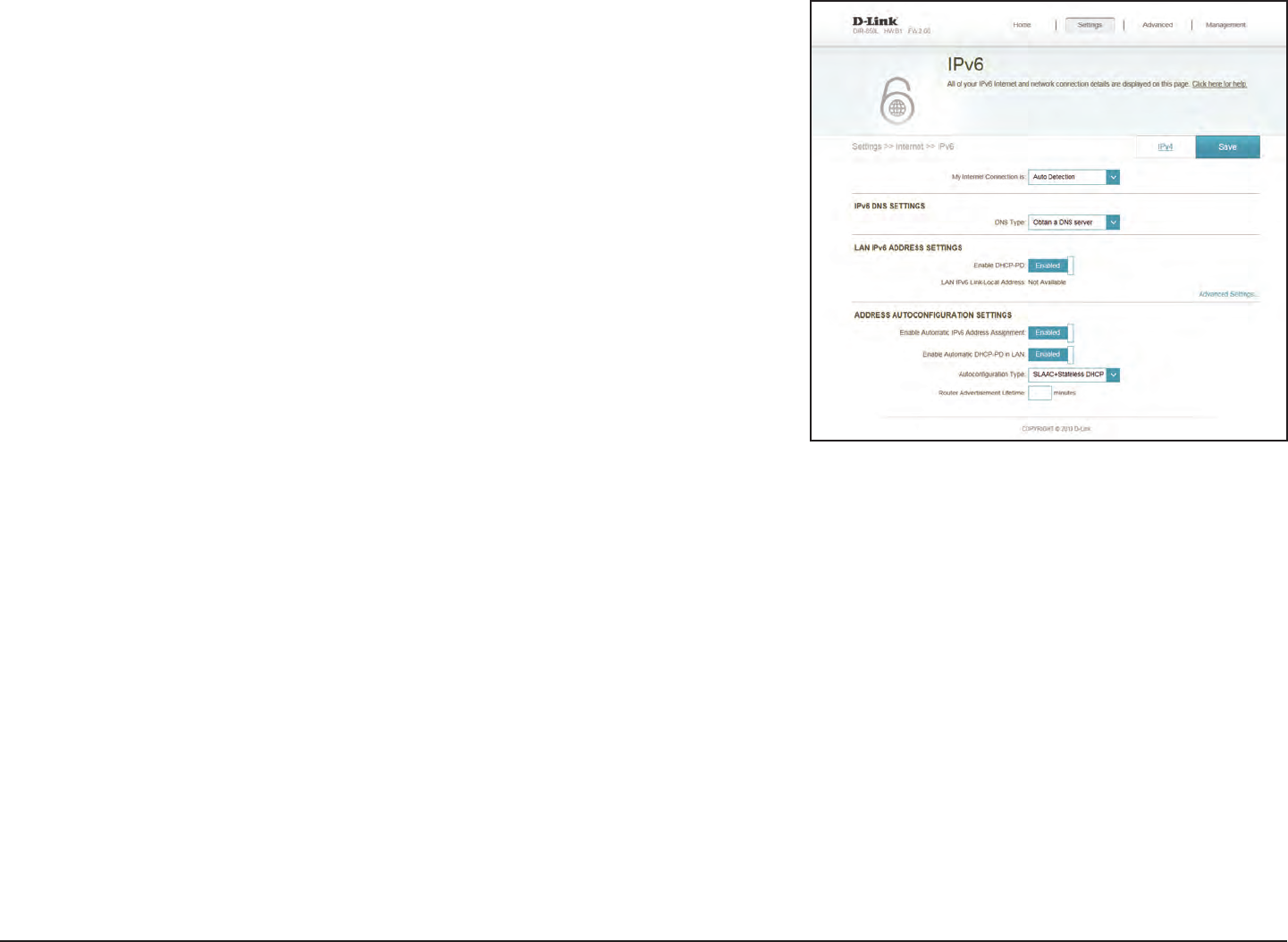
79D-Link DIR-850L User Manual
Section 4 - Conguration
Select SLAAC + RDNSS or SLAAC + Stateless DHCP, Stateful
(DHCPv6).
Enter the IPv6 address lifetime (in minutes).
Click Save when you are done.
Auto
Conguration
Type:
Router
Advertisement
Lifetime:
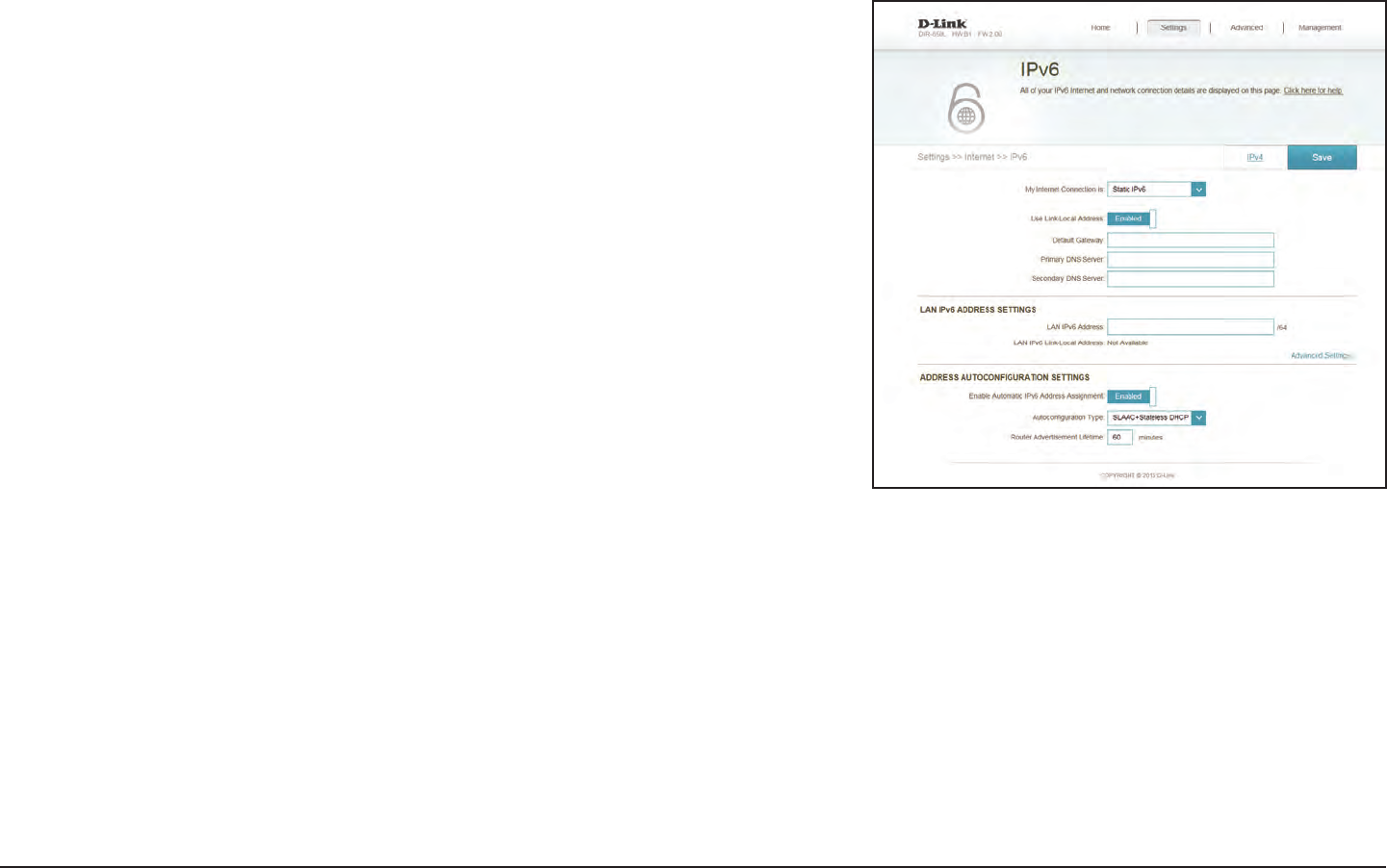
80D-Link DIR-850L User Manual
Section 4 - Conguration
Static IPv6
Enable or disable a link-local address.
If you disabled Use Link-Local Address, enter the address supplied
by your ISP.
If you disabled Use Link-Local Address, enter the subnet prex
length supplied by your ISP.
Enter the default gateway for your IPv6 connection.
Enter the primary DNS server address.
Enter the secondary DNS server address.
Enter the LAN (local) IPv6 address for the router.
Displays the router’s LAN link-local address.
Click to enable the Automatic IPv6 Address Assignment feature.
Use Link-Local
Address:
IPv6 Address:
Subnet Prex
Length:
Default
Gateway:
Primary DNS
Server:
Secondary DNS
Server:
LAN IPv6
Address:
LAN IPv6 Link-
Local Address:
Enable
Automatic
IPv6 Address
Assignment:
Select Static IP if your IPv6 information is provided by your Internet service provider (ISP).
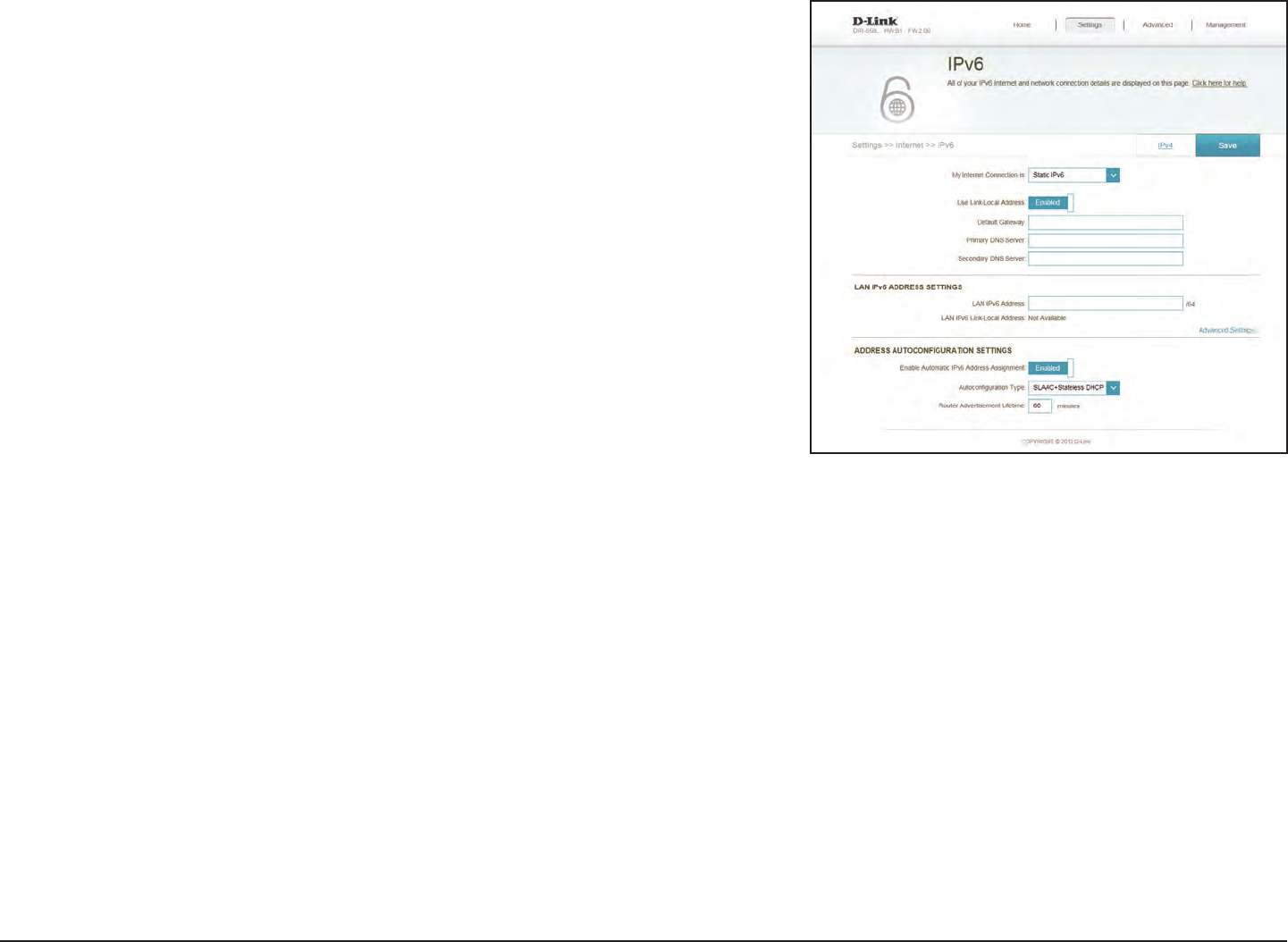
81D-Link DIR-850L User Manual
Section 4 - Conguration
Select SLAAC + RDNSS or SLAAC + Stateless DHCP, Stateful
(DHCPv6).
Enter the IPv6 address lifetime (in minutes).
Click Save when you are done.
Auto
Conguration
Type:
Router
Advertisement
Lifetime:
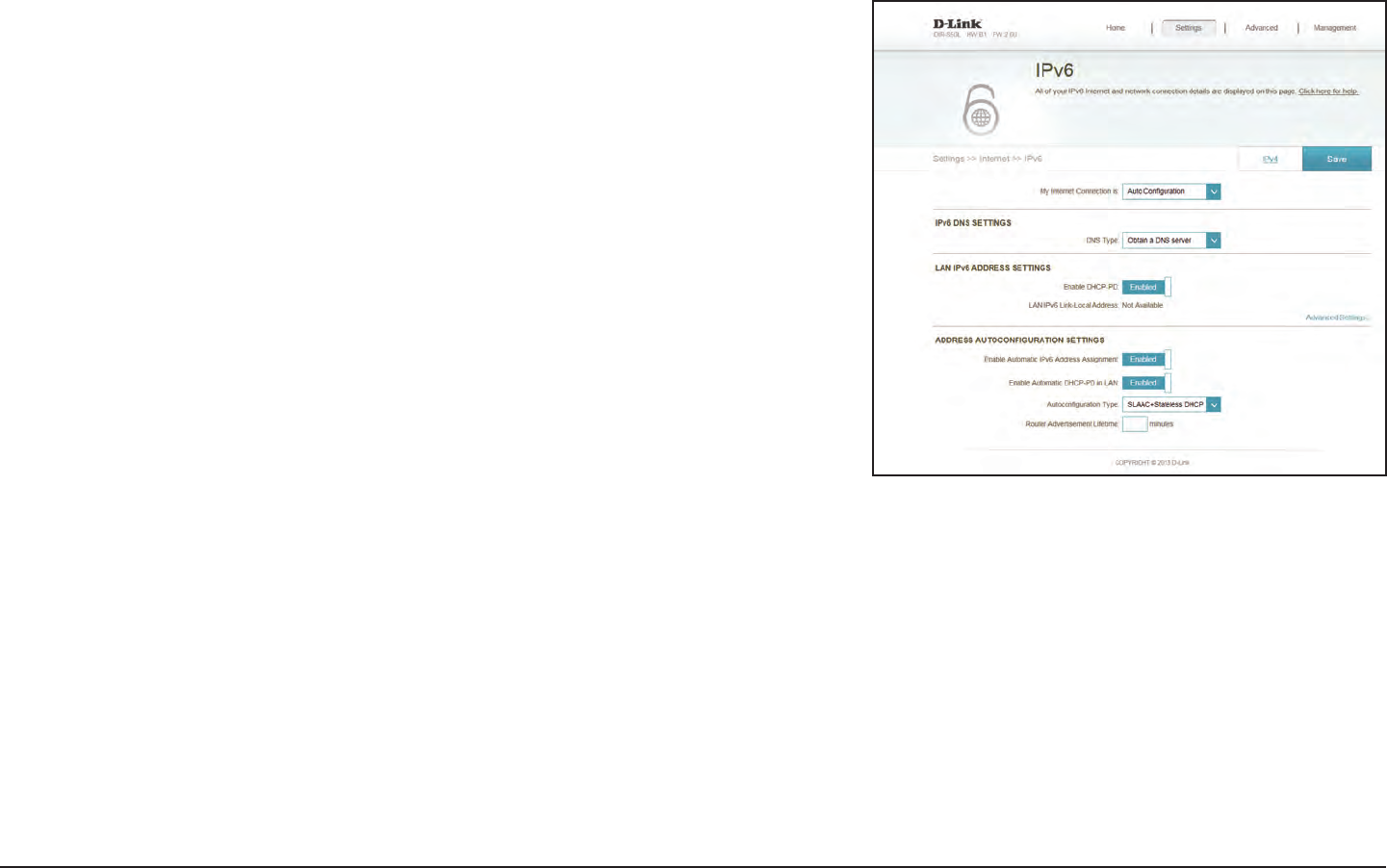
82D-Link DIR-850L User Manual
Section 4 - Conguration
Auto Conguration (SLAAC/DHCPv6)
Select either Obtain DNS server address automatically or Use the
following DNS address.
If you selected Use the following DNS address above, enter the
primary DNS server address.
If you selected Use the following DNS address above, enter the
secondary DNS server address.
Enable or disable prex delegation services.
If you disabled DHCP-PD, enter the LAN (local) IPv6 address for the
router.
Displays the router’s LAN link-local address.
Enable or disable the Automatic IPv6 Address Assignment feature.
Enable or disable automatic DHCP-PD services.
DNS Type:
Primary DNS
Server:
Secondary DNS
Server:
Enable DHCP-
PD:
LAN IPv6
Address:
LAN IPv6 Link-
Local Address:
Enable
Automatic
IPv6 Address
Assignment:
Enable
Automatic
DHCP-PD in
LAN:
This is a connection method where the ISP assigns your IPv6 address when your router requests one from the ISP’s server. Some ISPs require you
to make some settings on your side before your router can connect to the IPv6 Internet.
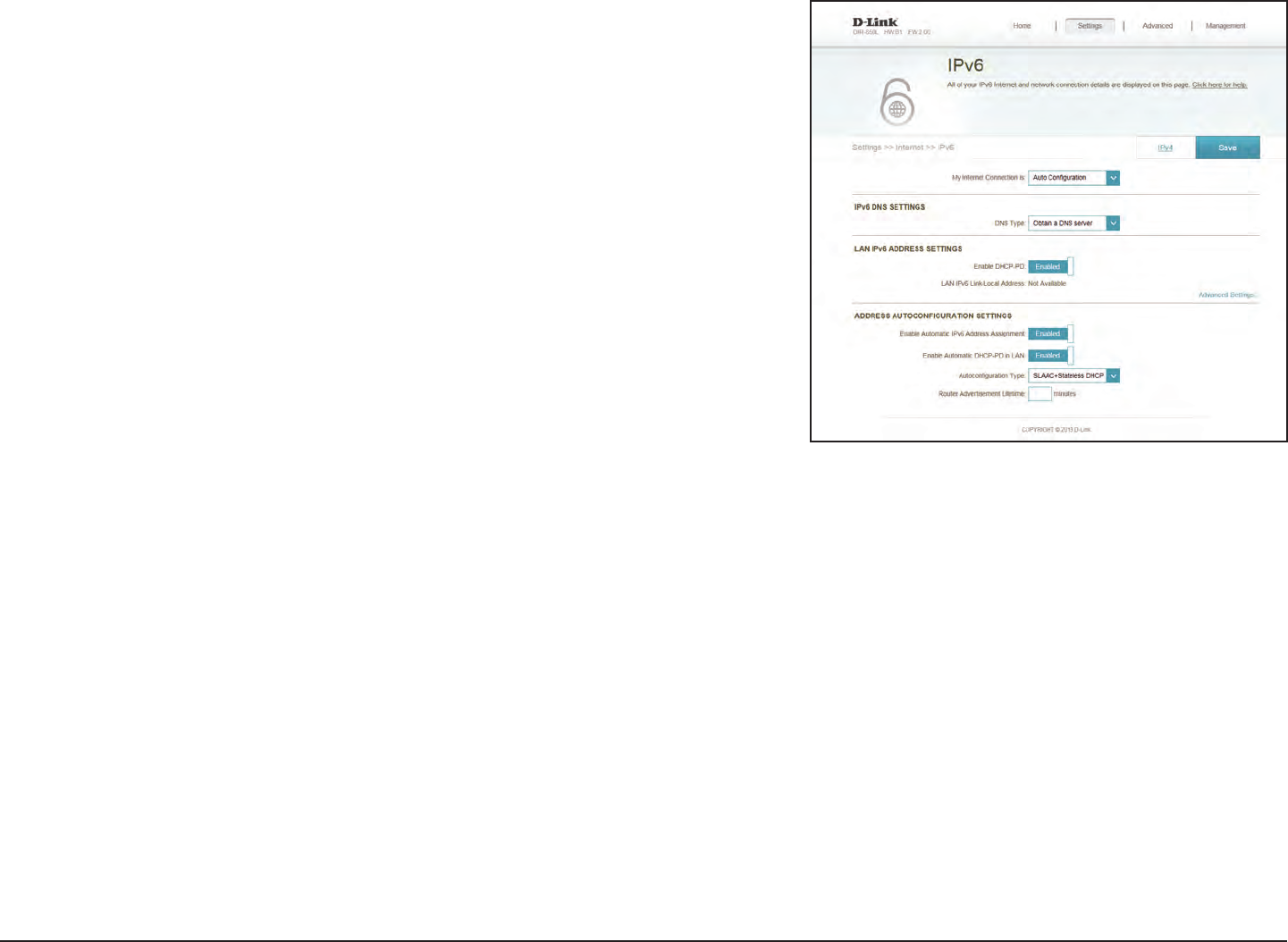
83D-Link DIR-850L User Manual
Section 4 - Conguration
Select SLAAC + RDNSS or SLAAC + Stateless DHCP, Stateful
(DHCPv6).
Enter the IPv6 address lifetime (in minutes).
Click Save when you are done.
Auto
Conguration
Type:
Router
Advertisement
Lifetime:
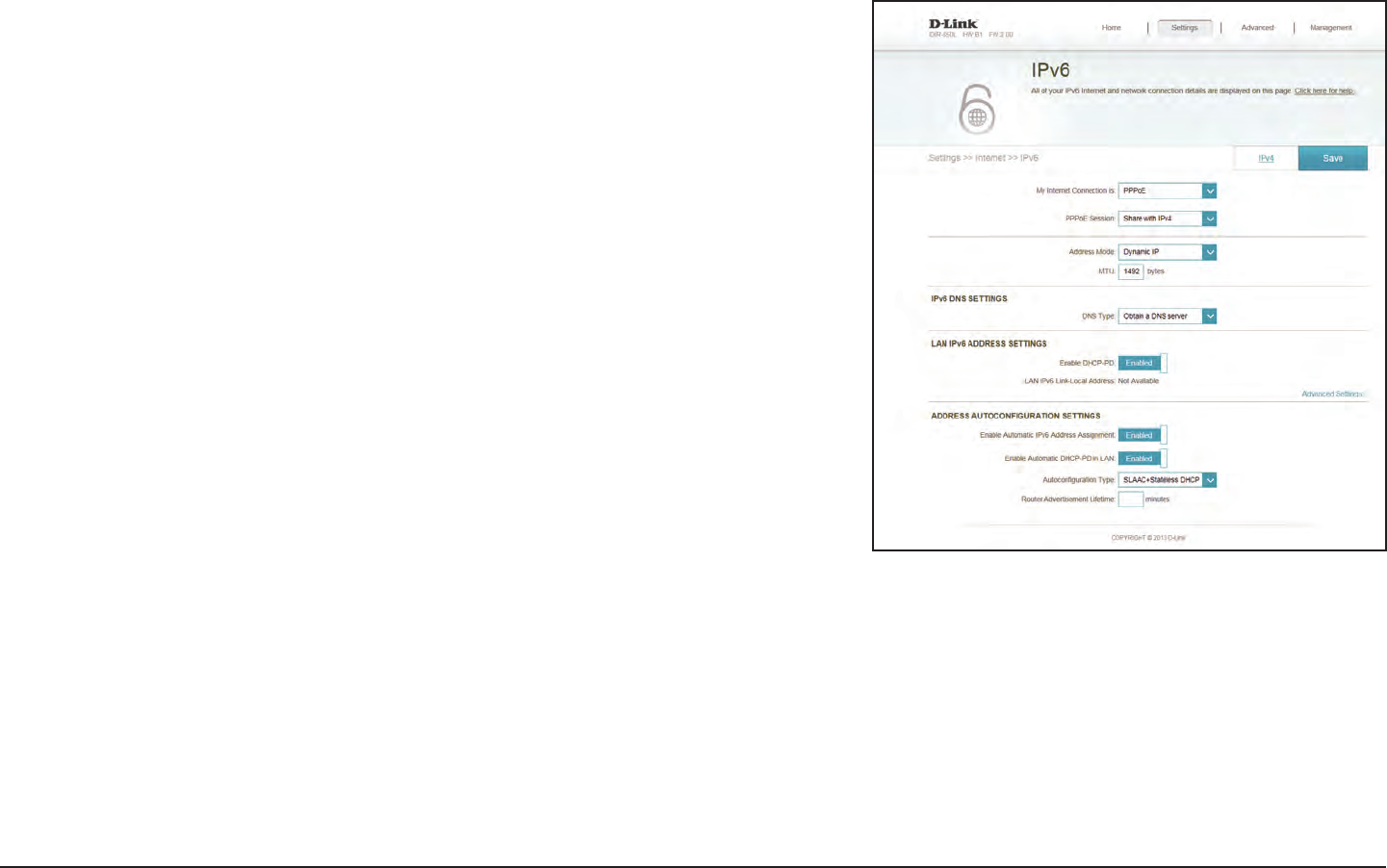
84D-Link DIR-850L User Manual
Section 4 - Conguration
PPPoE
Choose Share with IPv4 to re-use your IPv4 PPPoE username and
password, or Create a new session.
If you selected Create a new session above, enter the PPPoE
username provided by your ISP here.
If you selected Create a new session above, enter the PPPoE
password provided by your ISP here.
Select Static IP if your ISP assigned you the IP address, subnet mask,
gateway, and DNS server addresses. In most cases, select Dynamic IP.
Enter the IP address provided by your ISP (Static IP only).
Maximum Transmission Unit - you may need to change the MTU for
optimal performance with your ISP.
Select either Obtain DNS server address automatically or Use the
following DNS address.
If you selected Use the following DNS address above, enter the
primary DNS server address.
If you selected Use the following DNS address above, enter the
secondary DNS server address.
PPPoE Session:
Username:
Password:
Address Mode:
IP Address:
Service Name:
Reconnect
Mode:
MTU:
DNS Type:
Primary DNS
Server:
Secondary DNS
Server:
Select PPPoE if your Internet connection requires you to enter a username and password. This information is provided by your Internet service
provider (ISP).
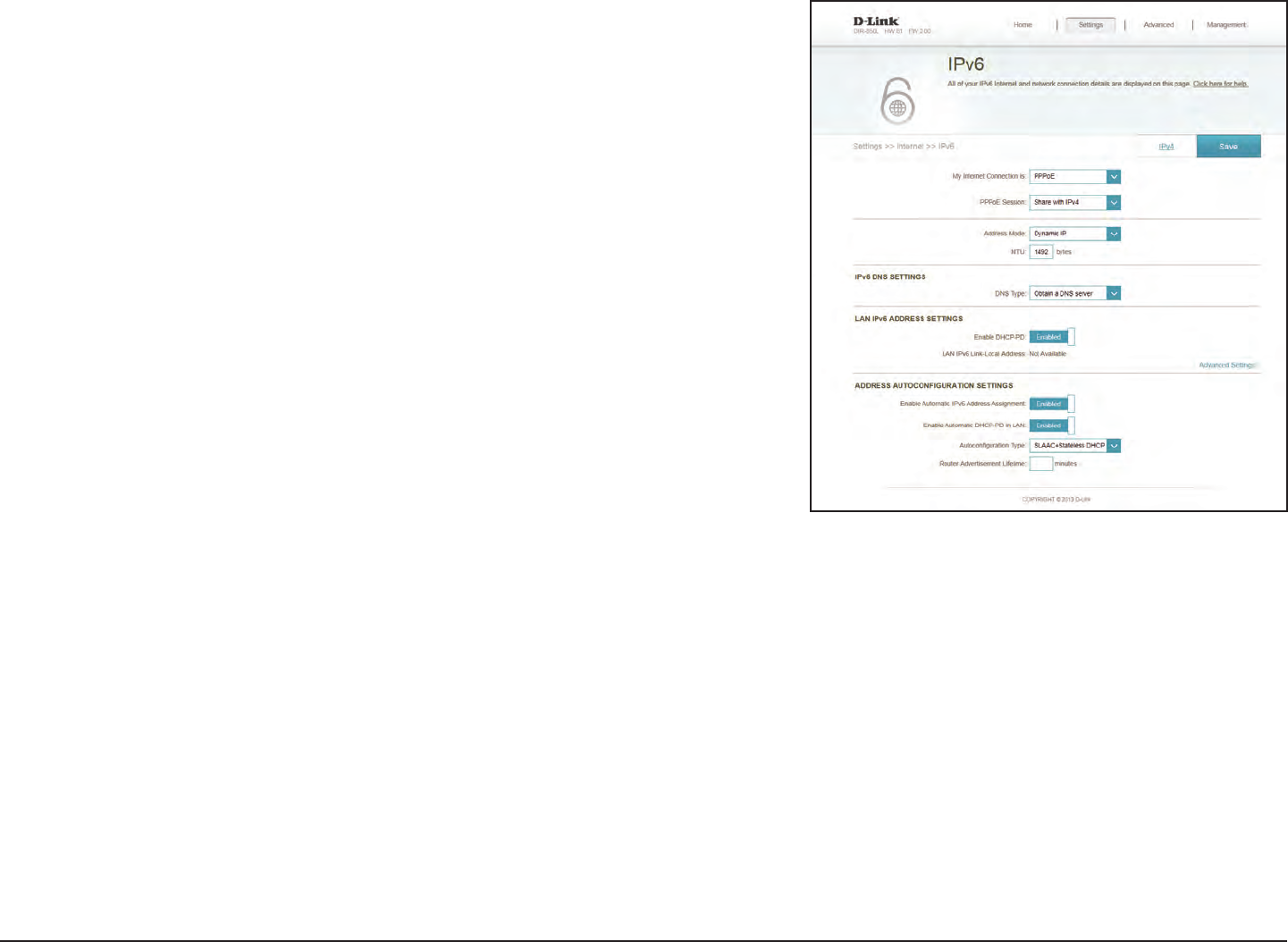
85D-Link DIR-850L User Manual
Section 4 - Conguration
Enter the LAN (local) IPv6 address for the router.
Displays the router’s LAN link-local address.
Enable or disable the Automatic IPv6 Address Assignment feature.
Select SLAAC + RDNSS or SLAAC + Stateless DHCP, Stateful
(DHCPv6).
Enter the IPv6 address lifetime (in minutes).
Click Save when you are done.
LAN IPv6
Address:
LAN IPv6 Link-
Local Address:
Enable
Automatic
IPv6 Address
Assignment:
Auto
Conguration
Type:
Router
Advertisement
Lifetime:
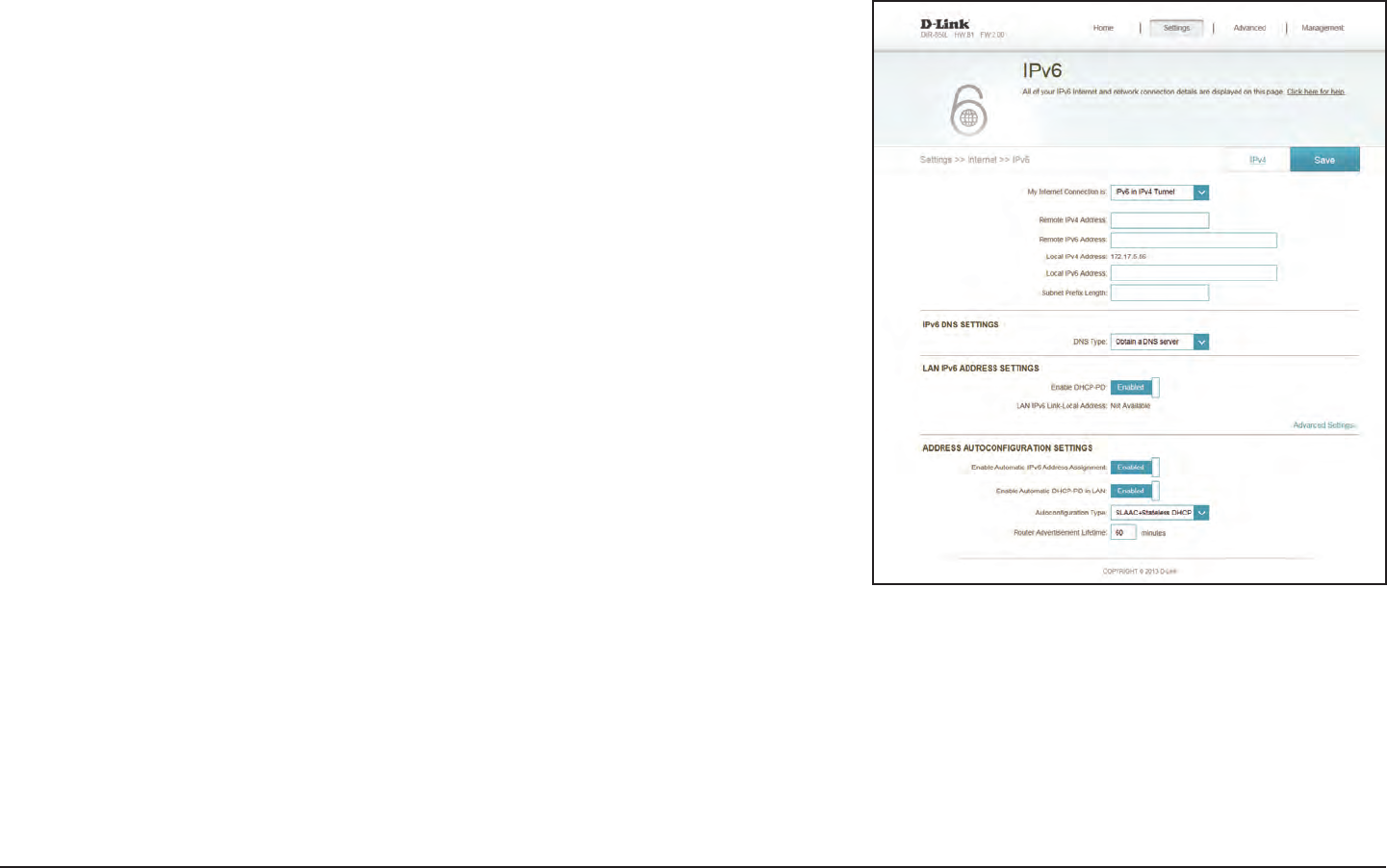
86D-Link DIR-850L User Manual
Section 4 - Conguration
IPv6 in IPv4 Tunnel
Enter the IPv4 remote address you will use.
Enter the IPv6 remote address you will use.
Enter the IPv4 local address you will use.
Enter the IPv6 local address you will use.
Enter the subnet prex length supplied by your ISP.
Select either Obtain DNS server address automatically or Use the
following DNS address.
If you selected Use the following DNS address above, enter the
primary DNS server address.
If you selected Use the following DNS address above, enter the
secondary DNS server address.
Enable or disable prex delegation services.
If you disabled DHCP-PD, enter the LAN (local) IPv6 address for the
router.
Remote IPv4
Address:
Remote IPv6
Address:
Local IPv4
Address:
Local IPv6
Address:
Subnet Prex
Length:
DNS Type:
Primary DNS
Server:
Secondary DNS
Server:
Enable DHCP-
PD:
LAN IPv6
Address:
The user can congure the IPv6 connection to run in IPv4 Tunnel mode. IPv6 over IPv4 tunneling encapsulates IPv6 packets in IPv4 packets so
that IPv6 packets can be sent over an IPv4 infrastructure.
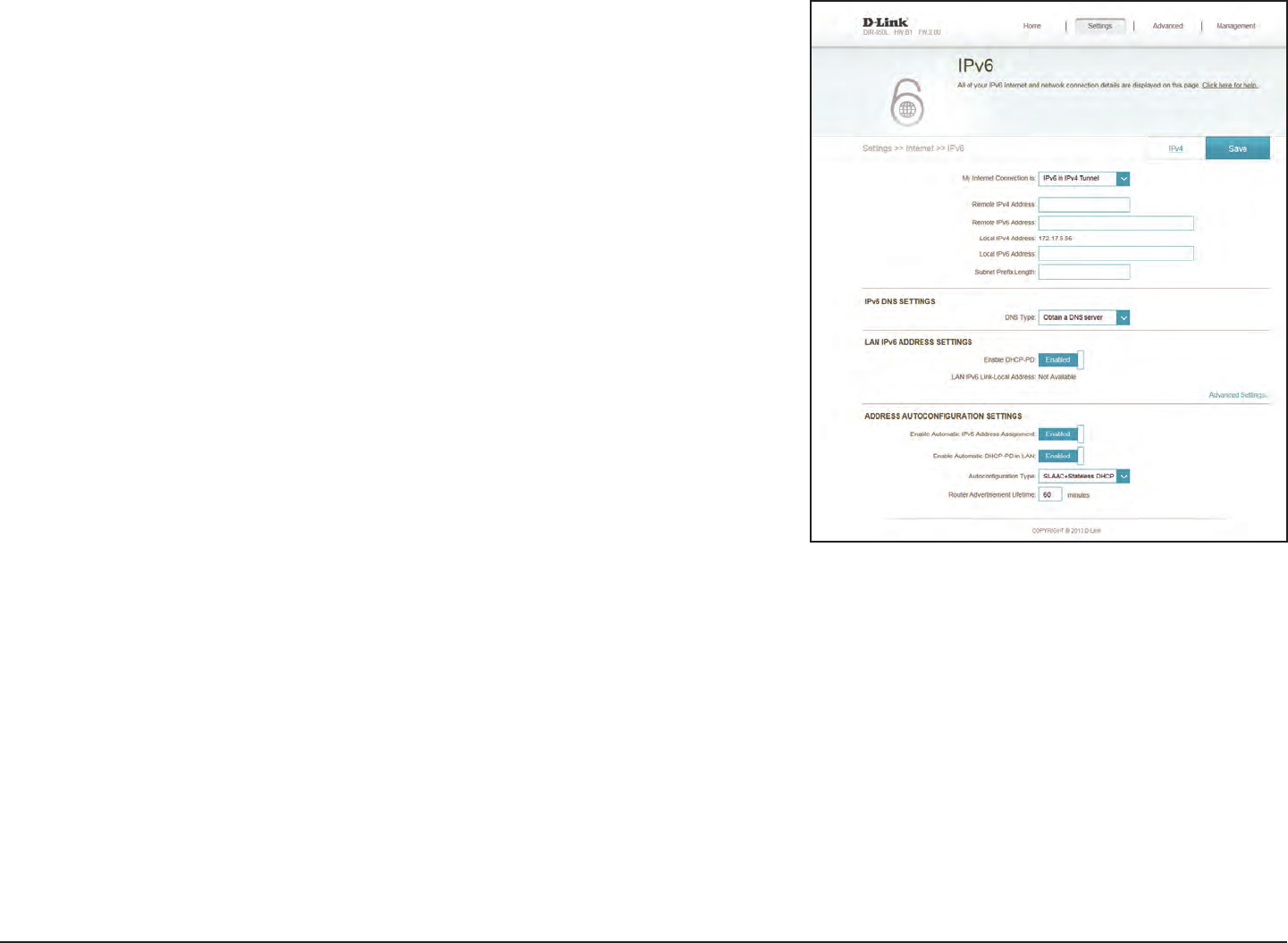
87D-Link DIR-850L User Manual
Section 4 - Conguration
Displays the router’s LAN link-local address.
Enable or disable the Automatic IPv6 Address Assignment feature.
Enable or disable automatic DHCP-PD services.
Select SLAAC + RDNSS, SLAAC + Stateless DHCP, or Stateful
(DHCPv6).
Enter the IPv6 address lifetime (in minutes).
Click Save when you are done.
LAN IPv6 Link-
Local Address:
Enable
Automatic
IPv6 Address
Assignment:
Enable
Automatic
DHCP-PD in
LAN:
Auto
Conguration
Type:
Router
Advertisement
Lifetime:
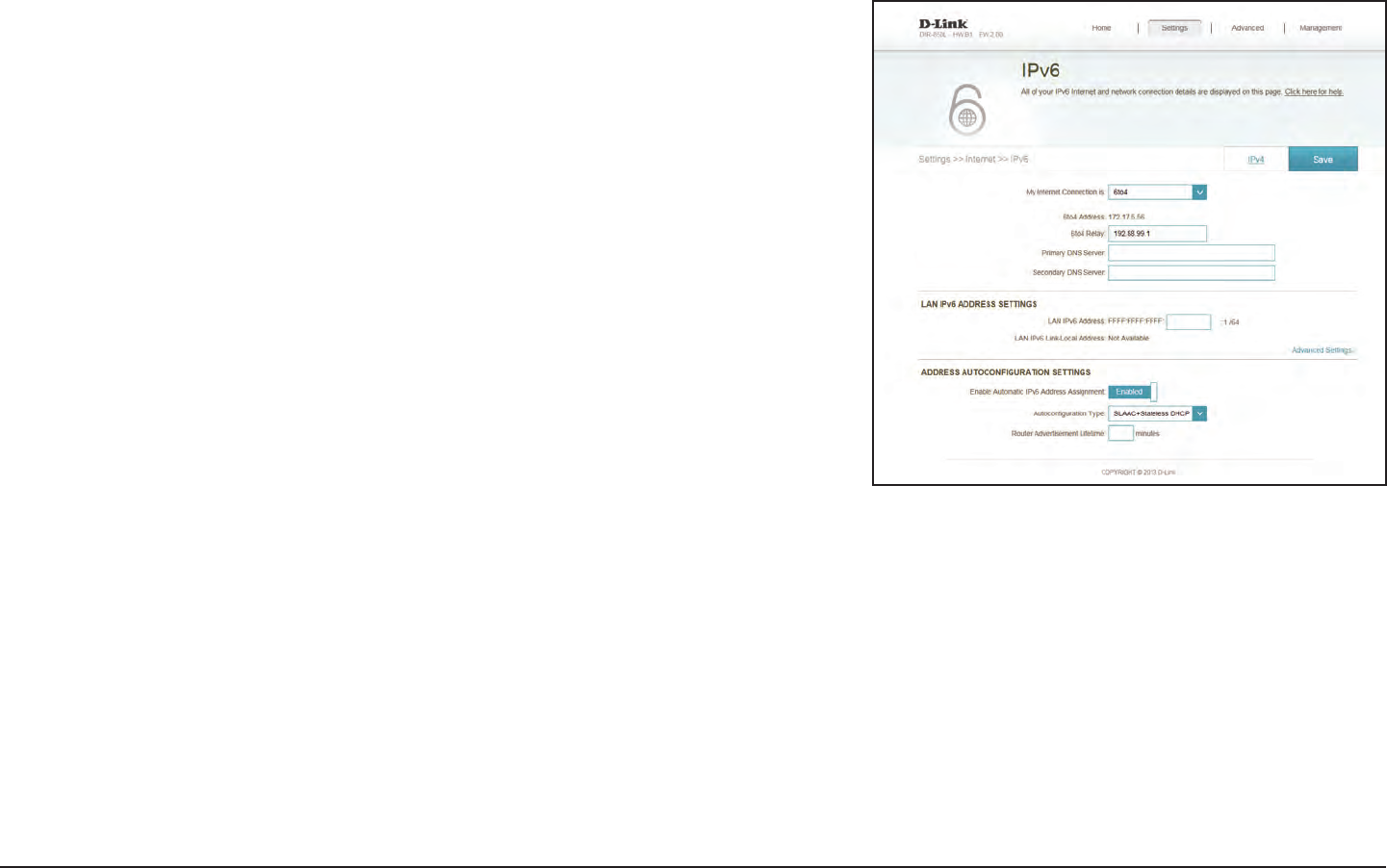
88D-Link DIR-850L User Manual
Section 4 - Conguration
6 to 4
Displays the 6 to 4 address.
Enter the 6 to 4 relay supplied by your ISP.
Enter the primary DNS server address.
Enter the secondary DNS server address.
Enter the LAN (local) IPv6 address for the router.
Displays the router’s LAN link-local address.
Check to enable the Automatic IPv6 Address Assignment feature.
Select Stateful (DHCPv6), SLAAC + RDNSS or SLAAC + Stateless
DHCPv6.
Enter the IPv6 address lifetime (in minutes).
Click Save when you are done.
6 to 4 Address:
6 to 4 Relay:
Primary DNS
Server:
Secondary DNS
Server:
LAN IPv6
Address:
LAN IPv6 Link-
Local Address:
Enable
Automatic
IPv6 Address
Assignment:
Auto
Conguration
Type:
Router
Advertisement
Lifetime:
In this section the user can congure the IPv6 6 to 4 connection settings. 6to4 is an IPv6 address assignment and automatic tunneling technol-
ogy that is used to provide unicast IPv6 connectivity between IPv6 sites and hosts across the IPv4 Internet.
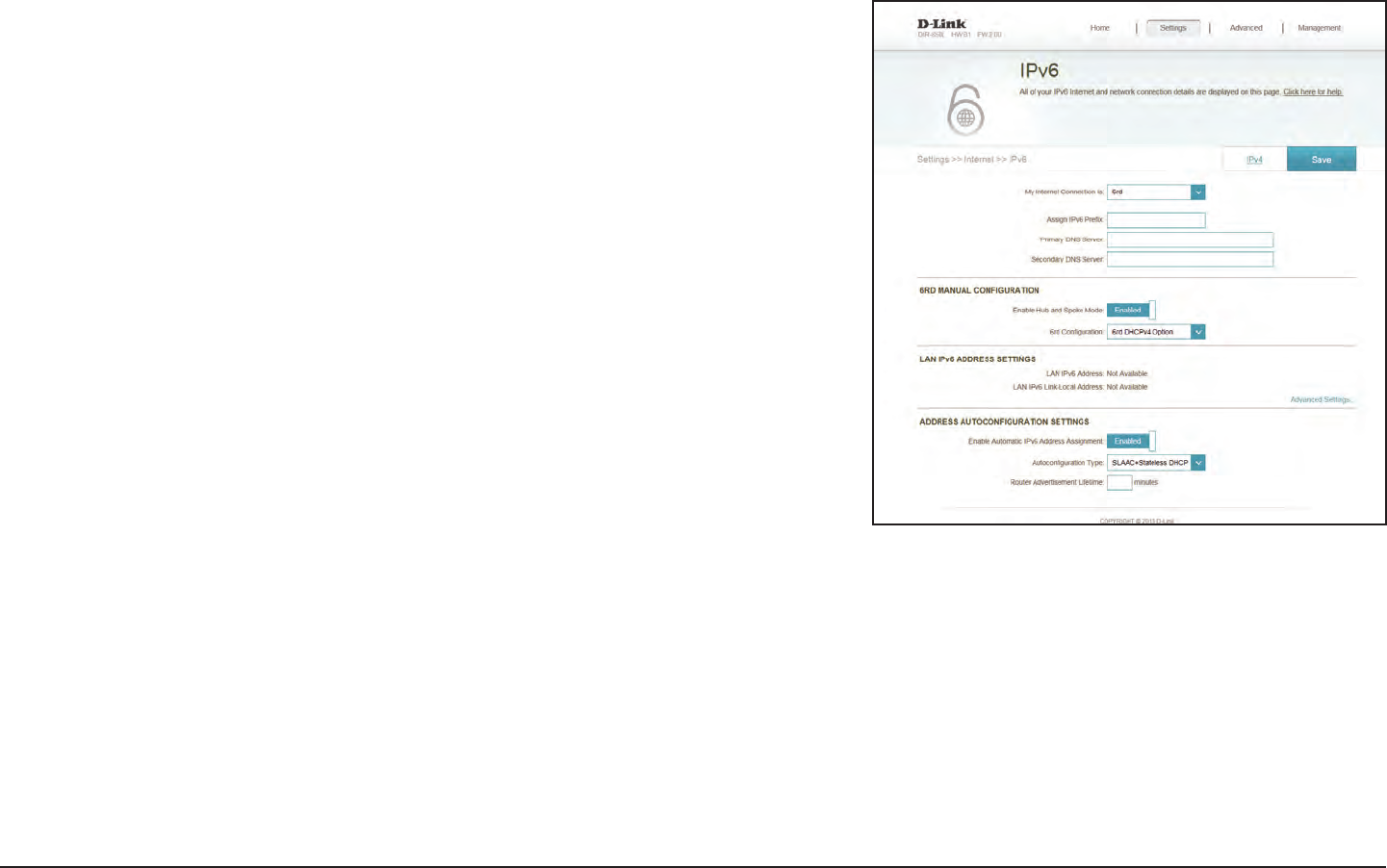
89D-Link DIR-850L User Manual
Section 4 - Conguration
6rd
Currently unsupported.
Enter the primary DNS server address.
Enter the secondary DNS server address.
Enable if you want to minimize the number of routes to the
destination by using a hub and spoke method of networking.
Choose the 6rd DHCPv4 Option to automatically discover and
populate the data values, or Manual Conguration to enter the
settings yourself.
This is the IPv4 address given to you by your ISP and cannot be
changed.
Enter the 6rd IPv6 prex and mask length supplied by your ISP
(manual conguration only).
Enter the 6rd border relay IPv4 address settings supplied by your ISP
(manual conguration only).
Enter the LAN (local) IPv6 address for the router.
Assign IPv6
Prex:
Primary DNS
Server:
Secondary DNS
Server:
Enable Hub and
Spoke Mode:
6rd
Conguration:
WAN IPv4
Address:
6rd IPv6 Prex:
6rd Border
Relay IPv4
Address:
LAN IPv6
Address:
In this section the user can congure the IPv6 6rd connection settings.
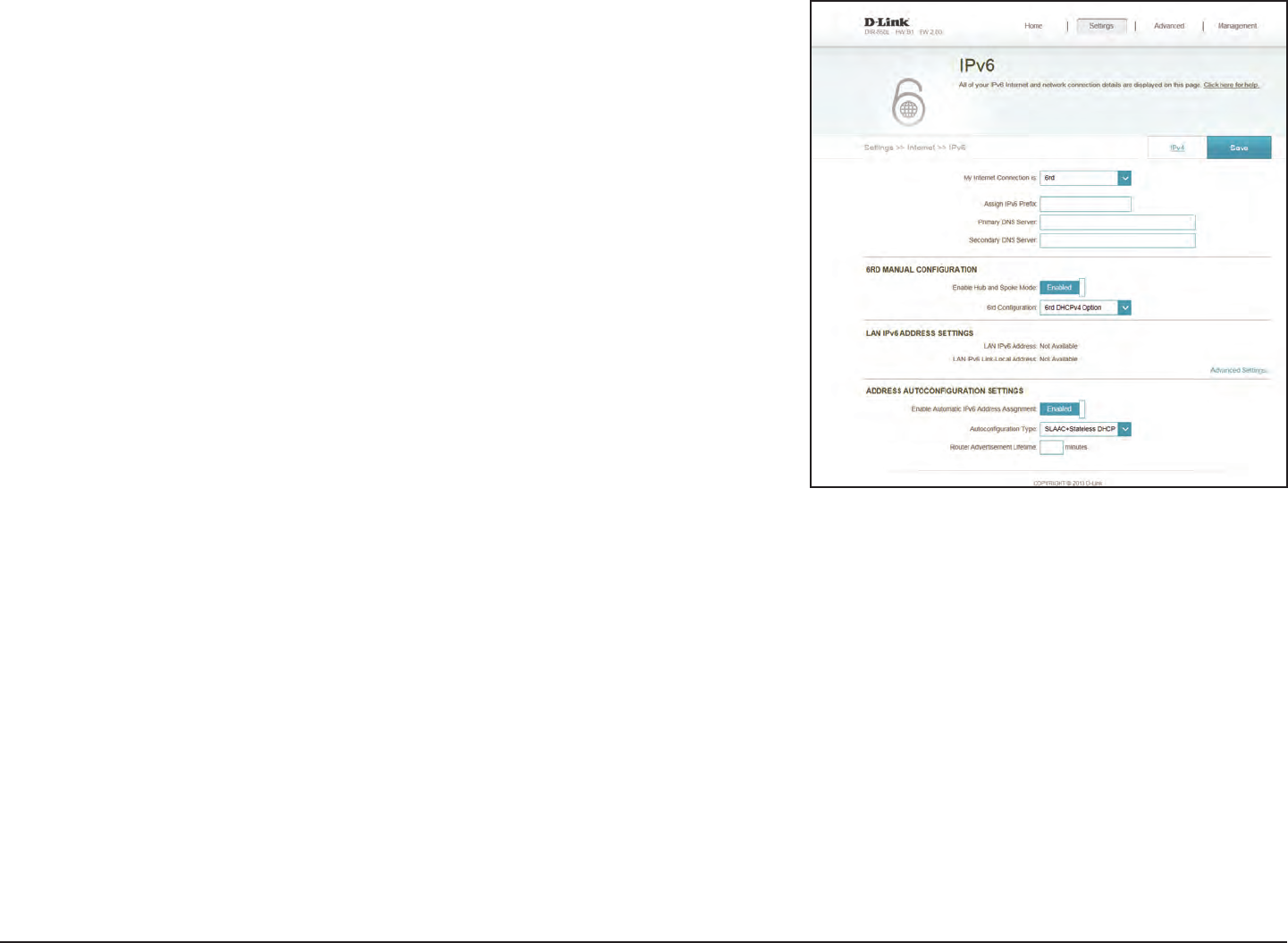
90D-Link DIR-850L User Manual
Section 4 - Conguration
Displays the router’s LAN link-local address.
Check to enable the Automatic IPv6 Address Assignment feature.
Select Stateful (DHCPv6), SLAAC + RDNSS or SLAAC + Stateless
DHCPv6.
Enter the IPv6 address lifetime (in minutes).
Click Save when you are done.
LAN IPv6 Link-
Local Address:
Enable
Automatic
IPv6 Address
Assignment:
Auto
Conguration
Type:
Router
Advertisement
Lifetime:
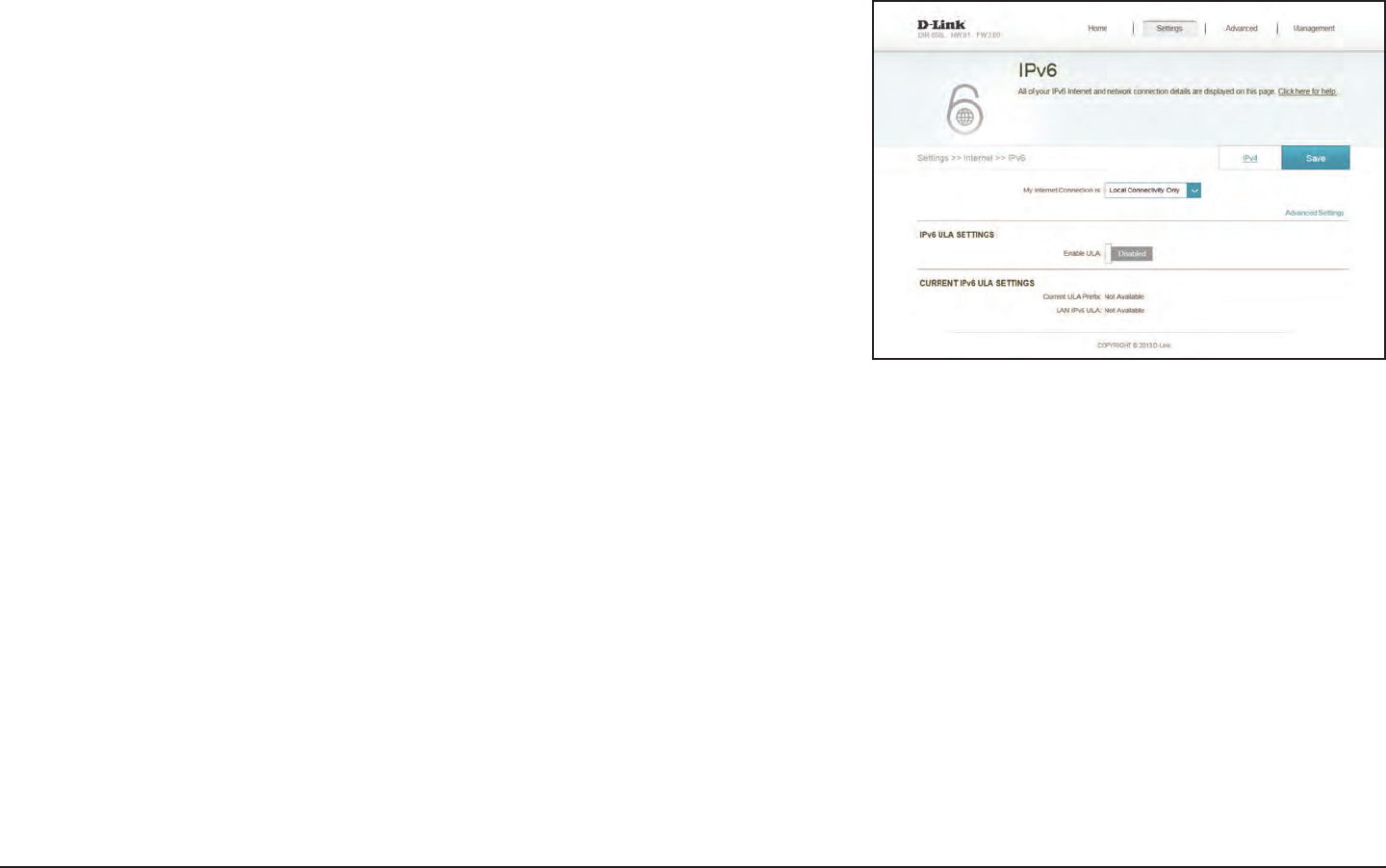
91D-Link DIR-850L User Manual
Section 4 - Conguration
Local Connectivity Only
Click here to enable Unique Local IPv6 Unicast Addresses settings.
Checking this box will automatically congure the ULA prex for
the default setting.
If you wish to choose your own ULA prex, enter it here.
This section will display the current settings for your IPv6 ULA.
Click Save when you are done.
Enable ULA:
Use Default
ULA Prex:
ULA Prex:
Current IPv6
ULA Settings:
Local Connectivity Only allows you to set up an IPv6 connection that will not connect to the Internet.
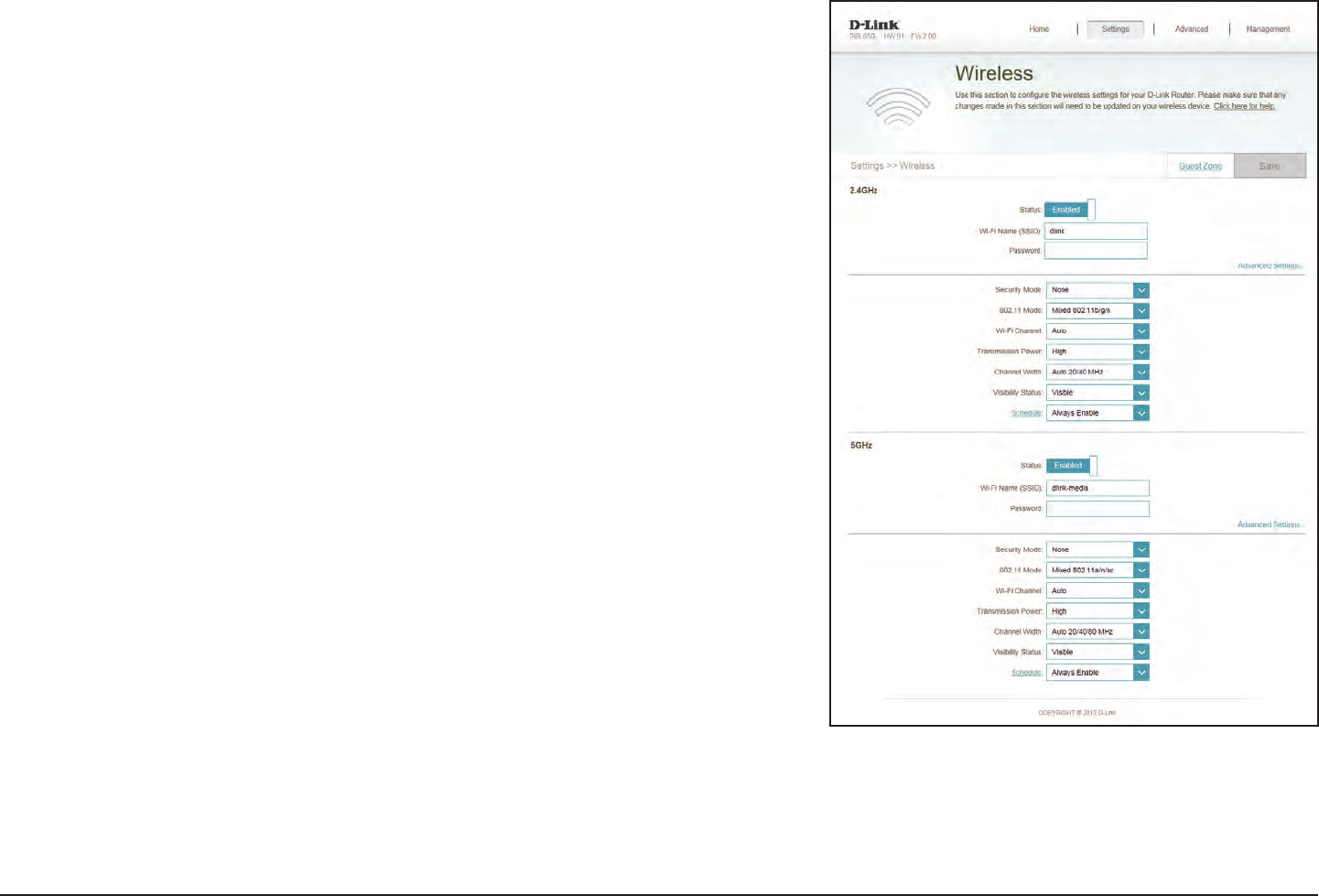
92D-Link DIR-850L User Manual
Section 4 - Conguration
Wireless
Enable or disable the wireless frequency band.
Create a name for your wireless network using up to 32 characters.
Create a password to use for wireless security. Wireless clients will
need to enter this password to successfully connect to the network.
Choose None, WEP, or WPA/WPA2-(Personal) (recommended).
Select the desired wireless networking standards to use. The available
options will depend on the wireless frequency band, as well as the
currently selected security mode.
Select the desired channel. The default is Auto (recommended).
Select the desired wireless transmission power.
Select Auto 20/40 if you are using both 802.11n and non-802.11n
wireless devices, or select 20 MHz if you are not using any 802.11n
wireless clients.
The default setting is Visible. Select Invisible if you do not want to
broadcast the SSID of your wireless network.
Status:
Wi-Fi Name
(SSID):
Password:
Security Mode:
802.11 Mode:
Wi-Fi Channel:
Transmission
Power:
Channel Width:
Visibility Status:
In the Settings menu on the bar on the top of the page, click Wireless to see the
wireless conguration options. To congure the router’s guest zone, click the Guest
Zone link. Refer to page 94 for details. Click Advanced Settings... to expand the list
and see all of the options. The following options apply to both the 2.4 GHz and the
5 GHz wireless frequency bands:
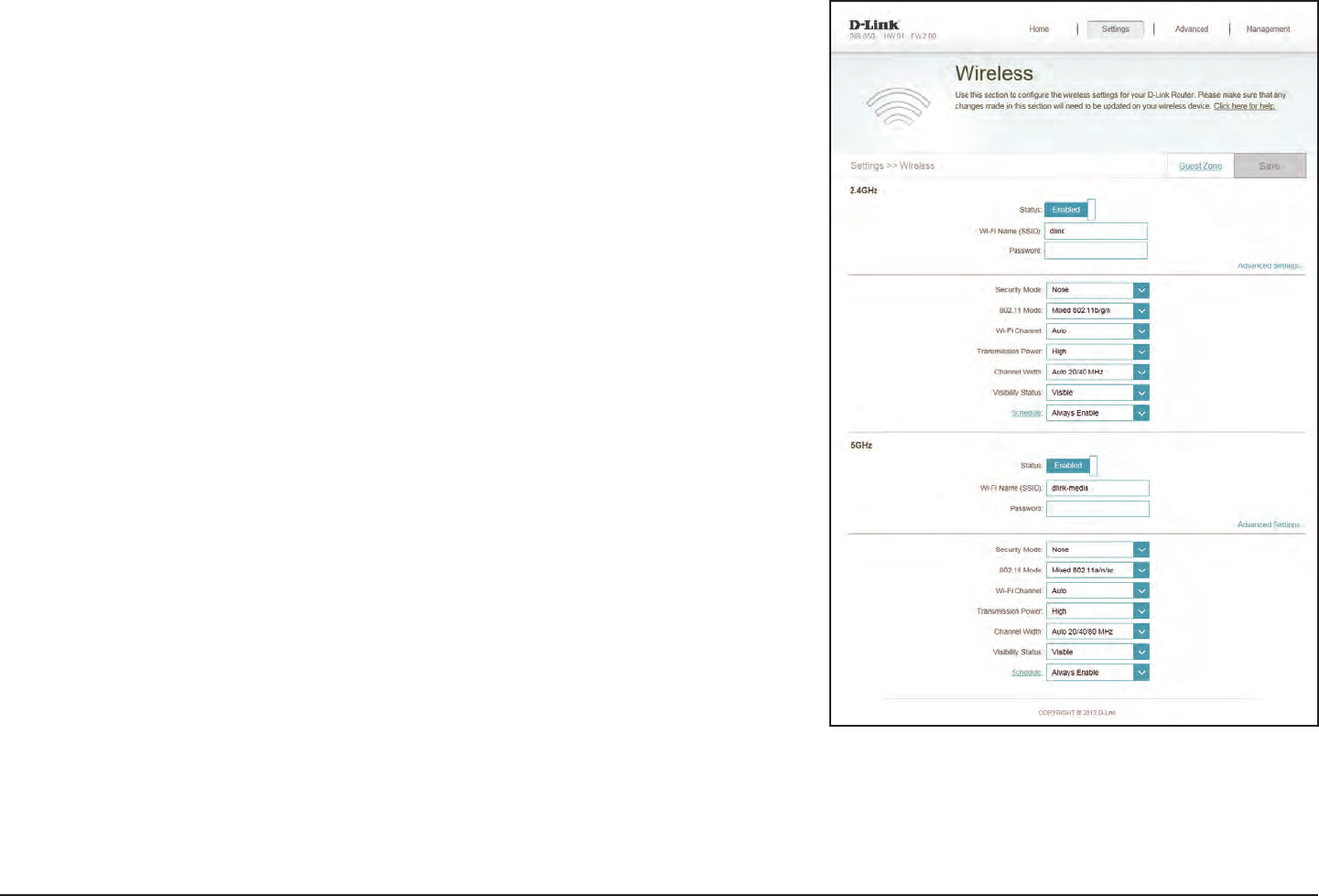
93D-Link DIR-850L User Manual
Section 4 - Conguration
Use the drop-down menu to select the time schedule that the rule
will be enabled on. The schedule may be set to Always Enable, or
you can create your own schedules in the Schedules section (refer
to page 88).
Click Save when you are done.
Schedule:
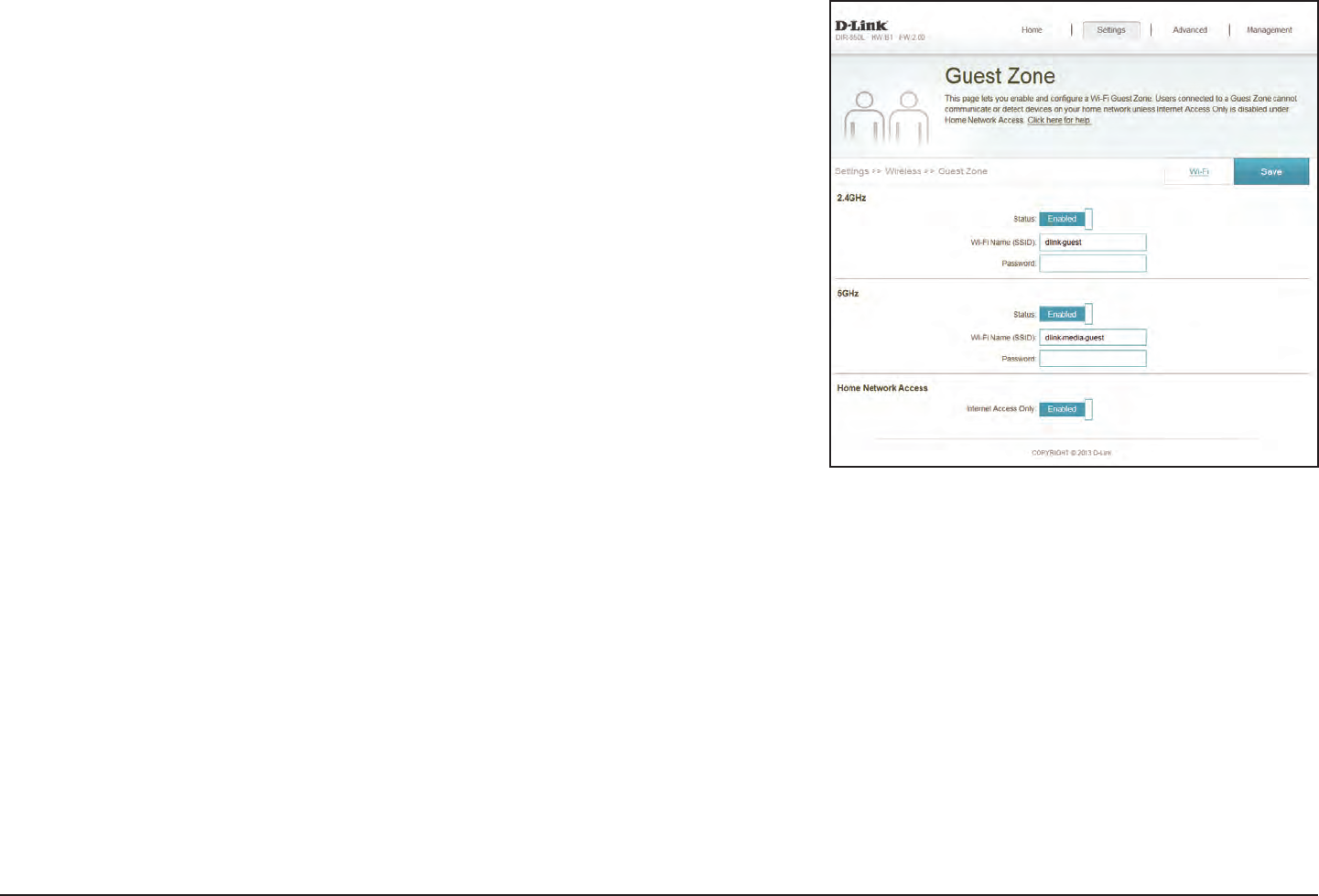
94D-Link DIR-850L User Manual
Section 4 - Conguration
Guest Zone
Enable or disable the guest zone for each wireless frequency band.
Enter a wireless network name (SSID) that is dierent from your main
wireless network.
Create a password to use for wireless security. Wireless clients will
need to enter this password to successfully connect to the guest zone.
Enabling this option will confine connectivity to the Internet,
disallowing guests from accessing other local network devices.
Click Save when you are done.
Status:
Wi-Fi Name
(SSID):
Password:
Internet Access
Only:
In the Settings menu on the bar on the top of the page, click Wireless, then click
the Guest Zone link. Click Advanced Settings... to expand the list and see all of
the options. The following options apply to both the 2.4 GHz and the 5 GHz wireless
frequency bands:
The guest zone feature will allow you to create temporary zones that can be used by
guests to access the Internet. These zones will be separate from your main wireless
network. You may congure dierent zones for the 2.4 GHz and 5 GHz wireless bands.
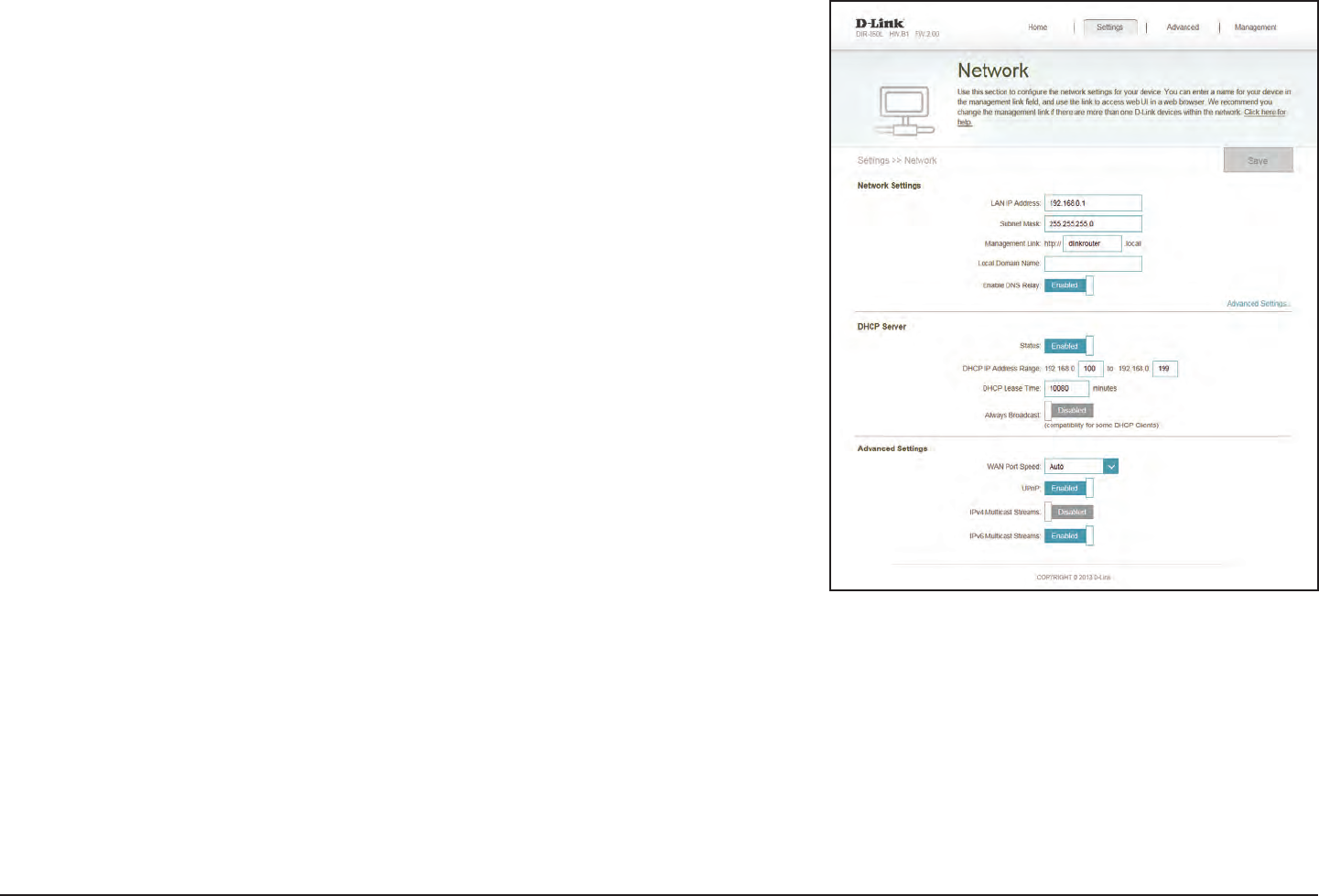
95D-Link DIR-850L User Manual
Section 4 - Conguration
Network
Enter the IP address of the router. The default IP address is
192.168.0.1.
If you change the IP address, once you click Save, you will need
to enter the new IP address in your browser to get back into the
conguration utility.
Enter the subnet mask of the router. The default subnet mask is
255.255.255.0.
The default address to access the router’s configuration is
http://dlinkrouter.local./ Here, you can replace dlinkrouter with
a name of your choice.
Enter the domain name (optional).
Disable to transfer the DNS server information from your ISP to your
computers. If enabled, your computers will use the router for a DNS
server.
Enable or disable the DHCP server.
Enter the starting and ending IP addresses for the DHCP server’s IP
assignment.
Note: If you statically (manually) assign IP addresses to your computers
or devices, make sure the IP addresses are outside of this range or you
may have an IP conict.
LAN IP Address:
Subnet Mask:
Management
Link:
Local Domain
Name:
Enable DNS
Relay:
Status:
DHCP IP
Address Range:
This section will allow you to change the local network settings of the router and to
congure the DHCP settings. In the Settings menu on the bar on the top of the page,
click Network. Click Advanced Settings... to expand the list and see all of the options.
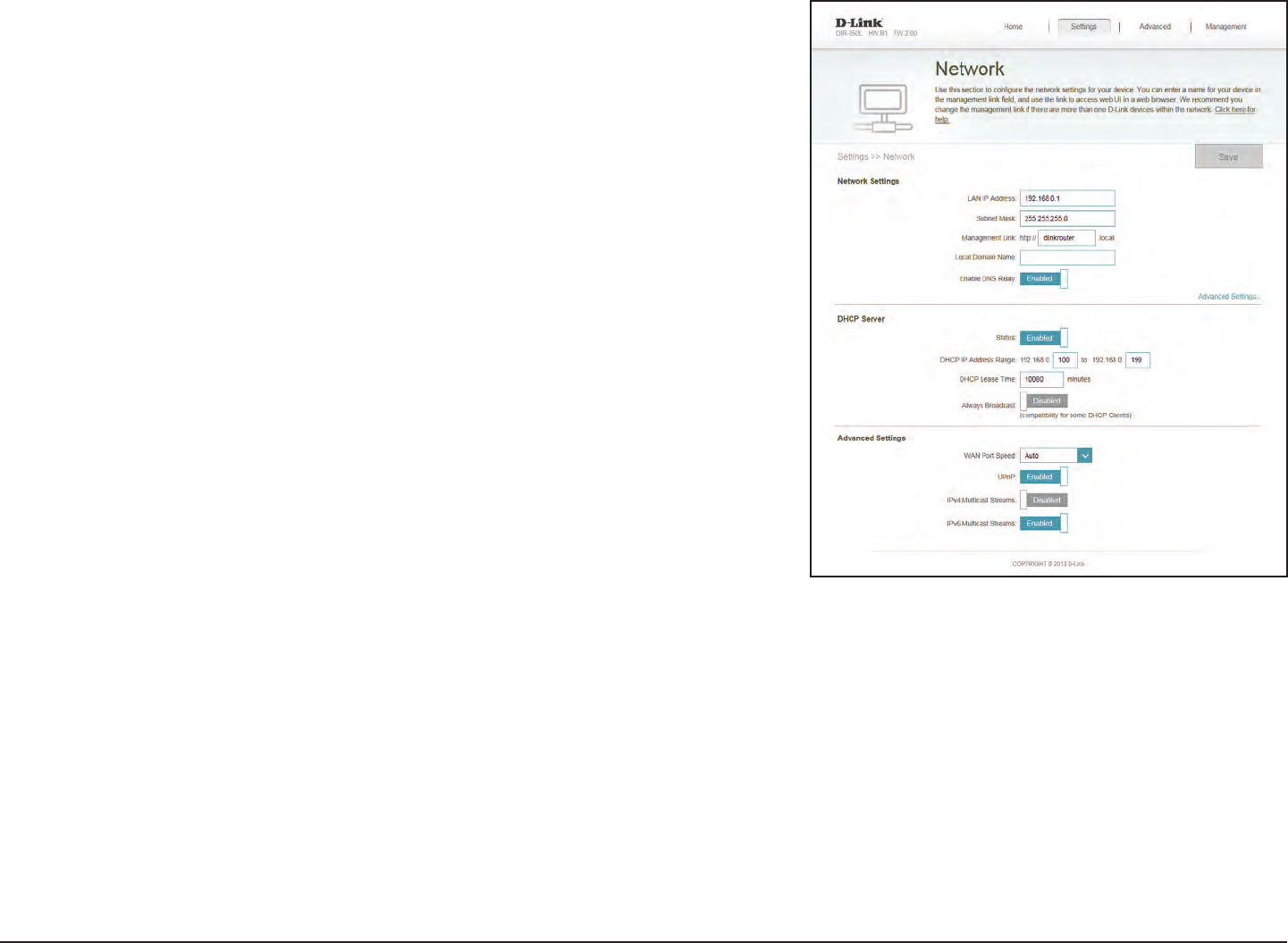
96D-Link DIR-850L User Manual
Section 4 - Conguration
DHCP Lease
Time:
Always
Broadcast:
UPnP:
WAN Port
Speed:
IPv4 Multicast
Stream:
IPv6 Multicast
Stream:
Enter the length of time for the IP address lease in minutes.
Enable this feature to broadcast your networks DHCP server to LAN/
WLAN clients.
Enable or disable Universal Plug and Play (UPnP). UPnP provides
compatibility with networking equipment, software and peripherals.
You may set the port speed of the Internet port to 10 Mbps,
100 Mbps, 1000 Mbps, or Auto (recommended).
Enable to allow IPv4 multicast trac to pass through the router from
the Internet.
Enable to allow IPv6 multicast trac to pass through the router from
the Internet.
Click Save when you are done.

97D-Link DIR-850L User Manual
Section 4 - Conguration
SharePort
Check to enable DLNA media server functions, allowing connected
clients access to media les over the network.
Choose a name for your DLNA media server so that it can be found.
Choose either Allow all users to access (no password) or Require
router’s admin password to specify whether the router’s password
will be required for access.
Enable remote access to les stored on a USB device plugged into
the router through a web browser.
This area will display the HTTP and HTTPS links to connect to your
SharePort drive through a web browser from a device on your
network.
Click Save when you are done.
Status:
DLNA Media
Server:
Windows
File Sharing
(SAMBA):
Web File Access:
Direct Links:
This page will allow you to set up access to les on an external USB device plugged
into the router. You can do this through the local network or from the Internet using
either a web browser or an app on your smartphone or tablet. In the Settings menu
on the bar on the top of the page, click SharePort.
To manage user accounts for SharePort access, click Create User and refer to the
next page for details.
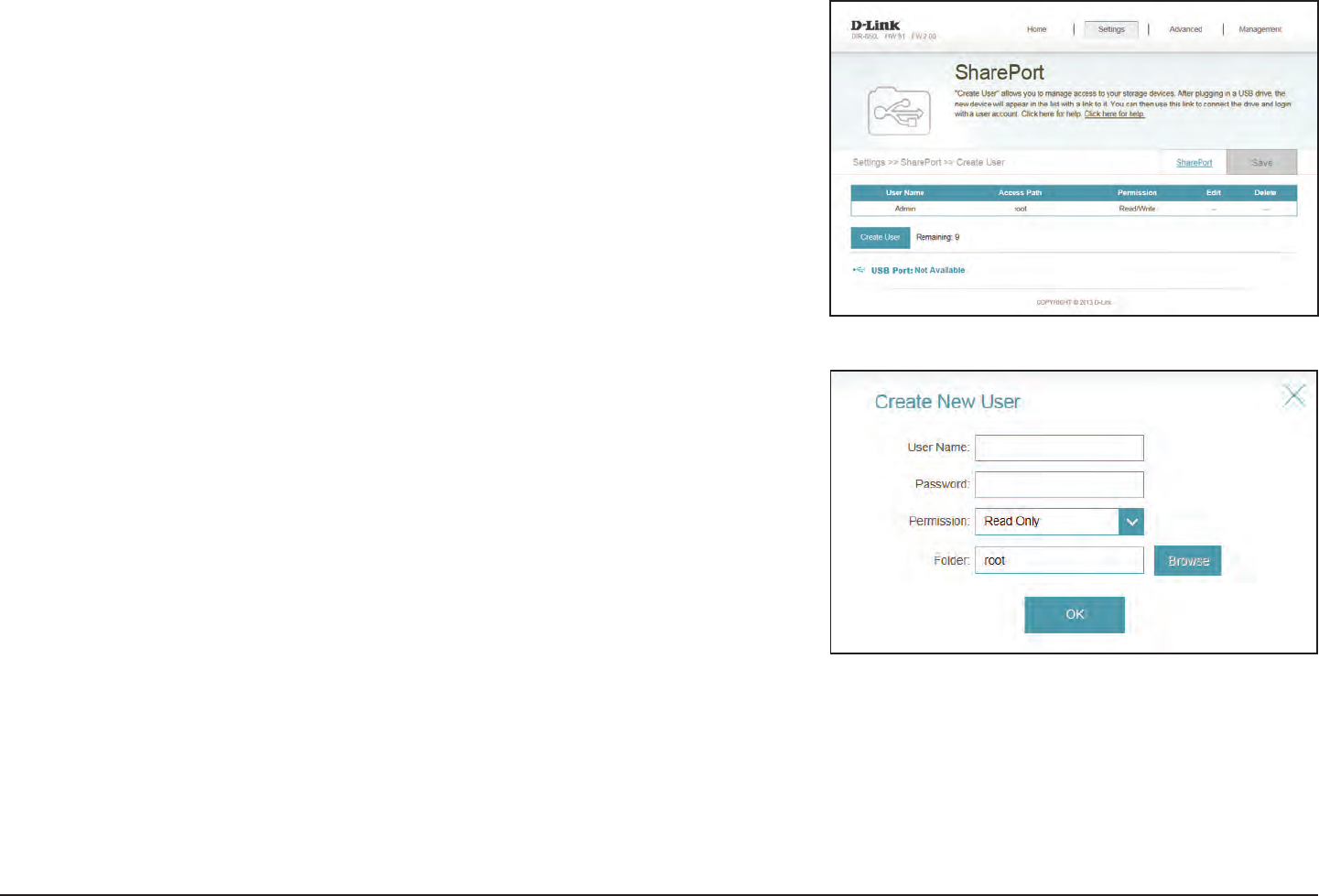
98D-Link DIR-850L User Manual
Section 4 - Conguration
Create User
Enter the desired user name for the new account.
Enter the password which the user will need to enter when logging in.
Select either Read Only or Read/Write to control whether the user
can edit, add, or delete les on the device.
Choose the parent folder that the user will be able to access. Files
and folders on a higher level will be unavailable. “root” means that
the user can access all les on the device. To change the selected
folder, click Browse and browse to the desired folder.
Click OK when you are done. The new user should be added to the
list of user accounts. To save the new list, click Save. To return to the
SharePort page, click SharePort.
User Name:
Password:
Permission:
Folder:
The Create User page allows you to manage your SharePort user accounts. The current
list of user accounts will be displayed, along with their current permissions and access
path. If they do not have an account set up, users will be restricted to guest access;
only having access to the “Guest” folder on the media server. The router can store a
maximum of ten accounts (including the “Admin” account).
If you wish to remove an account, click on its trash can icon in the Delete column. If
you wish to edit an account, click on its pencil icon in the Edit column. If you wish to
create a new account, click the Create User button. If you edit or create a user, the
following options will appear:
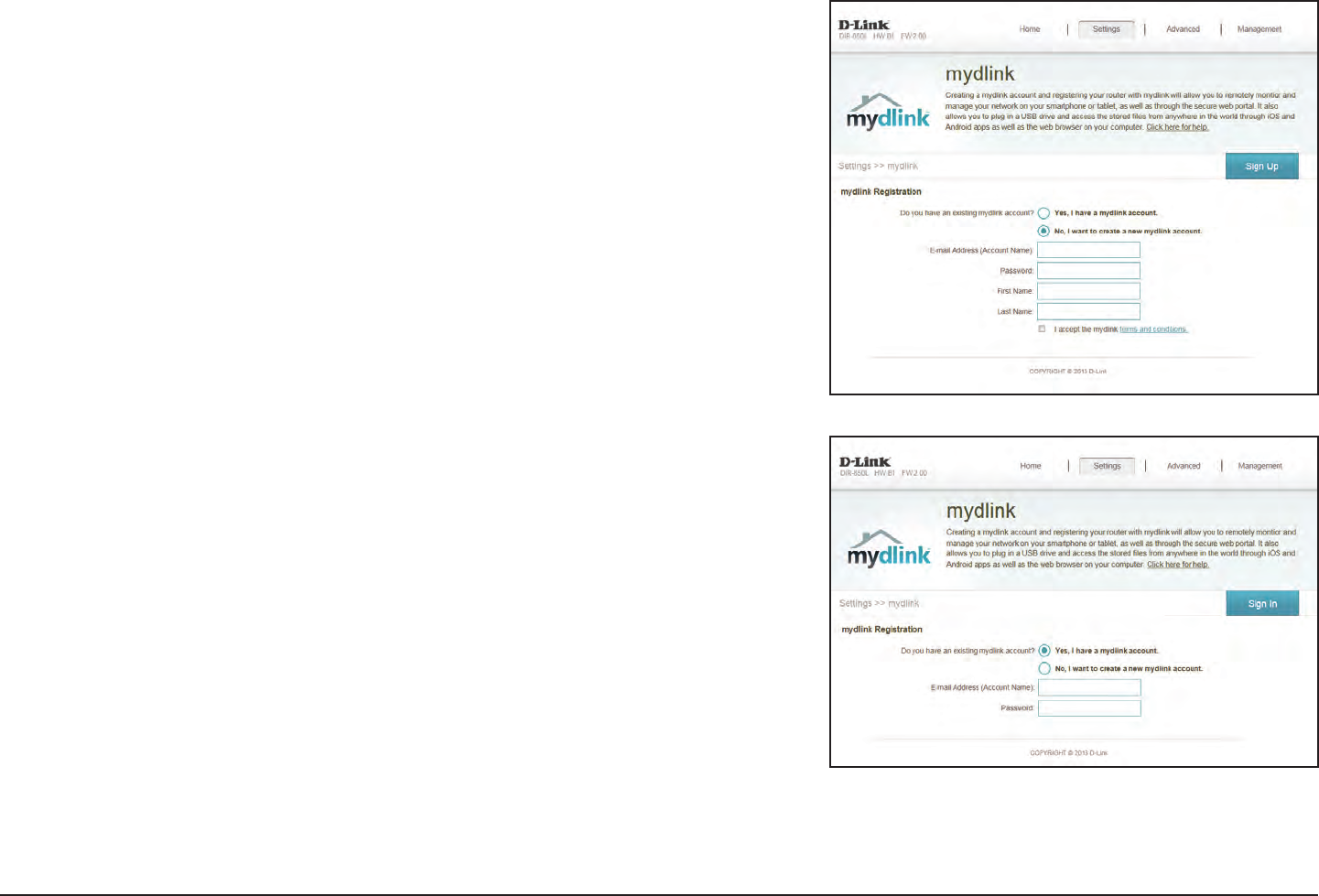
99D-Link DIR-850L User Manual
Section 4 - Conguration
mydlink
Enabling mydlink will allow you to access and manage the mydlink-compatible
devices on your network. This can be done either through a web browser or via a
smartphone app.
This page allows you to sign in to an existing mydlink account, or sign up for a new
mydlink account. In the Settings menu on the bar on the top of the page, click
mydlink.
If you do not already have a mydlink account, click No, I want to create a new
mydlink account. Fill out your email address (which will also function as your
username), choose a password, and enter your rst and last name. Then, click Sign
Up to create your new mydlink account.
If you already have a mydlink account, click Yes, I have a mydlink account. Enter
your email address (which is also your username) and your password. Then, click
Sign In to register your existing mydlink account with your router.
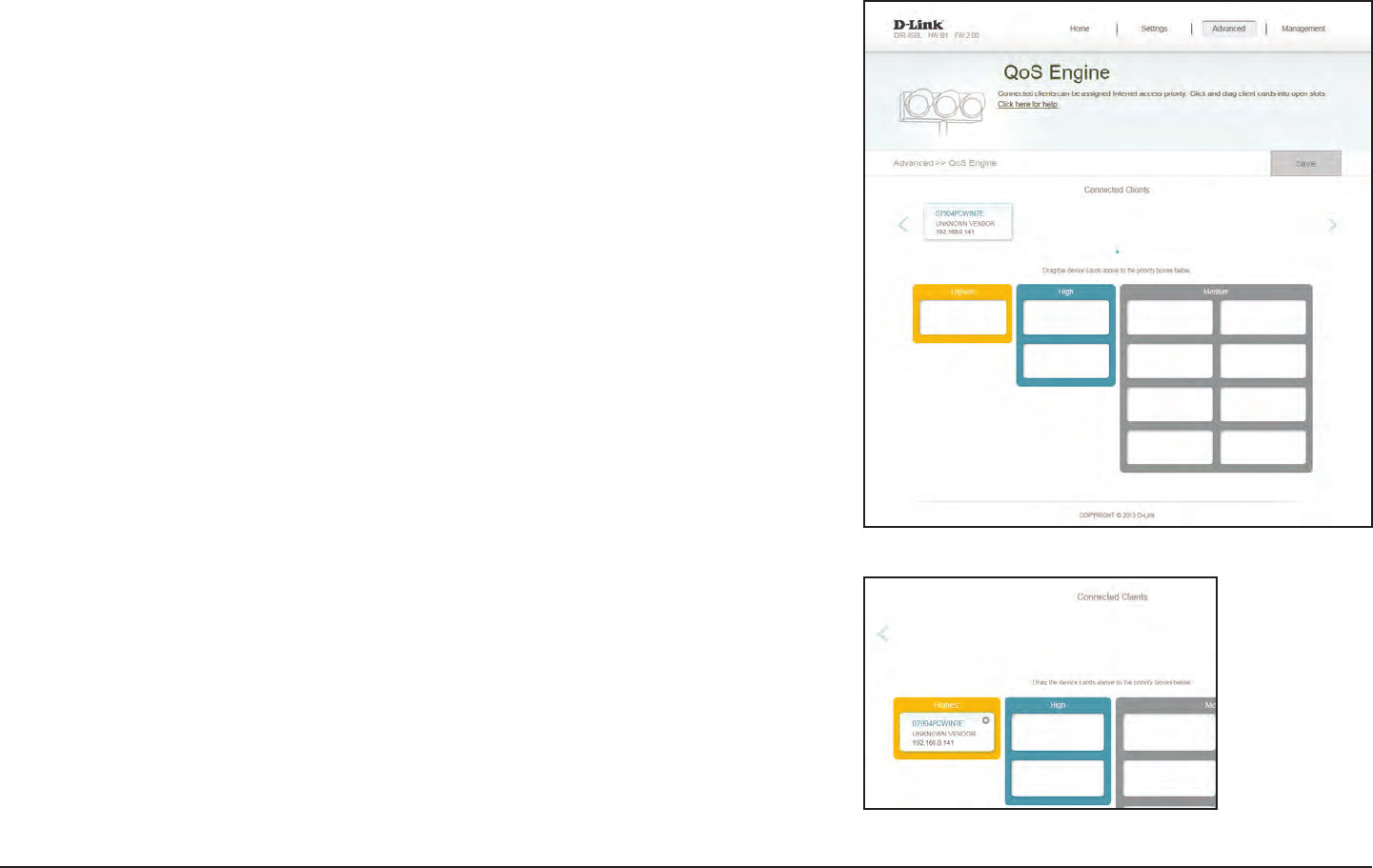
100D-Link DIR-850L User Manual
Section 4 - Conguration
Advanced
QoS Engine
This section will allow you to prioritize particular clients over others, so that those
clients receive higher bandwidth. For example, if one client is streaming a movie
and another is downloading a non-urgent le, you might wish to assign the former
device a higher priority than the latter so that the movie streaming is not disrupted
by the trac of the other devices on the network.
In the Advanced menu on the bar on the top of the page, click QoS Engine.
Under All Devices, you will see device cards representing each connected client. If
some are o-screen, you can use the < and > buttons to scroll through the cards.
A maximum of one device can be assigned Highest priority.
A maximum of two devices can be assigned High priority.
A maximum of eight devices can be assigned Medium priority.
If no devices are explicitly assigned a priority, they will all be treated with equal
priority. If some devices are not assigned a priority and others are, the unassigned
devices will be treated with the lowest priority.
To assign a priority level to a device, drag the device card from the All Devices list
over an empty slot and release the mouse button. The card will remain in the slot.
If you want to remove a priority assignment from a device and return it to the All
Devices list, click the cross icon in the top right of the device card.
Click Save when you are done.
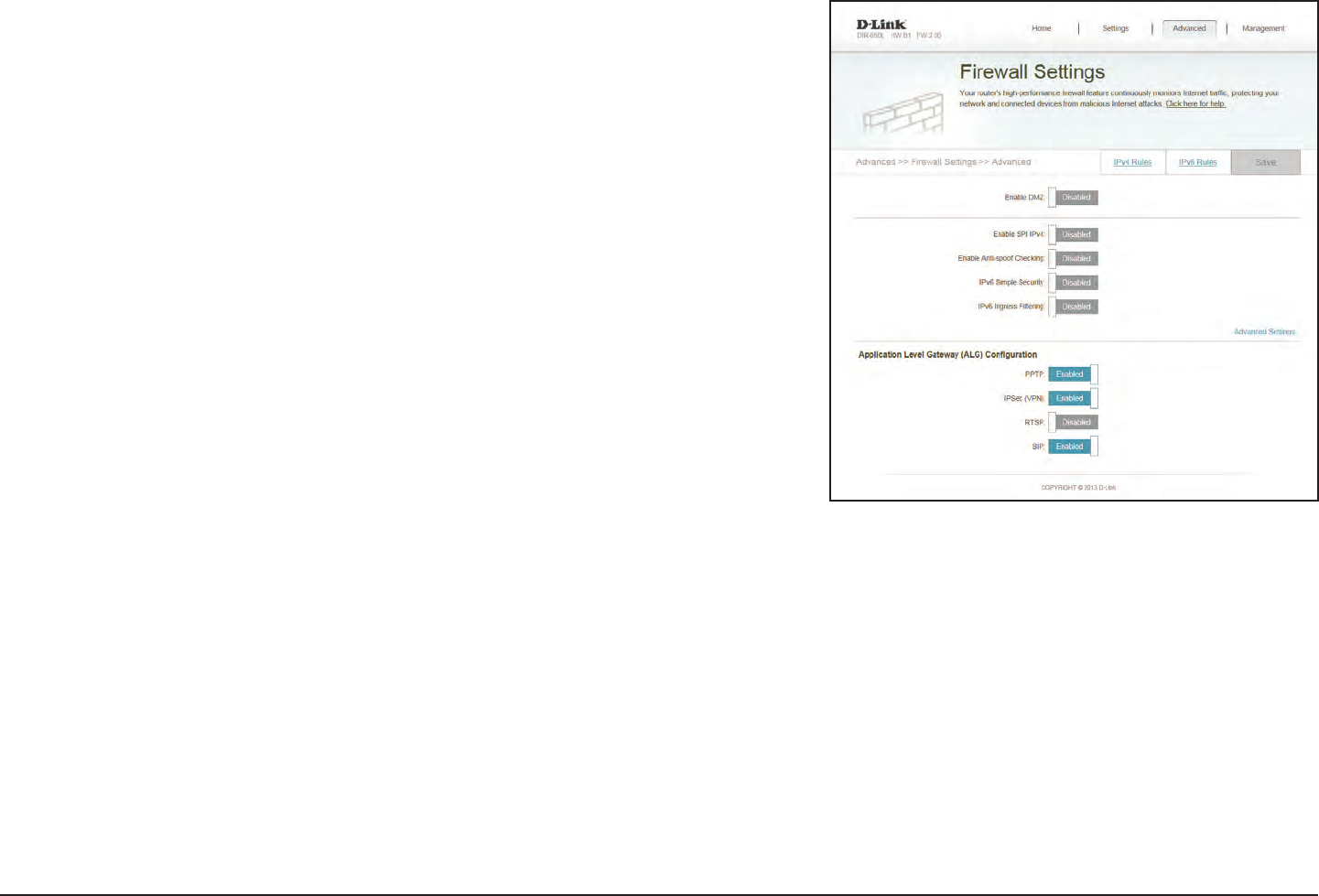
101D-Link DIR-850L User Manual
Section 4 - Conguration
Firewall
Enable or disable Demilitarized Zone (DMZ). This completely exposes
the client to threats over the Internet, and is not recommended in
ordinary situations.
If you enabled DMZ, enter the IP address of the client you wish to
expose, or use the drop-down menu to quickly select it.
Enabling Stateful Packet Inspection (SPI) helps to prevent cyber
attacks by validating that the trac passing through the session
conforms to the protocol.
Enable this feature to protect your network from certain kinds of
“spoong” attacks.
Enable or disable IPv6 simple security.
Enable or disable IPv6 ingress ltering.
Allows multiple machines on the LAN to connect to their corporate
network using the PPTP protocol.
Enable DMZ:
DMZ IP
Address:
Enable SPI IPv4:
Enable
Anti-Spoof
Checking:
IPv6 Simple
Security:
IPv6 Ingress
Filtering:
PPTP:
The router’s rewall protects your network from malicious attacks over the Internet.
In the Advanced menu on the bar on the top of the page, click Firewall Settings.
Click Advanced Settings... to expand the list and see all of the options.
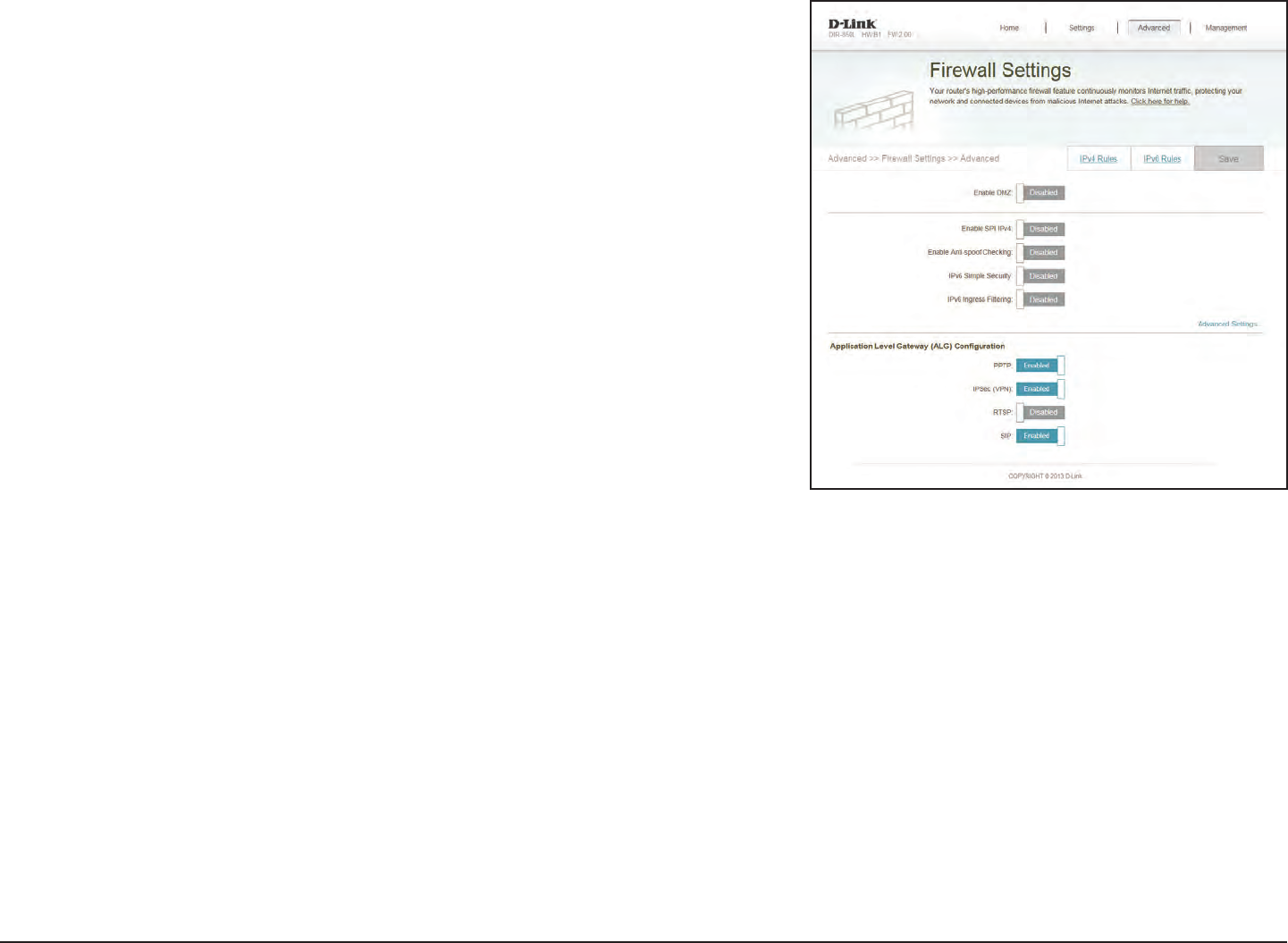
102D-Link DIR-850L User Manual
Section 4 - Conguration
Allows multiple VPN clients to connect to their corporate network
using IPSec. Some VPN clients support traversal of IPSec through
NAT. This Application Level Gateway (ALG) may interfere with the
operation of such VPN clients. If you are having trouble connecting
with your corporate network, try turning this ALG o. Please check
with the system administrator of your corporate network whether
your VPN client supports NAT traversal.
Allows applications that uses Real Time Streaming Protocol (RTSP)
to receive streaming media from the Internet.
Allows devices and applications using VoIP (Voice over IP) to
communicate across NAT. Some VoIP applications and devices have
the ability to discover NAT devices and work around them. This ALG
may interfere with the operation of such devices. If you are having
trouble making VoIP calls, try turning this ALG o.
Click Save when you are done.
IPSec (VPN):
RTSP:
SIP:
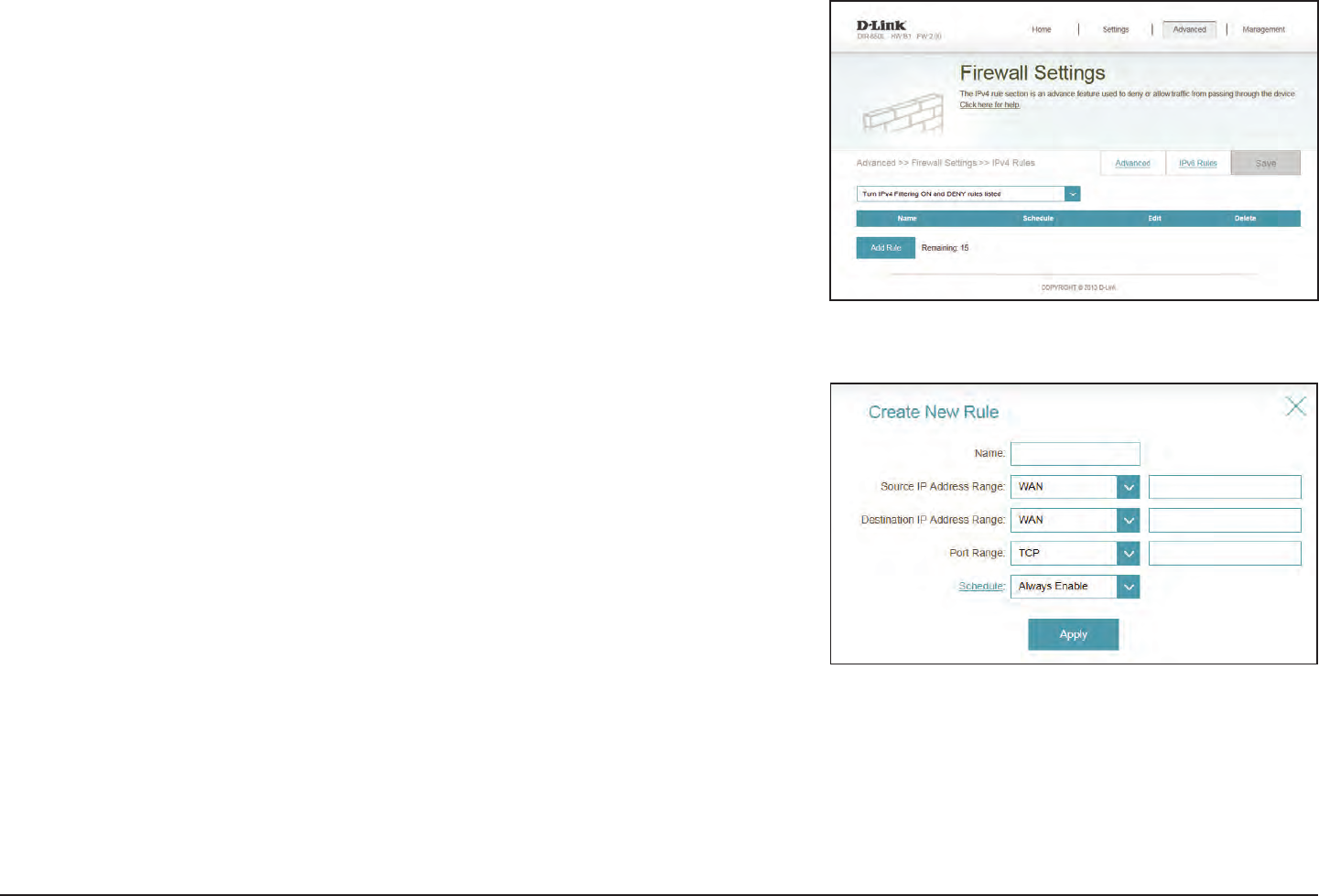
103D-Link DIR-850L User Manual
Section 4 - Conguration
IPv4/IPv6 Rules
Enter a name for the rule.
Enter the source IP address range that the rule will apply to, and using
the drop-down menu, specify whether it is a WAN or LAN IP address.
Enter the destination IP address range that the rule will apply to, and
using the drop-down menu, specify whether it is a WAN or LAN IP
address.
Select the protocol of the trac to allow or deny (Any, TCP, or UDP)
and then enter the range of ports that the rule will apply to.
Use the drop-down menu to select the time schedule that the rule
will be enabled on. The schedule may be set to Always Enable, or
you can create your own schedules in the Schedules section (refer
to page 88).
Click Apply when you are done.
The IPv4/IPv6 Rules section is an advanced option that lets you congure what kind
of trac is allowed to pass through the network. To congure the IPv4 rules, from
the Firewall Settings page click IPv4 Rules. To congure IPv6 rules, from the Firewall
Settings page click IPv6 Rules. To return to the main Firewall Settings page, click
Security Check.
To begin, use the drop-down menu to select whether you want to ALLOW or DENY
the rules you create. You can also choose to turn ltering OFF.
If you wish to remove a rule, click on its trash can icon in the Delete column. If you
wish to edit a rule, click on its pencil icon in the Edit column. If you wish to create a
new rule, click the Add Rule button. Click Save when you are done. If you edit or
create a rule, the following options will appear:
Name:
Source IP
Address Range:
Destination IP
Address Range:
Port Range:
Schedule:
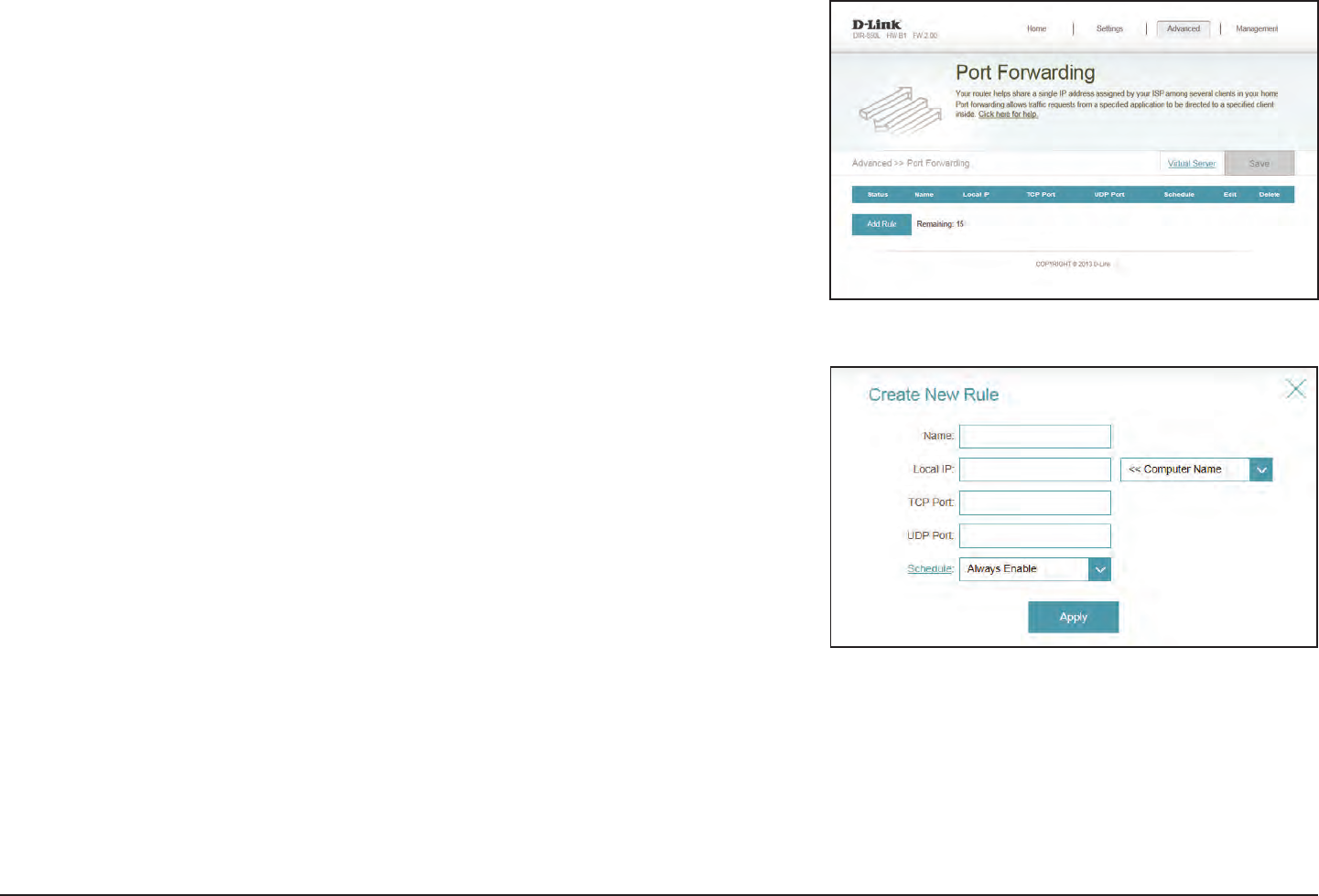
104D-Link DIR-850L User Manual
Section 4 - Conguration
Port Forwarding
Enter a name for the rule.
Enter the IP address of the computer on your local network that you
want to allow the incoming service to. Alternatively, select the device
from the drop-down menu.
Enter the TCP ports that you want to open. You can enter a single
port or a range of ports. Separate ports with a comma (for example:
24,1009,3000-4000).
Enter the UDP ports that you want to open. You can enter a single
port or a range of ports. Separate ports with a comma (for example:
24,1009,3000-4000).
Use the drop-down menu to select the time schedule that the rule
will be enabled on. The schedule may be set to Always Enable, or
you can create your own schedules in the Schedules section (refer
to page 88).
Click Apply when you are done.
Name:
Local IP:
TCP Port:
UDP Port:
Schedule:
Port forwarding allows you to specify a port or range of ports to open for specic
devices on the network. This might be necessary for certain applications to connect
through the router. In the Advanced menu on the bar on the top of the page, click
Port Forwarding.
If you wish to remove a rule, click on its trash can icon in the Delete column. If you
wish to edit a rule, click on its pencil icon in the Edit column. If you wish to create
a new rule, click the Add Rule button. Click Save when you are done. If you edit or
create a rule, the following options will appear:
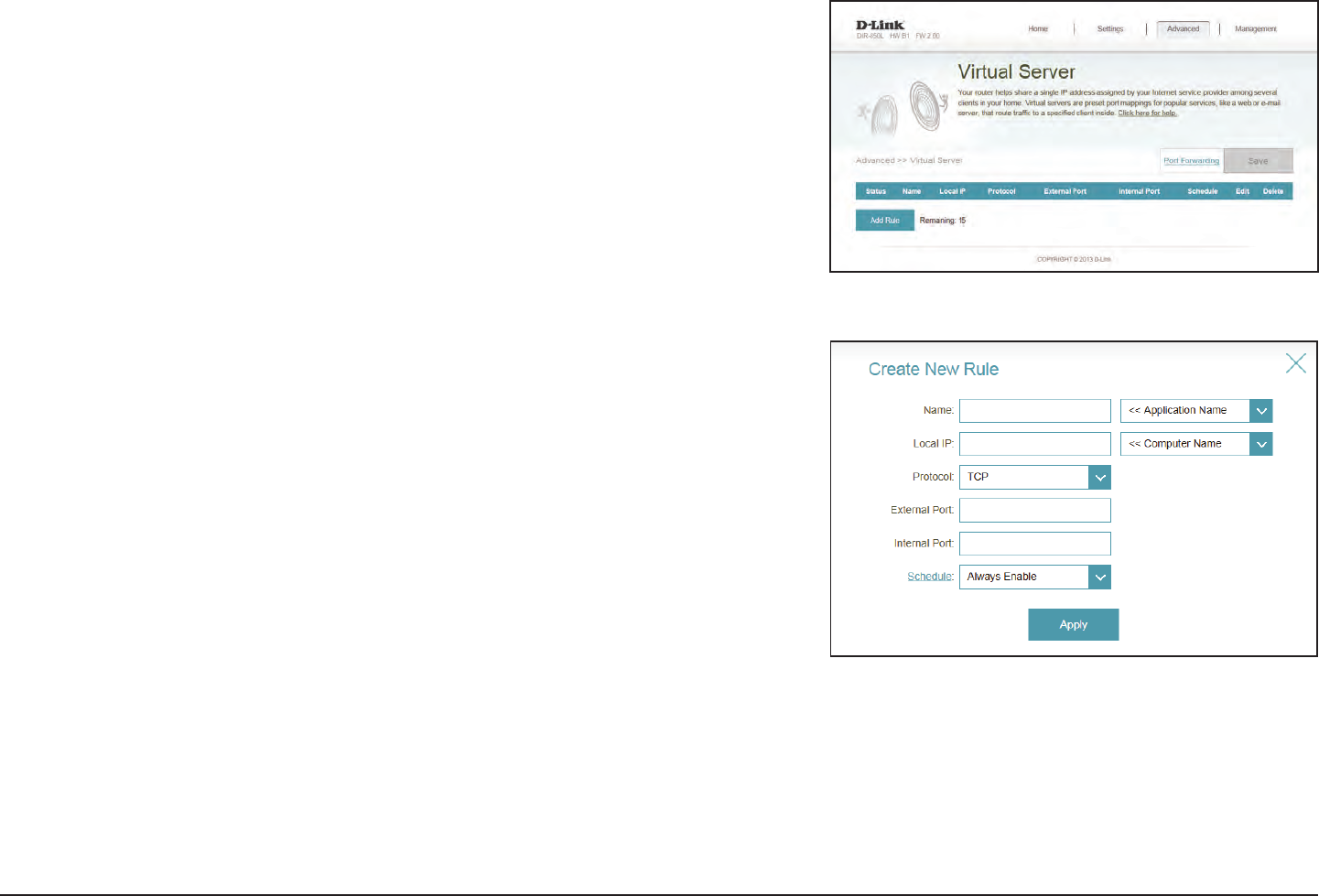
105D-Link DIR-850L User Manual
Section 4 - Conguration
Virtual Server
Enter a name for the rule.
Enter the IP address of the computer on your local network that you
want to allow the incoming service to. Alternatively, select the device
from the drop-down menu.
Select the protocol of the trac to allow or deny (TCP, UDP, Both,
or Other).
If you entered Other above, enter the protocol number.
Enter the public port you want to open.
Enter the private port you want to open.
Use the drop-down menu to select the time schedule that the rule
will be enabled on. The schedule may be set to Always Enable, or
you can create your own schedules in the Schedules section (refer
to page 88).
Click Apply when you are done.
The virtual server allows you to specify a single public port on your router for
redirection to an internal LAN IP Address and Private LAN port. To congure the
virtual server, from the Port Forwarding page click Virtual Server. To return to the
main Port Forwarding page, click Port Forwarding.
If you wish to remove a rule, click on its trash can icon in the Delete column. If you
wish to edit a rule, click on its pencil icon in the Edit column. If you wish to create
a new rule, click the Add Rule button. Click Save when you are done. If you edit or
create a rule, the following options will appear:
Name:
Local IP:
Protocol:
Protocol
Number:
External Port:
Internal Port:
Schedule:
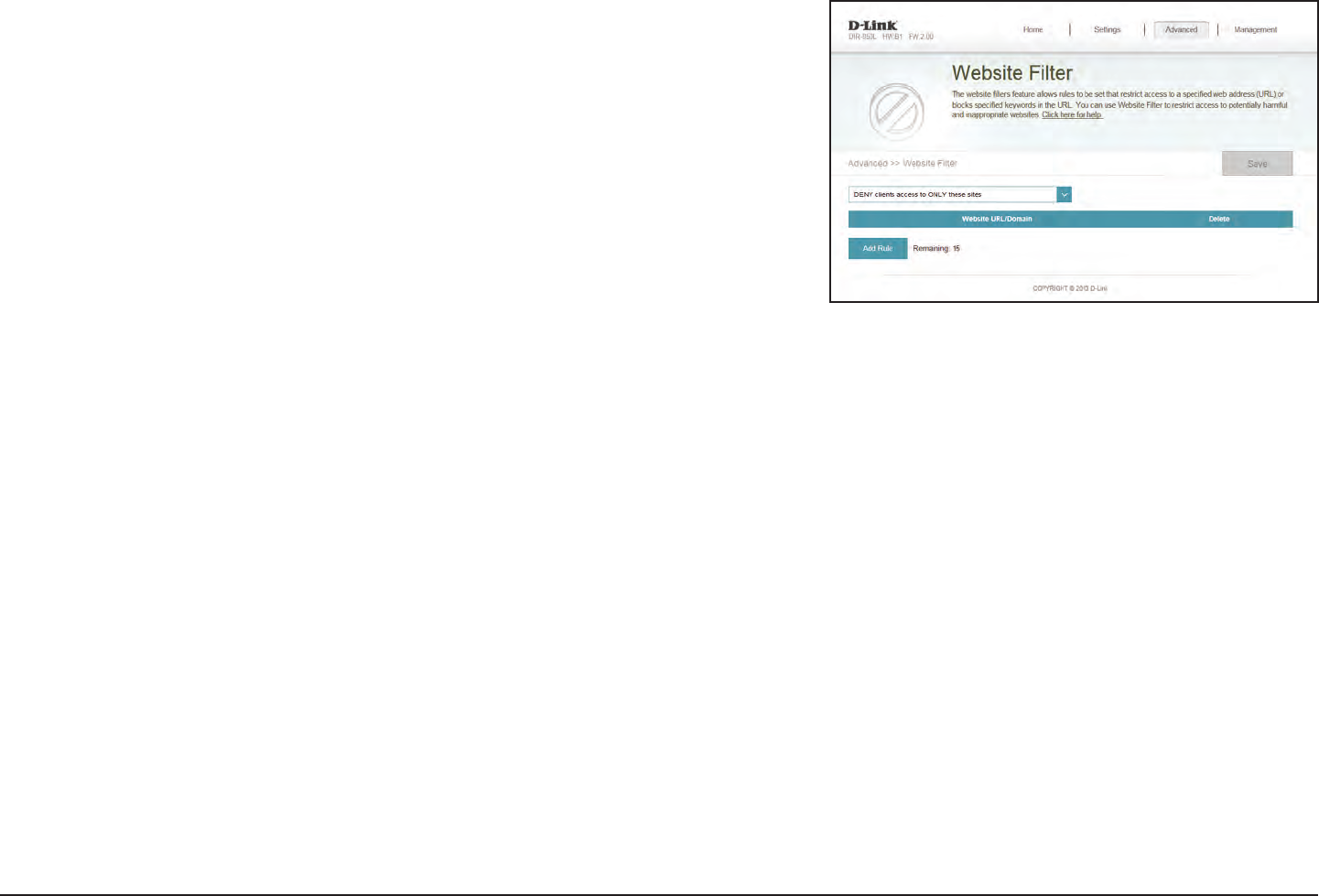
106D-Link DIR-850L User Manual
Section 4 - Conguration
Website Filter
The website lter settings allow you to block access to certain web sites. You can
either create a list of sites to block, or create a list of sites to allow (with all other sites
being blocked).
In the Advanced menu on the bar on the top of the page, click Website Filter.
If you want to create a list of sites to block, select DENY clients access to ONLY
these sites from the drop-down menu. All other sites will be accessible. If you want
to specify a list of sites to allow, select ALLOW clients access to ONLY these sites
from the drop-down menu. All other sites will be blocked.
You may specify a maximum of fteen web sites. To add a new site to the list, click
Add Rule. Next, under Website URL/Domain enter the URL or domain. If you wish
to remove a rule, click on its trash can icon in the Delete column. If you wish to edit
a rule, simply replace the URL or domain.
Click Save when you are done.
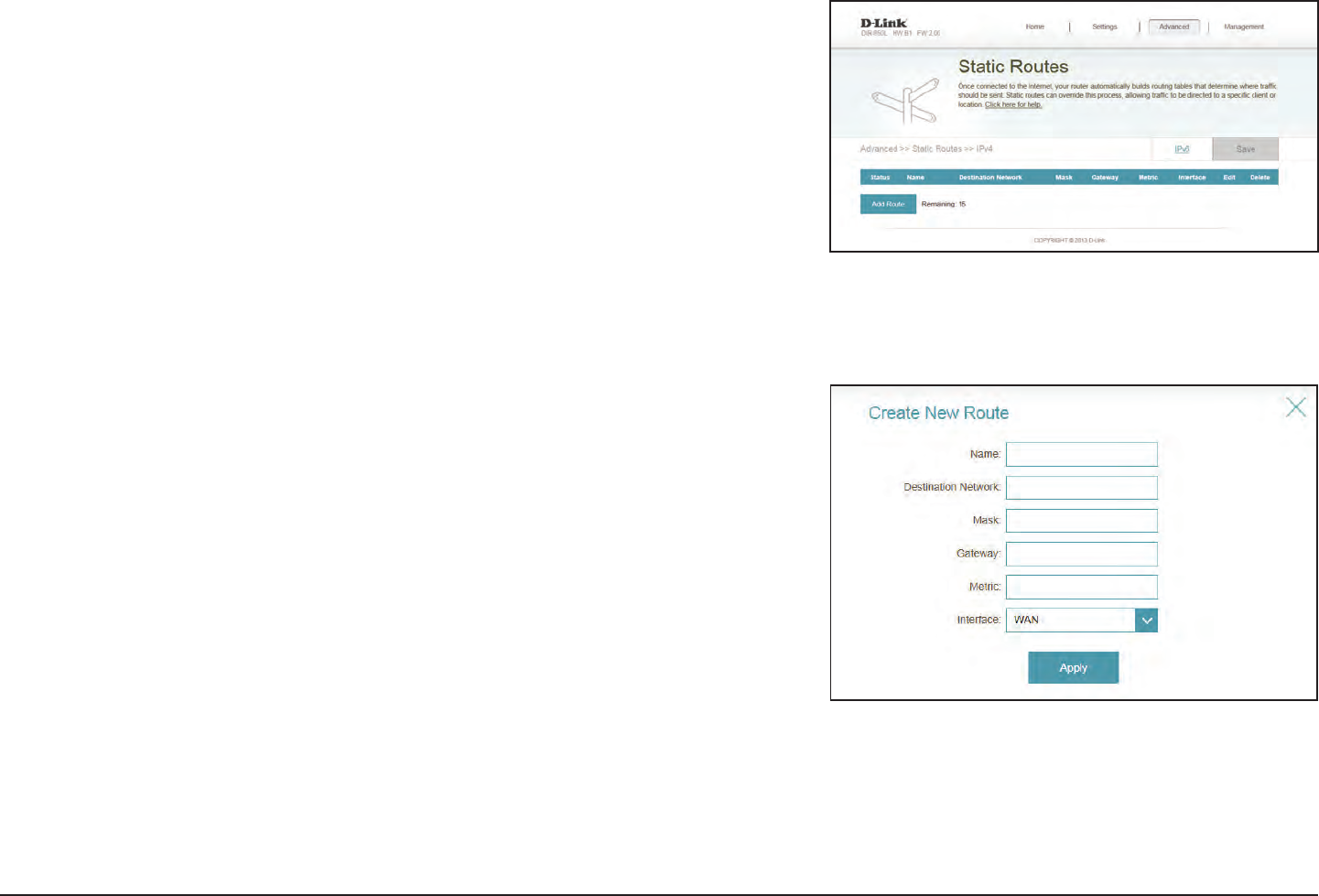
107D-Link DIR-850L User Manual
Section 4 - Conguration
Static Route
Enter a name for the rule.
Enter the IP address of packets that will take this route.
Enter the netmask of the route.
Enter your next hop gateway to be taken if this route is used.
The route metric is a value from 1 to 16 that indicates the cost of
using this route. A value 1 is the lowest cost and 15 is the highest cost.
Select the interface that the IP packet must use to transit out of the
router when this route is used.
Click Apply when you are done.
The Static Routes section allows you to dene custom routes to control how data
trac is moved around your network.
In the Advanced menu on the bar on the top of the page, click Static Routes.
To congure IPv6 rules, click IPv6 and refer to page 82. To return to the main IPv4 static
routes page, click IPv4.
If you wish to remove a rule, click on its trash can icon in the Delete column. If you
wish to edit a rule, click on its pencil icon in the Edit column. If you wish to create a
new rule, click the Add Rule button. Click Save when you are done. If you edit or
create a rule, the following options will appear:
Name:
Destination IP:
Mask:
Gateway:
Metric:
Interface:
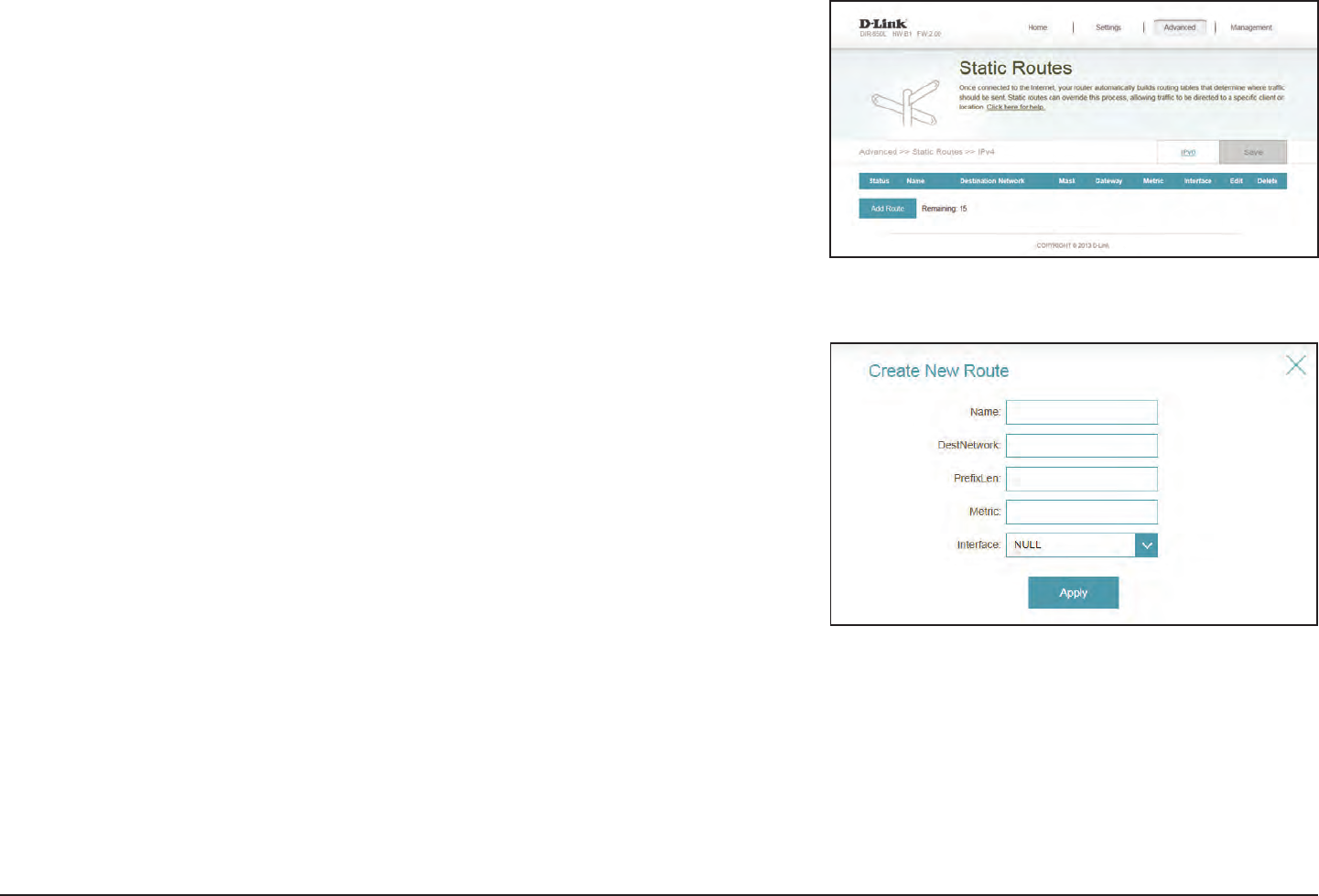
108D-Link DIR-850L User Manual
Section 4 - Conguration
Enter a name for the rule.
This is the IP address of the router used to reach the specied
destination.
Enter the IPv6 address prex length of the packets that will take this
route.
Enter the metric value for this rule here.
Select the interface that the IP packet must use to transit out of the
router when this route is used.
Click Apply when you are done.
Name:
DestNetwork:
PrexLen:
Metric:
Interface:
IPv6
To congure IPv6 rules, on the Static Routes page click IPv6. To return to the main
IPv4 static routes page, click IPv4.
If you wish to remove a rule, click on its trash can icon in the Delete column. If you
wish to edit a rule, click on its pencil icon in the Edit column. If you wish to create a
new rule, click the Add Rule button. Click Save when you are done. If you edit or
create a rule, the following options will appear:
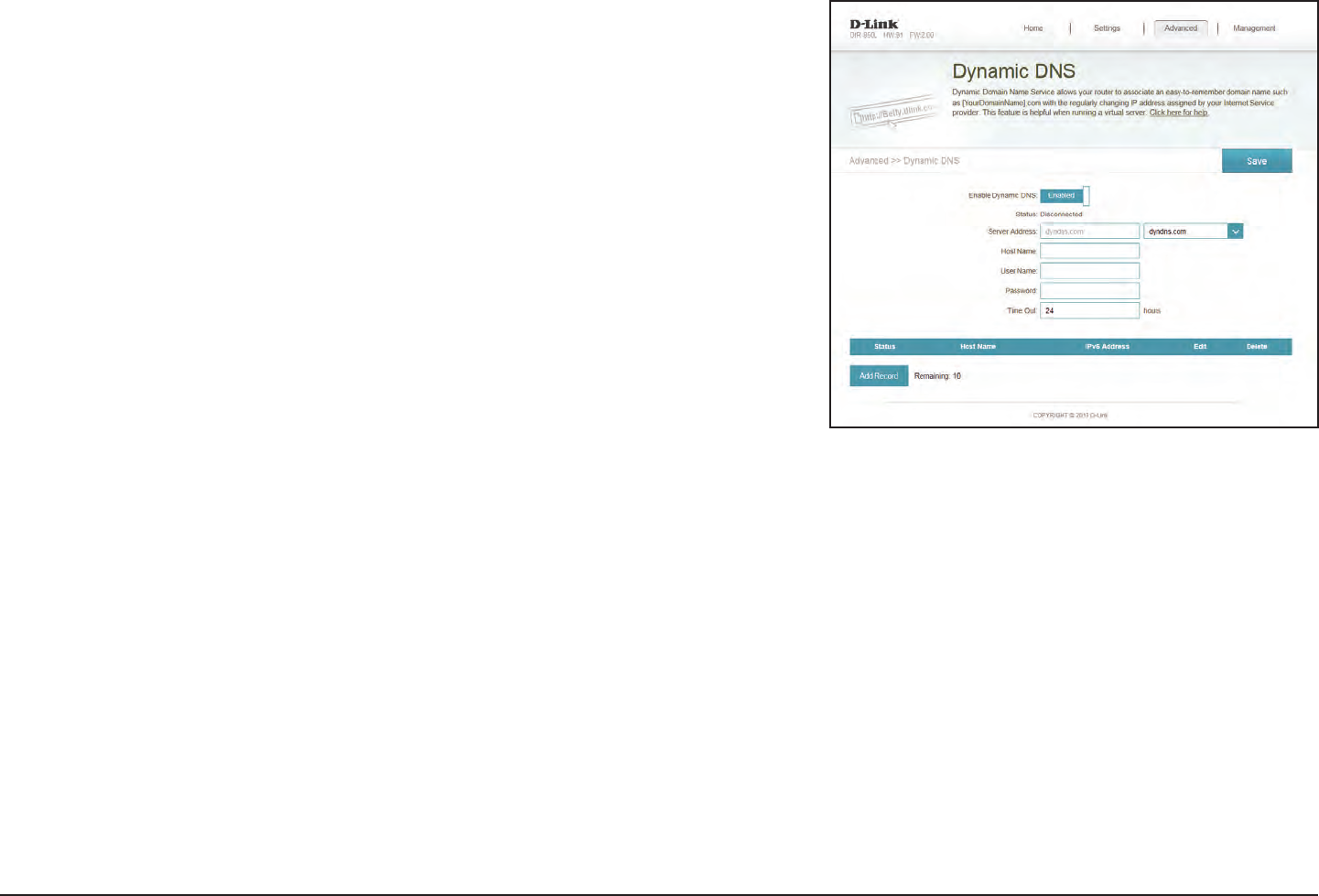
109D-Link DIR-850L User Manual
Section 4 - Conguration
Dynamic DNS
Most Internet Service Providers (ISPs) assign dynamic (changing) IP addresses. Using
a dynamic DNS service provider, people can enter your domain name in their web
browser to connect to your server no matter what your IP address is.
In the Advanced menu on the bar on the top of the page, click Dynamic DNS.
Enabling dynamic DNS will reveal further conguration options.
Displays the current dynamic DNS connection status.
Enter the address of your dynamic DNS server, or select one from
the drop-down menu.
Enter the host name that you registered with your dynamic DNS
service provider.
Enter your dynamic DNS username.
Enter your dynamic DNS password.
Enter a timeout time (in hours).
Click Save when you are done.
Enable
Dynamic DNS:
Status:
Server Address:
Host Name:
User Name:
Password:
Time Out:
At the bottom of the page are the IPv6 host settings. To congure an IPv6 dynamic
DNS host, refer to page 86.
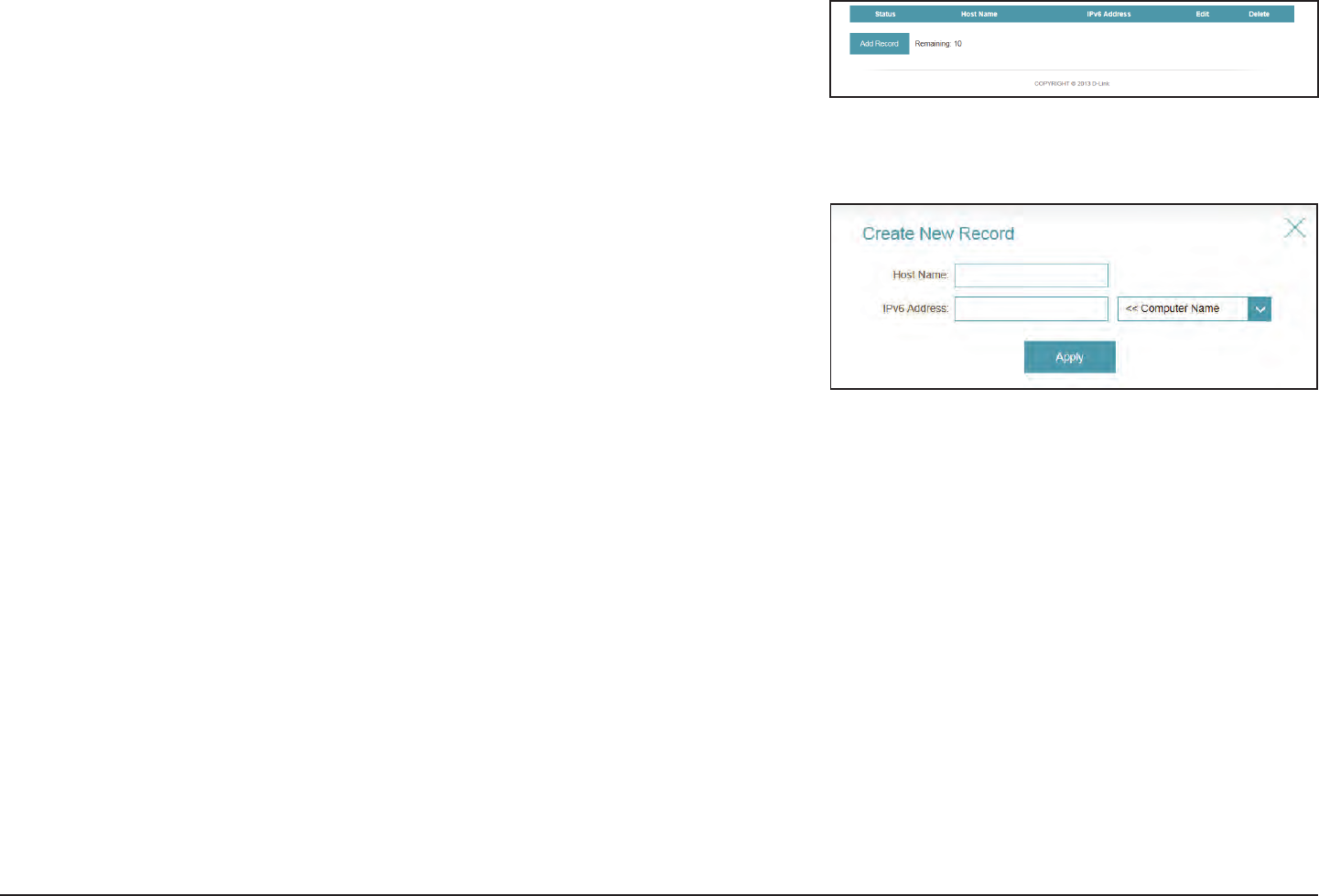
110D-Link DIR-850L User Manual
Section 4 - Conguration
Enter the host name that you registered with your dynamic DNS
service provider.
Enter the IPv6 address of the dynamic DNS server. Alternatively, select
the server device in the drop-down menu.
Click Apply when you are done.
Host Name:
IPv6 Address:
The IPv6 host settings are found at the bottom of the Dynamic DNS page.
If you wish to remove a rule, click on its trash can icon in the Delete column. If you
wish to edit a rule, click on its pencil icon in the Edit column. If you wish to create a
new rule, click the Add Record button. Click Save when you are done. If you edit or
create a rule, the following options will appear:
IPv6 Host
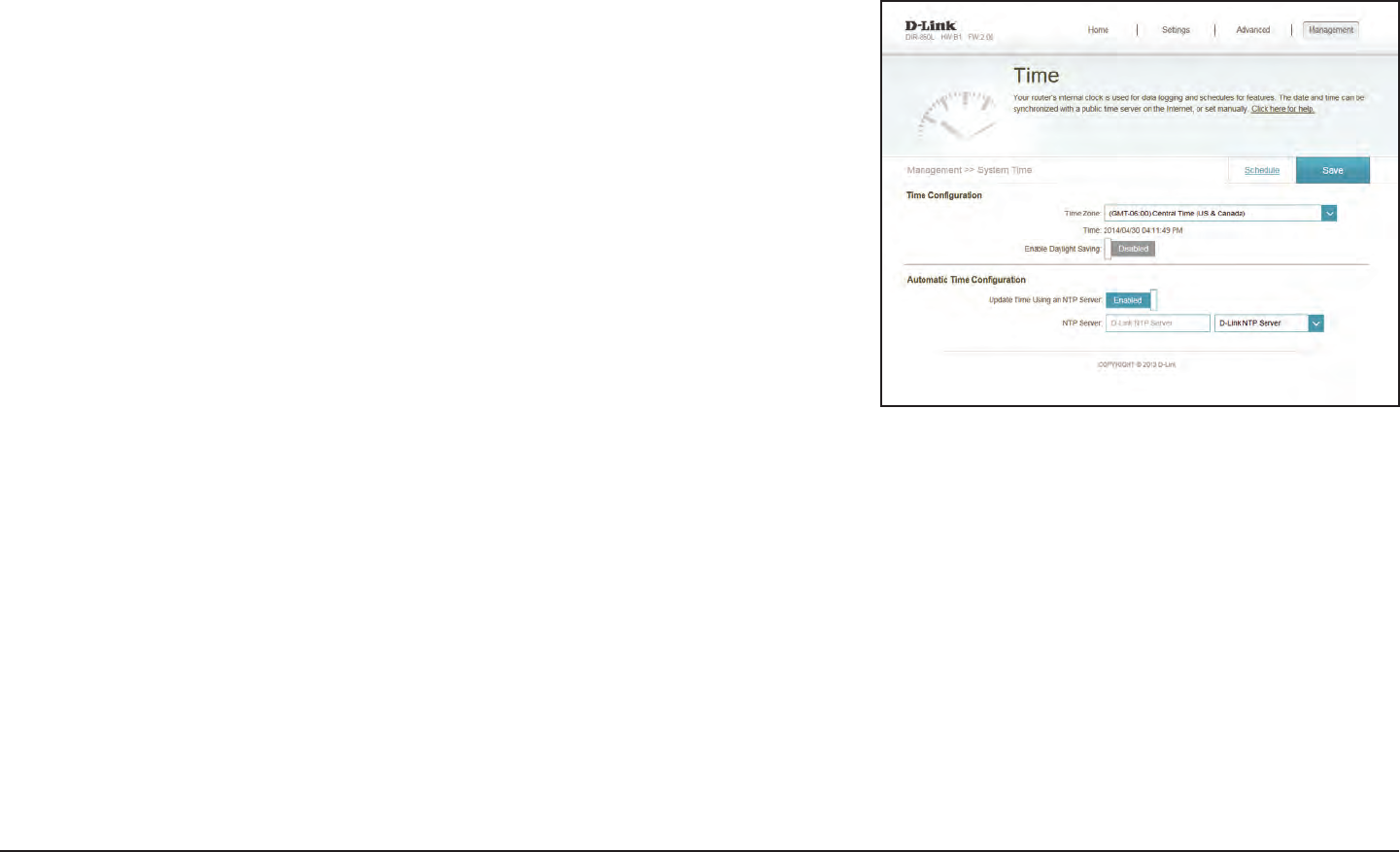
111D-Link DIR-850L User Manual
Section 4 - Conguration
Management
Time & Schedule
Time
The Time page allows you to congure, update, and maintain the correct time on
the internal system clock. From here you can set the time zone, the Network Time
Protocol (NTP) server, and enable or disable daylight saving time.
In the Management menu on the bar on the top of the page, click Time & Schedule.
Select your time zone from the drop-down menu.
Displays the current date and time of the router.
Enable or disable daylight saving time.
Enable or disable to allow an NTP server on the Internet to synchronize
the time and date with your router. If you enable this option, select
an NTP server from the drop-down menu. To congure the router’s
time and date manually, disable this option and use the drop-down
menus that appear to input the time and date.
Click Save when you are done.
Time Zone:
Time:
Daylight
Saving:
Update Time
Using an NTP
Server:
To congure and manage your schedules, click Schedule and refer to page 88.
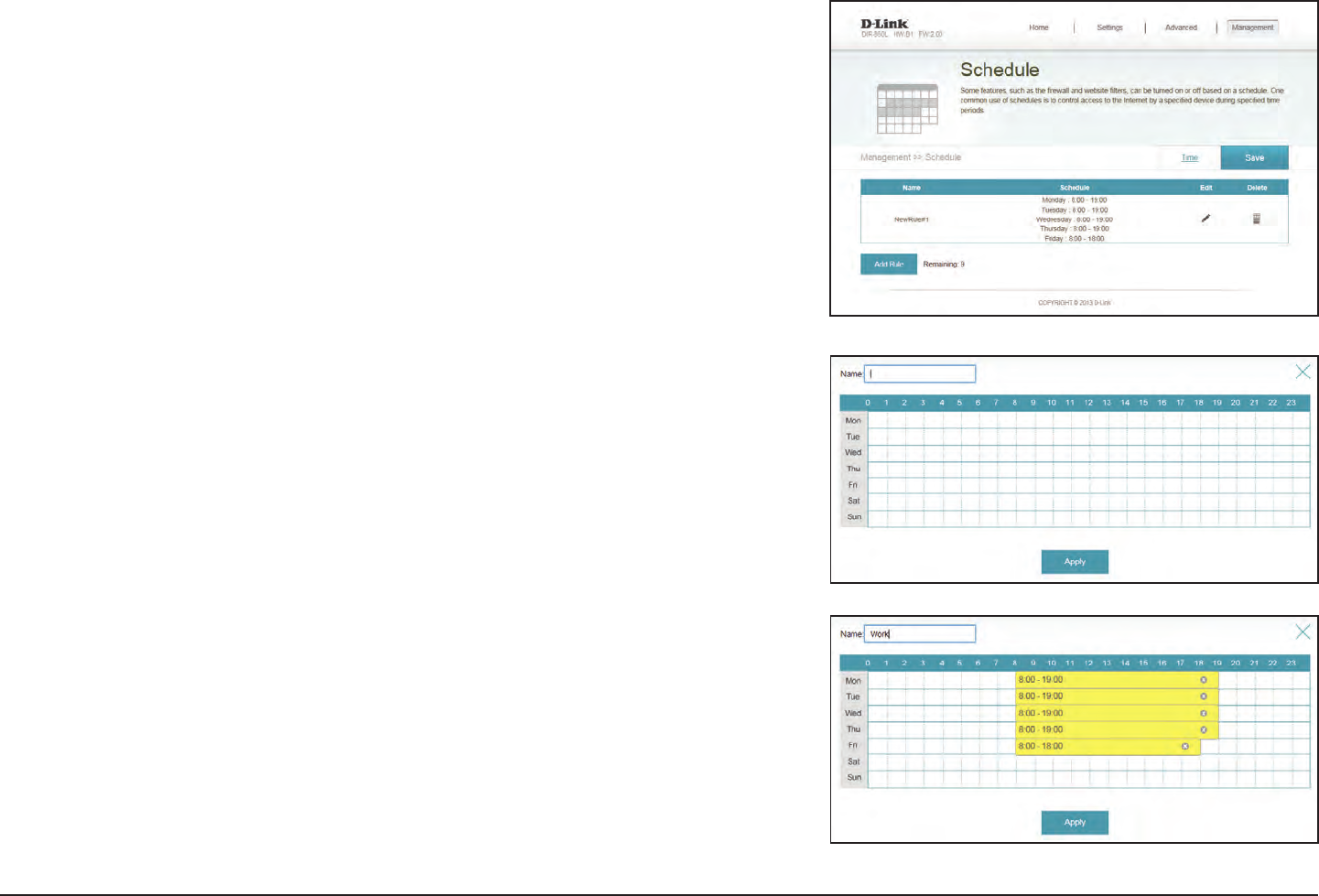
112D-Link DIR-850L User Manual
Section 4 - Conguration
Schedule
Some conguration rules can be set according to a pre-congured schedule. To
create, edit, or delete schedules, from the Time page click Schedule. To return to
the Time page, click Time.
If you wish to remove a rule, click on its trash can icon in the Delete column. If you
wish to edit a rule, click on its pencil icon in the Edit column. If you wish to create
a new rule, click the Add Rule button. Click Save when you are done. If you edit or
create a rule, the following screen will appear:
First, enter the name of your schedule in the Name eld.
Each box represents one hour, with the time at the top of each column. To add a time
period to the schedule, simply click on the start hour and drag to the end hour. You
can add multiple days to the schedule, but only one period per day.
To remove a time period from the schedule, click on the cross icon.
Click Apply when you are done.
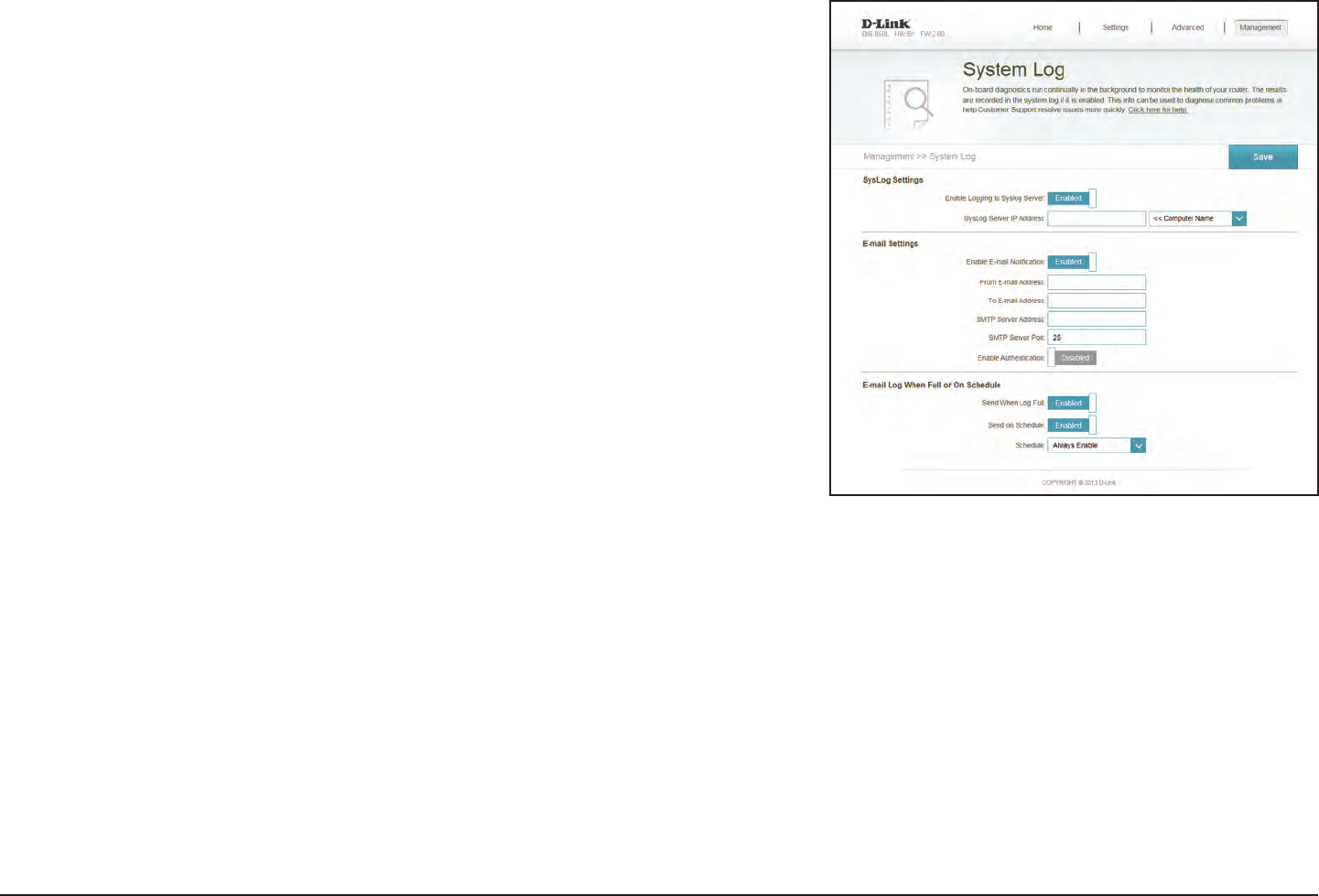
113D-Link DIR-850L User Manual
Section 4 - Conguration
System Log
Check this box to send the router logs to a SysLog server. If this is
disabled, there will be no other options on this page.
Enter the IP address for the Syslog server. If the Syslog server is
connected to the router, select it from the drop-down menu to
automatically populate the eld.
If you want the logs to be automatically sent to an email address,
enable this option.
Enter the settings for your email account. These are obtained from
your email service provider.
If email notication is enabled, this option will set the router to send
the log by email when the log is fully.
This option can be enabled to send an email according to a pre-
congured schedule. See below.
If you enable On Schedule is enabled, use the drop-down menu
to select the time schedule that the rule will be enabled on. The
schedule may be set to Always Enable, or you can create your own
schedules in the Schedules section (refer to page 112).
Click Save when you are done.
Enable Logging
to Syslog
Server:
Syslog Server IP
Address:
Enable Email
Notication:
Send When Log
Full:
Send On
Schedule:
Schedule:
The router keeps a running log of events. This log can be sent to a Syslog server, and
sent to your email address. In the Management menu on the bar on the top of the
page, click System Log.
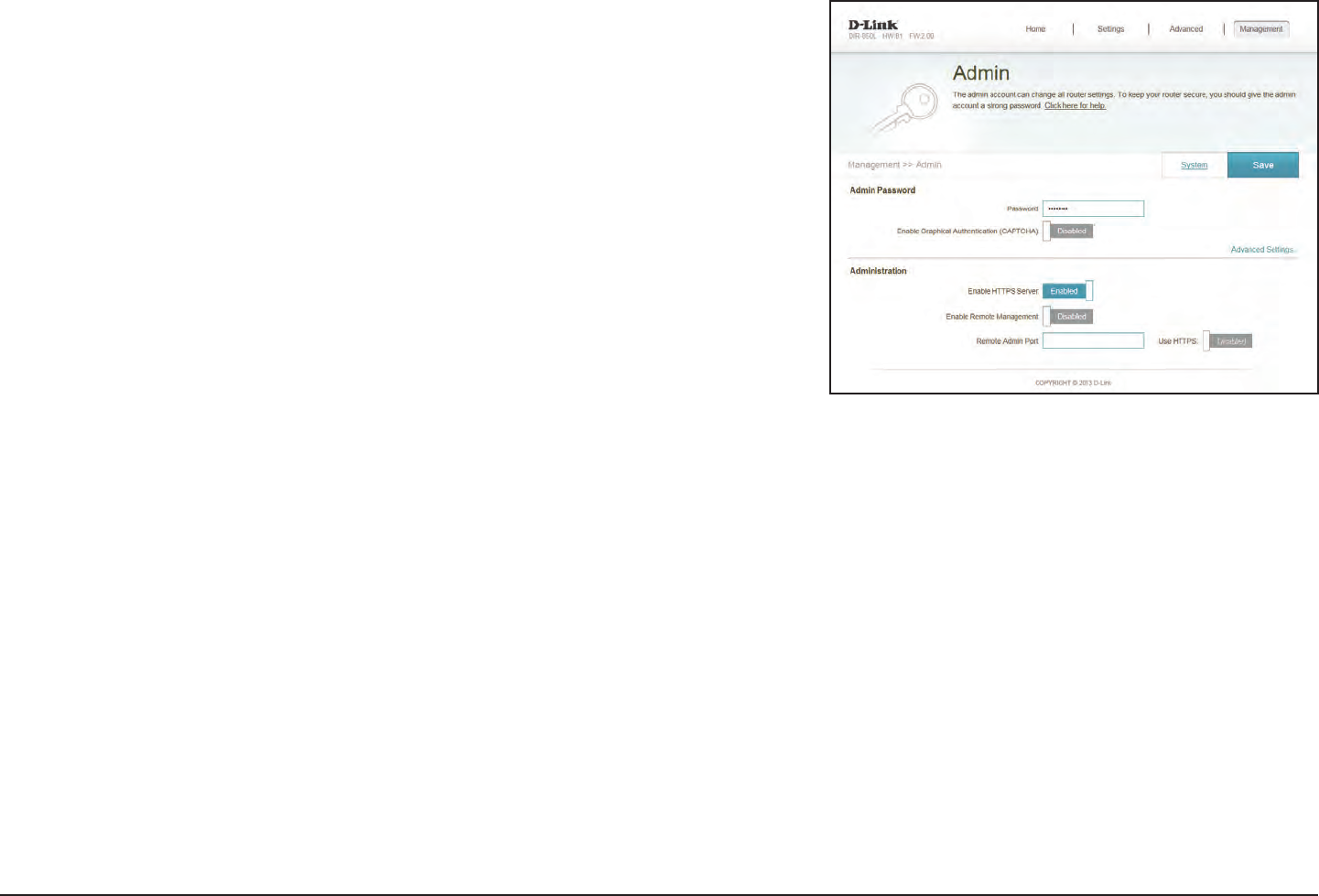
114D-Link DIR-850L User Manual
Section 4 - Conguration
Admin
This page will allow you to change the administrator (Admin) password and enable
remote management.
In the Management menu on the bar on the top of the page, click Admin.
Enter a new password for the administrator account. You will need to
enter this password whenever you congure the router using a web
browser.
Enables a challenge-response test to require users to type letters or
numbers from a distorted image displayed on the screen to prevent
online hackers and unauthorized users from gaining access to your
router’s network settings.
Check to enable HTTPS to connect to the router securely. This means
to connect to the router, you must enter https://192.168.0.1 instead
of http://192.168.0.1.
Remote management allows the DIR-850L to be congured from the
Internet by a web browser. A password is still required to access the web
management interface.
The port number used to access the DIR-850L is used in the URL.
Example: http://x.x.x.x:8080 where x.x.x.x is the Internet IP address
of the DIR-850L and 8080 is the port used for the web management
interface. If you enable Use HTTPS, you must enter https:// as part of
the URL to access the router remotely.
Click Save when you are done.
Password:
Enable
Graphical
Authentication
(CAPTCHA):
Enable HTTPS
Server:
Enable Remote
Management:
Remote Admin
Port:
To load, save, or reset settings, or reboot the router, click System and refer to page 115.
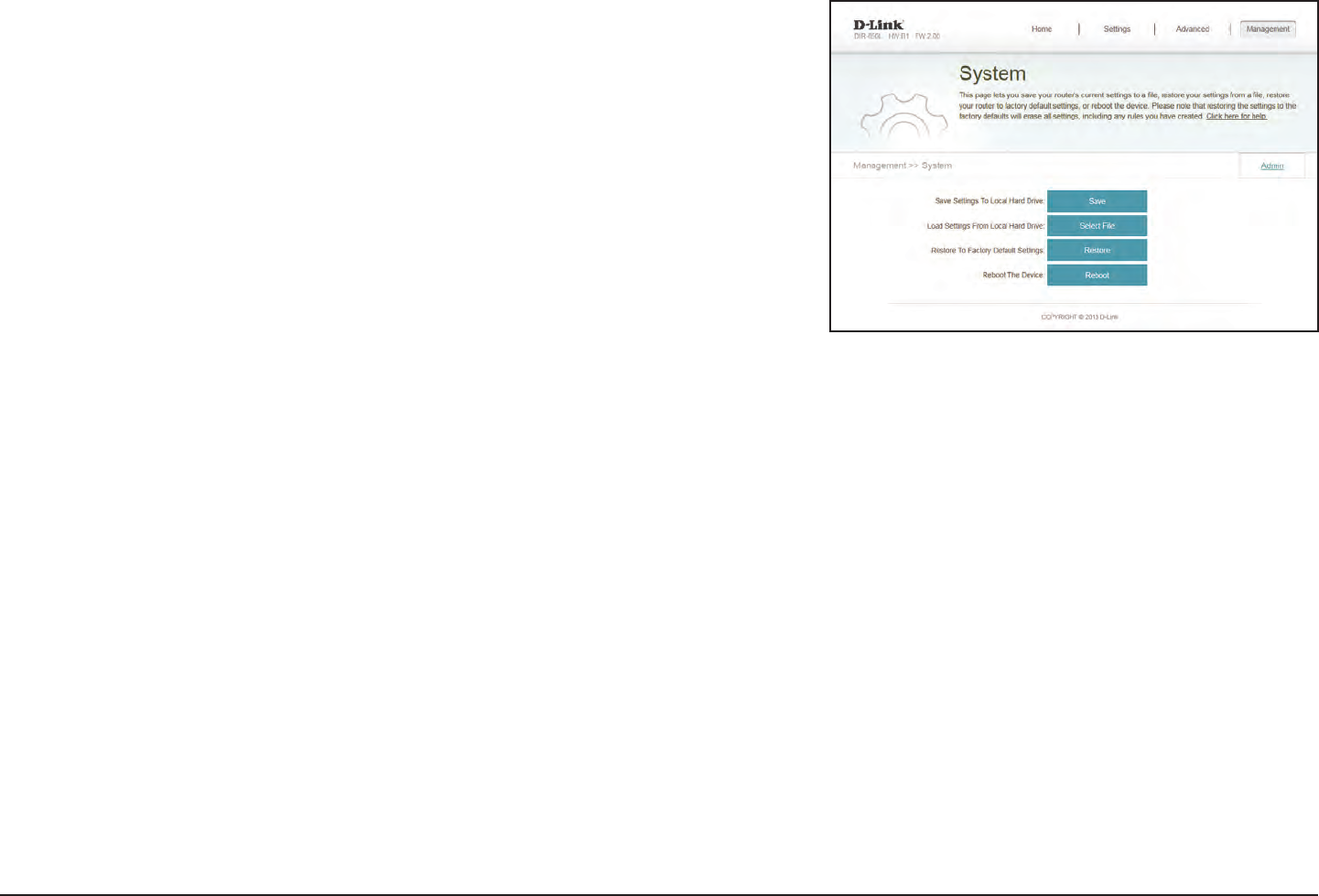
115D-Link DIR-850L User Manual
Section 4 - Conguration
System
This option will save the current router conguration settings to a le
on your computer.
This option will load previously saved router conguration le. This will
overwrite the router’s current conguration.
This option will restore all conguration settings back to the settings that
were in eect at the time the router was shipped from the factory. Any
settings that have not been saved will be lost, including any rules that
you have created. If you want to save the current router conguration
settings, use the Save Settings To Local Hard Drive button above.
Click to reboot the router.
Click Save when you are done.
Save Settings
To Local Hard
Drive:
Load Settings
From Local
Hard Drive:
Restore To
Factory Default
Settings:
Reboot The
Device:
This page allows you to save the router’s current conguration, load a previously saved
conguration, reset the router to its factory default settings, or reboot the router.
From the Admin page click System. To return to the Admin page, click Admin.
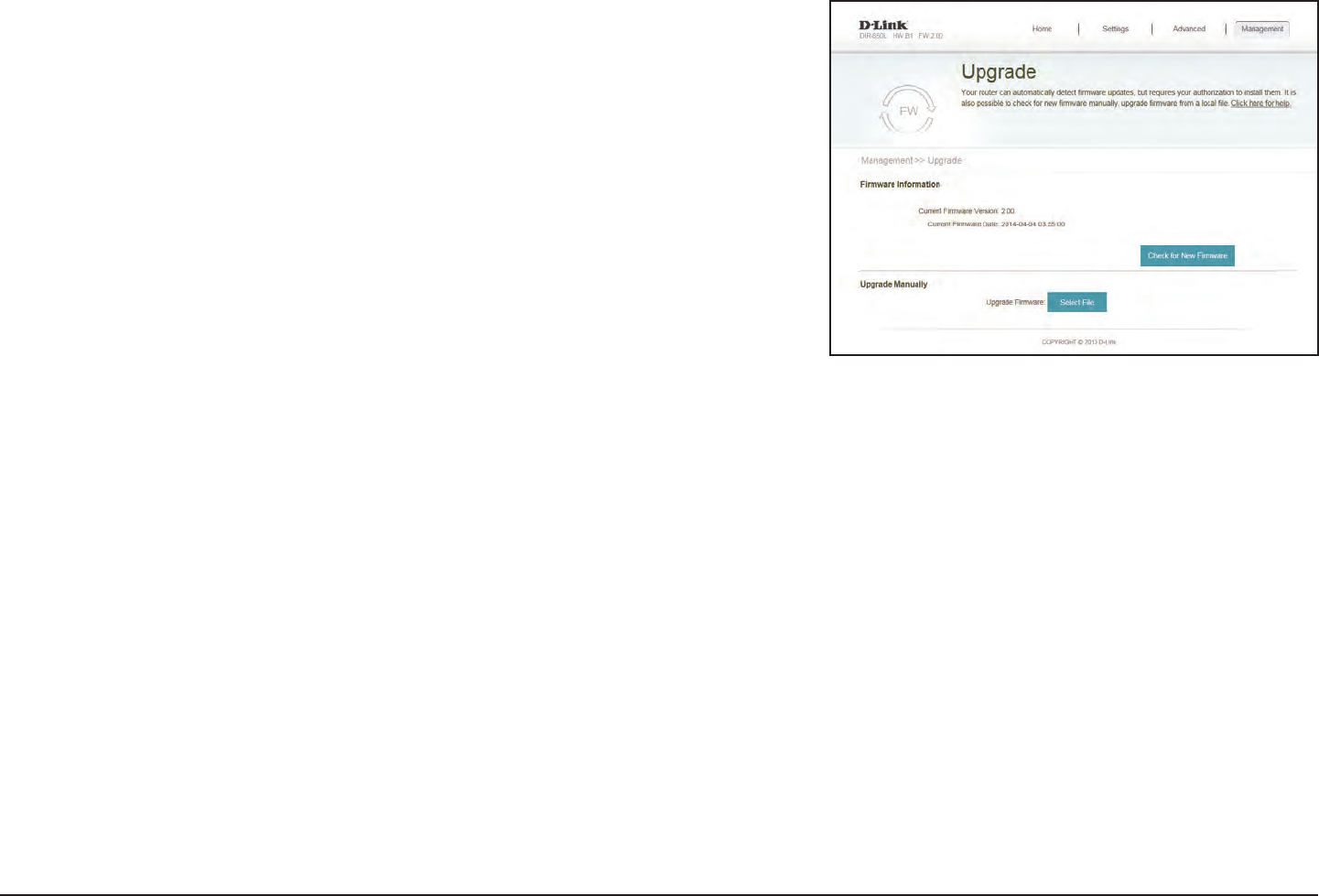
116D-Link DIR-850L User Manual
Section 4 - Conguration
Upgrade
This page will allow you to upgrade the router’s rmware or language pack, either
automatically or manually. To manually upgrade the rmware or language pack, you
must rst download the relevant le from http://support.dlink.com.
In the Management menu on the bar on the top of the page, click Upgrade.
The current rmware’s version and date will be displayed.
Click this button to prompt the router to automatically check for a new
rmware version. If a newer version is found, it will prompt you to install
it.
If you wish to upgrade manually, rst download the rmware le you
wish to upgrade to. Next, click the Select File button and browse to the
le to install the new rmware. You can also browse to a language pack
le to install a new language pack.
Firmware
Information:
Check for New
Firmware:
Upgrade
Firmware:
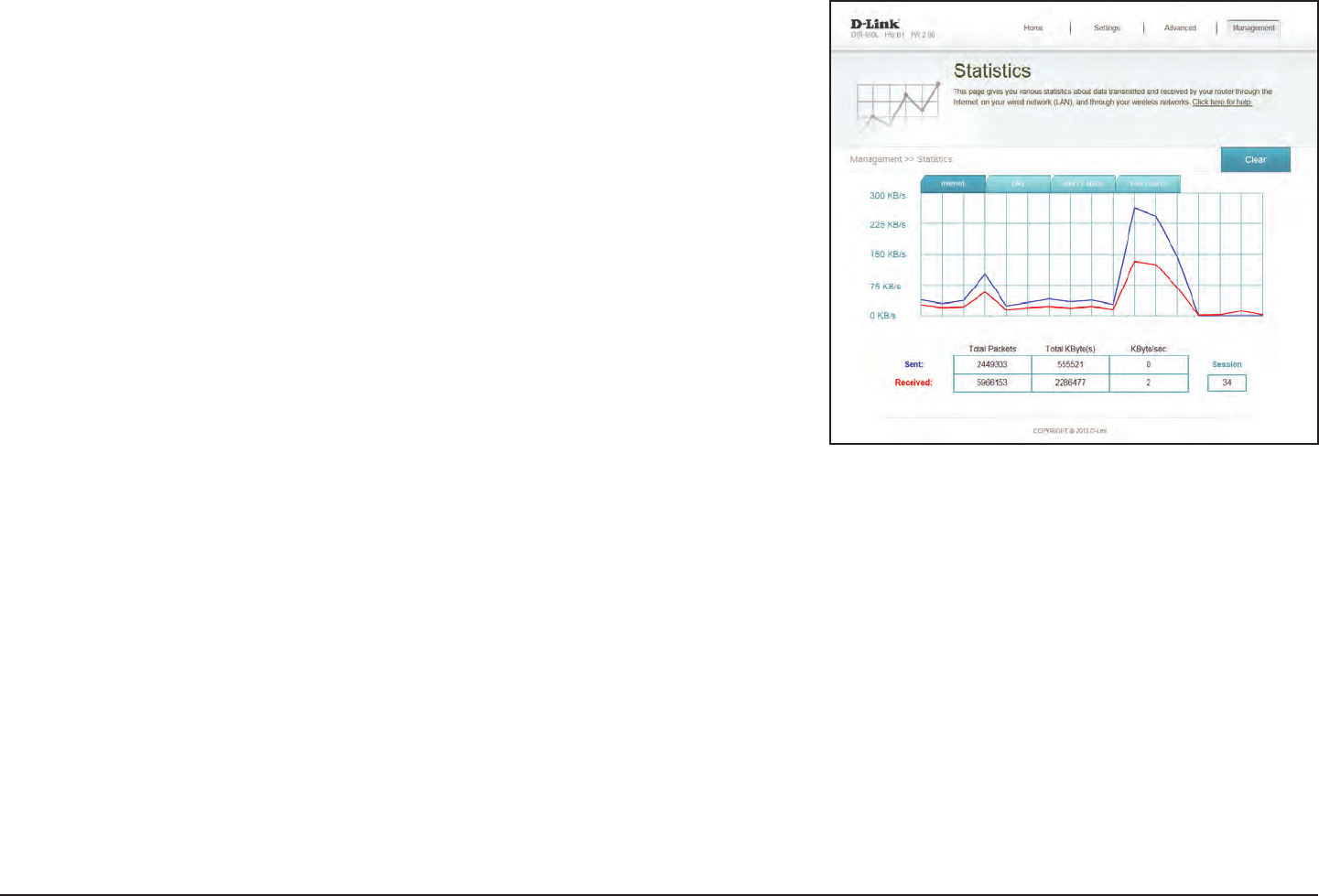
117D-Link DIR-850L User Manual
Section 4 - Conguration
Statistics
On the Statistics page you can view the amount of packets that pass through the router
on the WAN, LAN, and wireless segments.
In the Management menu on the bar on the top of the page, click Statistics.
You can view the Internet, LAN, Wi-Fi 2.4GHz, or Wi-Fi 5GHz by clicking on the
respective tabs at the top. The graph will update in real time. To clear the information
on the graph, click Clear.
The trac counter will reset if the device is rebooted.

118D-Link DIR-850L User Manual
Section 5 - Security
Connect a Wireless Client to your Router
WPS Button
Step 2 - Within 2 minutes, press the WPS button on your wireless client (or launch the software utility and start the WPS
process).
The easiest and most secure way to connect your wireless devices to the router is WPS (Wi-Fi Protected Setup). Most wireless
devices such as wireless adapters, media players, Blu-ray DVD players, wireless printers and cameras will have a WPS button
(or a software utility with WPS) that you can press to connect to the DIR-850L router. Please refer to your user manual for the
wireless device you want to connect to make sure you understand how to enable WPS. Once you know, follow the steps below:
Step 1 - Press the WPS button on the DIR-850L for about 1 second. The Internet LED on the front will start to blink.
Step 3 - Allow up to 1 minute to congure. Once the Internet light stops blinking, you will be connected and your wireless
connection will be secure with WPA2.
WPS Button
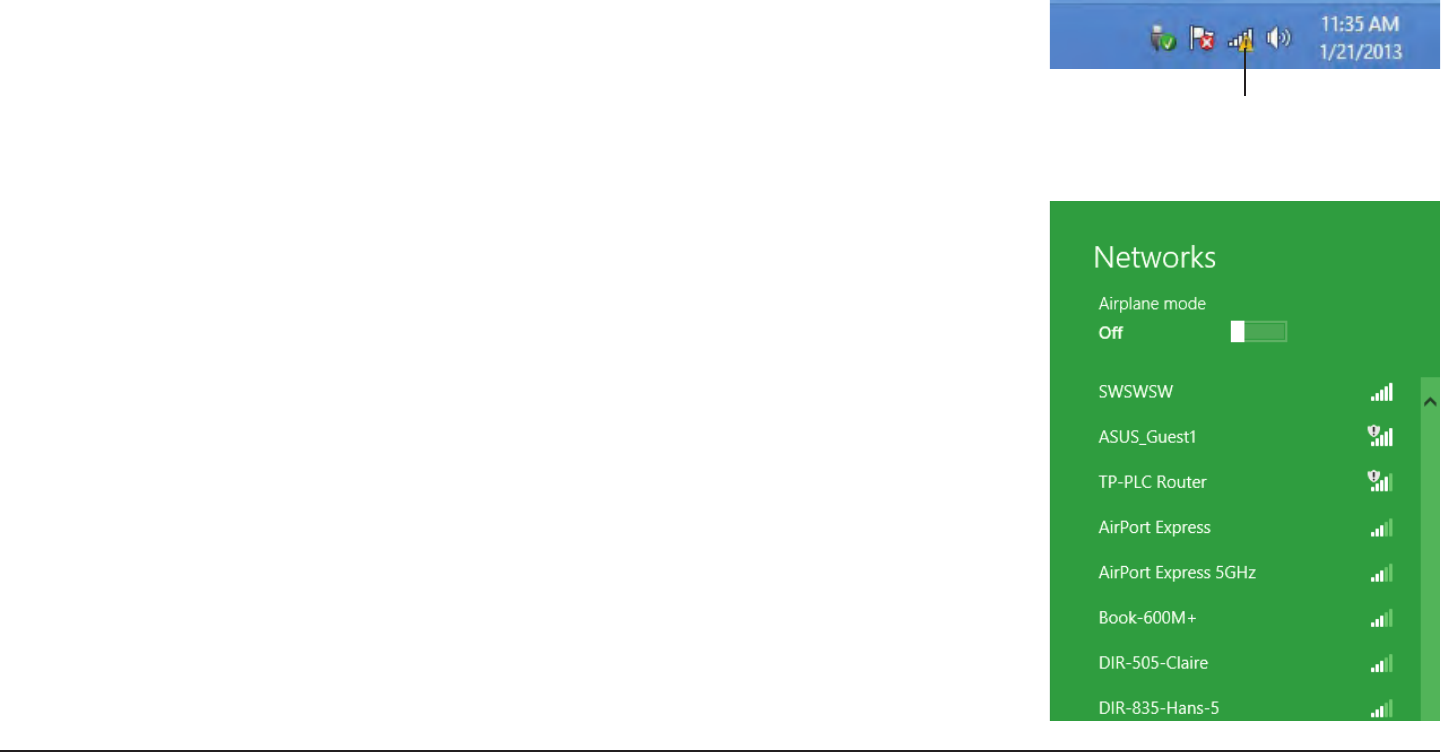
119D-Link DIR-850L User Manual
Section 5 - Security
Windows® 8
WPA/WPA2
It is recommended to enable wireless security (WPA/WPA2) on your wireless router or access point before conguring your
wireless adapter. If you are joining an existing network, you will need to know the security key (Wi-Fi password) being used.
To join an existing network, locate the wireless network icon in the taskbar, next
to the time display.
Wireless Icon
Clicking on this icon will display a list of wireless networks which are within
connecting proximity of your computer. Select the desired network by clicking
on the network name.
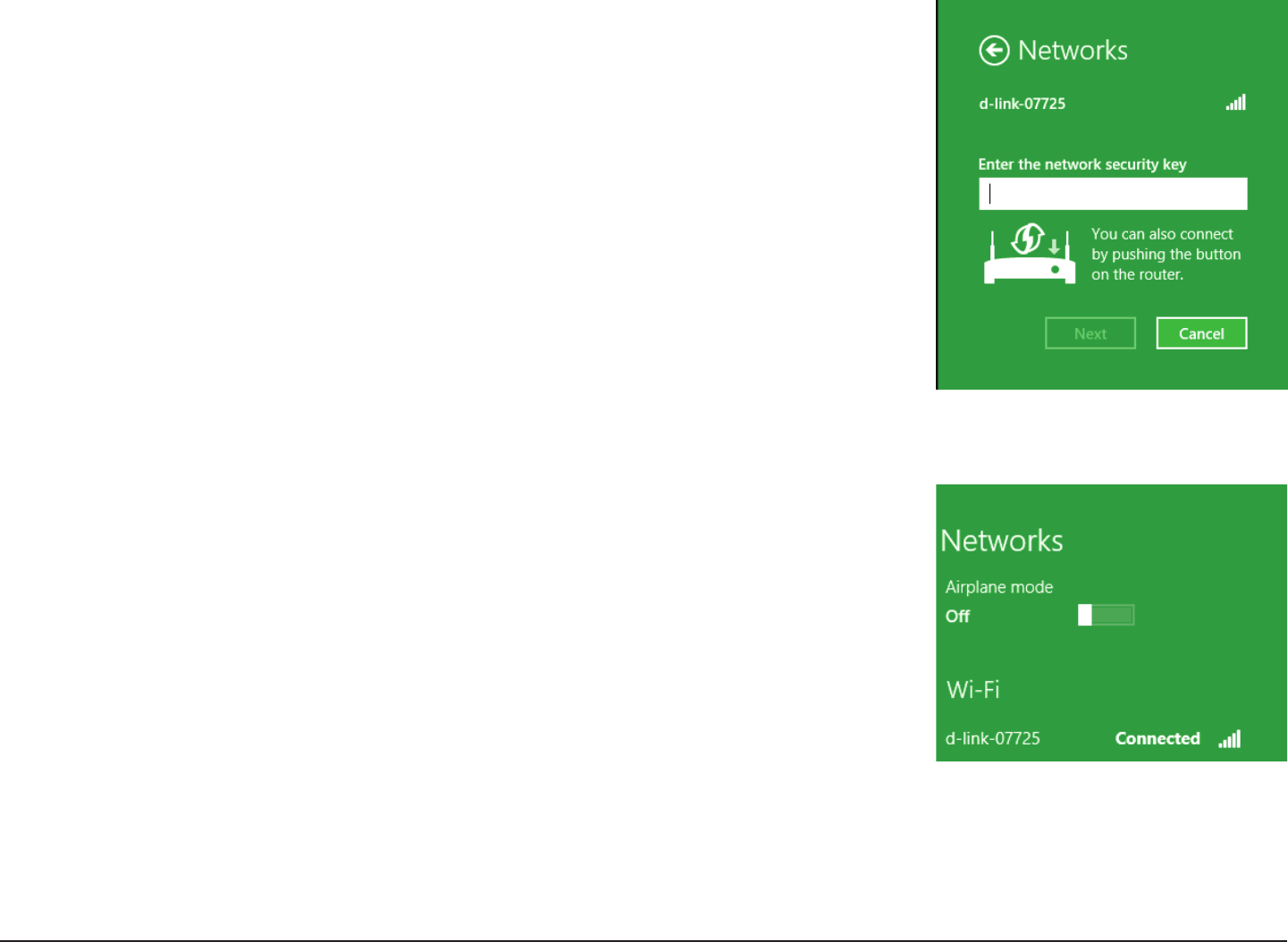
120D-Link DIR-850L User Manual
Section 5 - Security
You will then be prompted to enter the network security key (Wi-Fi password)
for the wireless network. Enter the password into the box and click Next.
If you wish to use Wi-Fi Protected Setup (WPS) to connect to the router, you can
also press the WPS button on your router at the point to enable the WPS function.
When you have established a successful connection a wireless network, the
word Connected will appear next to the name of the network to which you are
connected.
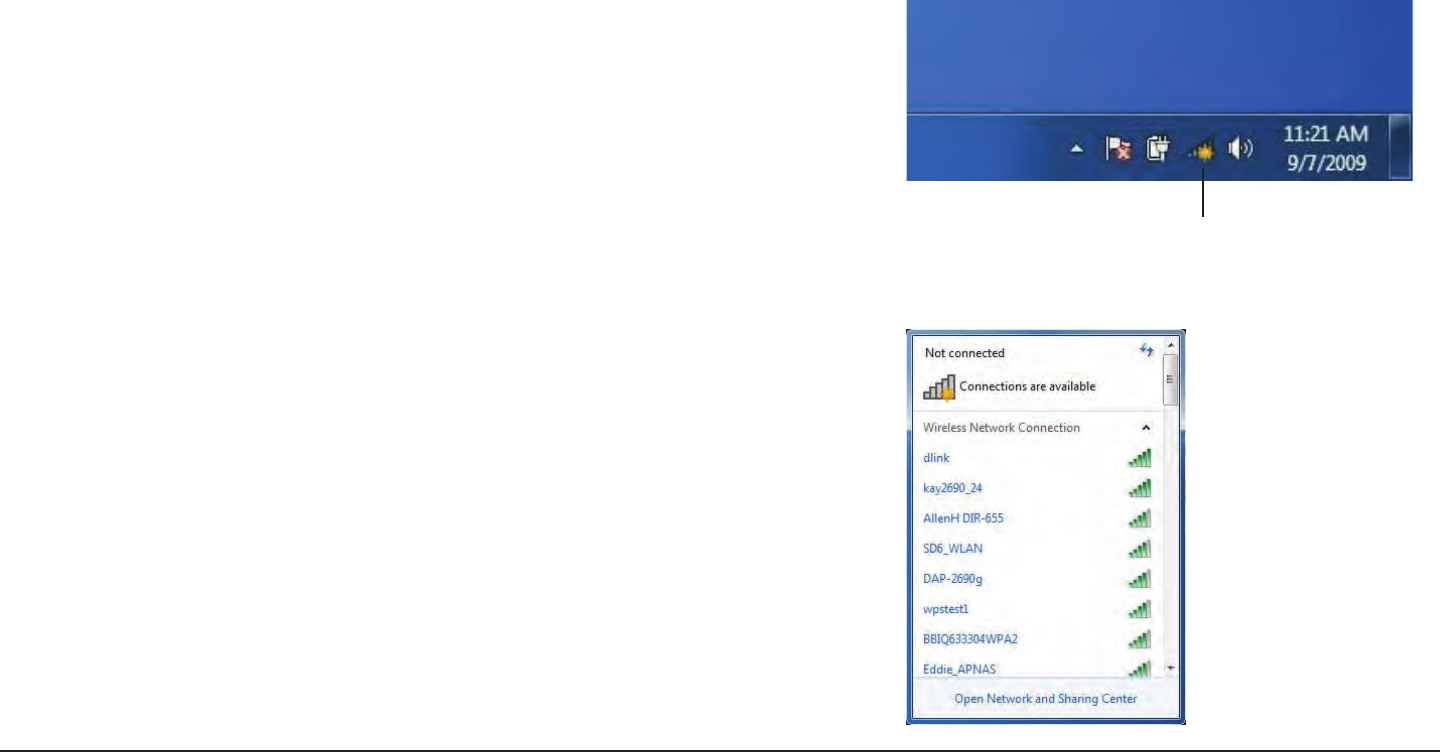
121D-Link DIR-850L User Manual
Section 5 - Security
Windows® 7
It is recommended to enable wireless security (WPA/WPA2) on your wireless router or access point before conguring your
wireless adapter. If you are joining an existing network, you will need to know the security key or passphrase being used.
1. Click on the wireless icon in your system tray (lower-right corner).
2. The utility will display any available wireless networks in your area.
Wireless Icon
WPA/WPA2
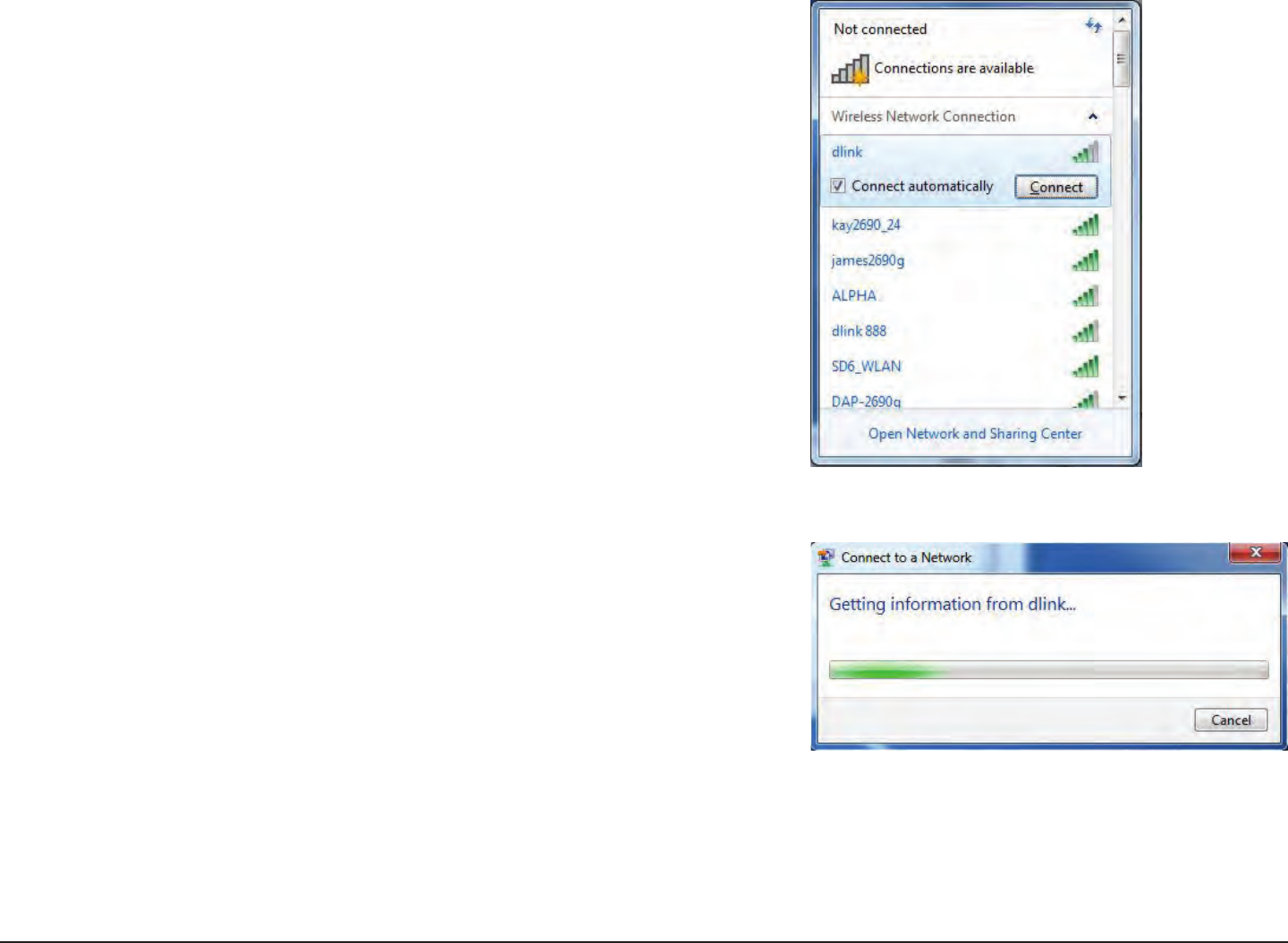
122D-Link DIR-850L User Manual
Section 5 - Security
3. Highlight the wireless connection with Wi-Fi name (SSID) you would
like to connect to and click the Connect button.
If you get a good signal but cannot access the Internet, check your TCP/
IP settings for your wireless adapter. Refer to the Networking Basics
section in this manual for more information.
4. The following window appears while your computer tries to connect
to the router.
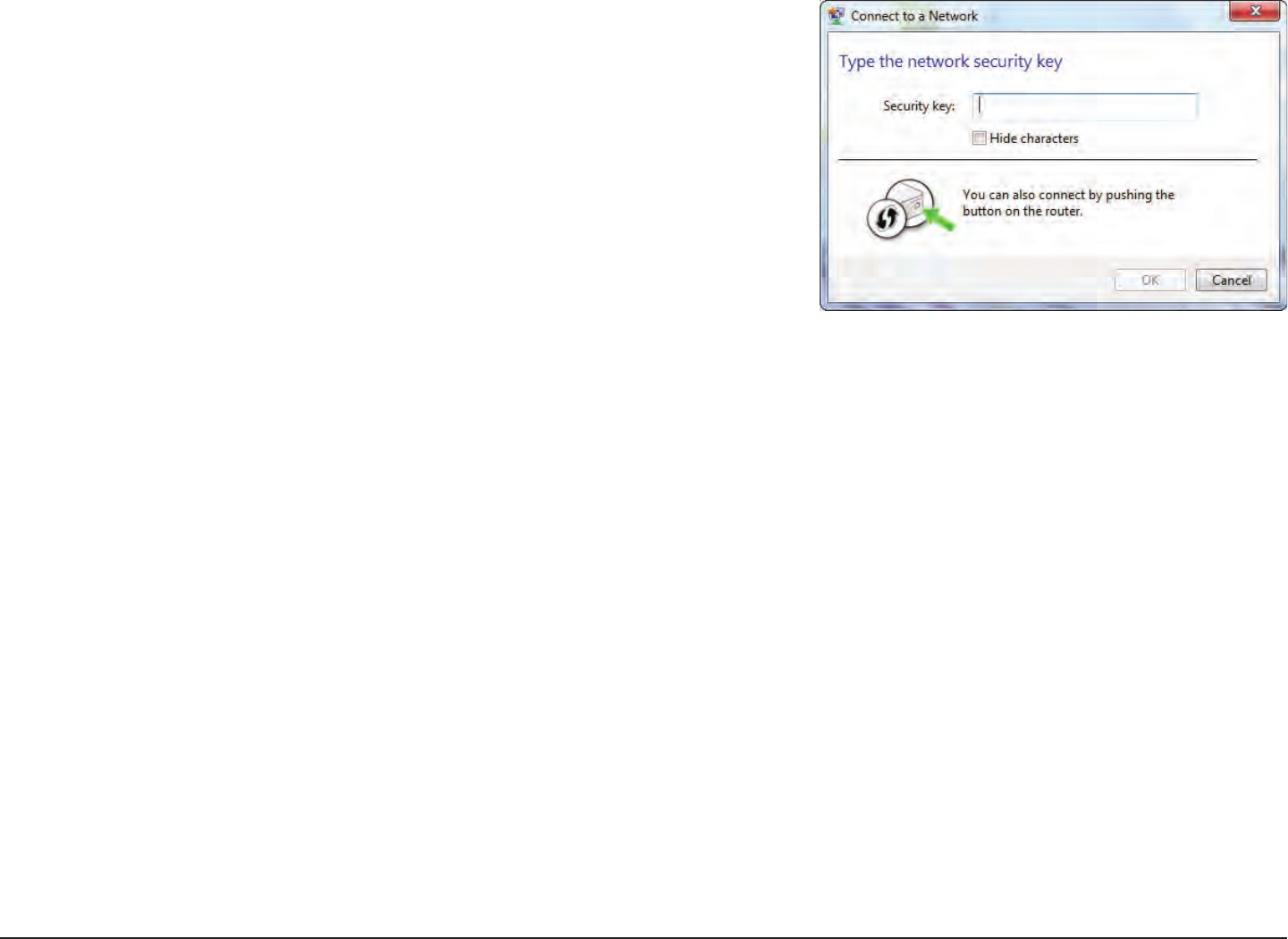
123D-Link DIR-850L User Manual
Section 5 - Security
5. Enter the same security key or passphrase (Wi-Fi password) that is on
your router and click Connect. You can also connect by pushing the
WPS button on the router.
It may take 20-30 seconds to connect to the wireless network. If the
connection fails, please verify that the security settings are correct. The
key or passphrase must be exactly the same as on the wireless router.
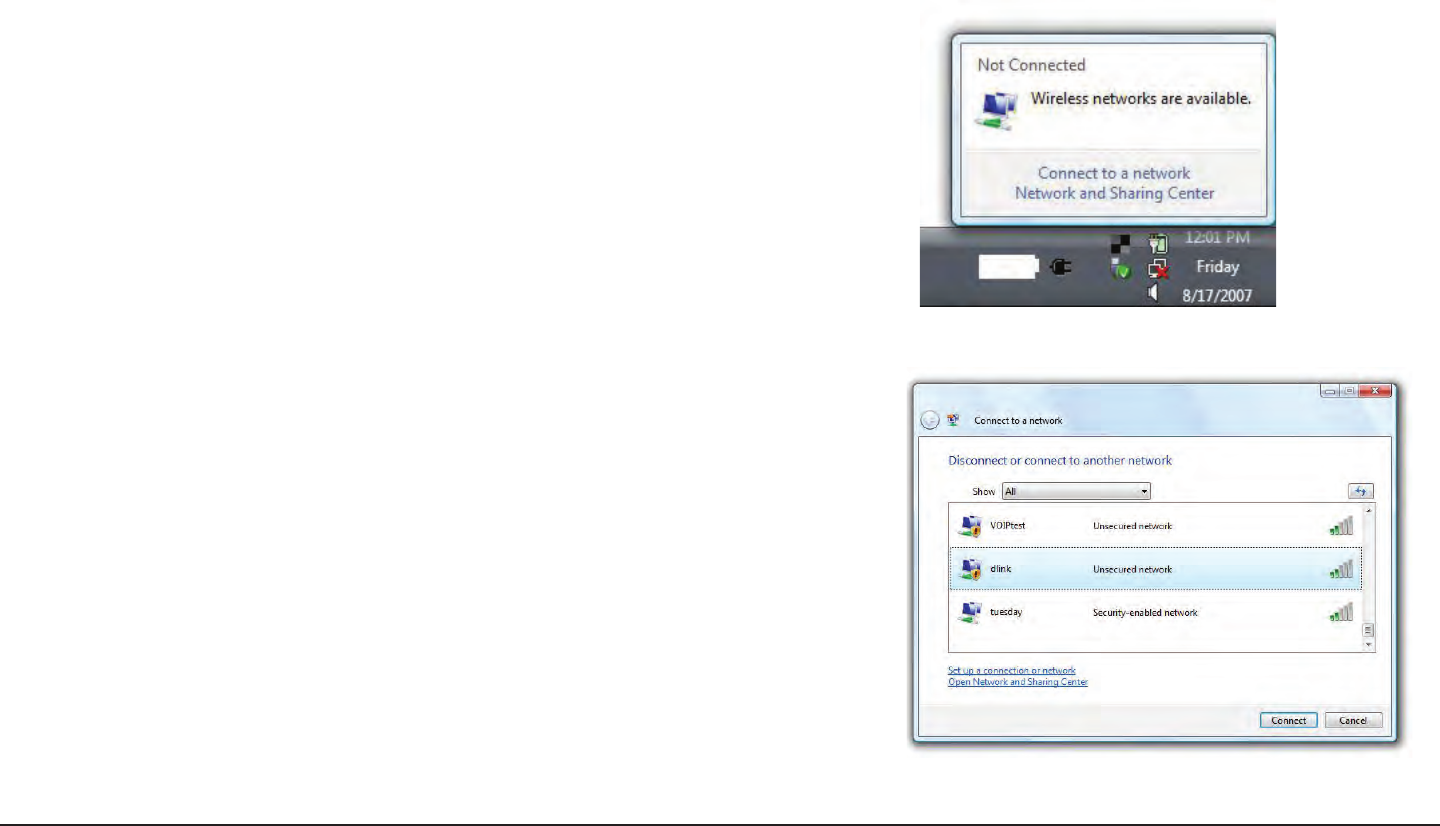
124D-Link DIR-850L User Manual
Section 6 - Connecting to a Wireless Network
Windows Vista®
Windows Vista® users may use the built-in wireless utility. If you are using another company’s utility, please refer to the user
manual of your wireless adapter for help with connecting to a wireless network. Most utilities will have a “site survey” option
similar to the Windows Vista® utility as seen below.
Right-click on the wireless computer icon in your system tray (lower-right
corner next to the time). Select Connect to a network.
If you receive the Wireless Networks Detected bubble, click on the
center of the bubble to access the utility.
or
The utility will display any available wireless networks in your area. Click
on a network (displayed using the SSID) and click the Connect button.
If you get a good signal but cannot access the Internet, check you TCP/
IP settings for your wireless adapter. Refer to the Networking Basics
section in this manual for more information.
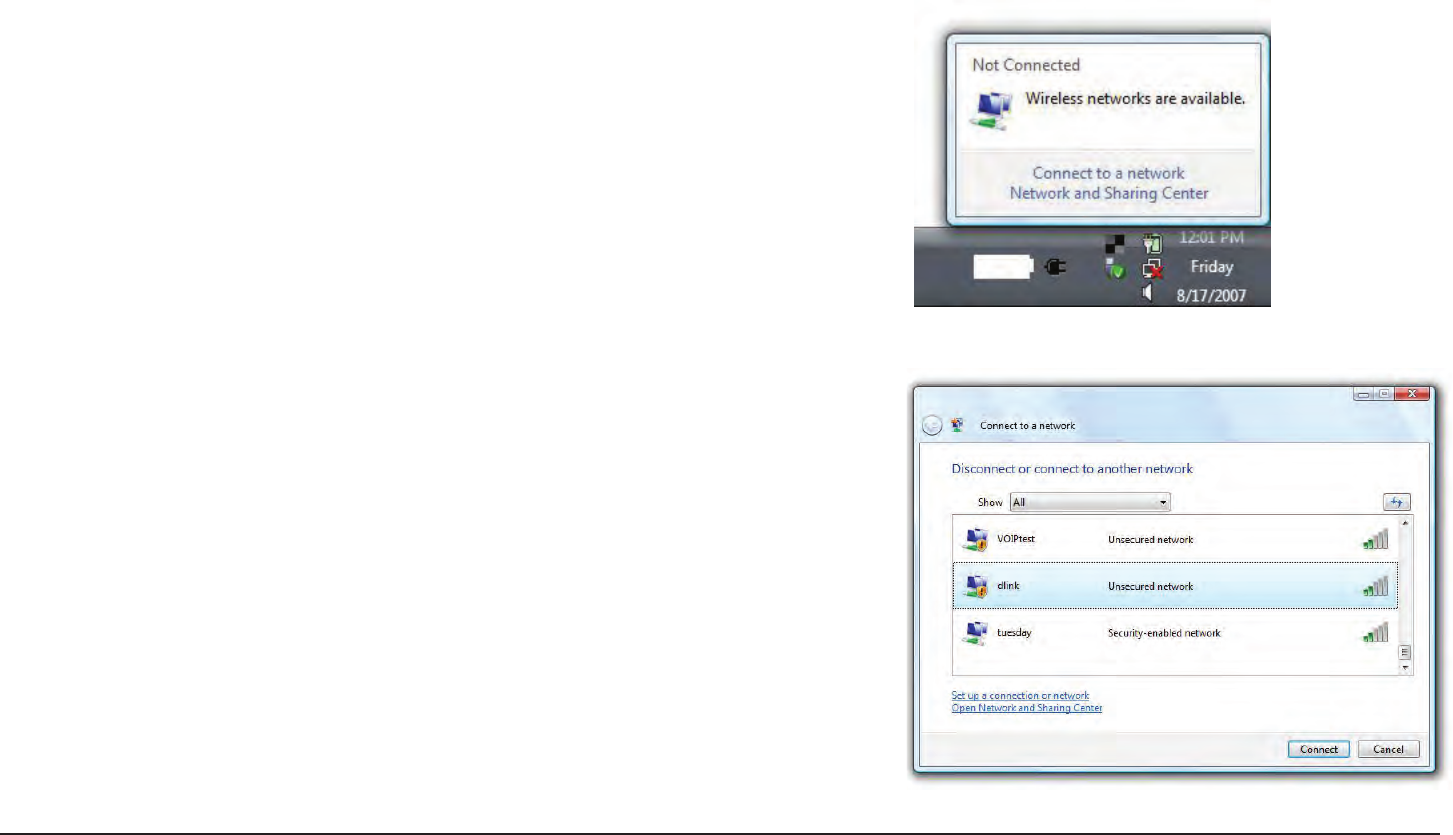
125D-Link DIR-850L User Manual
Section 6 - Connecting to a Wireless Network
WPA/WPA2
It is recommended to enable wireless security (WPA/WPA2) on your wireless router or access point before conguring your
wireless adapter. If you are joining an existing network, you will need to know the security key or passphrase being used.
2. Highlight the Wi-Fi name (SSID) you would like to connect to and click
Connect.
1. Open the Windows Vista® Wireless Utility by right-clicking on the
wireless computer icon in your system tray (lower right corner of
screen). Select Connect to a network.
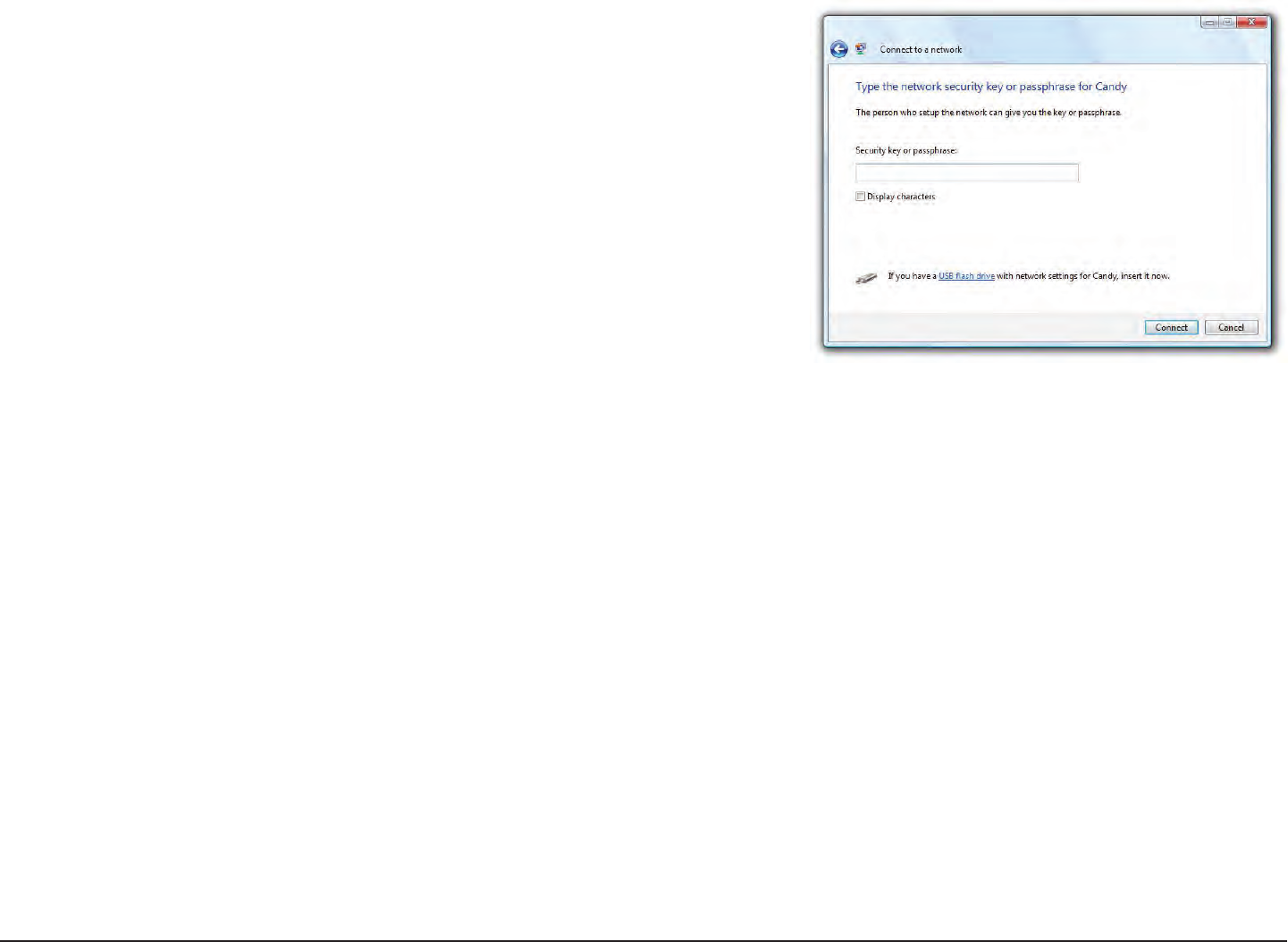
126D-Link DIR-850L User Manual
Section 6 - Connecting to a Wireless Network
3. Enter the same security key or passphrase (Wi-Fi password) that is on
your router and click Connect.
It may take 20-30 seconds to connect to the wireless network. If the
connection fails, please verify that the security settings are correct. The
key or passphrase must be exactly the same as on the wireless router.
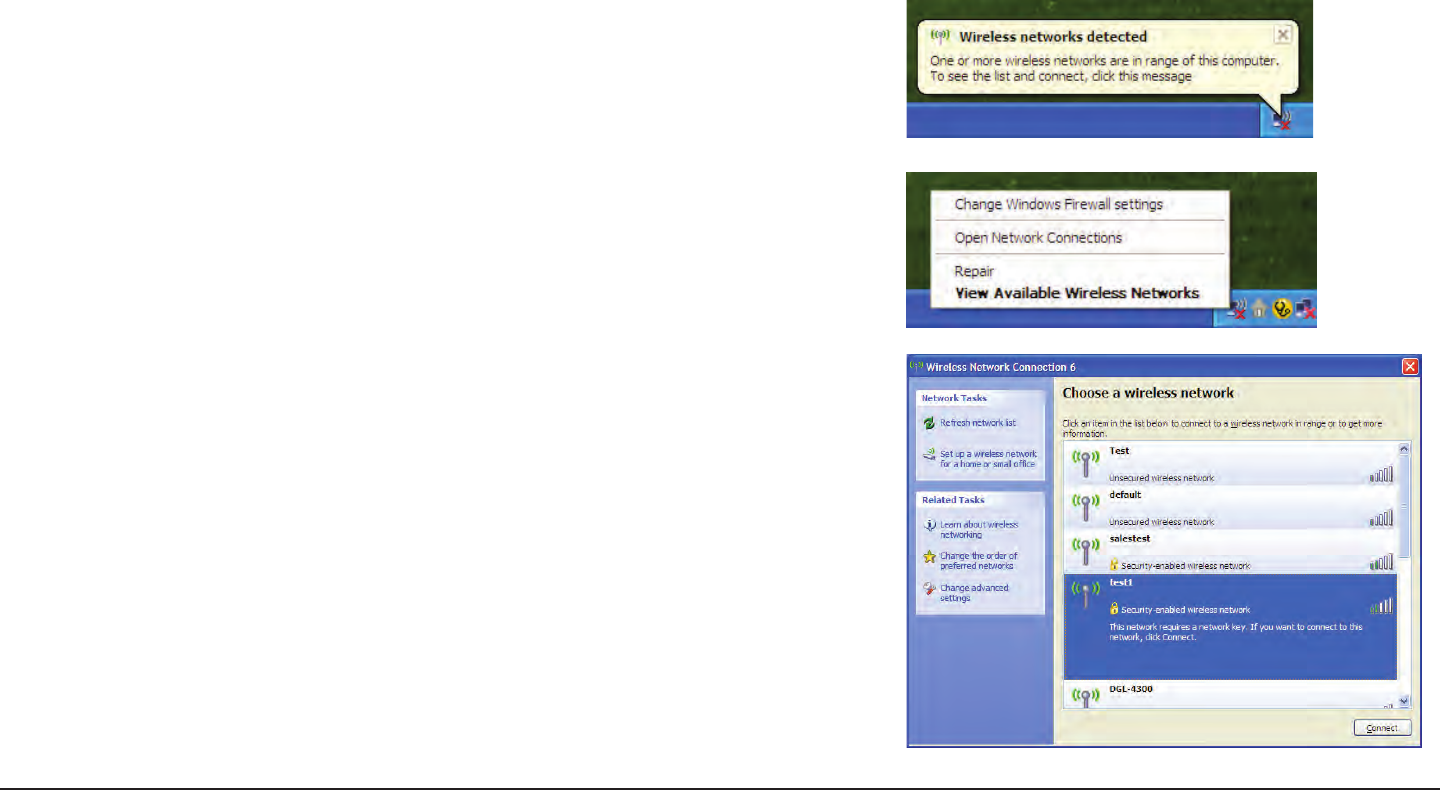
127D-Link DIR-850L User Manual
Section 6 - Connecting to a Wireless Network
Windows® XP
Windows® XP users may use the built-in wireless utility (Zero Conguration Utility). The following instructions are for Service
Pack 2 users. If you are using another company’s utility, please refer to the user manual of your wireless adapter for help with
connecting to a wireless network. Most utilities will have a “site survey” option similar to the Windows® XP utility as seen below.
Right-click on the wireless computer icon in your system tray (lower-right
corner next to the time). Select View Available Wireless Networks.
If you receive the Wireless Networks Detected bubble, click on the
center of the bubble to access the utility.
or
The utility will display any available wireless networks in your area. Click
on a Wi-Fi network (displayed using the SSID) and click the Connect
button.
If you get a good signal but cannot access the Internet, check you TCP/
IP settings for your wireless adapter. Refer to the Networking Basics
section in this manual for more information.
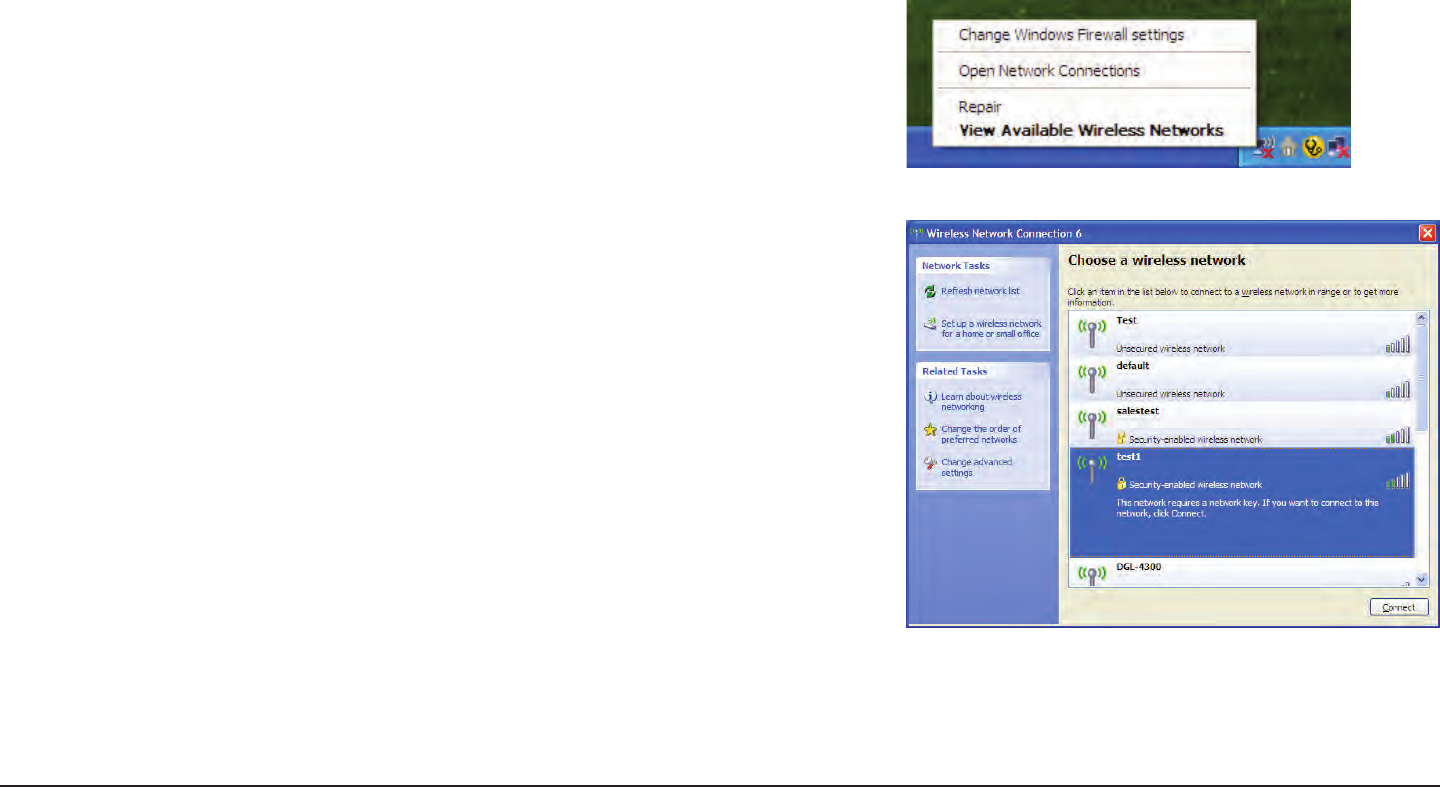
128D-Link DIR-850L User Manual
Section 6 - Connecting to a Wireless Network
It is recommended to enable WPA on your wireless router or access point before conguring your wireless adapter. If you are
joining an existing network, you will need to know the WPA key being used.
2. Highlight the Wi-Fi network (SSID) you would like to connect to and
click Connect.
1. Open the Windows® XP Wireless Utility by right-clicking on the wireless
computer icon in your system tray (lower-right corner of screen). Select
View Available Wireless Networks.
WPA/WPA2
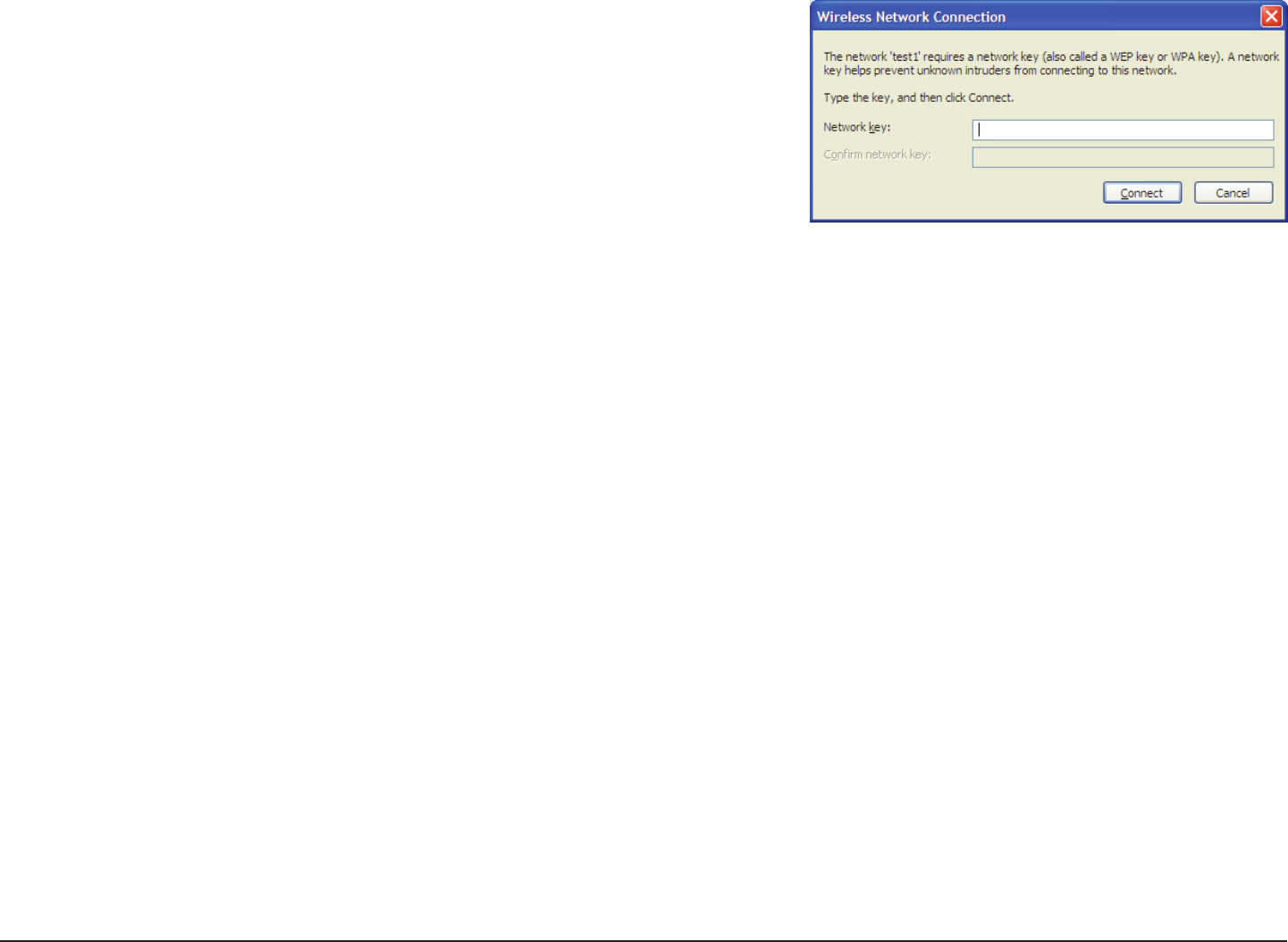
129D-Link DIR-850L User Manual
Section 6 - Connecting to a Wireless Network
3. The Wireless Network Connection box will appear. Enter the WPA-
PSK Wi-Fi password and click Connect.
It may take 20-30 seconds to connect to the wireless network. If the
connection fails, please verify that the WPA-PSK settings are correct. The
Wi-Fi password must be exactly the same as on the wireless router.

130D-Link DIR-850L User Manual
Section 6 - Troubleshooting
Troubleshooting
This chapter provides solutions to problems that can occur during the installation and operation of the DIR-850L. Read the
following descriptions if you are having problems. The examples below are illustrated in Windows® XP. If you have a dierent
operating system, the screenshots on your computer will look similar to the following examples.
1. Why can’t I access the web-based conguration utility?
When entering the IP address of the D-Link router (192.168.0.1 for example), you are not connecting to a website nor do you
have to be connected to the Internet. The device has the utility built-in to a ROM chip in the device itself. Your computer must
be on the same IP subnet to connect to the web-based utility.
Make sure you have an updated Java-enabled web browser. We recommend the following:
• Microsoft Internet Explorer® 7 and higher
• Mozilla Firefox 3.5 and higher
• Google™ Chrome 8 and higher
• Apple Safari 4 and higher
Verify physical connectivity by checking for solid link lights on the device. If you do not get a solid link light, try using a dierent
cable or connect to a dierent port on the device if possible. If the computer is turned o, the link light may not be on.
Disable any Internet security software running on the computer. Software rewalls such as ZoneAlarm, BlackICE, Sygate, Norton
Personal Firewall, and the Windows® XP rewall may block access to the conguration pages. Check the help les included with
your rewall software for more information on disabling or conguring it.

131D-Link DIR-850L User Manual
Section 6 - Troubleshooting
Congure your Internet settings:
• Go to Start > Settings > Control Panel. Double-click the Internet Options Icon. From the Security tab, click the button to
restore the settings to their defaults.
• Click the Connection tab and set the dial-up option to Never Dial a Connection. Click the LAN Settings button. Make sure noth-
ing is checked. Click OK.
• Go to the Advanced tab and click the button to restore these settings to their defaults. Click OK three times.
• Close your web browser (if open) and open it.
Access the web management. Open your web browser and enter the IP address of your D-Link router in the address bar. This
should open the login page for your web management.
If you still cannot access the conguration, unplug the power to the router for 10 seconds and plug back in. Wait about 30
seconds and try accessing the conguration. If you have multiple computers, try connecting using a dierent computer.
2. What can I do if I forgot my password?
If you forgot your password, you must reset your router. Unfortunately this process will change all your settings back to the
factory defaults.
To reset the router, locate the reset button (hole) on the rear panel of the unit. With the router powered on, use a paperclip
to hold the button down for 10 seconds. Release the button and the router will go through its reboot process. Wait about 30
seconds to access the router. The default IP address is 192.168.0.1. When logging in, the username is admin and leave the
password box empty.

132D-Link DIR-850L User Manual
Section 6 - Troubleshooting
3. Why can’t I connect to certain sites or send and receive emails when connecting through my router?
If you are having a problem sending or receiving email, or connecting to secure sites such as eBay, banking sites, and Hotmail,
we suggest lowering the MTU in increments of ten (Ex. 1492, 1482, 1472, etc).
To nd the proper MTU Size, you’ll have to do a special ping of the destination you’re trying to go to. A destination could be
another computer, or a URL.
• Click on Start and then click Run.
• Windows® 95, 98, and Me users type in command (Windows® NT, 2000, XP, Vista®, and 7 users type in cmd) and press Enter (or
click OK).
• Once the window opens, you’ll need to do a special ping. Use the following syntax:
ping [url] [-f] [-l] [MTU value]
Example: ping yahoo.com -f -l 1472
You should start at 1472 and work your way down by 10 each time.
Once you get a reply, go up by 2 until you get a fragmented packet.
Take that value and add 28 to the value to account for the various TCP/
IP headers. For example, lets say that 1452 was the proper value, the
actual MTU size would be 1480, which is the optimum for the network
we’re working with (1452+28=1480).

133D-Link DIR-850L User Manual
Section 6 - Troubleshooting
Once you nd your MTU, you can now congure your router with the proper MTU size.
To change the MTU rate on your router follow the steps below:
• Open your browser, enter the IP address of your router (192.168.0.1) and click OK.
• Enter your username (admin) and password (blank by default). Click OK to enter the web conguration page for the device.
• Click on Setup and then click Manual Congure.
• To change the MTU enter the number in the MTU eld and click Save Settings to save your settings.
• Test your email. If changing the MTU does not resolve the problem, continue changing the MTU in increments of ten.

134D-Link DIR-850L User Manual
Appendix A - Wireless Basics
D-Link wireless products are based on industry standards to provide easy-to-use and compatible high-speed wireless
connectivity within your home, business or public access wireless networks. Strictly adhering to the IEEE standard, the D-Link
wireless family of products will allow you to securely access the data you want, when and where you want it. You will be able
to enjoy the freedom that wireless networking delivers.
A wireless local area network (WLAN) is a cellular computer network that transmits and receives data with radio signals instead of
wires. Wireless LANs are used increasingly in both home and oce environments, and public areas such as airports, coee shops
and universities. Innovative ways to utilize WLAN technology are helping people to work and communicate more eciently.
Increased mobility and the absence of cabling and other xed infrastructure have proven to be benecial for many users.
Wireless users can use the same applications they use on a wired network. Wireless adapter cards used on laptop and desktop
systems support the same protocols as Ethernet adapter cards.
Under many circumstances, it may be desirable for mobile network devices to link to a conventional Ethernet LAN in order to
use servers, printers or an Internet connection supplied through the wired LAN. A wireless router is a device used to provide
this link.
Wireless Basics

135D-Link DIR-850L User Manual
Appendix A - Wireless Basics
What is Wireless?
Wireless or Wi-Fi technology is another way of connecting your computer to the network without using wires. Wi-Fi uses radio
frequency to connect wirelessly, so you have the freedom to connect computers anywhere in your home or oce network.
Why D-Link Wireless?
D-Link is the worldwide leader and award winning designer, developer, and manufacturer of networking products. D-Link
delivers the performance you need at a price you can aord. D-Link has all the products you need to build your network.
How does wireless work?
Wireless works similar to how cordless phone work, through radio signals to transmit data from one point A to point B. But
wireless technology has restrictions as to how you can access the network. You must be within the wireless network range area
to be able to connect your computer. There are two dierent types of wireless networks Wireless Local Area Network (WLAN),
and Wireless Personal Area Network (WPAN).
Wireless Local Area Network (WLAN)
In a wireless local area network, a device called an access point (AP) connects computers to the network. The access point has
a small antenna attached to it, which allows it to transmit data back and forth over radio signals. With an indoor access point
as seen in the picture, the signal can travel up to 300 feet. With an outdoor access point the signal can reach out up to 30 miles
to serve places like manufacturing plants, industrial locations, college and high school campuses, airports, golf courses, and
many other outdoor venues.

136D-Link DIR-850L User Manual
Appendix A - Wireless Basics
Wireless Personal Area Network (WPAN)
Bluetooth is the industry standard wireless technology used for WPAN. Bluetooth devices in WPAN operate in a range up to
30 feet away.
Compared to WLAN the speed and wireless operation range are both less than WLAN, but in return it doesn’t use nearly as
much power which makes it ideal for personal devices, such as mobile phones, PDAs, headphones, laptops, speakers, and other
devices that operate on batteries.
Who uses wireless?
Wireless technology as become so popular in recent years that almost everyone is using it, whether it’s for home, oce, business,
D-Link has a wireless solution for it.
Home
• Gives everyone at home broadband access
• Surf the web, check email, instant message, etc.
• Gets rid of the cables around the house
• Simple and easy to use
Small Oce and Home Oce
• Stay on top of everything at home as you would at oce
• Remotely access your oce network from home
• Share Internet connection and printer with multiple computers
• No need to dedicate oce space

137D-Link DIR-850L User Manual
Appendix A - Wireless Basics
Where is wireless used?
Wireless technology is expanding everywhere not just at home or oce. People like the freedom of mobility and it’s becoming
so popular that more and more public facilities now provide wireless access to attract people. The wireless connection in public
places is usually called “hotspots”.
Using a D-Link CardBus adapter with your laptop, you can access the hotspot to connect to Internet from remote locations
like: airports, hotels, coee shops, libraries, restaurants, and convention centers.
Wireless network is easy to setup, but if you’re installing it for the rst time it could be quite a task not knowing where to start.
That’s why we’ve put together a few setup steps and tips to help you through the process of setting up a wireless network.
Tips
Here are a few things to keep in mind, when you install a wireless network.
Centralize Your Router or Access Point
Make sure you place the router/access point in a centralized location within your network for the best performance. Try to
place the router/access point as high as possible in the room, so the signal gets dispersed throughout your home. If you have
a two-story home, you may need a repeater to boost the signal to extend the range.
Eliminate Interference
Place home appliances such as cordless telephones, microwaves, and televisions as far away as possible from the router/access
point. This would signicantly reduce any interference that the appliances might cause since they operate on same frequency.

138D-Link DIR-850L User Manual
Appendix A - Wireless Basics
Security
Don’t let you next-door neighbors or intruders connect to your wireless network. Secure your wireless network by turning on
the WPA or WEP security feature on the router. Refer to product manual for detail information on how to set it up.
There are basically two modes of networking:
• Infrastructure – All wireless clients will connect to an access point or wireless router.
• Ad-Hoc – Directly connecting to another computer, for peer-to-peer communication, using wireless network adapters on each
computer, such as two or more DIR-850L wireless network CardBus adapters.
An Infrastructure network contains an access point or wireless router. All the wireless devices, or clients, will connect to the
wireless router or access point.
An Ad-Hoc network contains only clients, such as laptops with wireless CardBus adapters. All the adapters must be in Ad-Hoc
mode to communicate.
Wireless Modes
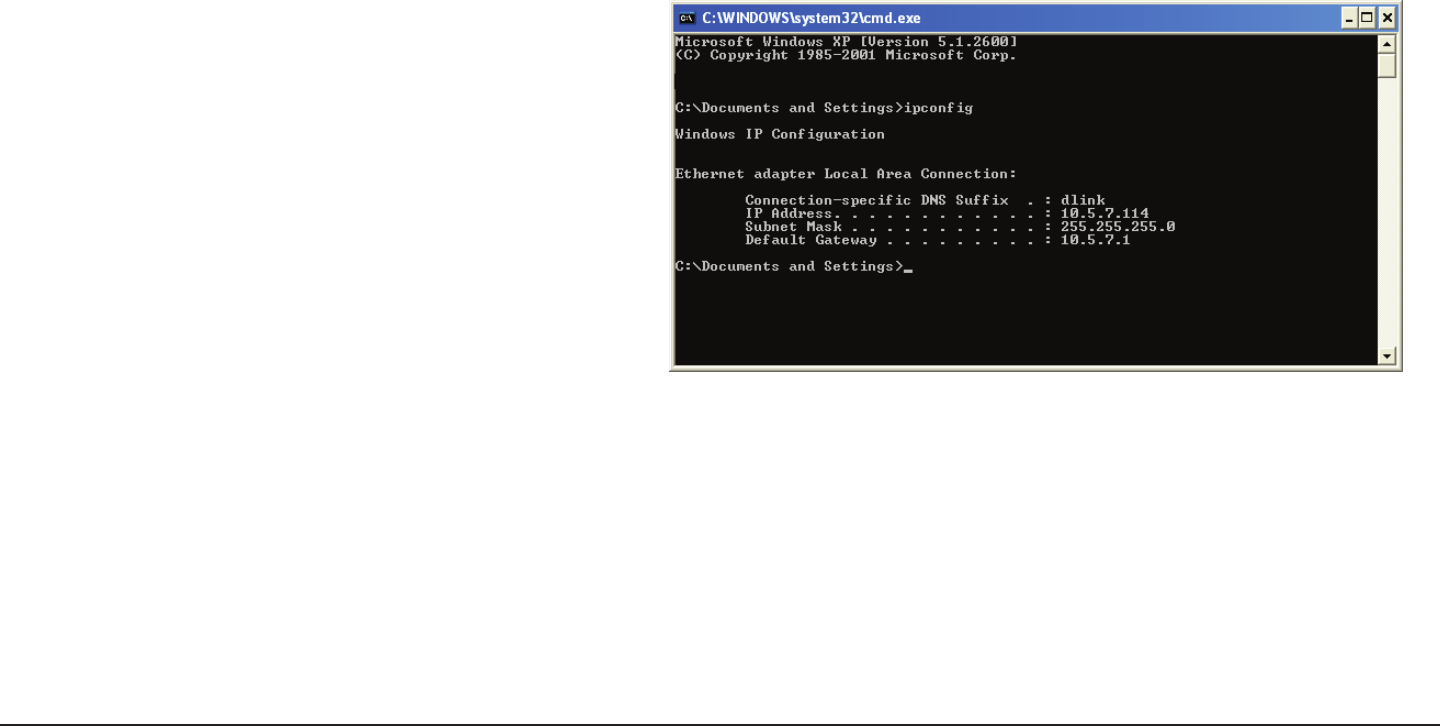
139D-Link DIR-850L User Manual
Appendix B - Networking Basics
Networking Basics
Check your IP address
After you install your new D-Link adapter, by default, the TCP/IP settings should be set to obtain an IP address from a DHCP
server (i.e. wireless router) automatically. To verify your IP address, please follow the steps below.
Click on Start > Run. In the run box type cmd and click OK. (Windows® 7/Vista® users type cmd in the Start Search box.)
At the prompt, type ipcong and press Enter.
This will display the IP address, subnet mask, and the
default gateway of your adapter.
If the address is 0.0.0.0, check your adapter installation,
security settings, and the settings on your router. Some
rewall software programs may block a DHCP request
on newly installed adapters.
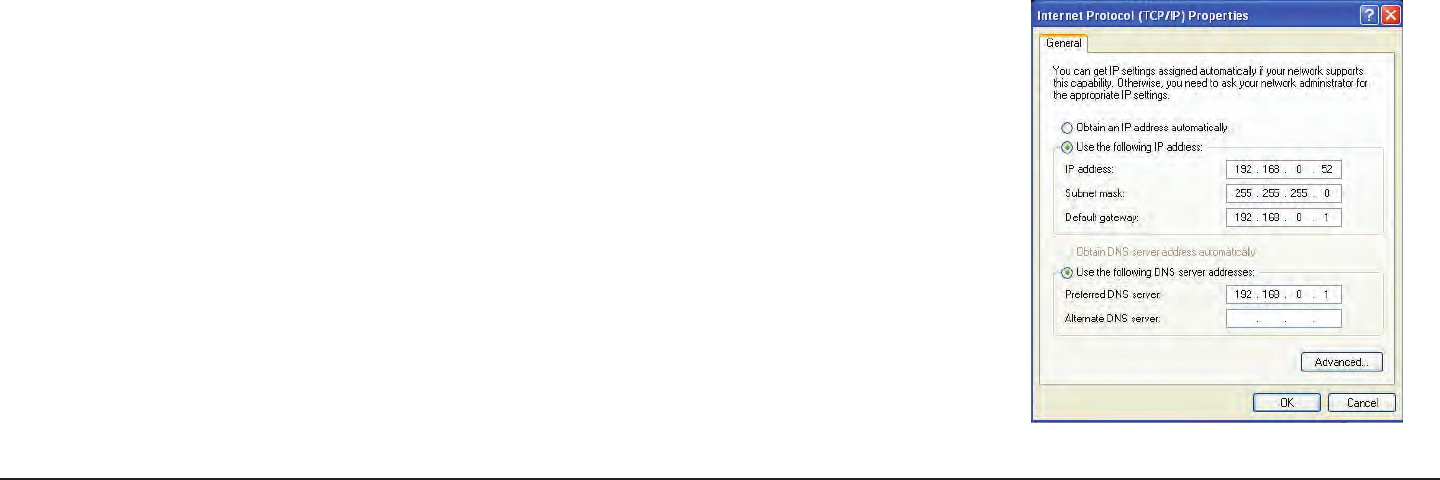
140D-Link DIR-850L User Manual
Appendix B - Networking Basics
Statically Assign an IP address
If you are not using a DHCP capable gateway/router, or you need to assign a static IP address, please follow the steps below:
Step 1
Windows® 7 - Click on Start > Control Panel > Network and Internet > Network and Sharing Center.
Windows Vista® - Click on Start > Control Panel > Network and Internet > Network and Sharing Center > Manage Network
Connections.
Windows® XP - Click on Start > Control Panel > Network Connections.
Windows® 2000 - From the desktop, right-click My Network Places > Properties.
Step 2
Right-click on the Local Area Connection which represents your network adapter and select Properties.
Step 3
Highlight Internet Protocol (TCP/IP) and click Properties.
Step 4
Click Use the following IP address and enter an IP address that is on the same subnet
as your network or the LAN IP address on your router.
Example: If the router´s LAN IP address is 192.168.0.1, make your IP address 192.168.0.X
where X is a number between 2 and 99. Make sure that the number you choose is not
in use on the network. Set the Default Gateway the same as the LAN IP address of your
router (I.E. 192.168.0.1).
Set primary DNS the same as the LAN IP address of your router (192.168.0.1). The
secondary DNS is not needed or you may enter a DNS server from your ISP.
Step 5
Click OK twice to save your settings.

141D-Link DIR-850L User Manual
Appendix C - Technical Specications
Technical Specications
Hardware Specications
• LAN Interface: Four 10/100/1000 Mbps LAN ports
• WAN Interface: One 10/100/1000 Mbps Internet port
• Wireless Interface (2.4 GHz): IEEE 802.11b/g/n
• Wireless Interface (5 GHz): IEEE 802.11a/n/ac
• USB Interface: Compliant USB 2.0
Operating Voltage
• Input: 100~240 V (±20%), 50~60 Hz
• Output: DC 12 V, 1.5 A
Temperature
• Operating: 32 ~ 104 oF (0 ~ 40 oC)
• Non-Operating: -4 ~ 149 oF (-20 ~ 65 oC)
Humidity
• Operating: 10% - 90% non-condensing
• Non-Operating: 5% - 95% non-condensing
Wireless Frequency Range
• IEEE 802.11a: 5180 MHz~5240 MHz, 5745 MHz~5825 MHz
• IEEE 802.11b: 2412 MHz~2462 MHz
• IEEE 802.11g: 2412 MHz~2462 MHz
• IEEE 802.11n: 2412 MHz~2462 MHz, 5180 MHz~5240 MHz,
5745 MHz~5825 MHz
• IEEE 802.11ac: 5180 MHz~5240 MHz, 5745 MHz~5825 MHz
Wireless Bandwidth Rate
• IEEE 802.11a: 54, 48, 36, 24, 18, 12, 9, and 6 Mbps
• IEEE 802.11b: 11, 5.5, 2, and 1 Mbps
• IEEE 802.11g: 54, 48, 36, 24, 18, 12, 9, and 6 Mbps
• IEEE 802.11n: 6.5 to 300 Mbps
• IEEE 802.11ac: 6.5 to 1300 Mbps
Antenna Type
• Two dual-band internal antennas (2.4 GHz and 5 GHz)
Wireless Security
• 64/128-bit WEP, WPA/WPA2-Personal
• WPA/WPA2-Enterprise
• WPS (PIN & PBC)
Certications
• FCC
• CE
• C-Tick
• CSA
• Wi-Fi / WPS
• DLNA
• IPv6 Ready
• WIN 8
• CCC
Dimensions & Weight
• 93 x 116 x 145 mm (3.7 x 4.6 x 5.76 inches)
• 330 grams (11.6 ounces)

142D-Link DIR-850L User Manual
FCC Statement:
Federal Communication Commission Interference Statement
This equipment has been tested and found to comply with the limits for a Class B digital device, pursuant to Part 15 of the FCC
Rules. These limits are designed to provide reasonable protection against harmful interference in a residential installation.
This equipment generates, uses and can radiate radio frequency energy and, if not installed and used in accordance with the
instructions, may cause harmful interference to radio communications. However, there is no guarantee that interference will
not occur in a particular installation. If this equipment does cause harmful interference to radio or television reception, which
can be determined by turning the equipment o and on, the user is encouraged to try to correct the interference by one of
the following measures:
• Reorient or relocate the receiving antenna.
• Increase the separation between the equipment and receiver.
• Connect the equipment into an outlet on a circuit dierent from that to which the receiver is connected.
• Consult the dealer or an experienced radio/TV technician for help.
FCC Caution: Any changes or modications not expressly approved by the party
responsible for compliance could void the user’s authority to operate this equipment.
This device complies with Part 15 of the FCC Rules. Operation is subject to the following two conditions: (1) This device may
not cause harmful interference, and (2) this device must accept any interference received, including interference that may
cause undesired operation.
For product available in the USA/Canada market, only channel 1~11 can be operated. Selection of other channels is not possible.
This device and it’s antennas(s) must not be co-located or operating in conjunction with any other antenna or transmitter
except in accordance with FCC multi-transmitter product procedures.

143D-Link DIR-850L User Manual
This device is going to be operated in 5.15~5.25GHz frequency range, it is restricted in indoor environment only.
IMPORTANT NOTE:
FCC Radiation Exposure Statement:
This equipment complies with FCC radiation exposure limits set forth for an uncontrolled environment. This equipment should
be installed and operated with minimum distance 20cm between the radiator & your body.
IC Statement:
This device complies with Industry Canada license-exempt RSS standard(s). Operation is subject to the following two conditions:
(1) this device may not cause interference, and (2) this device must accept any interference, including interference that may
cause undesired operation of the device.
Le présent appareil est conforme aux CNR d’Industrie Canada applicables aux appareils radio exempts de licence. L’exploitation
est autorisée aux deux conditions suivantes : (1) l’appareil ne doit pas produire de brouillage, et (2) l’utilisateur de l’appareil
doit accepter tout brouillage radioélectrique subi, même si le brouillage est susceptible d’en compromettre le fonctionnement.
For product available in the USA/Canada market, only channel 1~11 can be operated. Selection of other channels is not possible.
Pour les produits disponibles aux États-Unis / Canada du marché, seul le canal 1 à 11 peuvent être exploités. Sélection d’autres
canaux n’est pas possible.
This device and it’s antennas(s) must not be co-located or operating in conjunction with any other antenna or transmitter
except in accordance with IC multi-transmitter product procedures.
Cet appareil et son antenne (s) ne doit pas être co-localisés ou fonctionnement en association avec une autre antenne ou
transmetteur.

144D-Link DIR-850L User Manual
The device for the band 5150-5250 MHz is only for indoor usage to reduce potential for harmful interference to co-channel
mobile satellite systems.
les dispositifs fonctionnant dans la bande 5150-5250 MHz sont réservés uniquement pour une utilisation à l’intérieur an de
réduire les risques de brouillage préjudiciable aux systèmes de satellites mobiles utilisant les mêmes canaux;
IC Radiation Exposure Statement:
This equipment complies with IC RSS-102 radiation exposure limits set forth for an uncontrolled environment. This equipment
should be installed and operated with minimum distance 20cm between the radiator & your body.
Cet équipement est conforme aux limites d’exposition aux rayonnements IC établies pour un environnement non contrôlé. Cet
équipement doit être installé et utilisé avec un minimum de 20 cm de distance entre la source de rayonnement et votre corps.
「經型式認證合格之低功率射頻電機,非經許可,公司、商號或使用者均不得擅自變更頻率、加大功率或變更原設計之特性及功能」。
「低功率射頻電機之使用不得影響飛航安全及干擾合法通信;經發現有干擾現象時,應立即停用,並改善至無干擾時方得繼續使用。前項合法通信,
指依電信法規定作業之無線電通信。低功率射頻電機須忍受合法通信或工業、科學及醫療用電波輻射性電機設備之干擾」。
「不致造成違反低功率電波輻射性電機管理辦法之所有控制、調整及開關之使用方法」。
「對任何可能造成違反管理辦法規定之調整予以警告,或建議由具有發射機維修專長之技術人員執行或由其直接監督及負責」。
「對任何可能造成違反管理辦法之零件(晶體、半導體等)置換之警告」。
「電磁波曝露量MPE標準值1mW/cm2,送測產品實測值為:0.220861 mW/cm2」。
「電磁波曝露量MPE標準值1mW/cm2,本產品使用時建議應距離人體:20 cm」。
「5.25-5.35 GHz頻帶內操作之無線資訊傳輸設備,限於室內使用」。